
* _ > M CO CO < O f O oo \ d w W 4X
UTAH HISTORICAL QUARTERLY (ISSN 0042-143X)
EDITORIAL STAFF
MAXJ . EVANS, Editor
STANFORD J LAYTON, Managing Editor
MIRIAM B MURPHY, Associate Editor
ADVISORY BOARD O F EDITORS
MAUREEN URSENBACH BEECHER, Salt Lake City, 1997
KENNETH L CANNON II, Salt Lake City, 1995
JANICE P DAWSON, Layton, 1996
AUDREY M. GODFREY, Logan, 1997
JOEL C. JANETSKI, Provo, 1997
ROBERT S MCPHERSON, Blanding, 1995
ANTONETTE CHAMBERS NOBLE, Cora, WY, 1996
GENE A. SESSIONS, Ogden, 1995
GARY TOPPING, Salt Lake City, 1996
Utah Historical Quarterly was established in 1928 to publish articles, documents, and reviews contributing to knowledge of Utah's history The Quarterly is published four times a year by the Utah State Historical Society, 300 Rio Grande, Salt Lake City, Utah 84101 Phone (801) 533-3500 for membership and publications information Members of the Society receive the Quarterly, Beehive History, and the bimonthly Newsletter upon payment of the annual dues: individual, $20.00; institution, $20.00; student and senior citizen (age sixty-five or over), $15.00; contributing, $25.00; sustaining, $35.00; patron, $50.00; business, $100.00.
Materials for publication should be submitted in duplicate, typed double-space, with footnotes at the end Authors are encouraged to submit material in a computer-readable form, on 5 l/4 or 3 x/i inch MS-DOS or PC-DOS diskettes, standard ASCII text file. For additional information on requirements contact the managing editor Articles represent the views of the author and are not necessarily those of the Utah State Historical Society

Second class postage is paid at Salt Lake City, Utah.
Postmaster: Send form 3579 (change of address) to Utah Historical Quarterly, 300 Rio Grande, Salt Lake City, Utah 84101.

HISTORICA L QUARTERLY Contents FALL 1995 / VOLUME 63 / NUMBER 4 IN THIS ISSUE 297 DECADE OF DETENTE: THE MORMONGENTILE FEMALE RELATIONSHIP IN NINETEENTH-CENTURY UTAH CAROL CORNWALL MADSEN 298 SO BRIGHT THE DREAM: ECONOMIC PROSPERITY AND THE UTAH CONSTITUTIONAL CONVENTION JEAN BICKMORE WHITE 320 STATEHOOD, POLITICAL ALLEGIANCE, AND UTAH'S FIRST U.S. SENATE SEATS: PRIZES FOR THE NATIONAL, PARTIES AND LOCAL FACTIONS EDWARD LEO LYMAN 341 ALL HAIL! STATEHOOD! AUDREYM GODFREY 357 IN MEMORIAM: C. GREGORY CRAMPTON, 1911-95 CHARI.ES S. PETERSON 370 BOOK REVIEWS 374 BOOK NOTICES 384 INDEX 386
COVER Statehood
© Copyright 1995 Utah State Historical Society
THE
day painting by Jacque Baker, dedicated to the memory of herfather, Captain DeVere Baker of the Raft Lehi.
TOM TILL and BROOKE WILLIAMS Utah: A Centennial Celebration GARY PETERSON 374
LEONARD J. ARRINGTON Utah's Audacious Stockman: Charlie Redd. GARY L. SHUMWAY 375
DAVID B MADSEN and DAVID RHODE, eds Across the West: Human Population Movement and the Expansion of the Numa KAREN LUPO 377
LYMAN HAFEN. Roping the Wind: A Personal History of Cowboys and the Land W. PAUL REEVE 378
DEAN L MAY Three Frontiers: Family, Land, and Society in the American West, 1850-1900...RANDY WILLIAM WIDDIS 379
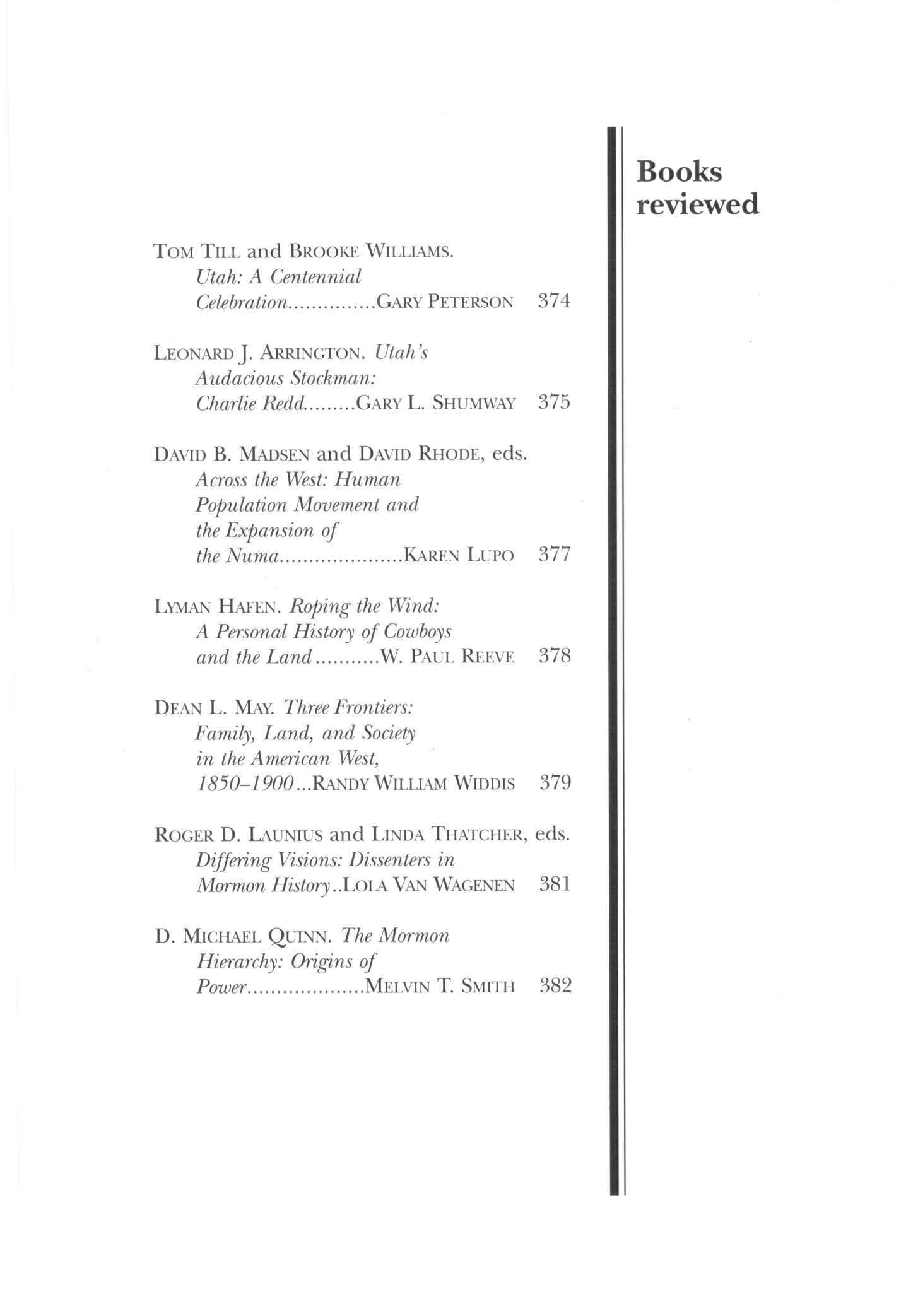
ROGER D LAUNIUS and LINDA THATCHER, eds Differing Visions: Dissenters in Mormon History. .LOLA VAN WAGENEN 381
D MICHAEL QUINN The Mormon Hierarchy: Origins of Power MELVIN T. SMITH 382
Books reviewed
In this issue
"Miss Utah comes into the Union bright and smiling," observed the Indianapolis Sentinel a century ago, and few assessments better summarized the popular mood within the 45th state on that festive occasion The long-awaited achievement of statehood on January 4, 1896, was a great climacteric in Utah history. Appropriately, we dedicate this issue of Utah Historical Quarterly to that centennial event
The first article analyzes the accommodation of Mormon and gentile women during the statehood decade, noting the types of differences that proved capable of mitigation and those that did not It is followed by a detailed look at basic issues decided during the Constitutional Convention that would set the tone and direction of the new state government. Then comes an interpretation of the politics of admission from a national perspective and the machinations behind the selection of Utah's first U.S senators A colorful description of the week-long statehood celebrations held throughout Utah's communities caps the thematic offerings It is succeeded by one of the Quarterly's periodic special features, a memorial tribute to a departed Lhstorical Society Fellow whom the historical community will greatly miss.
The publisher and readers of this commemorative issue owe special thanks to Jacque Baker, a local artist, for her generous donation of art for the cover This wonderful rendition of Salt Lake City in 1896 was recently purchased by Senator Orrin Hatch and now graces his Washington, D.C, office. Better than a thousand words, it captures the bright and smiling complexion of that memorable time in Utah history.
 Looking north on Main Street, Salt Lake City, at about the time of statehood. USHS collections.
Looking north on Main Street, Salt Lake City, at about the time of statehood. USHS collections.
MMMM* a „-, vim, ,^„ <Tnn 77i£ Industrial Christian Home for Women, 145 South Fifth East, built as a refuge for Mormon women wanting to leave polygamous relationships, became a symbol of detente.
Little usedfor their original purpose, its rooms filled other needs. In the 1890s the Ladies Literary Club, which by then was seeking participation from leading IDS women like Emmeline B. Wells, held its meetings there. USHS collections.
Decade of Detente: The Mormon-Gentile Female Relationship in Nineteenth-century Utah
 BY CAROL CORNWALL MADSEN
BY CAROL CORNWALL MADSEN
I N OCTOBER 1890 MORMON CHURCH PRESIDENT WILFORD WOODRUFF issued his Manifesto pledging to abide by the law of the land which had declared the practice of polygamy (correctly, polygyny) unconstitutional in 1879. Since the first public announcement of the practice among
:>~ must *_ » n u
Dr Madsen is professor of history and senior research historian with the Joseph Fielding Smith Institute for Church History at Brigham Young University.
Mormons in 1852, polygamy had created controversy and storms of social protest. The Manifesto, therefore, represented a victory not only for the federal government, and its repressive enforcement legislation, but for the moral conscience of thousands of women collectivized in a national "purity" crusade that had identified polygamy as a flagrant abuse of traditional moral values.1 For more than a decade before the Manifesto women throughout the country, at the instigation of non-Mormon women in Utah, denounced the religious practice of plural marriage and embarked on a self-imposed mission to awaken Mormon women to an awareness of their "moral degradation" and to demand legislation that would halt the offending practice. To arouse the nation and prick the conscience of Congress, women lectured, lobbied, petitioned, and published against the "moral blight" in Utah. They felt vindicated, therefore, with passage of the antipolygamy acts of 1882 and 1887which led to the Woodruff Manifesto in 1890.
Most studies of this volatile period have focused on Utah's long struggle for statehood and the Mormon capitulation to federal power that redesigned Utah's legal and political landscape.2 Few have explored woman's role, particularly in the period of social reconstruction that followed the Woodruff Manifesto. Easing the way to statehood, the Manifesto also became an overture to detente for Utah women. During the last decade of the nineteenth century Latterday Saint and gentile3 women blurred their former hostilities over polygamy and joined their common community interests in collective civic action. The decade clearly illustrates the significant impact of a distinct female cultural system based on shared values and the social power of its solidarity.4
1 Two studies that explore the uses of female moral authority are Ruth Bordin, Woman and Temperance: The Search for Poiuer and Liberty, 1873-1900 (Philadelphia: Temple University Press, 1981), and Peggy Pascoe, Relations of Rescue, The Search for Female Moral Authority in the American West, 1874-1939 (New York: Oxford University Press, 1990)
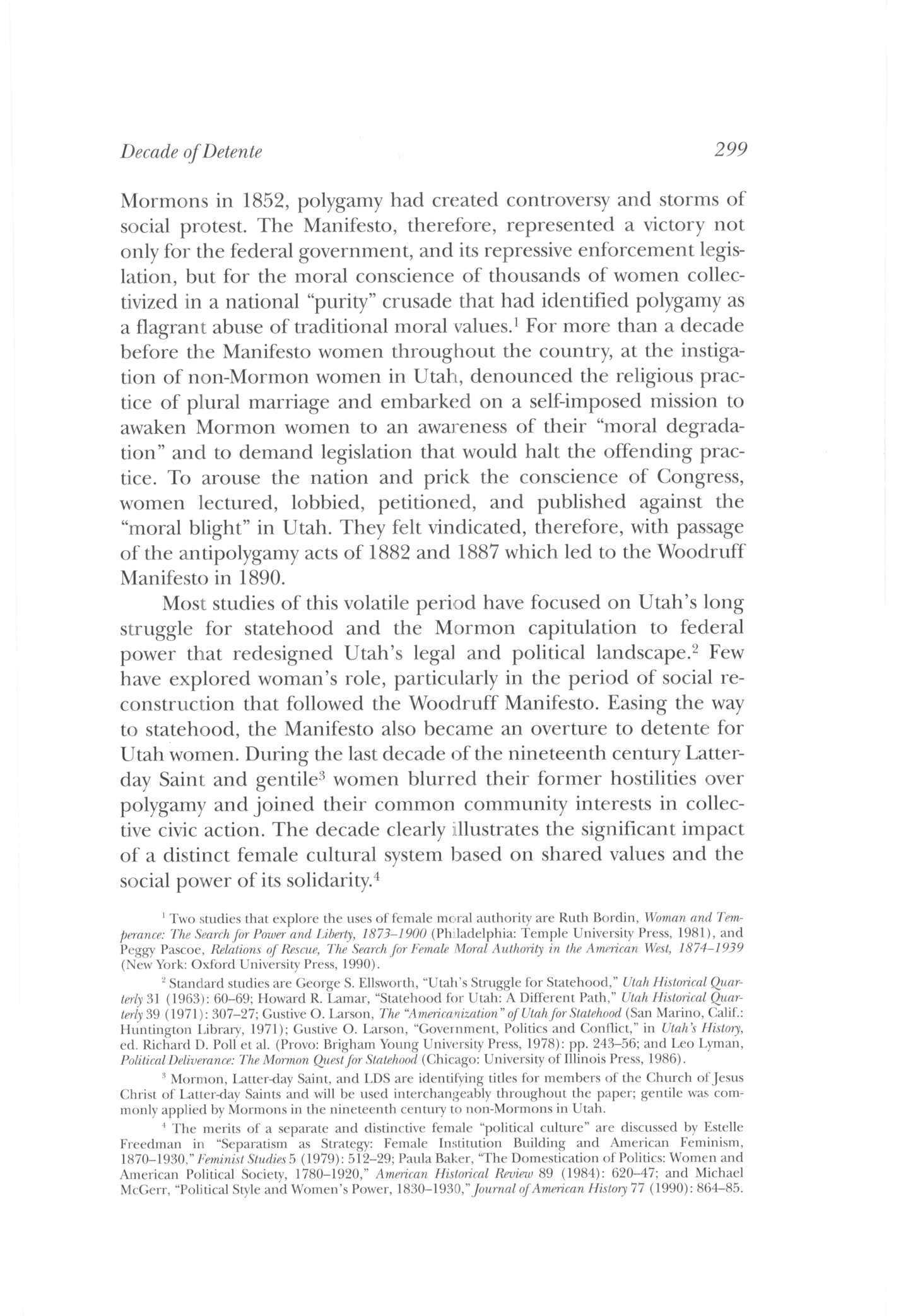
2 Standard studies are George S. Ellsworth, "Utah's Struggle for Statehood," Utah Historical Quarterly 31 (1963): 60-69; Howard R Lamar, "Statehood for Utah: A Different Path," Utah Historical Quarterly^ (1971): 307-27; Gustive O. Larson, The "Americanization" of Utahfor Statehood (San Marino, Calif.: Huntington Library, 1971); Gustive O Larson, "Government, Politics and Conflict," in Utah's History, ed. Richard D. Poll et al. (Provo: Brigham Young University Press, 1978): pp. 243-56; and Leo Lyman, Political Deliverance: The Mormon Qiiestfor Statehood (Chicago: University of Illinois Press, 1986)
s Mormon, Latter-day Saint, and LDS are identifying titles for members of the Church of Jesus Christ of Latter-day Saints and will be used interchangeably throughout the paper; gentile was commonly applied by Mormons in the nineteenth century to non-Mormons in Utah
4 The merits of a separate and distinctive female "political culture" are discussed by Estelle Freedman in "Separatism as Strategy: Female Institution Building and American Feminism, 1870-1930," Feminist Studies 5 (1979): 512-29; Paula Baker, "The Domestication of Politics: Women and American Political Society, 1780-1920," American Historical Review 89 (1984): 620-47; and Michael McGerr, "Political Style and Women's Power, 1830-1930," Journal of American History'77 (1990): 864-85
Decade ofDetente 299
After completion of the transcontinental railroad in 1869 more gentiles filtered into the remote Utah Territory as miners, military personnel, entrepreneurs, educators, and clerics Bringing their families with them, they established a small, diverse, non-Mormon population. United in their antipathy to polygamy, gentile women, through formation of an antipolygamy society in 1878 and publication of the Anti-Polygamy Standard two years later, made a visible and vocal stand against the practice. Their opposition was not only ideological but practical. In 1872 when the Mormon legislature abolished the dower right, a move that helped to equalize the claims of plural wives on their husband's estates, legal first wiveswere deprived of a common law protection.5 Also distressing was Utah's permissive divorce law.Although it prevented polygamy from being "a system of bondage" for plural wives, as explained in a defensive Deseret News article, it also made Utah an infamous divorce capital in the 1870s.6 Even woman suffrage, granted in 1870, merely entrenched Mormon political dominance and secured LDS practices, gentile women believed They vigorously campaigned for its repeal, willing to lose their own franchise in order to lessen the political imbalance in Utah Congress responded by repealing woman suffrage in Utah as a provision of the 1887 Edmunds-Tucker Act.
The Manifesto thus became a prelude to conformity with American political and legal tradition and helped redefine the parameters of female community in Utah. The "tendency toward female association," which had budded early in the century into religious and benevolent societies, flowered by the end of the century into secular cultural clubs and reform organizations. These associations brought women together in collective efforts for self-improvement, philanthropy, and social welfare. They also facilitated women's entry into the public realm and gave their members a growing share of public influence as they transformed social needs into public policy.7 The
5 The dower right provided a widow whose husband died intestate with a one-third interest in his real property and before his death an inchoate one-third interest
6 A Deseret Weekly News article, "Divorce," October 3, 1877, explains the position of the LDS church towards divorce Though the law had been in effect since 1852, its liberal grounds and residency provisions brought hundreds of divorce-seekers to Utah after completion of the transcontinental railroad in 1869 For more information about how Utah law accommodated the practice of plural marriage see Carol Cornwall Madsen, "'At Their Peril': Utah Law and the Case of Plural Wives, 1850-1900," in Western Historical Quarterly 21 (1990): 425-44
7 Barbara Leslie Epstein analyzes this transition in The Politics of Domesticity, Women, Fvangelism, and Temperance in Nineteenth Century America (Middletown, Conn.: Wesleyan University Press, 1981), as does Karen J Blair in The Clubwoman as Feminist: True Womanhood Redefined, 1868-1914 (New York: Holmes & Meier Publishers, 1980)
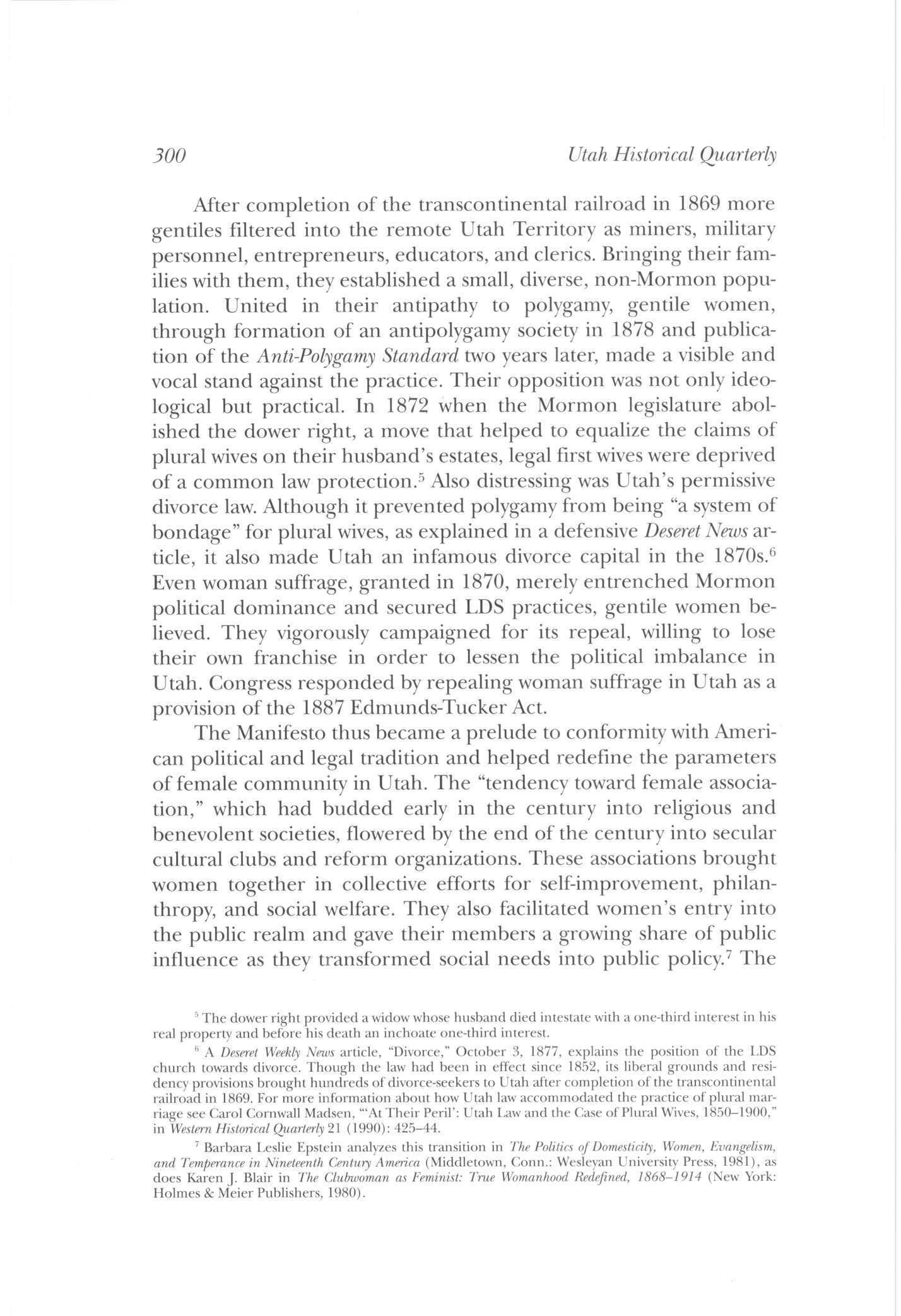
300 Utah Historical Quarterly
challenge that lay before Utah women after the Woodruff Manifesto was how to make their common female community interests bridge the chasm polygamy had created. For a decade their enthusiasm to join the surge of associated female activity that had swept the country elsewhere muted the strident chords of the recent conflict
Until the Manifesto the public activities of Utah women had followed different tracks. Both LDS and gentile women responded to the welfare needs of their own religious groups by organizing benevolent and social aid societies. LDS women attacked social problems through the Relief Society, which had flourished throughout the church since 1867, dispensing Christian charity, instructing its members in economic self-reliance, and promoting home industries, notably the processing of silk and the merchandising of home-crafted products.8
Though their numbers were far fewer, Protestant, Catholic, and Jewish women in Utah used their women's associations to help establish hospitals, to organize nurses' training programs, and to provide a variety of benevolent and social services In 1884 Baptist women organized a Ladies Aid Society for charitable service along with Sunday Schools and Christian Endeavor Societies to promote Christian principles. Emma Parsons, who directed the Sunday School, also gave temperance lectures. Several other Baptist women organized a Loyal Temperance Union.9 Temperance was a major goal of women's reform associations, following the lead of the immensely popular Woman's Christian Temperance Union. The Congregationalists organized a sewing school for young women along with a benevolent society. During one period they sponsored four charitable societies to provide help for "any whom we find in need" regardless of denomination. The Women's Society of the Methodist Church was active in recruiting teachers and social workers and sponsored two boarding houses for women as well as a home for girls. The Presbyterians organized a Ladies Aid, a Women's Missionary Society, and a Young People's Society of Christian Endeavor.10
8 The Relief Society was originally organized in Nauvoo, Illinois, in 1842. It was disbanded two years later In 1854, seven years after the church had settled in Utah, several ward Relief Societies were organized in Salt Lake City, but not until 1867 was the Relief Society organized throughout the church For a review of the various charitable organizations developed during this period see Emmeline B Wells, Charities and Philanthropies: Woman's Work in Utah (Salt Lake City, 1893). See also Kate B. Carter, "Men's and Women's Societies, Clubs and Associations," pamphlet, Daughters of the Utah Pioneers lesson for February 1950, pp 209-52
9 R Maude Dittmar, "A History of Baptist Missions in Utah, 1871-1931" (M.A thesis, University of Colorado, 1931), p 44
10 Carter, "Men's and Women's Societies," p 219; see also John Sillito and Constance Lieber, "A Heritage of Conflict, Women and Religion in Utah, 1847-1920," paper in possession of author, pp 15-20
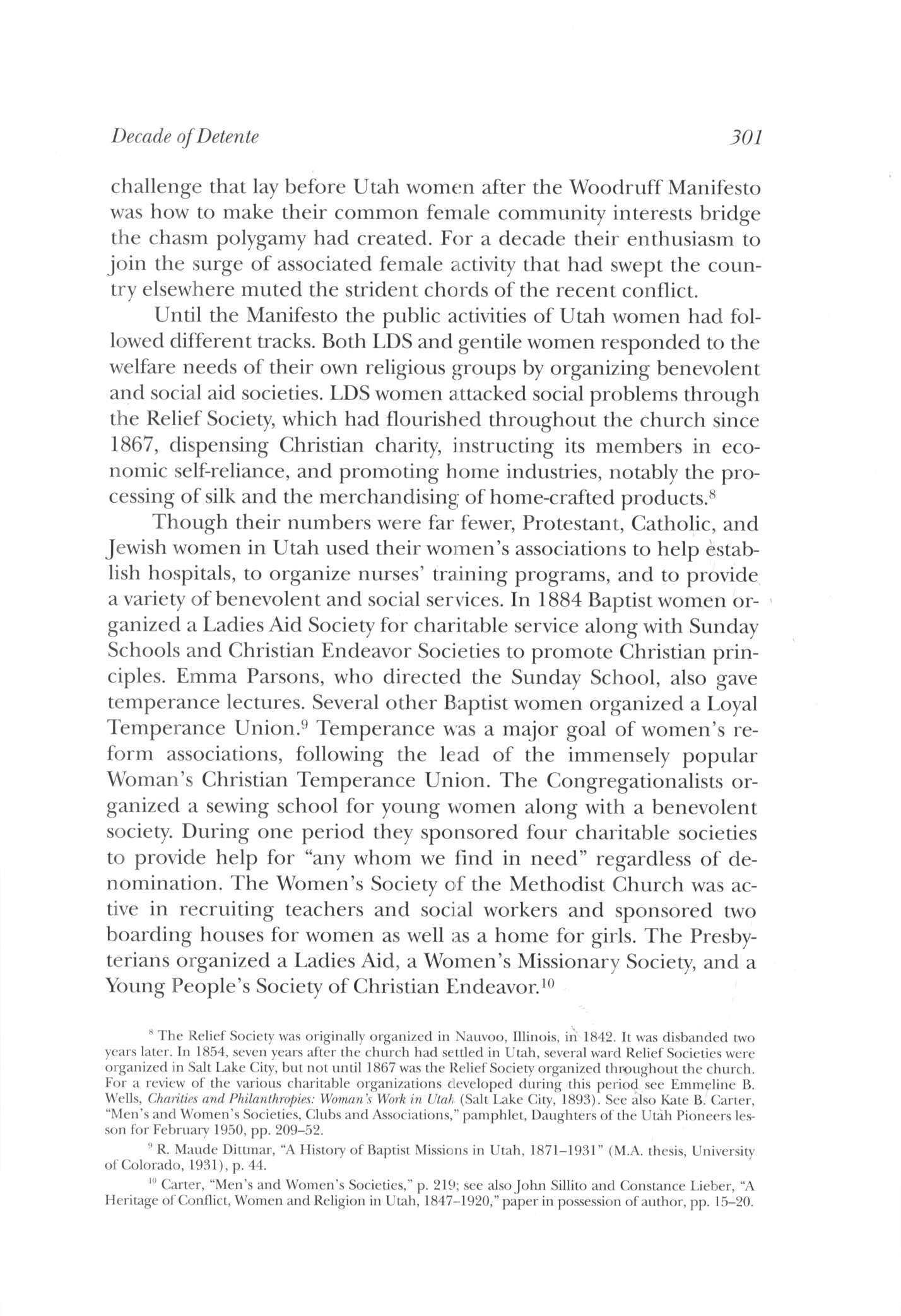
Decade ofDetente 301
Establishing one of the earliest hospitals in Utah marked the major community service of the Episcopalians in 1871 Staffed and directed by women, it also supported a nurses training school. The Catholics also opened a hospital as well as an orphanage, and Catholic Charities became a substantial and enduring benevolent organization in Utah.Jewish women, who constituted one of the smallest of the women's groups in Utah, were among the first to organize a benevolent society in the late 1860s, and theJewish community enjoyed the assistance of several Christian denominations in building its synagogue. 11 Thus, even as the divisive antipolygamy campaign convulsed Utah, some of the public activities that united community women across religious boundaries elsewhere also flourished in Utah but along denominational lines.
With the official retreat of polygamy, however, women were quick to forge inclusive bonds. They took their impetus for united effort from national as well as local social issues, rapidly discovering the impact of female collectivity. One significant area of detente was politics, which required a major shift in loyalty and political practice. For women it was especially difficult Lingering traces of hostility from the antipolygamy campaign complicated initial efforts to form a grass-roots movement to reclaim the vote in 1889. With only a few exceptions, gentile women, still apprehensive about Mormon political domination, refused tojoin. They registered a second protest in 1895 during the debate on woman suffrage in the Utah Constitutional Convention.12 However, after woman suffrage was voted into the Constitution, old resentments diminished and politics became a social arena which made allies of former political foes.13
New political coalitions had earlier been formed when the local People's (Mormon) and Liberal (gentile) political parties disbanded in favor of the national parties in 1891.14 With female suffrage guaranteed by the new state constitution, the two political parties eagerly courted women to their ranks and included them on every level of organization, recognizing their potential political power. Though most gentile women favored the Republicans and LDS women the
11 Carter, "Men's and Women's Societies," p 226; Sillito and Lieber, "A Heritage of Conflict," pp. 32, 34. For data on the early settlement of Jews in Utah see Leon L. Watters, The PioneerJews of Utah (New York: American Historical Society, 1952)
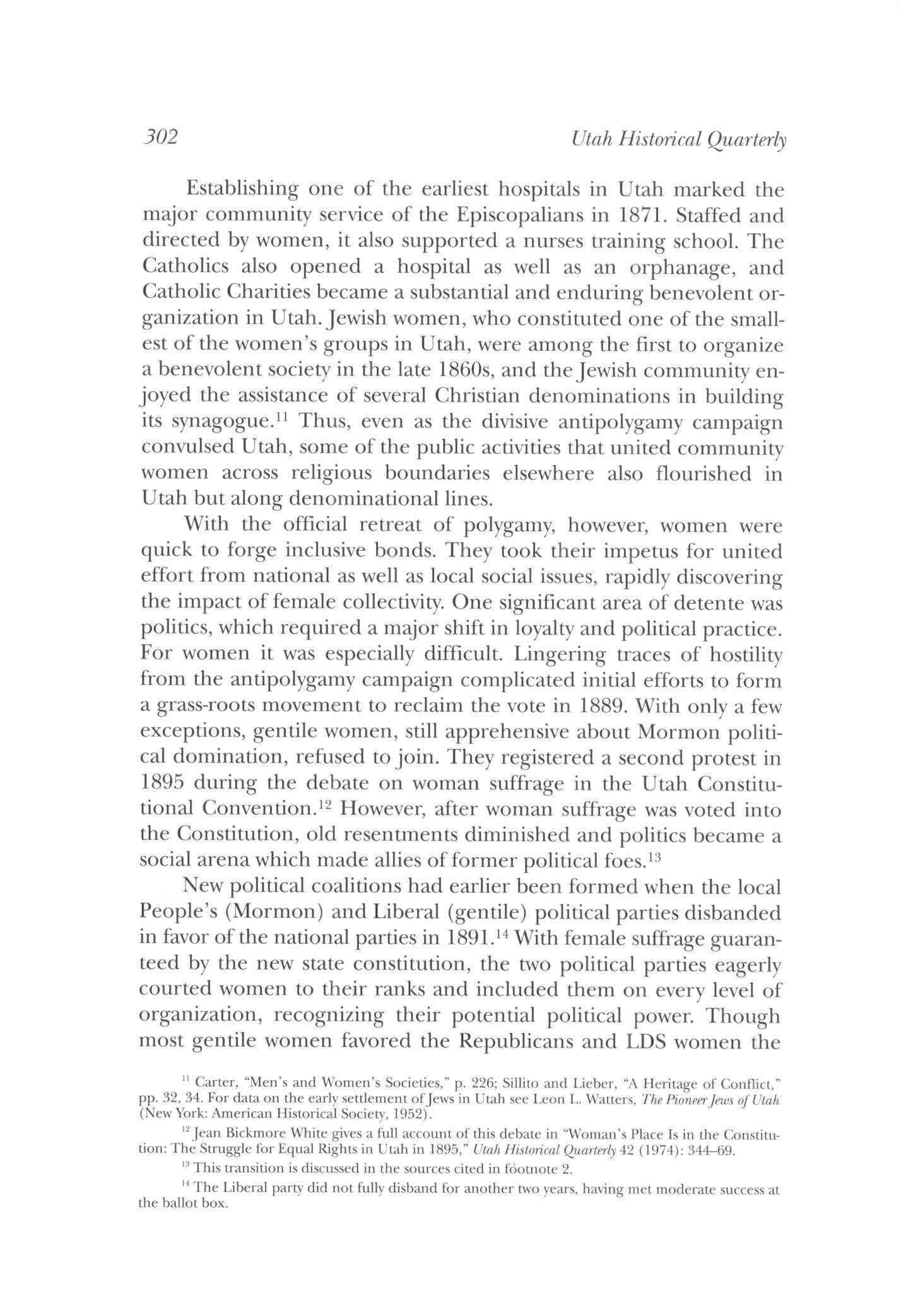
12 Jean Bickmore White gives a full account of this debate in "Woman's Place Is in the Constitution: The Struggle for Equal Rights in Utah in 1895," Utah Historical Quarterly 42 (1974): 344-69
13 This transition is discussed in the sources cited in footnote 2
14 The Liberal party did not fully disband for another two years, having met moderate success at the ballot box
302 Utah Historical Quarterly
Democrats, some resisted the trend and joined the other party For the first time women found themselves in the same political camp as their former opponents, campaigning, fund-raising, and rallying together for their respective parties, and even running for office on the same ticket. These new political configurations broke through the long-standing religious alignment. The triumph of politics over religion became evident in the results of the first state election in which women could vote. The party affiliation, not the religious, determined the winners. Both Mormon and non-Mormon women were elected to the state legislature and various county offices.15
After regaining the vote with statehood, Utah women supported the newly organized Utah Council of Women, which superseded the former territorial suffrage association. At the request of Carrie Chapman Catt, president of the National American Woman Suffrage Association, the Utah Council of Women was organized to aid other states in their suffrage quest. Utah women representing all faiths and both political parties joined the Council and remained active until November 1920 when the Nineteenth Amendment was ratified giving the franchise to all women in the nation.16
While Utah women were debating party politics they were also engaged in another pursuit, once a major point of discord but rapidly becoming an element of conciliation Education had been one of the earliest fronts on which the Mormon-gentile battle was fought in Utah At settlement the LDS church established ward schools throughout the territory, with instructors selected from among the settlers and tuition charged to remunerate the teachers and maintain the schools. The parochial schools, established by the gentile denominations in the 1870s and supported by national religious and educational associations, challenged the LDS school system by offering trained teachers, modern pedagogical methods, and free tuition, factors that attracted many LDS children.17 Both systems labored to inculcate their own values. Gentile teachers approached
''Jean B White, "Gentle Persuaders, Utah's First Woman Legislators," Utah Historical Quarterly 38 (1970): 31-49. It is ironic that during this period of Mormon-gentile detente politics became a divisive factor in LDS sisterhood The entrance of Utah women into party politics is discussed in Carol Cornwall Madsen, "Schism in the Sisterhood: Mormon Women and Partisan Politics, 1890-1900," in Davis Bitton and Maureen Ursenbach Beecher, eds., New Views of Mormon History, Fssays in Honor of LeonardJ. Arrington (Salt Lake City: University of Utah Press, 1987), pp 212-41
16 Susan B Anthony and Ida Husted Harper, eds., The History of Woman Suffrage, 6 vols (Rochester, N.Y: Susan B Anthony, 1902), 4:949-50; 6:644-50
" Attendance figures for the Ogden Academy, for example, compiled by the Congregationalsponsored New West Education Commission which supported a teaching mission in Utah, indicate that Mormon enrollment ranged from 26 to 74 percent of the total studentbody over a five-year period in

Decade of Detente 303
their work in Utah with missionary zeal, and indeed many were sent to Utah expressly commissioned to dissuade young Mormons from engaging in plural marriage For two decades LDS leaders had consistently opposed a free territorial public school system, reluctant to surrender control of curriculum and personnel in the ward schools.18 Antipolygamy laws in the 1880s and a growing gentile political power, however, led the legislature in 1890 to finally adopt a taxsupported public school system for the entire territory Another major barrier to rapprochement fell, and while both parochial and LDS-supported schools persisted, public school educators could join forces and shift their attention toward providing adequate public schooling for all Utah children.19
The time also seemed propitious to join the popular national kindergarten movement which had interested many Utah women since the 1870s. Camilla C. Cobb, adopted daughter of Utah educator Karl G. Maeser and a trained teacher herself from Dresden, Germany, introduced kindergartens to Utah in 1874. She had learned the early childhood educational principles of the famed Dr Friedrich Froeble and applied them in her teaching.20 Though meeting some initial apathy, she set up a small school "in the vestry of President Brigham Young's old schoolhouse inside the Eagle Gate." Her first pupils were her own children and those of John W. Young, son of Brigham Young.21 The spirit of kindergarten work proved infectious and small
the 1880s (See Annual Reports of the New West Education Commission, 1885-1890, Special Collections, Marriott Library, University of Utah, Salt Lake City.) Additional information on the development of public education in Utah can be found in Clyde Wayne Hansen, "A History of the Development of Non-Mormon Denominational Schools in Utah" (M.S thesis, University of Utah, 1953); Stanley S Ivins, "Free Schools Come to Utah," Utah Historical Quarterly 22 (1954): 321-42; C Merrill Hough, "Two School Systems in Conflict: 1867-1890," Utah Historical Quarterly 28 (1960): 113-30; Charles S Peterson, "A New Community: Mormon Teachers and the Separation of Church and State in Utah's Territorial Schools," Utah Historical Quarterly 48 (1980): 293-312
18 A discussion of Mormon opposition to public school education on ideological grounds is Allan Dean Payne, "Mormon Response to Progressive Education" (Ph.D diss., University of Utah, 1977)
'•' Although private LDS and other denominational schools continued to operate, the tax-based public school system naturally removed numerous students from private schools, forcing the closure of many of them The LDS Church Education System, however, maintained its interest in the education of Zion's youth by establishing academies, junior colleges, and extra-curricular religion classes
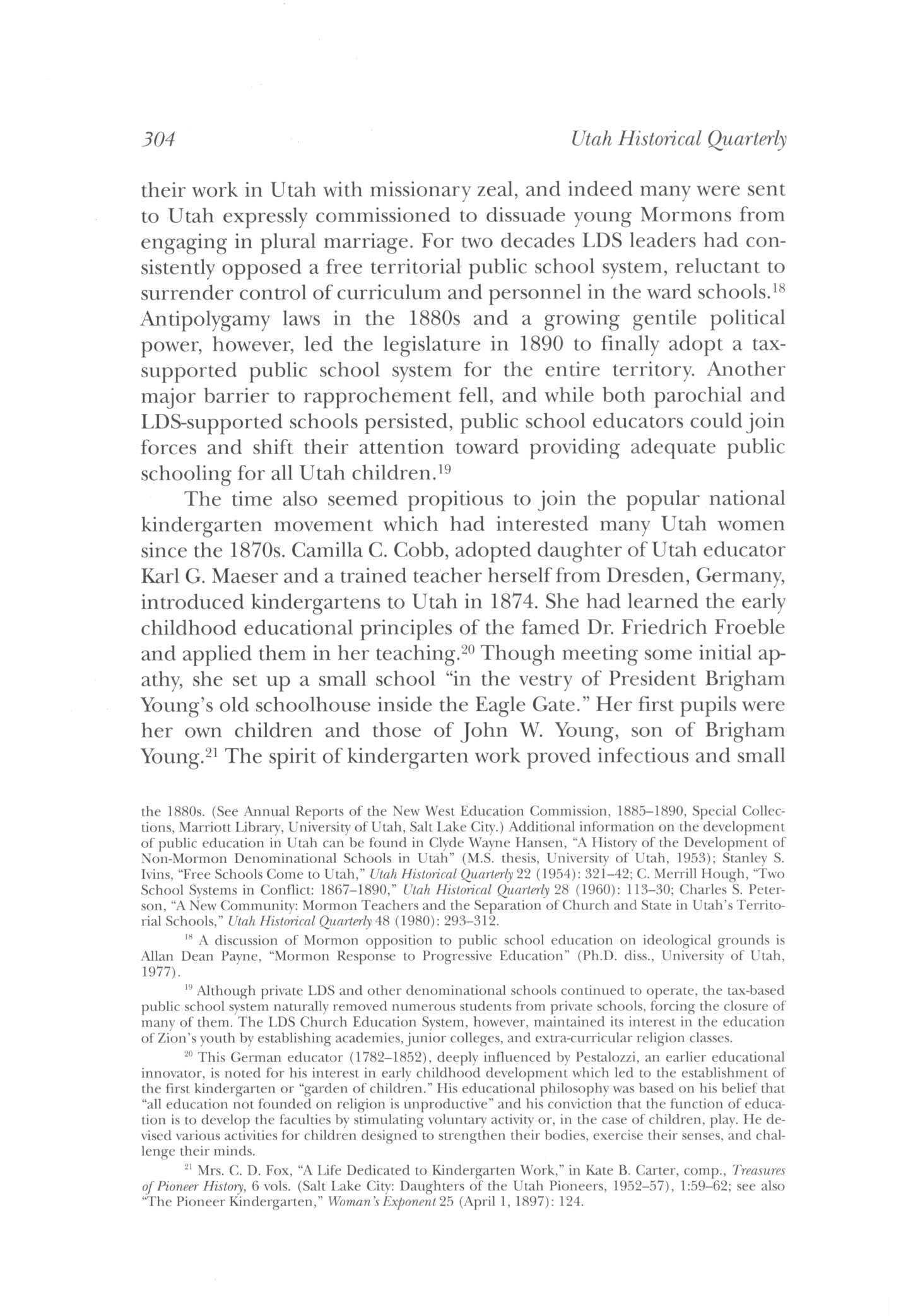
20 This German educator (1782-1852), deeply influenced by Pestalozzi, an earlier educational innovator, is noted for his interest in early childhood development which led to the establishment of the first kindergarten or "garden of children." His educational philosophy was based on his belief that "all education not founded on religion is unproductive" and his conviction that the function of education is to develop the faculties by stimulating voluntary activity or, in the case of children, play He devised various activities for children designed to strengthen their bodies, exercise their senses, and challenge their minds.
21 Mrs C D Fox, "A Life Dedicated to Kindergarten Work," in Kate B Carter, comp., Treasures of Pioneer History, 6 vols (Salt Lake City: Daughters of the Utah Pioneers, 1952-57), 1:59-62; see also "The Pioneer Kindergarten," Woman'sFxponent 25 (April 1, 1897): 124
304 Utah Historical Quarterly
independent kindergartens sprang up after Cobb's model Anna Elizabeth Richardson Jones and Elizabeth Dickey were among the first Protestant women in Utah to develop kindergartens, Jones opening a private school in 1880 and Dickey, through the auspices of the Presbyterian Women's Executive Board of Commissioners, in 1883.22 It was logical for the new kindergartens in Utah to be religiously sponsored because of their strong focus on moral training and the educational philosophy of their founder, Dr. Froeble.23
To better support the growing movement and secure funding and personnel, LDS and gentile educators formed city and territorial associations, but independent of each other In 1892 Mrs E H Parsons, a Baptist, organized the Salt Lake Kindergarten Association which imported a trained teacher to set up a kindergarten for children and a teacher training class for young women. The association also lobbied the legislature to grant local school boards the option to open kindergartens in their districts. Two years later, needing a stronger support base, the association enlisted the help of the city's women's clubs. At a meeting with the Ladies Literary Club, the Free Kindergarten Association was formed with educator Emma McVicker as president. That year the association sponsored the services of Alice Chapin of Boston, an expert in kindergarten training, who opened a training school and model kindergarten in the First Congregational Church parlors in Salt Lake City. She was well received by both Mormon and gentile teachers, who later attended her kindergarten training classes at the L^niversity of Utah.24
Sensing a competitive spirit in the flurry of interest in kindergarten training and mindful of the apparent lead taken by non-LDS women in the movement, LDS church leaders enthusiastically supported the organization of an LDS association in 1895 spearheaded by Sarah Kimball, Isabella Home, Elmina Taylor, Zina D. H. Young, Bathsheba W. Smith, and Ellis Shipp, all of them known more for their work in LDS women's associations than in education. They organized the Utah Kindergarten Association with a slate of officers that included seventeen directors and nine members of an advisory
22 Marie Fox Felt Papers, Histoiy of the Kindergarten, fid 4, Special Collections, Marriott Library, University of Utah
2:1 A brief discussion of the kindergarten movement as one aspect of social reform is William Leach, True Love and Perfect Union: The Feminist Reform of Sex and Society (New York: Basic Books, 1980), pp 331-34
24 Felt Papers; Journal History of the Church, June 18,1894, pp 4-5, LDS Church LibraryArchives
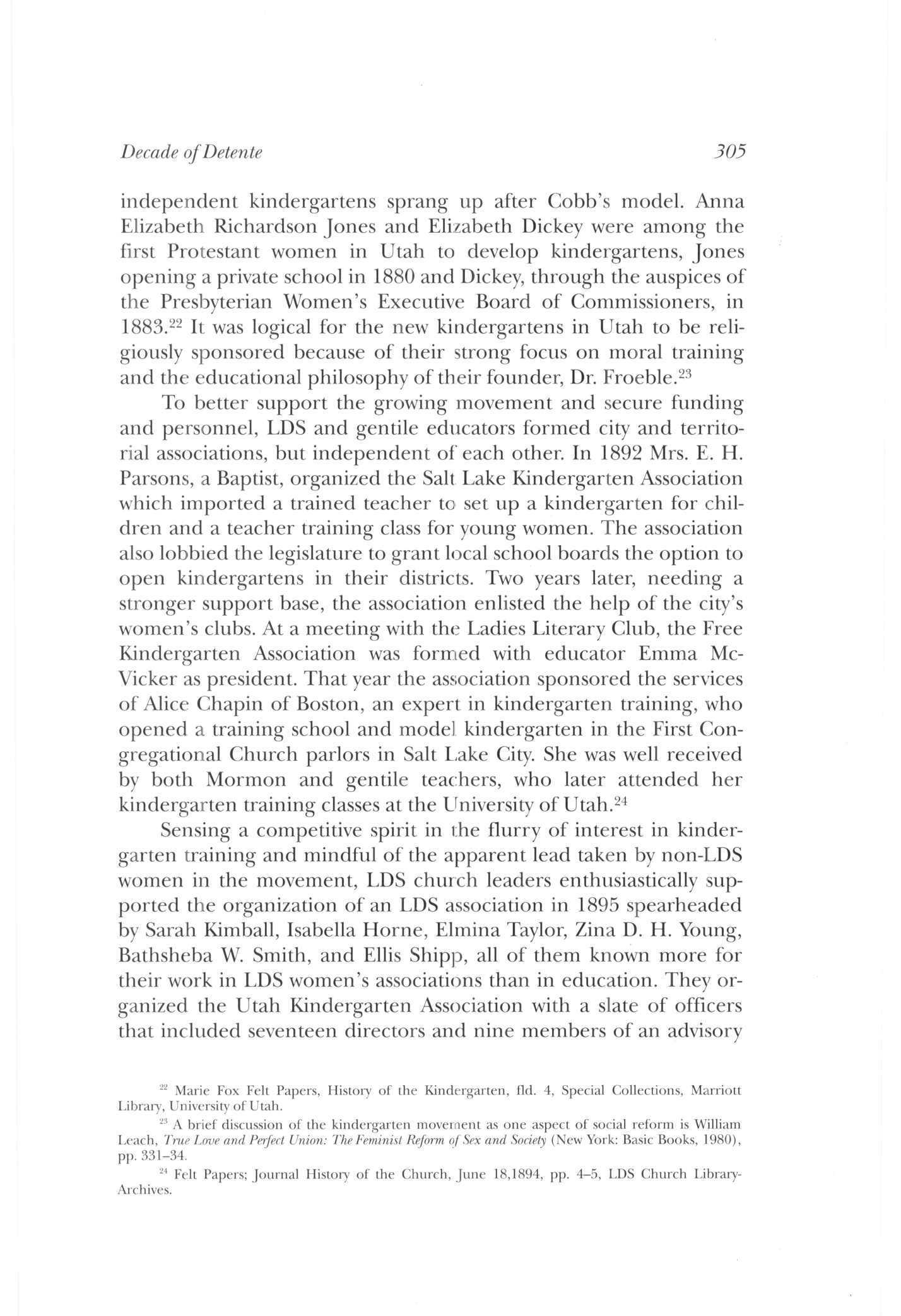
Decade ofDetente 305
board, six of whom were the organizers. Three kindergartens were opened soon thereafter under the auspices of the association as well as a training class for teachers taught by Anna R Craig of the Brigham Young Academy, ironically, a non-Mormon. She was assisted by Nettie Maeser and Emmeline Y Wells (not to be confused with Emmeline B. Wells), two strong Mormon advocates of the program. With the association's backing, other women, including Louie B. Felt and May Anderson, leaders of the LDS children's Primary Association, also tried their hands at teaching kindergarten while introducing some of its philosophy into the Primary.25
By 1896 the overlap of goals and methods, mutual need for funding and lobbying power, and the new spirit of detente prompted the two associations to merge. Officers elected at the first annual meeting of the combined groups represented a cross section of men and women, Mormon and gentile, and professional and volunteer, all dedicated to establishing kindergartens in Utah. Their parochial interests were submerged in their mutual enthusiasm for early childhood education and the establishment in Utah of the progressive methods popular elsewhere in the country. The circular announcing the formation of the association was signed by representatives of all of the religious groups in Utah, indicating their continuing stake in education The newly organized Utah State Kindergarten Association, assisted by the lobbying committee of the Utah Federation of Woman's Clubs, obtained legislation in 1898 providing funds for a state kindergarten training school at the University of Utah, and additional legislation in 1903 provided that at least one kindergarten be opened and maintained in every town in Utah of 2,500 inhabitants.26 During the remainder of the century Utah kindergarten women attended national conferences together, engaged the services of prominent educators, and planned numerous fund-raising socials, all as progressive women of Utah.
The local kindergarten movement, along with varied other educational and civic projects, was given a strong boost when the Utah Federation of Woman's Clubs was organized in 1893. Utah women had already experienced the support and visibility provided by affiliation with local, state, and national levels of women's associations,
25 Journal History of the Church, August 23, 1894, p 4; May 6, 1895, p 2; September 7, 1895, p 5; September 13, 1895, p 6; December 24, 1895, p 8
26 Mary B Fox, Director of Kindergarten, State Normal School, "The Practical Value of Kindergarten," Utah Lducational Review 1 (October 1907): 21-22

306 Utah Historical Quarterly
such as the National American Woman Suffrage Association, National Council of Women, and the Woman's Christian Temperance Union. Thus, when Charlotte Emerson Brown, first president of the General Federation of Woman's Clubs, urged her niece, Antoinette Brown Kinney of Salt Lake City, a member of the non-Mormon Ladies Literary Club, to organize a state federation, Kinney was quick to respond In April 1893 the Utah Federation was organized with six participating clubs, the second state/territory to federate.27
The club movement, which proliferated throughout late nineteenth century America, had penetrated Utah in the 1870s. Gentile women were the first to adopt social clubs in Utah.28 In 1875 Jennie Froiseth, who was at that time a leader in the antipolygamy cause, having brought national club woman Julia Ward Howe into the antipolygamy crusade as an ally, accepted Howe's suggestion to organize non-LDS women into the Blue Tea Club, so named by Howe.29 A difference in objectives among the members resulted in an offshoot club, the more popular Ladies Literary, with which the Blue Tea later merged. The Ladies Literary Club is credited with being Utah's first woman's club. It restricted its membership, claiming to be "an avowedly exclusive club for intellectual food and companionship."30
Other than the records of a Utah chapter of the Woman's Christian Temperance Union, organized in 1883, there is no evidence of additional clubs until the 1890s when a burst of organizing occurred. From 1890 to organization of the State Federation in 1893 at least eight women's clubs came into being: La Coterie of Ogden (1890); the Nineteenth Century Club of Provo (1890); the Utah Women's Press Club (1891); the Cleofan and the Reapers (1892); the Authors Club of Salt Lake City, the Aglaia of Ogden, and the Woman's Club
27 Mrs J C Croly, The History of the Woman's Club Movement in America (New York: Henry G Allen & Co., 1898),'p H12
28 An exception might be the Philomathean Club, organized in Payson, Utah, in 1872 One extant newsletter, The Philomathean Gazette, dated December 23, 1872, is available in Special Collections, Harold B Lee Library, Brigham Young University, Provo I am indebted to Alyson Rich Jackson for drawing my attention to this source.
29Julia Ward Howe was an inveterate club woman, In 1871 she presided over the New England Woman's Club, one of the country's first woman's clubs, and helped found the General Federation of Woman's Clubs in 1889, serving as a director from 1893 to 1898 The Blue Tea took its name from the term "blue stocking," given to literary women in England a century earlier and the "dainty pink teas" they sponsored See Katherine B Parsons, History ofFifty Years, Ladies Literary Club, Salt Lake City, Utah, 1877-1927 (Salt Lake City: Arrow Press, 1927), pp 22-24
30 Parsons, History ofFifty Years, pp 2-24 See also Journal History of the Church, April 27, 1917, pp 7-8 Papers of the two clubs are housed in Special Collections, Marriott Library, University of Utah

Decade ofDetente 307
of Springville (1893).31 That women in smaller, rural areas also joined the organizing bandwagon is very likely, their records, if any, probably passing informally to each succeeding officer In 1892, capitalizing on the nation-wide organizational craze, Olive Thorne Miller, a national writer, prepared "a practical guide and hand book" for inexperienced club women entitled The Woman's Club. It not only offered suggestions for every conceivable type of organizational pattern, it also preached the philosophy of club work, particularly applicable to Utah. "Cooperation," she wrote, according to a review of the book in the Woman's Exponent, "uplifts as well as harmonizes those elements in society and in home life that are otherwise left to individual cultivation or restraint and by mutual effort and sympathy much greater benefit to all must necessarily follow."32
With the help of Corinne M. Allen of the Ladies Literary Club and Nora M. Jones of the Provo Nineteenth Century Club, Antoinette Kinney called a statewide organizational meeting to which seven clubs and twenty-three delegates responded. Six clubs, both Mormon and gentile, elected to join the new federation: the Ladies Literary Club, the Salt Lake Woman's Club, the Nineteenth Century Club, La Coterie, the Cleofan Club, and the Utah Women's Press Club.33
Almost immediately the new federation developed programs to improve the social landscape of Utah. Its objective reflected the selfappointed role that club women were assuming in communities throughout the nation: "To bring into communication with one another the various women's clubs in Utah, that they may compare methods of work and become mutually helpful . . . and in general to promote such measures as shall best advance the educational, industrial, and social interest of the State."34 Though women's clubs, initially literary and cultural, were characterized as "post school education," their increasingly external focus on the state and national levels redefined them as influential agents for civic improvement and social change. Not as directly self-serving as some other national
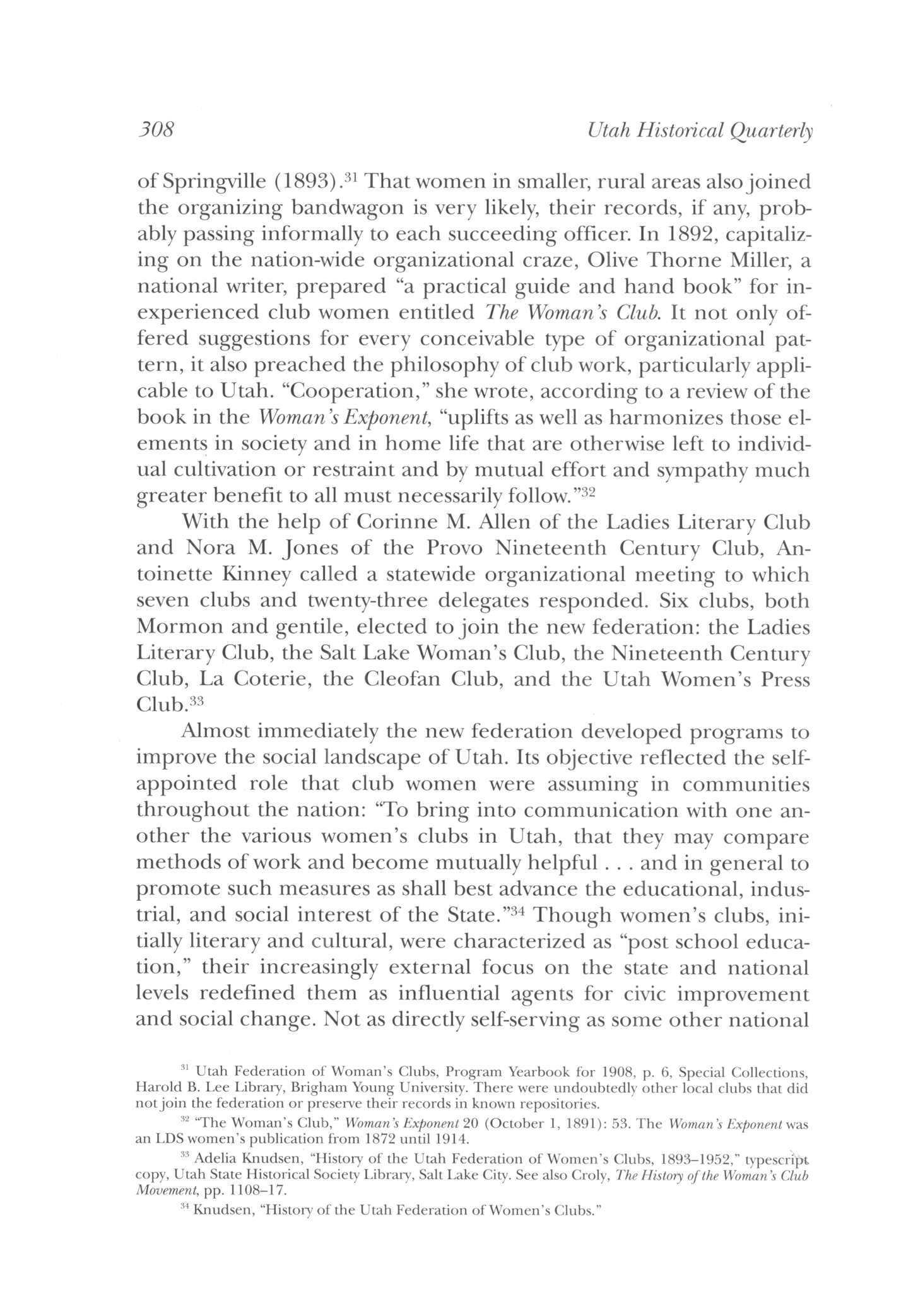
31 Utah Federation of Woman's Clubs, Program Yearbook for 1908, p 6, Special Collections, Harold B Lee Library, Brigham Young University There were undoubtedly other local clubs that did not join the federation or preserve their records in known repositories
' "The Woman's Club," Woman's Exponent 20 (October 1, 1891): 53 The Woman's Exponent was an LDS women's publication from 1872 until 1914
33 Adelia Knudsen, "History of the Utah Federation of Women's Clubs, 1893-1952," typescript copy, Utah State Historical Society Library, Salt Lake City See also Croly, The History of the Woman's Club Movement, pp 1108-17
54 Knudsen, "History of the Utah Federation of Women's Clubs."
308 Utah Historical Quarterly
women's associations, they were devoted less to promoting woman's status than to the development of community welfare. While individual clubs in Utah maintained their own cultural and philanthropic agendas, collectively they lobbied for libraries, kindergartens, public parks and playgrounds, protective legislation for women and children, juvenile courts, and preventive health measures. They also organized sub-committees within their individual groups to investigate other community needs.35 Their combined strength and the solidarity of their shared commitments gave them a prominent public presence
The federation not only brought the segregated clubs into collective effort in behalf of the community, but it also engendered social relationships as women found common interests and friendships that subordinated their religious identities.36 A garden party in 1893 introduced gentile guests Margaret Salisbury, Isabella Bennett, and the Honorable Aurelius Miner and his wife to the largely LDS membership of the Territorial Suffrage Association, the Utah Women's Press Club, and the Reapers Club, whose members had arranged the party.37 The social coup for a number of LDSwomen was an invitation to attend a meeting of the exclusive Ladies Literary Club held, ironically, in the former Industrial Christian Home for Women, a prodigious symbol of their former antagonism.38 Emmeline B.Wells, one of the fortunate few, observed, "Some years ago, no Mormon could be admitted as visitors even, but now things are different—we [Mormon women] are sought after We are getting more recognition and stand more on an equality with other women than formerly."39
The 1896 convention of the State Federation of Woman's Clubs was a model of congeniality. Euretha K. Barthe established the tone of cooperation in her welcoming address. Hailing the large gathering of women, "the first and largest assemblage of women in the new State" (statehood had occurredjust six months earlier), she charged
35 Utah Federation of Women's Clubs, Yearbook for 1908, p 6
36 Several non-Mormon women joined the Mormon-organized Utah Women's Press Club or participated in its activities after 1895 See Woman's Exponent 24 (June 15, 1895): 12; 25 (June 1, 1896): 18; 25 (December 15, 1896): 73 Mormon women had already begun affiliating with the Ladies Literary Club; and the Cleofan and Nineteenth Century Clubs, in particular, diversified their membership
:" Woman's Exponent 22 (August 15, 1893): 20.
38 Established by Congress at the instigation of Angie Newman, an avid antipolygamist crusader, for refuge and rehabilitation of disillusioned polygam3us wives, the Industrial Christian Home for Women failed to attract sufficient clients to maintain iti. original purpose See Pascoe, Relations of Rescue, pp. 24-?>\, 87-90.
39 Emmeline B. Wells, Diary, January 26, 1894, Special Collections, Harold B. Lee Library, Brigham Young University, Provo, Utah
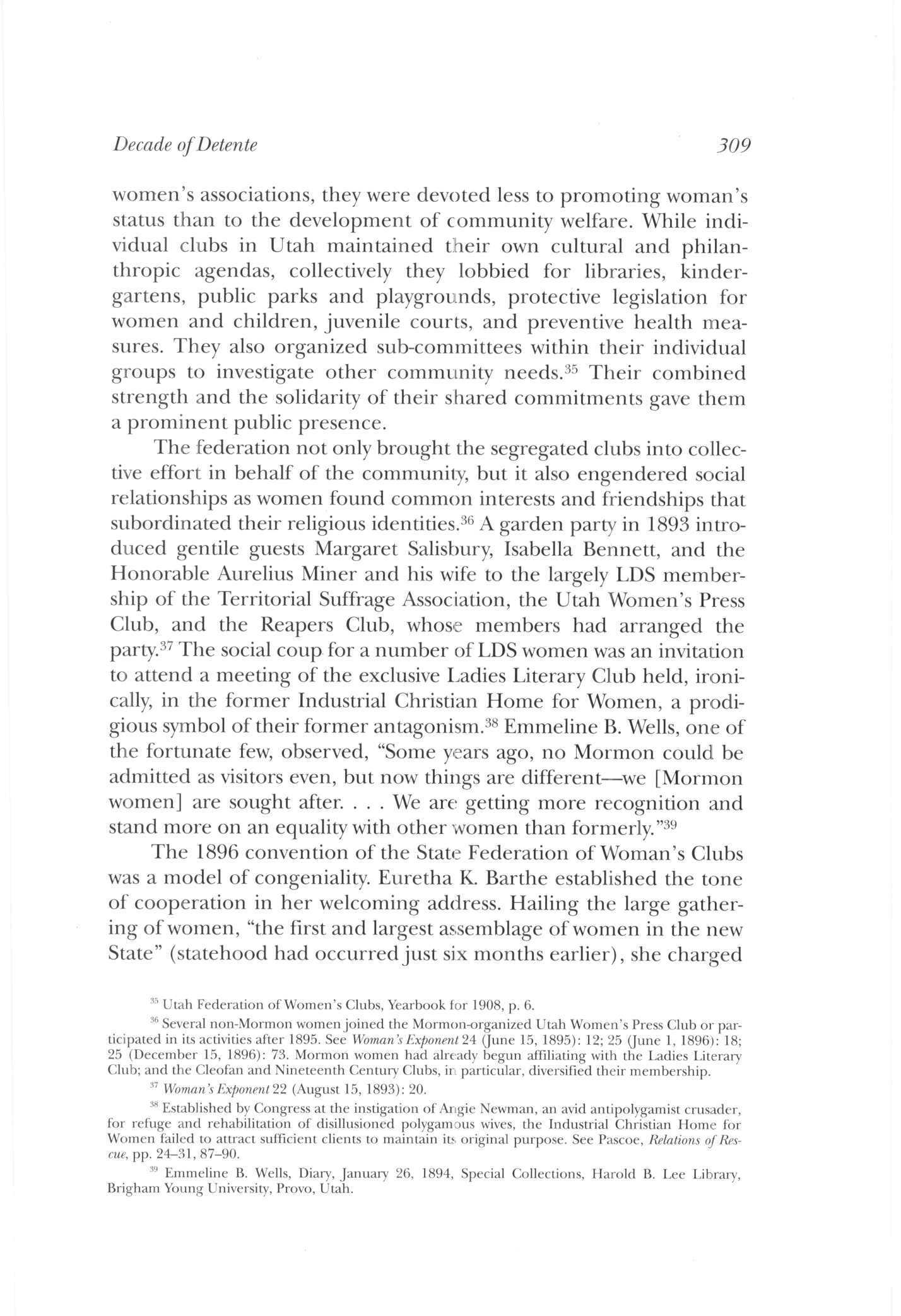
Decade ofDetente 309
the federation to "secure us leadership in matters now pressing for action in our State We represent the women of Utah," she affirmed, "of diverse ages, tastes and faith, banded together by common interest in all that pertains to the advancement and progress of women."
Dr. Romania B. Pratt, a Salt Lake City doctor, compared the Reapers Club, which she represented, to a small brook swept into the larger stream of the General Federation, "helping to create a mighty force of woman power" that would refine and improve the world.40 Like the social purists of an earlier decade, club women little doubted the potential of their collective action.
The appeal of federation enticed twenty-three additional women's clubs, both Mormon and gentile, to join before the end of the century, their members serving together on committees and participating at the annual conferences. Through these associations, with their civic agendas, Utah women united to express their female interests under the umbrella of public service and reform Associated effort, they discovered, gave women social impact, while petitioning and lobbying, political tools of the disfranchised, became even more effective in the hands of the politically empowered. The "Collect for Club Women," the federation's statement of purpose, professed the commonality of women's social culture as defined by the club movement. "May we strive to touch and to know the great common woman's heart of us all," the motto read That "the great common woman's heart" often found diverse objects for its loyalty and affection perhaps prompted the concluding caution: "Let us not forget to be kind." If Utah women could not experience total unity in addressing the issues and challenges of their common social environment, for a decade they were able to find some consensus in their diversity
Of all the avenues to detente, the 1893 Columbian Exposition in Chicago claimed the highest degree of cooperative effort among the largest number of Utah women. In fact, it was a major catalyst for associational activity among women across the country The creation of a Woman's Department within the administration of the exposition, with a separate Board of Lady Managers, invited female representation at the grand celebration (a year late) of Columbus's arrival in the New World and America's growth as a nation. The national Board of Lady Managers was replicated in every state and territory with representatives from each constituting the national board. To

310 Utah Historical Quarterly
40
"Utah Federation of Woman's Clubs," Woman's Exponent 25 (June 1896): 1, 2
display the industrial, artistic, and domestic achievements of the women of America, the board commissioned a Woman's Building. It was designed by a woman architect and decorated with paintings and statuary by women artists.41 The exposition, or World's Fair, as it came to be known, not only provided a showcase for women's industrial and artistic accomplishments but also offered an arena to demonstrate the connection between the public work of women and their social advancement The message of the fair was that collective action gave women a larger share in the "work of the world" and thus a distinct role in the shaping of that world.42
41 A complete account of women's role in the Chicago Exposition is Jeanne Madeline Weimann, The Fair Women (Chicago: Academy Chicago, 1981)
42 Gayle Gullctt explores these ideas in "The Political Use of Public Space: The Women's Movement and Women's Participation at the Chicago and Columbia Exposition, 1893," paper presented at the Berkshire Conference on Women's History, Wellesley College, June 1987, copy in possession of author.
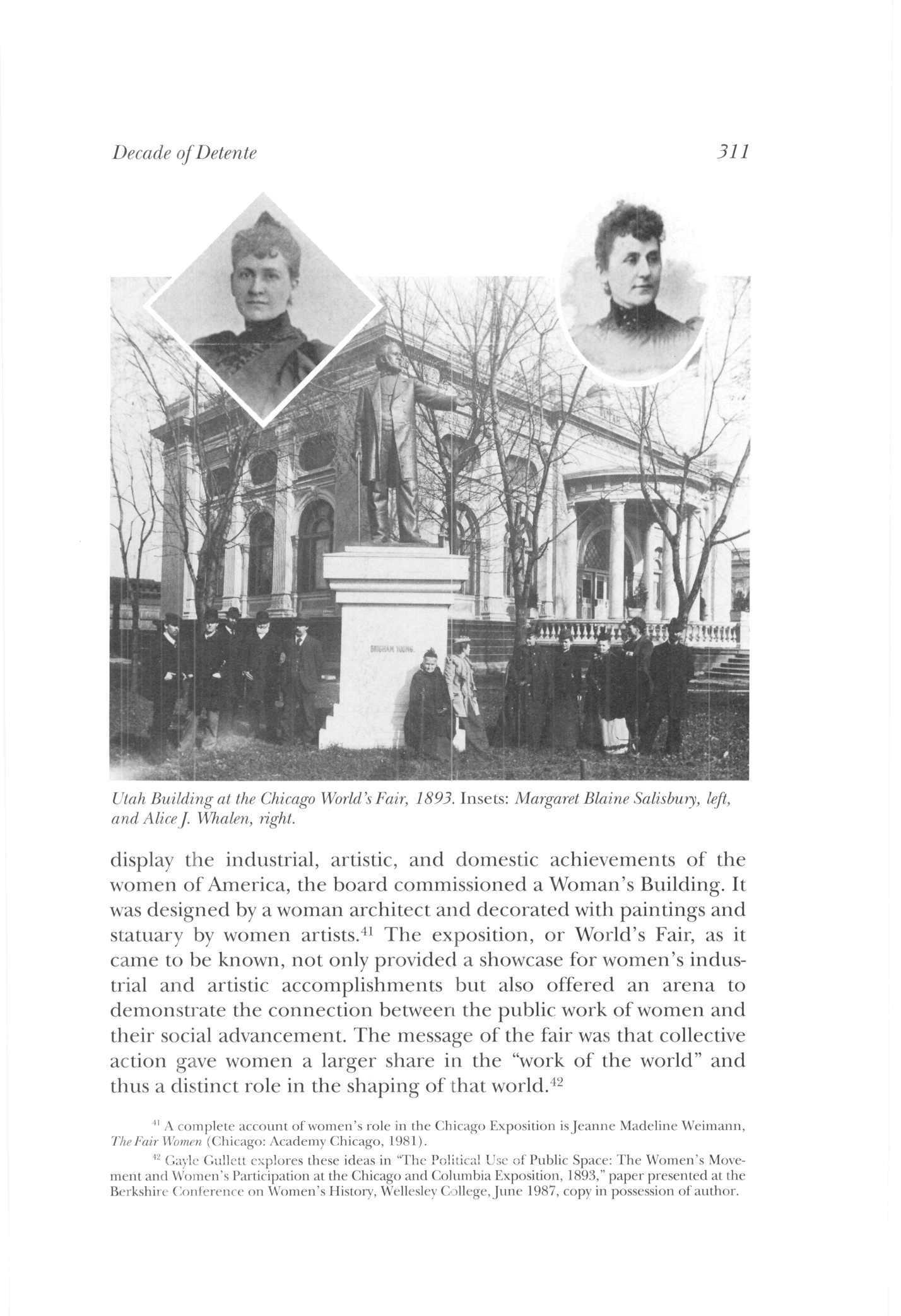
Decade of Detente 311
Utah Building at the Chicago World's Fair, 1893. Insets: Margaret Blaine Salisbury, left, and AliceJ. Whalen, right.
Utah Board of Lady Managersfor the World's Columbian Exposition. Center: Mrs. F. S. Richards, president; clockwise from upper left: Mrs. Electa Bullock, Miss May Preston, secretary, Mrs. F. D. Richards, vicepresident, Mrs. George W. Thatcher, Mrs. C. W. Lyman. From Utah at the World's Columbian Exposition.
Utah women were eager to participate, and the governor responded by appointing two non-LDS women as representatives to the national board: Alice J. Whalen of Ogden and Margaret Blaine Salisbury, niece of former secretary of state and presidential candidate James G. Blaine, and a personal friend of Bertha Palmer, president of the national Board of Lady Managers.43 The governor also appointed Emily S. Richards, a Latter-day Saint, to head a Utah Board of Lady Managers with both LDS and non-Mormon women as members. They in turn organized Columbian Clubs in each county to enlist workers and solicit handiwork to exhibit in the Utah and
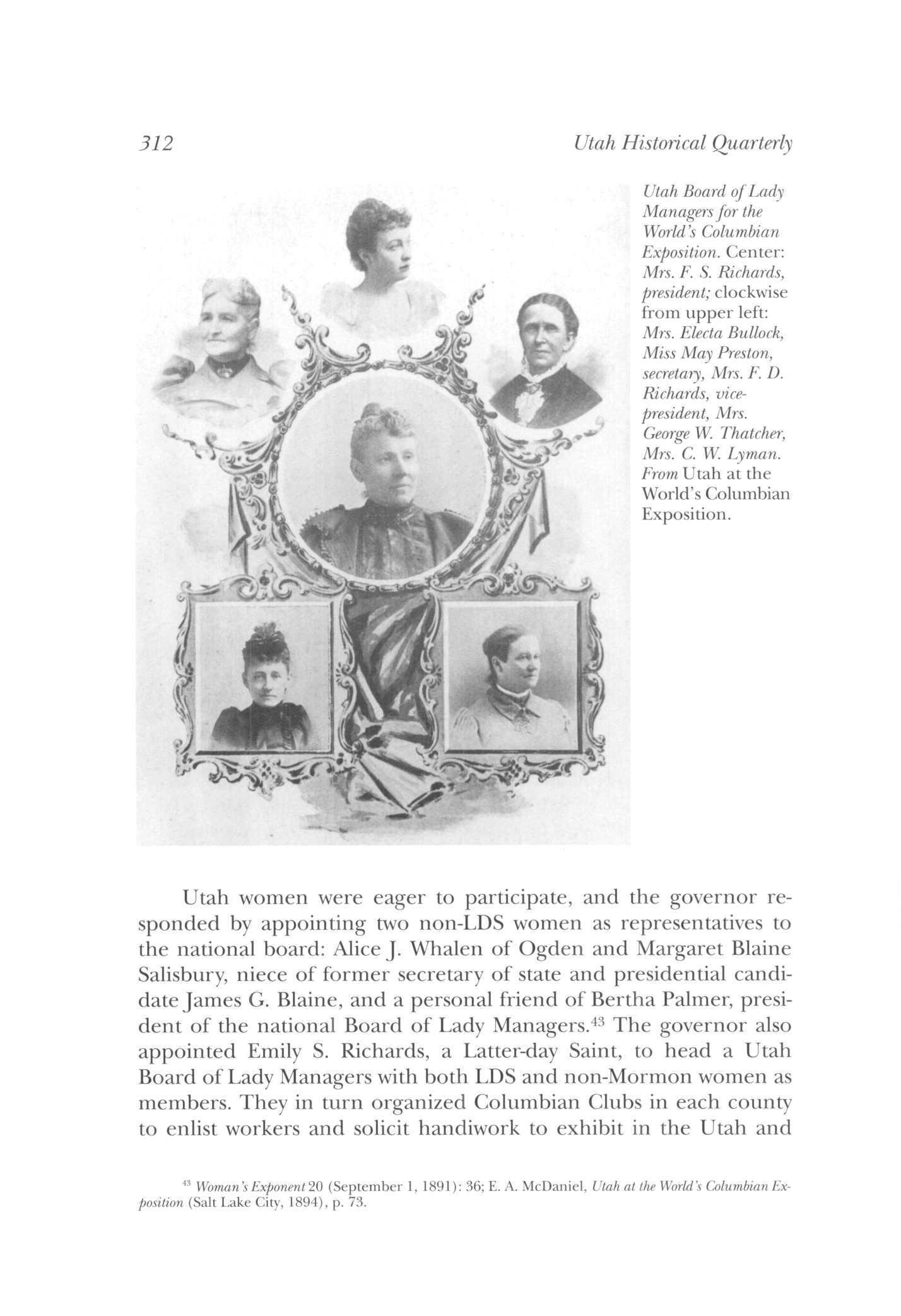
312
Utah Historical Quarterly
43 Woman's Exponent 20 (September 1, 1891): 36; E A McDaniel, Utah at the World's Columbian Exposition (Salt Lake City, 1894), p 73
Woman's buildings.44 To discern the reality of women's everyday experience the national board solicited from each state statistical surveys of women's employment and reports on their legal status, their clubs and societies, the philanthropy and reform work in which they were engaged, and other notable achievements.45 Utah women also produced three volumes that utilized much of the data: Charities and Philanthropies, Woman's Work in Utah, edited by general Relief Society secretary Emmeline B. Wells with the help of her non-Mormon friend EmmaJ. McVicker; Songs and Flowers of the Wasatch, a selection of poems by Utah women poets dedicated to Margaret Salisbury; and World's Fair Ecclesiastical History of Utah, compiled by representatives of all the religious denominations in Utah and edited by Relief Society leader Sarah M. Kimball. The preface to the Ecclesiastical History defined their hope for more tolerance and unity:

It is the earnest desire of members of the committee that a closer feeling of unity, and a broader desire for general helpfulness may result from the study of this little volume which we dedicate with love and prayers to the World's Columbian Exposition.46
In addition, twelve Utah women submitted their books to the library of women authors in the Woman's Building, including the antiMormon novels ofJennie Froiseth and Cornelia Paddock.47
Margaret Salisbury used her personal friendship with Bertha Palmer to obtain a special congressional appropriation to Utah women to prepare a silk exhibit for the Woman's Building in addition to the cream-colored silk curtains embroidered with the sego lily that Utah women contributed to its decor. Salisbury appointed Isabella Bennett, Corinne Allen, and Mormons Zina D H Young, Emmeline B. Wells, and Margaret A. Caine to arrange the exhibit. They invited skilled Utah women to demonstrate the entire silkmaking process. Sericulture, originally a Relief Society enterprise, had waxed and waned as a viable Utah industry. Over the years many
44 Margaret Salisbury's special appeal to the legislature for funds to support Utah women's contribution to the Woman's Building was a brief synopsis of the broad range of industry and productivity in which Utah women were engaged "whether in the studio, counting house, schoolroom, factory, mill, dairy, or the farm." She noted the many employments and professions in which women were trained and urged the legislature to allow Utah women the opportunity "to meet their sisters of the different States and Territories in a manner highly creditable to the energy, intelligence and talent which characterize the women of the West." See "An Able Appeal," Woman's Exponent 20 (March 1, 1892), 125-26.
45 See Weimann, TheFair Women, p. 381; also Woman's Exponent 21 (August 1, 1892): 24
46 World's Fair Ecclesiastical History (Salt Lake City, 1893), pp vi-vii
47 The others were Eliza R Snow, Hannah T King, Augusta J Crocheron, Mary Jane Tanner, Romania B Pratt, Mrs W S McCornick, Mary E Almy, Emily B Spencer, Hannah Cornaby, and Sarah E Carmichael See Woman's Exponent 22 (April 15, May 1, 1893): 156
Decade ofDetente 313
Utahns, Mormon and non-Mormon, had invested substantial effort to keep it alive. The fair invigorated their efforts. Women also contributed their handiwork to the Utah building Besides the silk-lined portiers, they contributed furniture, clothing, and other homeproduced silk articles that demonstrated their skills in sericulture, as well as art objects in Utah onyx, home-manufactured linens, and other products of native materials.48 With virtually no capital, only "the active energy and enterprise" of willing women, the exhibits made "a creditable showing" of Utah products.49
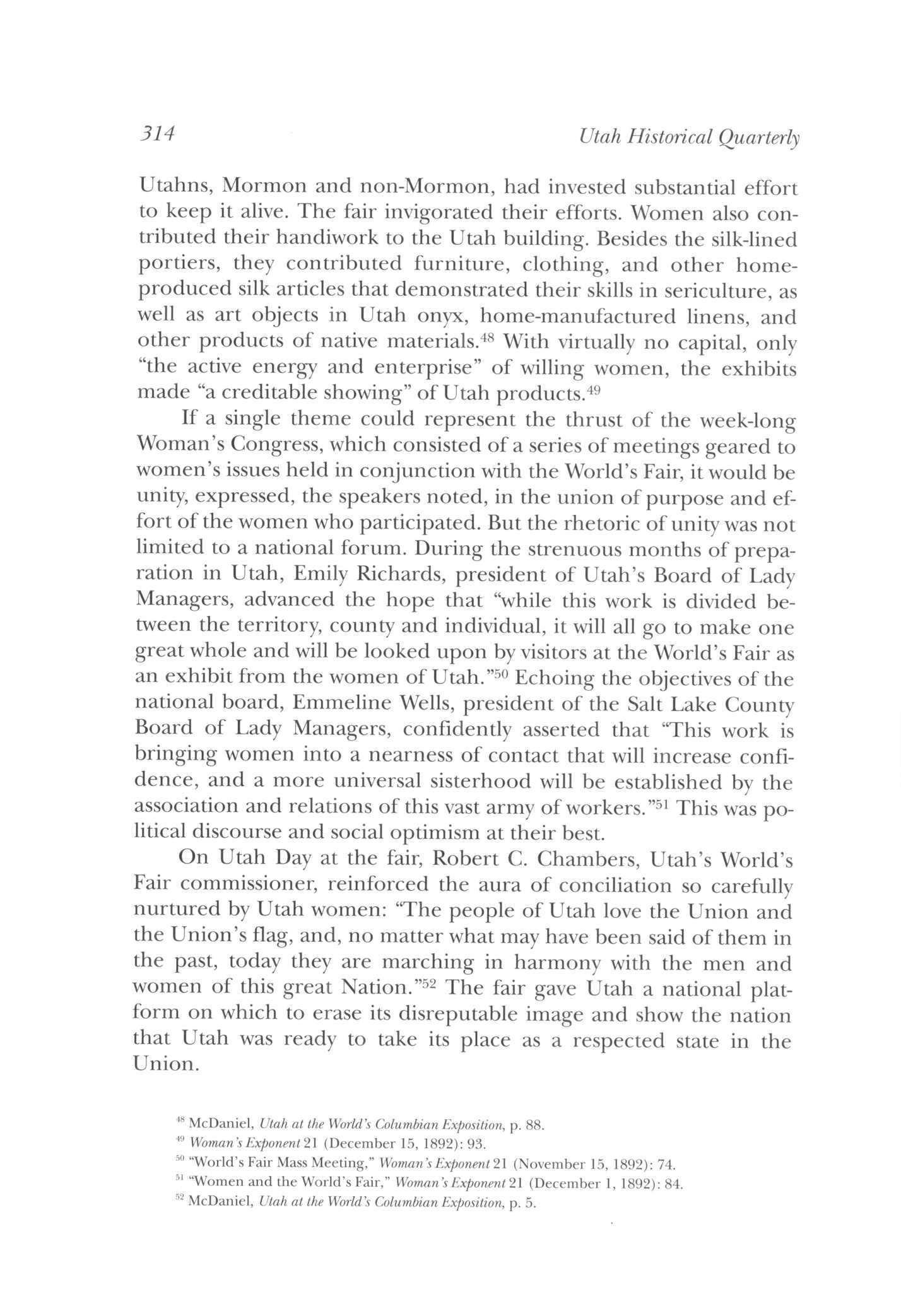
If a single theme could represent the thrust of the week-long Woman's Congress, which consisted of a series of meetings geared to women's issues held in conjunction with the World's Fair, it would be unity, expressed, the speakers noted, in the union of purpose and effort of the women who participated. But the rhetoric of unity was not limited to a national forum During the strenuous months of preparation in Utah, Emily Richards, president of Utah's Board of Lady Managers, advanced the hope that "while this work is divided between the territory, county and individual, it will all go to make one great whole and will be looked upon by visitors at the World's Fair as an exhibit from the women of Utah."50 Echoing the objectives of the national board, Emmeline Wells, president of the Salt Lake County Board of Lady Managers, confidently asserted that "This work is bringing women into a nearness of contact that will increase confidence, and a more universal sisterhood will be established by the association and relations of this vast army of workers."51 This was political discourse and social optimism at their best.
On Utah Day at the fair, Robert C Chambers, Utah's World's Fair commissioner, reinforced the aura of conciliation so carefully nurtured by Utah women: "The people of Utah love the Union and the Union's flag, and, no matter what may have been said of them in the past, today they are marching in harmony with the men and women of this great Nation."52 The fair gave Utah a national platform on which to erase its disreputable image and show the nation that Utah was ready to take its place as a respected state in the Union.
48 McDaniel, Utah at the World's Columbian Exposition, p. 88
49 Woman's Exponent 21 (December 15, 1892): 93
0 "World's Fair Mass Meeting," Woman's Exponent 21 (November 15, 1892): 74
51 "Women and the World's Fair," Woman's Exponent 2\ (December 1, 1892): 84
52 McDaniel, Utah at the World's Columbian Exposition, p. 5
314 Utah Historical Quarterly
The popularity of the silk-making demonstration at the fair and talk about a permanent woman's building prompted Utah women to work on a special silk exhibit for the building and to resuscitate the moribund silk industry in Utah With the urging of Margaret Salisbury's silk committee, the Utah legislature approved organization of a Utah Silk Commission. Zina D. H. Young was appointed president and Isabella E Bennett, Margaret A Caine, Ann C Woodbury, and Mary A. Cazier became members of the commission. A bounty of twenty-five cents for a pound of cocoons ignited a flurry of interest, but the bounty became too large a financial drain and was withdrawn in 1905.53 Despite its ultimate failure, this cooperative effort proved to be another consequence of the spirit of detente that had motivated so much community action during this socially conscious period.54
And so the decade drew to a close. The accommodation that had been achieved was remarkable considering the intensity of the prior discord. Personal friendships, cooperative civic projects, and organizational alliances emerged, healing differences and bridging the gulf of intolerance and conflict. Emmeline B. Wells, a noted LDS social activist and women's leader, wasjust one of many who found that her association with non-Mormons such as Margaret Salisbury, Emma McVicker, and Lillie Pardee became enduring friendships. Like other club women she brought the clubs she had founded, the Reapers and Utah Woman's Press Club, into cooperative participation in the Utah Federation of Woman's Clubs and the civic programs it supported. Capitalizing on the strength of unified action, the women of Utah were able to promote legislation and initiate programs and projects that would improve Utah's moral, educational, and social environment.
But the fragility of this carefully nurtured alliance was exposed even before the decade ended. The election of LDS church leader and polygamist B. H. Roberts to Congress in 1898 provoked another national woman's antipolygamy campaign It began with a protest from several Protestant groups in Utah, denouncing not only his marital status but the potential conflict of interest his dual offices posed It swelled into a national crusade embracing the press, religious
53 The history of sericulture in Utah can be found in Chris Rigby Arrington, "The Finest of Fabrics: Mormon Women and the Silk Industry in Early Utah," Utah Historical Quarterly 46 (1978): 376-96.
'

Decade ofDetente 315
4 Support for the silver standard also brought Mormon and gentile women together in a mass meeting, former polygamy adversaries sitting together speaking on the same platform, and signing their names on the same memorial to Congress See Woman's Exponent 22 (August 1, 1893): 12
organizations, and a host of national women's associations. Many of them, such as the powerful Woman's Christian Temperance Union, the National Christian League for the Preservation of Moral Purity, the National Association of Loyal Women ofAmerica, and the Free Baptist Women's Missionary Society, were members of the National Council of Women scheduled to hold its triennial convention in Washington in February 1899 in the midst of the campaign against Roberts.55 The LDS Relief Society, the Young Women's Mutual Improvement Association, and the Primary Association were also members. Pressured to add another resolution against him to the growing number by other women's organizations, the National Council faced the dilemma of acceding to the demands of some of its most influential members, thereby offending its long-time LDS affiliates, or protecting the interests of its loyal LDS members and possibly alienating the membership of its most noted ones. 56 The issue divided the delegates.
Supporting a resolution against Roberts, council president May Wright Sewall urged the Mormon delegates not to miss this "golden opportunity" to gain wider acceptance and prestige among the major women's organizations by voting with them on the Roberts issue. The dilemma was not easily resolved by the ten LDS participants, since Roberts's opposition to woman suffrage just four years earlier had alienated him from many of the women of Utah. Mormon loyalties prevailed over gender ties, however, and the Utah delegates, along with sympathetic members of the council, all spoke in defense of Roberts's constitutional right to be seated. Their arguments succeeded in convincing a majority of council members to pass the milder of the two resolutions proposed by the resolutions committee, which denounced all "lawbreakers" in public office rather than singling out Roberts or polygamy.57
The controversial issue continued to simmer when Mormonism's growth through an active proselytizing system alarmed antipolygamists who feared a revival of plural marriage. In 1902, even as LDS delegates sat in session at another triennial convention of the
55 For details of the woman's campaign against Roberts see William Griffin White, Jr., "The Feminist Campaign for the Exclusion of B H Roberts from the Fifty-sixth Congress, "Journal of the West 17 (1978): 45-52 See also Davis Bitton, "B H Roberts and the Election of 1898-1900," Utah Historical Quarterly 2b (1957): 27-46

56 The neutral quality of its credo was clearly in jeopardy A stated aim of the council was to "strive to overthrow all forms of ignorance and prejudice by the application of the Golden Rule to society, custom and law."
"' Wells Diary, February 26, 1899; Susa Young Gates, "The Recent Triennial Convention in Washington," Young Woman'sJournal 10 (May 1899): 204-5; New YorkJournal, February 18, 1899
316 Utah Historical Quarterly
National Council of Women, then numbering over a million members, representatives of the International Council of Women, the General Federation of Woman's Clubs, and "other kindred associations" spoke before the House Committee on the Judiciary in support of a constitutional amendment against polygamy. As a result of their appeal, Congress proposed a committee of investigation to study the "facts of missionary work in Utah."58
Though nothing came of the 1902 investigation, the issue exploded again a year later with the election of Apostle Reed Smoot to the Senate. Though he was a monogamist, opponents once again feared that his church position would compromise his political office. As with Roberts, a groundswell of opposition once again began in Utah, gaining in national support until a hearing was launched by the Senate Committee on Privileges and Elections. Not until February 1907, four years after his election, was he finally permitted to assume his place in the Senate.59
During the hearings women's groups were active against Smoot. In February 1904, at the Executive Meeting of the National Council of Women held in Indianapolis, an antipolygamy resolution was presented by the chair of the committee on resolutions, Elizabeth Grannis, who was also president of the National Christian League for the Promotion of Social Purity The resolution echoed the objective of the earlier purity crusade and had originated, according to Grannis, in Salt Lake City "by people who knew of the continued presence of polygamy." Mormon delegates Emmeline B Wells and Maria Y Dougall succeeded in getting it tabled.60
However, three months later the president of the National Congress of Mothers, who was also chair of the Legislative Committee of the National Federation of Woman's Clubs, proposed a resolution against polygamy and another antipolygamy constitutional amendment. Despite the "heroic" protests of Brigham Young University educator Alice Reynolds, a delegate to the convention of the National Federation, the resolution passed, and lobbying continued for an

58 Journal History of the Church, February 25, 1902, p 2
59 B H Roberts, A Comprehensive History of the Church, 6 vols, (reprint ed., Provo: Brigham Young University Press, 1965), 6:393-99
' "Executive Session N.C.W., Indianapolis, Indiana," Woman's Exponent 32 (February 1904): 68-9 The resolution stated: "Resolved That any practice which undermines the foundation of famiiy life should be strongly deprecated, and since polygamous marriage is a terrible evil, which threatens to destroy the home and the state in portions of our country, the people should petition and protest against the seating in our national Congress any man who may practice or subscribe to it."
Decade of Detente 317
amendment.61 For a period thereafter, the Congress of Mothers, an organization that had originally welcomed Mormon women, barred them from membership.
These inflammatory anti-Mormon outbursts seriously damaged the conciliatory achievements of the earlier decade, both locally and nationally, culminating in a local incident in 1909. Following the quinquennial meeting of the International Council of Women in Toronto, Canada, a group of international delegates visited Salt Lake City. By this time many non-Mormon women had organized Utah chapters of the Maccabees, the Woman's Relief Corps, the Jewish Council, the Woman's Suffrage Council, and the National Christian League. They had followed the LDS women's organizations as affiliates of the National and International Councils of Women Representatives of these associations formed a committee to entertain the delegates with a dinner and program to be held in the pavilion at Saltair, a popular lakeside resort They appointed Emmeline B Wells, general secretary of the LDS Relief Society and a charter member of the National Council of Women, as chair and toastmistress.62 Old resentments were aroused when Wells invited LDS PresidentJoseph F. Smith, a polygamist, and his counselors to attend the festivities. The day before the reception, in an act of protest, Corinne Allen, an influential gentile committee member, sent Wells a letter of resignation, affirming her personal regard and respect and her willingness "to ignore all differences of opinion" but explaining that as a member of the National Christian League it was impossible for her to "honor a man who stands for the violation of the law which the National league is organized to uphold." In a public statement she declared that her resignation was a means of "publishing to those women who come here that the Christian women of Salt Lake City do not condone nor approve of the social ulcer which exists here."When her personal feelings for Wells and her public disapproval of polygamy conflicted, she opted for her longest held commitment. She and most of the other gentile members of the committee boycotted the reception.63 The breach was serious and left doubts about the advisability of maintaining LDS affiliation with state and national groups that continued to harbor anti-Mormon
61 Journal History of the Church, May 26, 1904, p 4
b2 "International Council Delegates," Woman's Exponent 38 (August 1909): 12; Deseret News, July 16, 1909, p 2
"'Wells Diary, July 16, 1909; Salt Lake Tribune, July 17, 1909
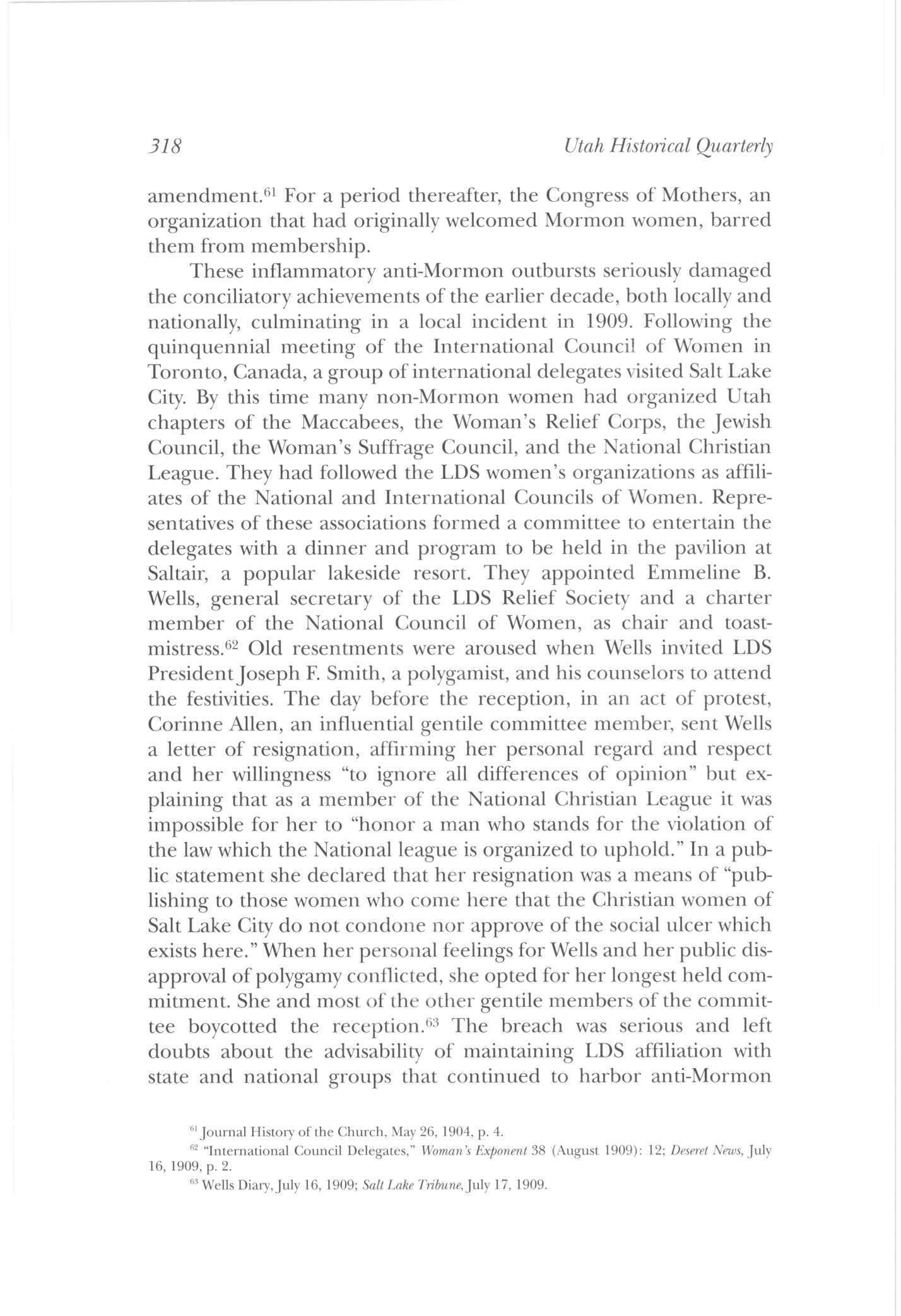
318 Utah Historical Quarterly
sentiments. Joseph F. Smith entered the debate in 1913, cautioning LDS women against subordinating the autonomy and objectives of their organizations to those of their national affiliations but leaving the question of continued membership to the auxiliaries.64 Though they chose to retain their association with the National and International Councils of Women, there was sufficient distancing to bring NCW president May Wright Sewall to Salt Lake City to ease the strained relations. While she was successful in strengthening ties between the National Council and its Mormon affiliates, it took a national emergency to bring local Utah women into the same measure of harmony they had experienced two decades earlier World War I was the catalyst that united their efforts in behalf of Utah once again.
Against the emotionality provoked by two decades of conflict over polygamy, the Woodruff Manifesto of 1890 had mitigated the differences between Mormon and gentile women. The social climate in Utah had become conducive for the formation of a cohesive corps of female civic workers. Through their volunteer organizations Utah women cooperated in making a social impact in Utah and had finally connected with public-spirited women throughout the country as "Utah women."
But the rhetoric of female community that had been so enthusiastically dispensed throughout the decade and the public action it had fed hid the realities of entrenched differences. It took decades for the specter of polygamy to be laid to rest, even after a second Manifesto in 1904. Polygamy had proven to be as divisive among women in Utah as race or class among women elsewhere. Female community, it seems, was always subject to the claims of a more compelling female loyalty than gender.
While the harmonious relationships during this period were delicately balanced on volatile issues, the decade gave women precedents on which to base future cooperative action. They had proven how effective coalitions of disparate groups can be when propelled by shared objectives, and they had generated the cohesiveness that female networks can create in a community Though the period is most remembered for the political, legal, and social changes that transformed Utah, less noted but equally notable were the women who defined and negotiated their own social politics during this dynamic decade in Utah's history.
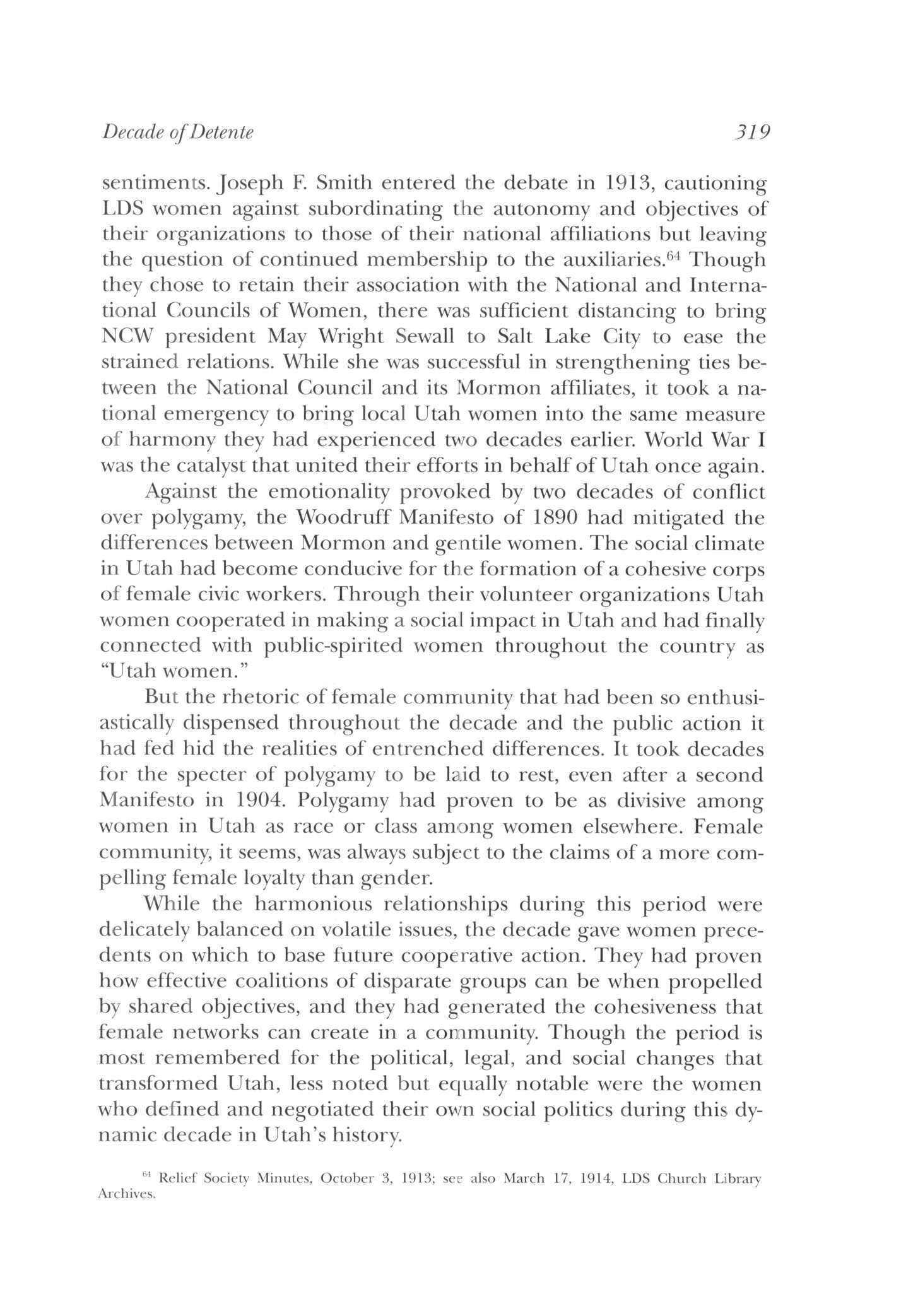
Decade ofDetente 319
64 Relief Society Minutes, October 3, 1913; see also March 17, 1914, LDS Church Library Archives
So Bright the Dream: Economic Prosperity and the Utah Constitutional Convention
 BY JEAN BICKMORE WHITE
BY JEAN BICKMORE WHITE
industry
Utah
part of the statehood "dream"for many.
Main Street
Second South in
Salt Lake City
limited
time of statehood. USHS collections.
Attracting business and
to
was
The intersection of
and
downtown
shows
development near the
Dr White is emeritus professor of political science, Weber State University
WHE N UTAH'S CONSTITUTIONAL CONVENTION MET ON MARCH 4, 1895, to write the document that would usher in Utah statehood, the delegates were not entirely happy to be meeting in the Salt Lake City and County Building Although the imposing structure was practically brand new, delegates voiced a litany of complaints about it. The location was too far from the downtown business district. The meeting place, a courtroom on an upper floor, was hard for the older delegates to reach, since there was no elevator. After meeting for a few days in the room they had many more complaints—about the lack of desks, the poor ventilation, the limited space for visitors.
To add insult to perceived injuries, the windows over the doorways read "Criminal Court Room." This led to no end ofjokes about the character of the delegates. The committee on arrangements reported that they could find no other suitable meeting place, and the price certainly was right: Salt Lake County offered the room free of charge. Since Congress had appropriated only $30,000 to spend on all the expenses of the convention, the delegates decided to make the best of it
Within a few days the room was festively decorated by Salt Lake County. The Deseret Evening News reported on March 14 that the alcove above the president's chair had been "artistically arrayed in the national colors, and reaching out from it in all directions were more flags than any delegate cared to count." Immense streamers of bunting ran from the chandeliers in the center of the room to the corners. Large steel engravings of George Washington, Thomas Jefferson, Abraham Lincoln, and the current president—Grover Cleveland—adorned the walls.
The 107 men elected to write a constitution for Utah faced the job with both hopes and fears. Although they were diverse in background, interests, political philosophy, and financial means, they were united in these hopes and fears Even though they had an Enabling Act passed by Congress the year before to guide them, they still had a lingering fear that somehow the new constitution could be rejected, either by Utah voters at an election in the fall, or by President Grover Cleveland.1 Neither fear was welljustified, for there had
1 An Enabling Act is not necessary for statehood and does not guarantee it It does list conditions that should be met by a territory, and in Utah s case—after the rejection of previous constitutions—it set forth requirements to be met in its 1895 document Utah's act is in Ch 1328, Statutes at Large, 107. It is also printed in the Proceedings and Debates of the Convention, 2 vols. (Salt Lake City: Star Printing Co., 1898), 1:3-8 (hereinafter Proceedings).

Utah Constitutional Convention 321
been sweeping changes in the territory during the previous five years. The 1890 Manifesto of the Mormon church urging its members to obey the anti-polygamy laws had paved the way for dramatic political and economic changes in Utah and had helped to foster a new and improved national image for the territory. It had also made possible a new atmosphere in which Mormons and many prominent nonMormons could work together to break down religious, political, and economic barriers that had long divided them.2 By 1895 both Mormon and gentile leaders had concluded that continuing as a territory was untenable Future population growth and development of the area's vast natural resources were unlikely without statehood

Achieving statehood was the primary goal of the convention
The fear that they might somehow lose this prize, now that it was almost within their grasp, motivated delegates to be cautious and conservative. They shunned experimentation and generously copied older constitutions, reasoning that these documents had survived presidential scrutiny and had "safe" provisions.3 To guard against rejection by the voters at an election in the fall, they tried to keep taxes and debt low. This was considered wise by local newspaper editors who claimed to feel the public pulse.
The Salt Lake Tribune, in a March 7 editorial, bluntly told the delegates that "The people cannot stand much added burdens in any form, and the more that are provided in the Constitution the greater the danger of its rejection." In a list of "do's" and "don'ts," the Tribune urged (among many other things): Do let taxation be as little felt as possible.
Don't provide for extravagance.
Don't attempt to reform the world.
Don't put in fads and frivolous provisions.
In short, provide the framework necessary for a State government, and when you have done that, squelch all else and quit.
The Salt Uake Herald noted in a March 21 editorial some fears
2 Members of the Church of Jesus Christ of Latter-day Saints are called Mormons or Saints Utahns who are not members, including Jews, are commonly known as gentiles The economic, political, and social polarization of the territory on religious lines and the gradual accommodations achieved by the two groups are discussed in Jean Bickmore White, "Prelude to Statehood: Coming Together in the 1890s," Utah Historical Quarterly 61 (1994): 300-315
3 The constitution written in 1895 cannot trace its ancestry to a single document Delegates were given copies of all forty-four state constitutions, and they frequently referred to them. They paid close attention to constitutions of the six western states that had been admitted in 1889 and 1890: Washington, Montana, North and South Dakota, Idaho, and Wyoming, but also to New York state's new constitution, which had been rewritten in 1894 The Washington State Constitution of 1889 was frequently quoted and copied
322 Utah Historical Quarterly
that statehood would not be approved because of the shift of many expenses from the federal to the new state government. Delegates should not put anything in the document that would feed these fears, they cautioned.
This fear of rejection was not the only emotion that drove convention action. From the start there was an exuberant feeling that the future of Utah as a state would be far different from its turbulent territorial history—if only it could attract business and industrial development to augment its agricultural economy. Delegates dreamed that statehood—which now seemed so close—would bring an influx of new capital to spur mineral and other industrial growth and open a bright new era of economic prosperity. The need for outside capital was clear One writer on the West has pointed out that development of the economy of the region matured only as it absorbed "massive inputs of Eastern capital and technology."4 Frank J. Cannon, Utah's delegate to Congress, expressed a common sentiment when asked whether he thought statehood would benefit Utah to any great extent:
I believe that when Utah becomes a full-fledged state a great impetus will be given to our industries. I think, however, that it will be a healthy, normal advance, and result in great industrial good to our state. We have, to begin with, a population of 300,000, and we are able to take care of over a million people I should say that a million or more people can easily support themselves in Utah.5
The future also looked bright to the Salt Lake Tribune. On March 8, as the convention was getting down to business, crowds of spectators gathered at the southeast corner of Temple Square to see a gas torch lighted, completing the transmission of natural gas into the city. The event prompted an exuberant editorial the next day in the Tribune.
With this new fuel available, Salt Lake City should take a bound forward in home industries Manufacturers are no longer in the grasp of the coal monopoly; the smoke nuisance will be abated; there will be opportunity for development on the grandest scale.
4 Gene M Gressley West by East: The American West in the Gilded Age, Charles Redd Monographs in Western History, No 1 (Provo, Ut.: Brigham Young University Press, 1972), p 2
:' Salt Lake Herald, April 16, 1895 Like many others, Cannon tended to let enthusiasm run ahead of the facts Utah's population was recorded at just 210,779 in the 1890 census and did not reach 300,000 until after the turn of the century The 1970 U.S Census was the first to record more than a million residents. Allan Kent Powell, ed., Utah History Encyclopedia (Salt Lake City: University of Utah Press, 1994), p 431

Constitutional Convention 323
Utah
. . . Salt Lake can be a second Pittsburgh, minus the smoke and grime. No other city in the land possesses the prospects for great growth that are open to Salt Lake City
Given the depressed state of Utah's economy in 1895, it took a giant leap of imagination to see Salt Lake City as a pristine-air Pittsburgh. Utah's economy was still primarily agricultural. It was augmented by a struggling mineral industry, but the need for outside capital limited the full exploitation of the area's metal mines. The territory was sadly short of the manufacturing firms that could absorb her increasing workforce and bring in much-needed dollars from outside her borders.
The Panic of 1893 and the recession of the 1890s were as keenly felt in Utah as in the rest of the nation.6 Local agriculture in Utah was in the process of transition from small farms—the backbone of Brigham Young's plan for a self-sufficient Mormon economy—into commercial farming.7 Mining, which would transform some proudly independent prospectors into a cadre of millionaires, needed outside capital in the 1890s. Surface ores had been exhausted and, as Dean L. May observed, "Further development depended upon deeper, lower-grade ores, which could be mined only with considerably greater investment."8 Manufacturing of finished products for export outside the territory was slow to develop; most manufacturing in Utah involved the conversion of local farm and mineral products for use by Utahns or intermediate processing of these products for export.9 A combination of circumstances was changing the economic climate in Utah. The two separate economies analyzed by LeonardJ. Arrington—Mormon and gentile—that had existed throughout most of the history of the territory were moving closer together.10
h The impact of the 1890s depression on agriculture and the effect of the gold standard on silver are discussed in Harold Underwood Faulkner, American Economic History, 8th ed.(New York: Harper & Row, 1960), pp 519-23 For the effect of the depression in Utah see LeonardJ Arrington, "Utah and the Depression of the 1890s," Utah Historical Quarterly 29 (1961): 3-18.

' Charles S Peterson points out that during the 1890s "Farming became a business rather than a way of building the Kingdom Technology became increasingly important and manpower less so." See "The Americanization of Utah's Agriculture," Utah Historical Quarterly 41 (1974): 122-23 There were increasing indications, Peterson concludes, that "an almost desperate quest for commercial success characterized the lives of progressive farmers."
8 "Towards a Dependent Commonwealth," in Richard D Poll, ed., Utah's History (Provo, Ut.: Brigham Young University Press, 1978), p. 223.
9 Ibid., p 235
10 Arrington described the divided economy as a "two-decker economy" until the turn of the century, one based on farming and manufactures for home use, the other on mining and trading From Wilderness to Empire, University of Utah Institute of American Studies, Monograph No 1, 1961, p 14
324 Utah Historical Quarterly
The desire of Utahns to parlay their natural resources into prosperity created a need for expanding export industries The territory was becoming interdependent with the national economy and needed financial assistance for further development. Some industrial development was stimulated by the Mormon church, notably in the sugar industry, hydroelectric power systems, and salt production from Great Salt Lake.11 The church, however, had financial problems of its own; eventually its leaders found it unadvisable to use church credit to shore up the Utah economy. 12
Considering the high unemployment and fragile economy of the territory in the early 1890s, it is not surprising that concern with economic matters should occupy so much attention during the Constitutional Convention of 1895. It is surprising that there was so much optimism about the economic prosperity delegates thought would arrive after the attainment of statehood Running through the debates was a feeling that if the right climate could be fostered under the constitution, both home industries and new, scarcely dreamed-of enterprises funded by outside capital, would thrive in the new state.
The delegates represented a broad spectrum of the territory's population, and it seemed that all of them dreamed of prosperity for Utah Since 1894 had been a strong Republican year, the fifty-nine delegates from that party outnumbered the forty-eight Democrats, but generally issues were not decided along party lines. Delegates ranged in age from a twenty-five-year-old teacher to a seventy-sixyear-old builder; those in their forties made up the largest age group Voters in 1894 had elected men who were prominent in their communities and veterans of government service as mayors, city council members, county selectmen, county attorneys, probate judges,justices of the peace, and other local offices. Several delegates had served in previous constitutional conventions and others in the territorial legislature Farmers and stock-raisers made up the largest occupational group, followed by merchants and manufacturers, then
11 See Arrington, "Utah and the Depression of the 1890s," pp 12-18, for a discussion of measures taken by Mormon leaders to solve employment problems and promote industry in the face of the 1890s depression
12 See Ronald W Walker, "The Panic of 1893" in Powell, Utah History Encyclopedia, p. 413 Although church-financed enterprises, including the building of Saltair resort, helped to provide jobs, they were contrary to the desires of many gentiles to minimize the role of the Mormon church in Utah's economy and foster an open field for private enterprise See Arrington, "Utah and the Depression of the 1890s," p 18
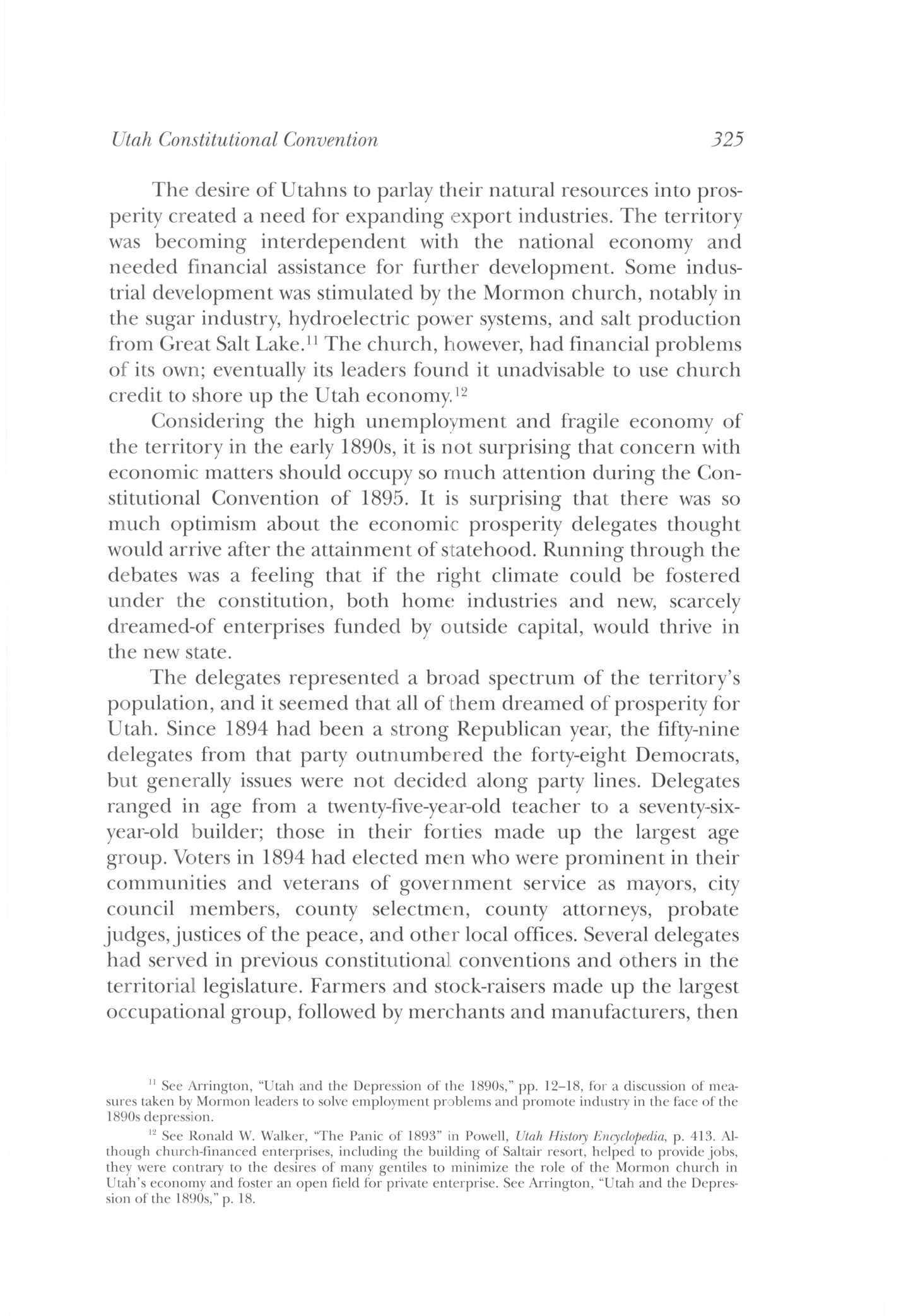
Utah Constitutional Convention 325
lawyers and men with mining interests Three newspapermen, three bankers, three builders, and a handful of other occupations rounded out the delegate roster.13
In religious representation the 1895 convention marked a departure from the constitutional gatherings of the past, which were instigated and dominated by Mormons.14 Voters elected twenty-nine non-Mormons, including several who were prominent in mining and others who were leading lawyers. Mining men included Thomas Kearns, who later became a United States senator He did not dominate debate but promoted several progressive labor measures and was an effective voice for mining interests. The most prominent lawyer and a recognized expert in constitutional and statutory law was Charles S. Varian, a former U.S. district attorney. He had built his career prosecuting polygamists during territorial days but was considered fair and even-handed.15 Another non-Mormon greatly respected for his knowledge of law was Dennis C Eichnor, a prolific writer of bills on a variety of subjects Other gentiles in the
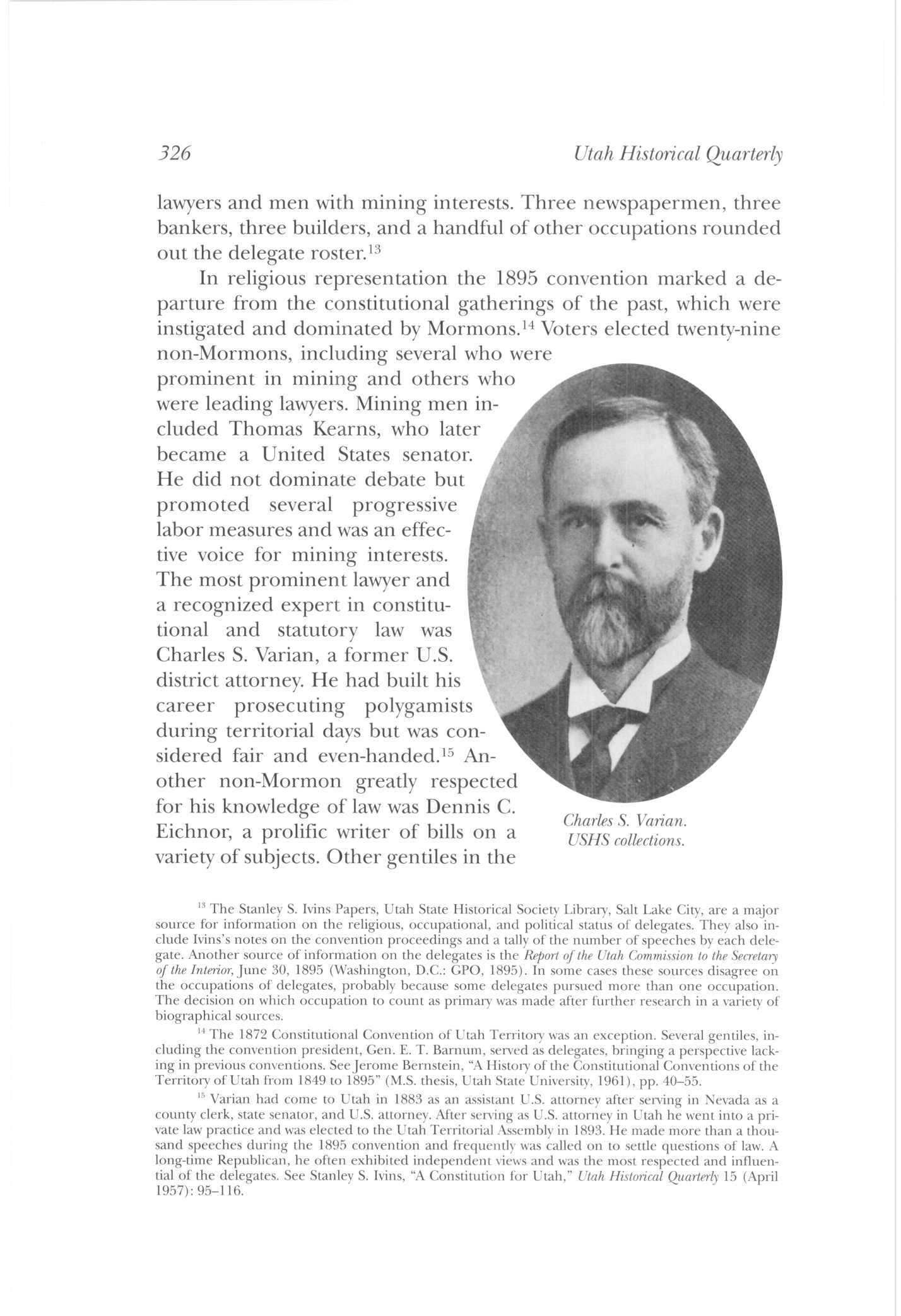 Charles S. Varian. USHS collections.
Charles S. Varian. USHS collections.
13 The Stanley S Ivins Papers, Utah State Historical Society Library, Salt Lake City, are a major source for information on the religious, occupational, and political status of delegates They also include Ivins's notes on the convention proceedings and a tally of the number of speeches by each delegate Another source of information on the delegates is the Report of the Utah Commission to the Secretary of the Interior, June 30, 1895 (Washington, D.C: GPO, 1895) In some cases these sources disagree on the occupations of delegates, probably because some delegates pursued more than one occupation The decision on which occupation to count as primary was made after further research in a variety of biographical sources
14 The 1872 Constitutional Convention of Utah Territory was an exception Several gentiles, including the convention president, Gen. E. T. Barnum, served as delegates, bringing a perspective lacking in previous conventions See Jerome Bernstein, "A History of the Constitutional Conventions of the Territory of Utah from 1849 to 1895" (M.S. thesis, Utah State University, 1961), pp. 40-55.
15 Varian had come to Utah in 1883 as an assistant U.S attorney after serving in Nevada as a county clerk, state senator, and U.S attorney After serving as U.S attorney in Utah he went into a private law practice and was elected to the Utah Territorial Assembly in 1893 He made more than a thousand speeches during the 1895 convention and frequently was called on to settle questions of law A long-time Republican, he often exhibited independent views and was the most respected and influential of the delegates See Stanley S Ivins, "A Constitution for Utah," Utah Historical Quarterly 15 (April 1957): 95-116
326 Utah Historical Quarterly
convention included a contractor, a banker, a brewer, two newspapermen, prominent Ogden businessmen Frederick J. Kiesel and Charles N. Strevell, and a Methodist Episcopal minister from Sevier County, the Rev George P Miller.16 Stanley S Ivins, who carefully counted the number of speeches by each delegate at the convention, observed that as a group the gentiles were "much more active than the Mormons. With only twenty-eight delegates, they contributed 46 percent of the speaking, versus 54 percent for the seventy-nine Mormon delegates."17 Perhaps that is because they had two-thirds of the lawyers
The Mormon church was represented by several of its highest ranking members, including apostles John Henry Smith (who was unanimously elected president of the convention) and Moses Thatcher, Presiding Bishop William B. Preston, and Brigham H. Roberts, one of the presidents of the Seventy. A host of lower-ranking church leaders guaranteed a voice for church interests.18 Other Mormons at the convention who were active in business and the law were Samuel R Thurman, an articulate lawyer and future state supreme court justice; Franklin S. Richards, a longtime attorney for his church; George M. Cannon, a Republican party leader; and Heber M. Wells, a banker who would soon become Utah's first governor.
Most delegates were active in politics. In the 1870s and 1880s Mormons had served in their church-run People's party and gentiles in their Liberal party After these parties were disbanded in the early 1890s, national political parties began to flourish. Many former Liberals joined the Republican party and Mormon church leaders encouraged Mormons to do likewise, to avoid repeating the pattern of political division along religious lines.19
16 The newspapermen were Charles C Goodwin, editor of the Salt Lake Tribune, whose sardonic wit enlivened the proceedings, and Noble Warrum, who later wrote a history of Utah Both were trained as lawyers but switched to journalism The brewer was Jacob Moritz, who had come to Utah in 1871 and by 1883 had established the largest brewery in the Intermountain West, according to Juanita Brooks, The History of theJews in Utah and Idaho (Salt Lake City: Western Epics, 1973)
17 "A Constitution for Utah," p. 114. Ivins noted that eleven delegates did 53 percent of the speechmaking—Charles S Varian (with 1,129 speeches), David Evans, Samuel R Thurman, George B Squires, George M Cannon, Franklin S Richards, Dennis C Eichnor, Brigham H Roberts, Charles H Hart, C C Goodwin, and William F.James Ibid., p 113
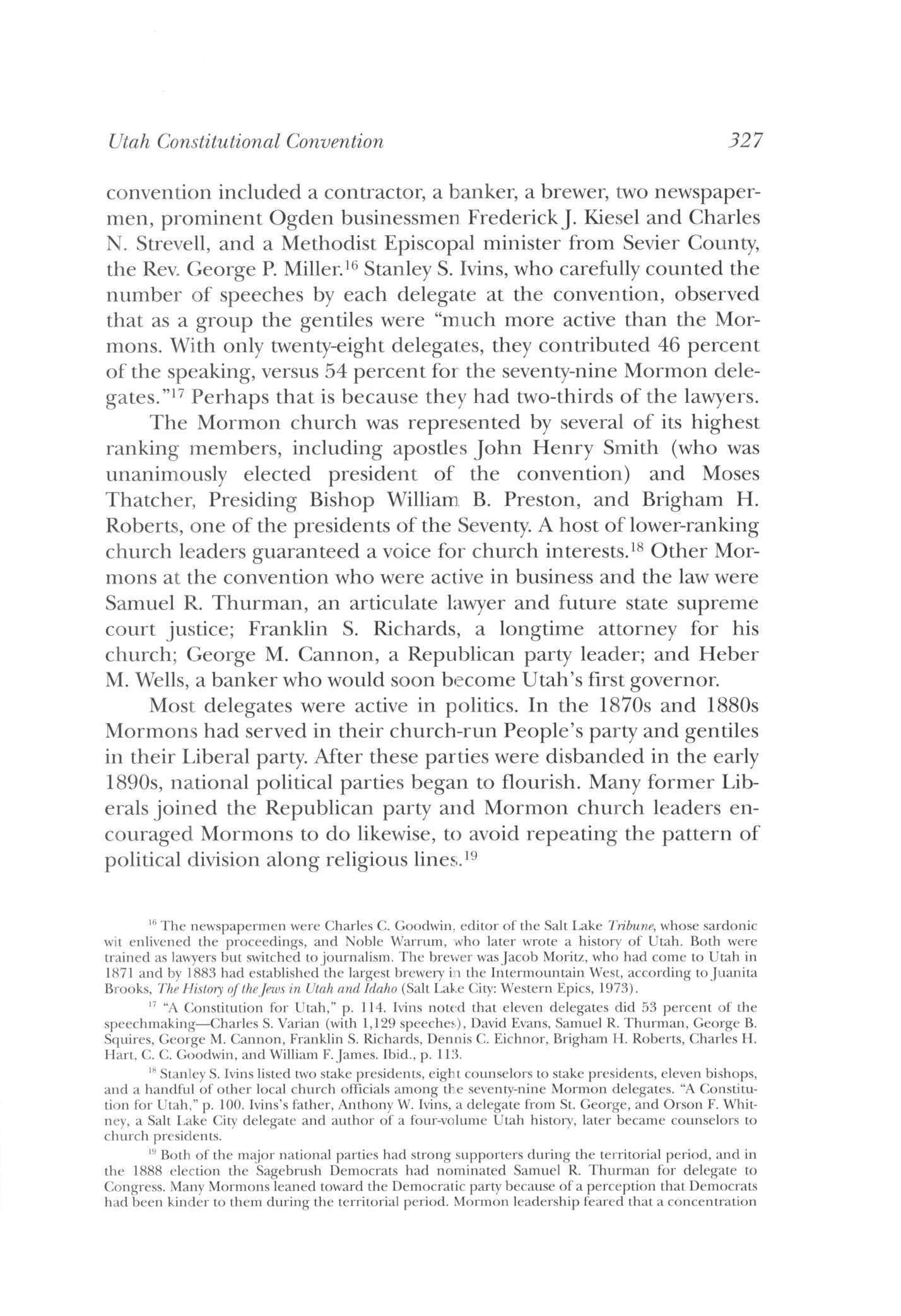
18 Stanley S. Ivins listed two stake presidents, eigh t counselors to stake presidents, eleven bishops, and a handful of other local church officials among the seventy-nine Mormon delegates "A Constitution for Utah," p 100 Ivins's father, Anthony W Ivins, a delegate from St George, and Orson F Whitney, a Salt Lake City delegate and author of a four-volume Utah history, later became counselors to church presidents.
19 Both of the major national parties had strong supporters during the territorial period, and in the 1888 election the Sagebrush Democrats had nominated Samuel R Thurman for delegate to Congress Many Mormons leaned toward the Democratic party because of a perception that Democrats had been kinder to them during the territorial period Mormon leadership feared that a concentration
327
Utah Constitutional Convention
Most of the main issues at the convention did not divide the delegates along religious lines In fact, there was an effort not to revive the old Mormon-gentile animosities.20 The most divisive issue of territorial days, polygamy, was taken off the agenda before the convention began; the Enabling Act passed by Congress mandated a provision banning polygamy "forever." It also required guarantee of "perfect toleration of religious sentiment" and establishment of public schools "free from sectarian control."21 Several other provisions in the Declaration of Rights and education articles addressed concerns of the non-Mormon minority relating to freedom of religion and separation of church and state.
Fortunately, the delegates were united in their dream of a brighter economic future. The hope for a massive infusion of outside capital after statehood drove much of the debate. Delegates hoped to create a hospitable economic atmosphere that would nurture existing industry and be a magnet for new 7 enterprises. To this end they tried to ensure a frugal government, with a low tax structure, strict limits on public debt, and a framework for peaceful businesslabor relations
Although their goals were clear, delegates often disagreed about the means for reaching them The first contest over promoting much-needed industry came during consideration of the legislative article (Art 6), and it turned out to be one of the few that brought out partisan feelings The issue was state financial aid to business; Republicans stood for subsidies or "bounties" to help businesses, and Democrats opposed them. The Democratic minority members of the Committee on Legislative raised the issue with a report recommending that any grant or appropriation of public property or money by the state or any political subdivision, or any lending of credit to any
of church members in the Democratic party would be detrimental to their efforts to woo Republican leaders to the statehood cause and might re-create a party system based on religion This concern is shown by Apostle Abraham H. Cannon in his journal entry for July 9, 1891: "The danger of our people all becoming Democrats is feared It is felt that efforts should be made to instruct our people in Republicanism, and thus win them to that party. . . . " Abraham H. Cannon Journals, Special Collections, University of Utah Marriott Library
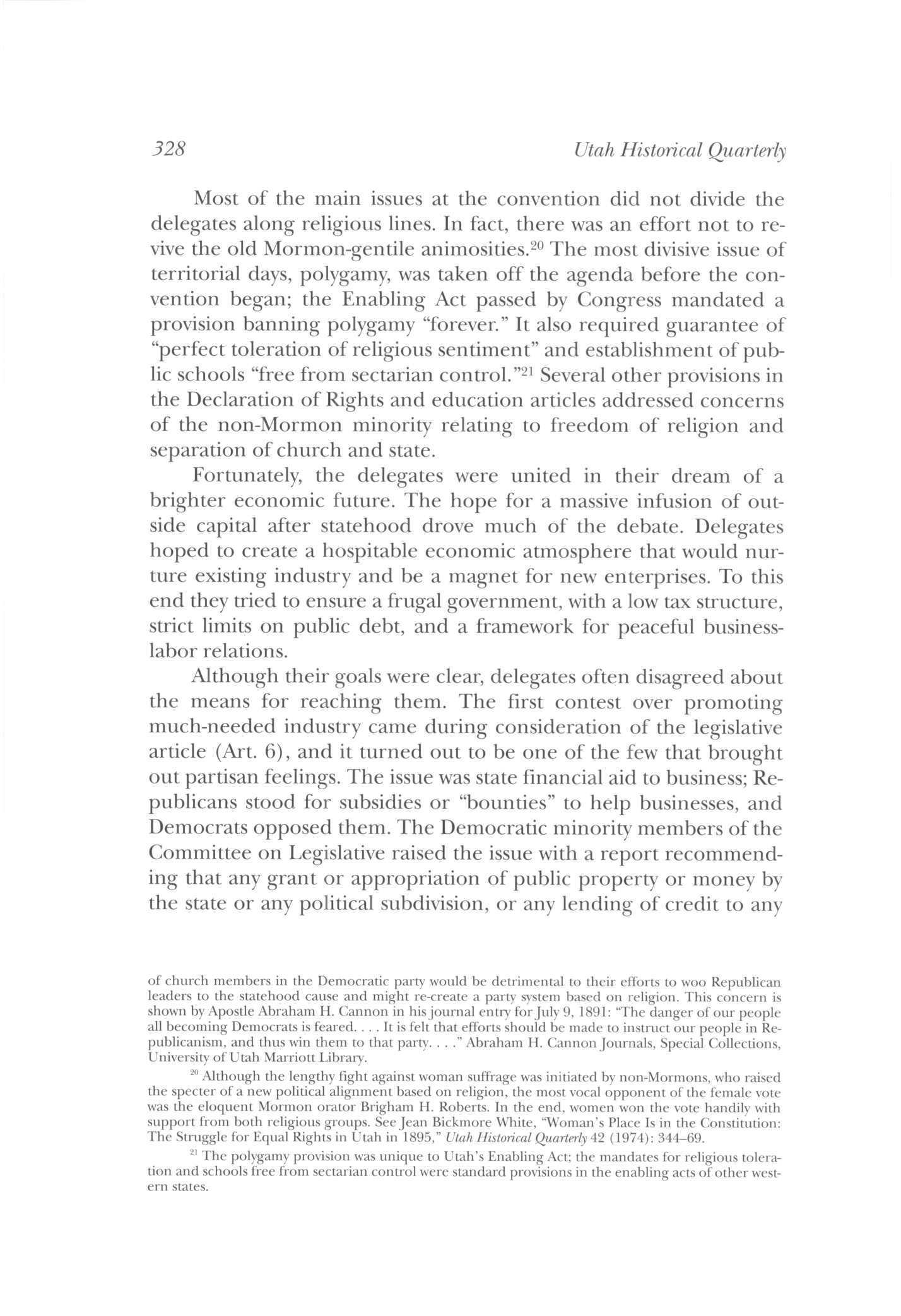
20 Although the lengthy fight against woman suffrage was initiated by non-Mormons, who raised the specter of a new political alignment based on religion, the most vocal opponent of the female vote was the eloquent Mormon orator Brigham H Roberts In the end, women won the vote handily with support from both religious groups. See Jean Bickmore White, "Woman's Place Is in the Constitution: The Struggle for Equal Rights in Utah in 1895," Utah Historical Quarterly 42 (1974): 344-69
21 The polygamy provision was unique to Utah's Enabling Act; the mandates for religious toleration and schools free from sectarian control were standard provisions in the enabling acts of other western states
328 Utah Historical Quarterly
individual, association, or corporation be prohibited.22 No one questioned the need to encourage business and industry, but should the new state use tax money to do so? Attorney Franklin S. Richards, leading the floor fight for the Democratic proposal, thought the answer was clear:
We think that this is one of the restrictions that ought to be imposed, that the State ought not to be authorized to engage in any business enterprises, construction and operation of railroads, or the building of manufactories of any kind or the: giving of support by public money to any such enterprises, or for any purpose except strictly governmental purposes. . . , 23
During the rapid growth of industry and transportation networks, state legislatures sometimes had incurred crippling debts by subsidizing railroads and other enterprises. Horror stories of states plunged into a morass of insolvency were recited by Democratic delegates, while Republicans countered that sometimes only modest assistance by the state could keep an enterprise alive and provide much-needed employment. George M. Cannon made the Republicans' case for leaving to the new state the power to use "bounties" for business:

I do not think that it would be right to pledge the credit of the state for anything unless the enterprise for whicli that credit is pledged will be a benefit to the people, but at the same time I think that under some circumstances it would be right to pledge the credit to an enterprise that would be a direct benefit to the people and would bring to them more benefits than the amount that would be involved.24
22
1:394.
23 Ibid., 1:889
24 Ibid., 1:994
Utah Constitutional Convention 329
Franklin S. Richards. USHS collections.
Proceedings,
The report was signed by Lorin Farr, Edward Partridge, Charles H Hart, Edward H. Snow, Brigham H. Roberts, Franklin S. Richards, and William J. Kerr.
One great benefit, Cannon maintained, would be employment. "What will you do with a man who has an education if he has not the means by which he may earn that upon which he may live?" Cannon asked.25 This was a potent argument at a time when unemployment in the territory was high, population was increasing, and local governments and the Mormon church were trying to alleviate the problem.26 The Democratic minority, however, raised another fear Brigham H. Roberts suggested that large trusts would clamor for subsidies to come into the state and exploit its resources but provide little benefit to the average citizen:
[T]hey will seek to lay their hands upon every resource of our commonwealth, and the great danger is that while for a few brief years there may be stimulation in our industries, in the end it will prove that the wealth has fallen to the hands of the few while the masses are bereft of opportunities to make themselves comfortable in the midst of rich resources until, sir, the few shall be enriched and the masses shall be the hewers of wood and drawers of water.27
If the Republican majority had held together on the issue of subsidies, they could have defeated the proposal. Their most respected member, however, had strong doubts about the wisdom of incurring debt to stimulate rapid growth. Charles S. Varian, in a long, thoughtful speech, recommended that "the people make haste slowly" and not have a too-rapid growth. "There are evils attendant upon this sort of financial mislegislation that cannot be calculated," he warned.28 In a vote to reconsider the previous defeat of the Democratic measure, Varian and a dozen other Republicans joined the Democrats in voting for a provision that ignored the direct subsidy issue but prohibited the state or its local governments from lending credit or subscribing to stock or bonds "in aid of any railroad, telegraph or other private individual or corporate enterprise or undertaking" (Art. 6, Sec. 31).29 Although it left open the matter of direct subsidies, this provision meant that the state and its subdivisions could not lend their credit to a private business, and they were

25 Ibid., 2:985.
26 Salt Lake City, for example, was hiring workers for a week, then hiring another set of workers for the next week in order to spread the work around. Salt Lake Tribune, March 17, 1895.
27 Proceedings, 1:900
28 Ibid., 2:1000 Varian estimated that Salt Lake City had a debt of about $3.5 million Salt Lake County also had a large debt and was trying to refinance about $400,000 in warrants Salt Lake Herald, March 18,1895
29 In essence, this provision still is part of the Utah State Constitution
330 Utah Historical Quarterly
unlikely for many years to have a revenue surplus that would permit bounties for business.30
Echoes of the debate on bounties and the fear of debt were to be heard later when the taxation and public debt articles were written. Delegates had good reasons to consider carefully every provision in the two articles. There was a lingering uneasiness about voter approval of the constitution. Speaking against proposals to leave tax rates to the legislature, Cache County delegate I. C. Thoresen warned: "The question of the rate of taxation is the important question connected with statehood. . . . That is a question that people ask, 'Is it not going to increase our rate of taxation?' And I say unless we have a provision in here guarding that point, there will be more doubt about the people assuming a Constitution, than any other point."31
Delegates were well aware that in a depression economy the possibility of open-ended taxation would be risky—if not disastrous. To be safe they set an 8 percent limit for the state, to be lowered as the value of property within the state ina eased. Only a vote of propertytax payers could increase taxes over this limit, which delegates felt would be reassuring to voters.32
There was intense discussion of what to tax in the new state
Early in the session a letter to the Deseret Evening News predicted that taxation of financial instruments might cause eastern capital to withdraw entirely from Utah.33 Although this raised some concerns, delegates had to face up to the issue of fairness; exemption of some kinds of property (such as stocks and bonds) would dump the tax burden on others. They decided to tax all property not exempted under United States law or the state constitution: "moneys, credits, bonds, stocks, franchises and all matters and things (real, personal
30 The Republican Salt Lake Tribune on April 16 lamented the defection of the Republicans on the bounty issue, while the Democratic Herald praised the action on the same day: "It is gratifying to know that a dozen Republicans could be found who would not cringe to the party lash, and who voted on their convictions, irrespective of caucus policy." After a slight change in wording this section was amended in 1973 to become Section 29 in Article 6
31 Proceedings, 2:1109
32 The rate of state property taxation would eventually decrease to a limit of four mills on the dollar, unless property-tax payers approved a higher tax. A vote of property-tax payers was also required for municipalities, counties, or school districts to create debt in excess of taxes for the current year, a requirement later declared unconstitutional by the U.S. Supreme Court in Cipriano v. City of Houma, 395 U.S 701 (1969) and Phoenix v. Kolodzieski, 39 S.S 204 (1970) The taxation section was later repealed; the local debt provision remains in the constitution but is unenforceable; all voters now may vote in bond elections
33 Deseret Evening News, March 15, 1895

Utah Constitutional Convention 331
and mixed) capable of private ownership"—except for taxation of stocks held by individuals when company stock has been taxed (Art. 13, Sec.2).34

Utah's mineral treasures promised untold wealth if they could be developed But how should they be taxed? As in other western states, the issue of taxing mines proved difficult. Gordon M. Bakken observed that in western constitutional conventions most delegates "believed that the industry was environmentally unique, needed encouragement, and required marketplace stability," but they were forced to consider the relative burden for that industry.35 Until the minerals were extracted and sold many mining properties, patented for about $5 an acre, were virtually worthless. A small but influential group of delegates representing the mining industry (including Thomas Kearns) argued for taxation limited to machinery and improvements on mining claims and on net proceeds when a mine began to produce—not on the amount paid for the land Kearns warned that taxation on claims "kills the industry in its infancy for the prospector." Eloquently he described the plight of the prospector seeking a small stake to buy bacon and beans, as well as the dire effects of taxing patented claims: "If you do [tax claims], gentlemen, you will strike down one of the grandest industries ever started in our new State, and I leave it to your generosity to relieve the poor prospector. Go into the cities and ask capital to go there and invest before the shaft is sunk, it will laugh at you."36 Banker George M. Cannon, who chaired the Committee on Taxation and Revenue, defended the committee's proposal, which was copied from Montana's 1889 constitution. He maintained that Montana was eager to develop mining but felt that the industry "should bear itsjust proportion of taxation and of the burdens of the State."37 The committee version was approved; mining claims patented by the U.S. government would be taxed as other real property, in addition to taxation of improvements and net proceeds (Art. 13, Sec.4).38
Agricultural interests fared better than mining advocates in the
34
(Art 13, Sec 2 (10))
33 Rocky Mountain Constitution Making (Westport, Conn.: Greenwood Press, 1987), 51
36 Proceedings, 2:1078
37 Ibid
38 Subsequent changes in this article allow the legislature more flexibility in determining valuation of mining property
332 Utah Historical Quarterly
The difficulty of taxing intangible property led to an amendment of the constitution to allow the legislature to exempt it, or to tax it at a rate not to exceed five mills on each dollar of valuation
convention. Ditches, canals, and flumes used for irrigating lands were exempted from taxation, an incentive to spur development of land for farming and stock-raising (Art. 13, Sec. 3; now Sec. 2 (5)). Although this might be attributed to the superior numbers of farmers and stockmen in the 1895 convention, this provision was also in the 1887 constitution sent to Congress during the struggle for statehood, and it reflected the dominant position of agriculture and the crucial role of water in the territory.
Delegates did not trust future legislators or local officials to resist the temptation to borrow. A few felt that the new state should be on a "pay-as-you go" basis for all expenses and capital improvements. The majority, however, could see the need for some bonding to meet future building and infrastructure needs; they just wanted to put some brakes on it The new state would start with about $750,000 in territorial debt and a property valuation of only $100,000,000.39 It is easy to see, then, why the convention was concerned about piling up more debt To prevent this, they limited indebtedness of state government to $200,000, an amount clearly inadequate to meet future needs.40 Local governments also had debt limits, based on a percentage of property assessments There was some flexibility for cities, with their growing populations and hopes for future development. They could double their basic debt (with a vote of local property-tax payers) to provide necessary capital improvements—water, artificial light, or sewers (Art. 14, Sec. 4).
Both in taxation and in public debt provisions, Utah's Constitutional Convention did what it could to force frugality on the new state from top to bottom The shift from territorial status to statehood meant a shift of expenses from the federal to the new state government, and delegates wanted to make the transition appear as painless as possible
Delegates faced some painful decisions themselves when they dealt with the education article (Art.10). Throughout the territory it was difficult to finance grammar (elementary) schools for a full school year; only larger cities had high schools; and the Agricultural College and University of Utah were modestly funded. There were

39 Estimates on the amount of state indebtedness varied, but the $750,000 figure was generally accepted. Proceedings, 2:1116-1118.
40 Art 14, Sec 1 This was amended in 1911 to a debt limit of 1.5 percent of the value of the taxable property of the state Exceptions were made for debts "to repel invasion, suppress insurrection, or defend the State in war" (Sec 2)
333
Utah Constitutional Convention
strong pressures to assure free schooling only on the grammar school level. There were also those who argued that a good school system was essential, not just to educate the state's young people but as an advertisement for capital to come to Utah. C. C. Goodwin argued that the people of a state arejudged by the character of their schools: "A man from the east with capital and with a family reads [the provision for free high schools] over and says, 'Yes, they are providing there for high schools and universities, that will be a good place to go to. . . .'" He said that postponing the provision for a better school system could be disastrous; it would advertise to the world that "maybe after a while, in two or three generations, they will be able to give their children a decent education, but they cannot do it now."41

Although other issues forced some difficult decisions, the corporations article presented the delegates with unique and complex problems. As the great monopolies and trusts developed in the 1870s and 1880s they inspired fears of economic domination throughout the nation. In the West, capital-hungry states faced a dilemma. They wanted to attract eastern corporations but did not want to see home industries devoured by them or victimized by monopolistic practices, such as price-fixing. In 1895 the Sherman Antitrust Act of 1890 was not being vigorously enforced, and western territories coming into the Union felt compelled to deal with the problem. Utah was no exception. Although regulation seemed necessary, some requirements for doing business in the state were likely either to drive away attractive industries or harm local businesses— or both. A requirement that firms engage in only one business, for example, would hurt ZCMI and other cooperative stores that were moving into manufacturing as well as retailing. Delegates often seemed divided between hopes and fears. Beaver County rancher John R Murdock spoke out against negative attitudes toward corporations: "I realize this fact, that perhaps this State has a great prejudice against corporations . . . but I am in favor of corporations for the benefit of the general whole, and I do not believe in fencing them out so strong and so persistently as to stop our own moving ahead in this business."42 Other delegates vigorously championed
41 Proceedings, 1:388 After a long discussion it was agreed that high schools could be free if local citizens were willing to pay the cost beyond their share of the state school fund. The Agricultural College and University of Utah were to continue as separate institutions, although there were vigorous efforts to save money by combining them
42 Proceedings, 2:1474
334 Utah Historical Quarterly
legislative power to curb corporate influence. Ogden lawyer David Evans quoted Abraham Lincoln's warning about corruption by the "money power" and asserted that powerful corporations had "taken from the people many important rights through legislative franchises unrestricted by constitutions."43
Out of a tedious, divisive, and hair-splitting debate, the convention approved a long, detailed article on corporations that contained the same restrictions found in surrounding states' constitutions (Art. 12).44 Much of the article contained detail that would have been left to legislatures if the subject had not aroused such strong emotions. Given public knowledge of corporations' abuses, and some delegates' play on those fears, the result could hardly have been different.45 Delegates knew they were writing legislation but they wanted their imprint on this important aspect of Utah's future development. A short labor article (Art. 16) declared that "The rights of labor shall have just protection through laws calculated to promote the
43 Ibid., 2:1466-67,
44 A review of the corporations articles in other western states' original constitutions written in 1889 and 1890 shows a consistent pattern; future legislatures were prohibited from granting special franchises, and corporations were to be regulated to avoid price-fixing, monopolies, trusts, or other combinations in restraint of trade
45 The corporations article had to be extensively revised over the years Only one original section remains; five others have been significantly revised and fourteen have been repealed
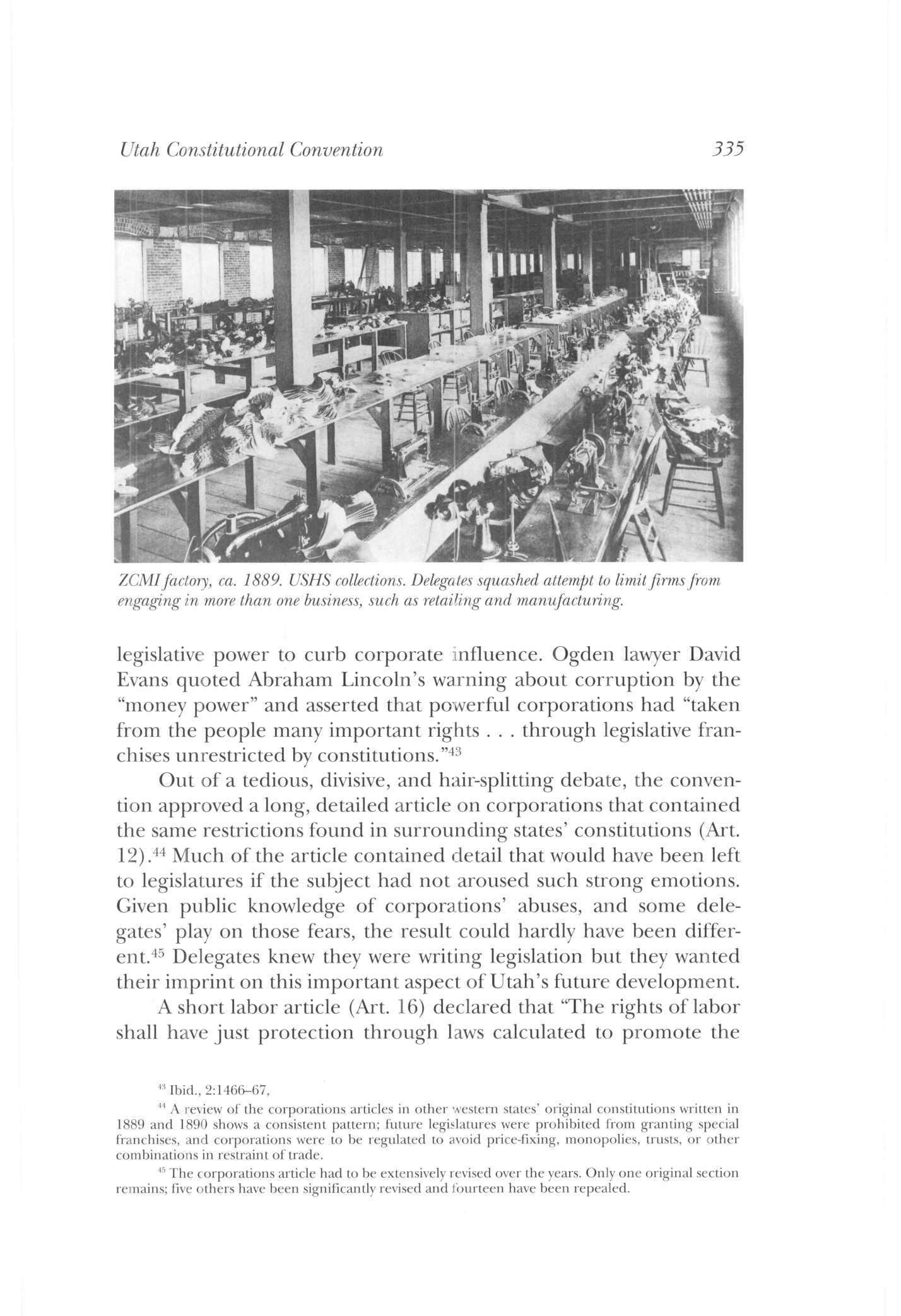
Utah Constitutional Convention 335
ZCMIfactory, ca. 1889. USHS collections. Delegates squashed attempt to limitfirmsfrom engaging in more than one business, such as retailing and manufacturing.
industrial welfare of the State." It established a Board of Labor, Conciliation and Arbitration to "fairly represent the interests of both capital and labor," limited employment in underground mines and use of convict labor, and set an eight-hour day for governmental workers It also tried to stop "blacklisting" of workers, although this provision was recognized as almost impossible to enforce. Each of these provisions met opposition, and some delegates felt the whole article was useless; but it was retained with support from those who thought it would prevent abuses of labor and avoid the labor strife (such as the 1894 Pullman strike in Illinois) that would discourage industrial development.46
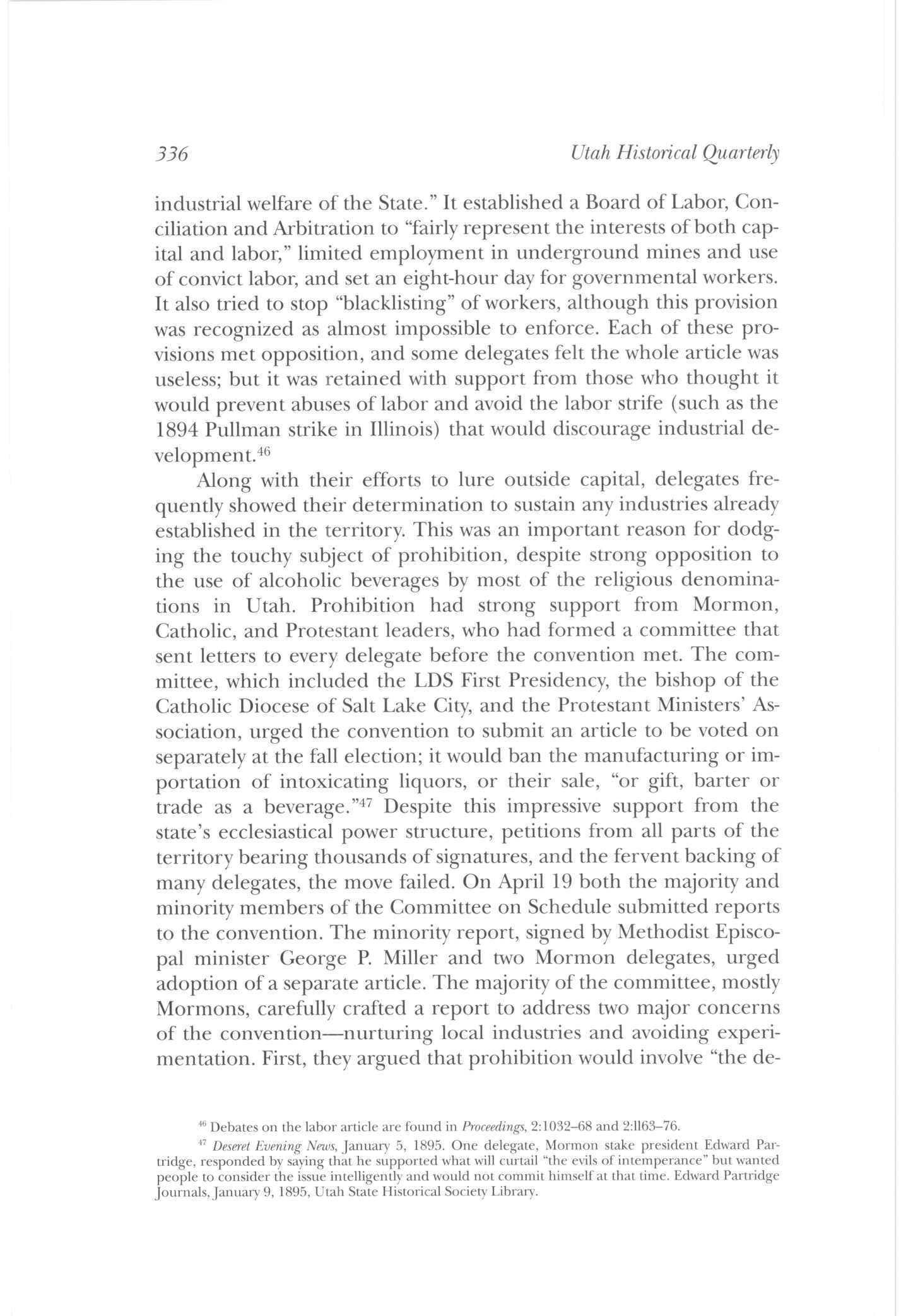
Along with their efforts to lure outside capital, delegates frequently showed their determination to sustain any industries already established in the territory. This was an important reason for dodging the touchy subject of prohibition, despite strong opposition to the use of alcoholic beverages by most of the religious denominations in Utah Prohibition had strong support from Mormon, Catholic, and Protestant leaders, who had formed a committee that sent letters to every delegate before the convention met The committee, which included the LDS First Presidency, the bishop of the Catholic Diocese of Salt Lake City, and the Protestant Ministers' Association, urged the convention to submit an article to be voted on separately at the fall election; it would ban the manufacturing or importation of intoxicating liquors, or their sale, "or gift, barter or trade as a beverage."47 Despite this impressive support from the state's ecclesiastical power structure, petitions from all parts of the territory bearing thousands of signatures, and the fervent backing of many delegates, the move failed. On April 19 both the majority and minority members of the Committee on Schedule submitted reports to the convention. The minority report, signed by Methodist Episcopal minister George P. Miller and two Mormon delegates, urged adoption of a separate article The majority of the committee, mostly Mormons, carefully crafted a report to address two major concerns of the convention—nurturing local industries and avoiding experimentation First, they argued that prohibition would involve "the de-
46 Debates on the labor article are found in Proceedings, 2:1032-68 and 2:1163-76
47 Deseret Evening News, January 5, 1895 One delegate, Mormon stake president Edward Partridge, responded by saying that he supported what will curtail "the evils of intemperance" but wanted people to consider the issue intelligently and would not commit himself at that time Edward Partridge Journals, January 9, 1895, Utah State Historical Society Library
336 Utah Historical Quarterly
struction of so much property, injury to established business enterprise, and the disturbance of vested rights in property" that it ought not to be dealt with hastily. Also, governmental prohibition was deemed "but an experiment" and should be dealt with by legislation.48 Debate on the reports was lengthy and impassioned. St. George delegate and future Mormon apostle Anthony W Ivins blamed virtually all the social problems of the territory on drinking Juab County delegate Louis L Coray argued that the whiskey business was inseparably connected with the underworld and the gambler: "They are triplets, from the same mother, and I think when a man fights one he is fighting the interest of the other, and any man or any set of men who will stand up here and defend the whisky business, I consider their just reward will be to live to see their children and their grandchildren gamblers, drunkards, illegitimate, and prostitutes."49 In less colorful rhetoric, many other speakers rose to denounce Demon Rum. But others feared the destruction of an apparently thriving industry. Salt Lake delegate Andrew Kimball and Apostle Moses Thatcher both strongly supported the case for not preventing the manufacture of liquor. Kimball pointed to the difficult employment situation: "It is an evident fact that there are hundreds and hundreds of people out of employment, and I believe there are thousands and thousands of dollars that are paid out;annually here to our employees and for the materials that are grown on the soil, for making this product let us not prohibit the manufacture of it."50 Apostle Moses Thatcher asserted that the liquor industry might "lift up our sugar factories out of their present condition of bondage and debt."51

There was more than one reason for the reluctance to put prohibition on the ballot, including the difficulty of enforcing it and the desire not to experiment in the constitution. But the prevailing sentiment against damaging any local industry brought pressure to leave this delicate matter to be dealt with by future legislatures.52 Had the delegates heeded the advice of critics and left more policy decisions to future legislatures, they could have written a basic document and adjourned long before they did But each felt keenly
48 Proceedings, 2:1182-83
49 Ibid., 2:1464
50 Ibid., 2:1457
51 Ibid., 2:1446
52
Utah Constitutional Convention 337
The issue was revived by Utah's first non-Mormon governor, Simon Bamberger, who spearheaded the successful drive for a state constitutional amendment on prohibition Passed by the legislature in 1917, it was ratified by the people in 1918 but repealed in 1933.
a responsibility to help chart a new start for the territory as the fortyfifth state, putting old animosities behind them and laying the groundwork for a prosperous economy. As the convention reached its final days, the delegates were tired. Some had sacrificed a great deal to spend two months in Salt Lake City and were eager to get back home. Attendance became a problem On Saturday, May 4, the sergeant-at-arms was instructed to notify the forty-four absent delegates to appear the following Monday for the final reading of the entire document On Monday, May 6, the constitution was adopted by a vote of seventy-two for, thirty-four absent, and one member excused. They adjourned at 1:05 P.M. SO the delegates could enjoy a final respite from the wearying debates—an afternoon at Saltair. On the following day, May 7, they finished up details and made plans for publication of the document and the convention proceedings. On the final day, Wednesday, May 8, the clerk brought out the elaborately inscribed document over which they had labored for so long. He began reading the text at 9:40 A.M. and finished at 11:55 A.M., after which a final vote was taken. It showed ninety-nine ayes and eight absent. The convention had consumed all but $1.10 out of the $30,000 allotment from Congress, but there were still unpaid expenses of more than $17,000.53
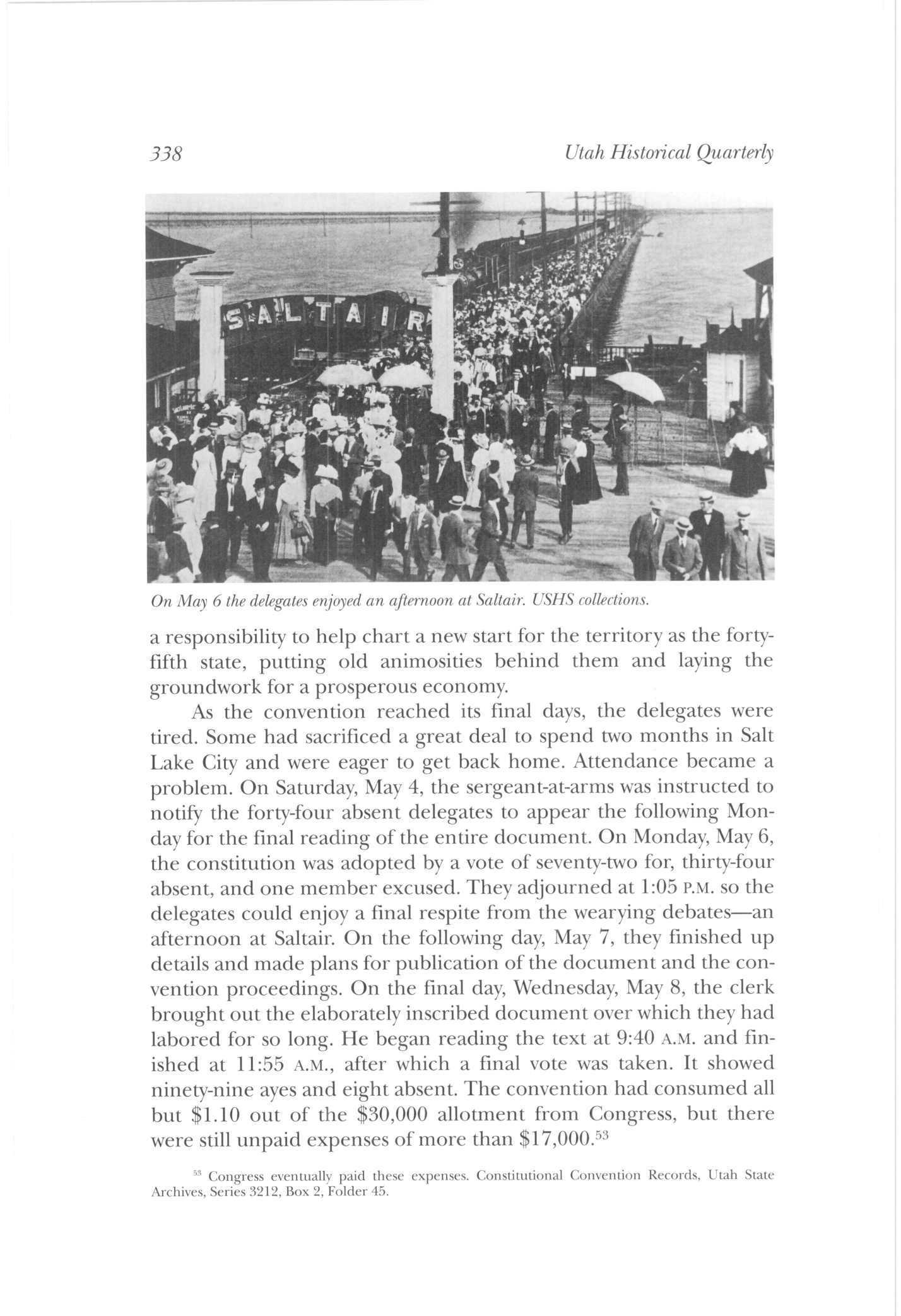
338 Utah Historical Quarterly
On May 6 the delegates enjoyed an afternoon at Saltair. USHS collections.
53 Congress eventually paid these expenses Constitutional Convention Records, Utah State Archives, Series 3212, Box 2, Folder 45
Each delegate received a small flag to commemorate the occasion. Each lined up with his own pen to sign the document—so he could keep the pen as a souvenir. The Tribune reported that the signing was slow, lasting from 12:10 to 1:40 P.M. It noted: "The magnitude of the honor of signing the great Charter of the State or a too anxious desire to make their signatures specimens of their very best penmanship, caused most of the delegates to write their very worst. The hands of nearly all the members trembled, and those of a few shook as if afflicted with palsy."54
Inevitably there were speeches on this last day—by Territorial Governor Caleb W. West, convention President John Henry Smith, and others. An address to accompany the constitution to the nation's capitol, written by a special six-member committee, summarized the convention's accomplishments. It noted that the new constitution was designed to assure economy in the new state government, keeping salaries of officials "close to the danger line of extravagant economy." The constitution limited future taxation and "guaranteed against the possibility of any future great indebtedness." It also "provided for the full development of our manifold industries, in such a way that in their expansion they will not feel any harsh friction from unjust laws."
"Ifwith statehood there will be a slight increase in taxes," the address continued, "the compensating advantages will cause the increased expense to be forgotten." It jDroudry predicted:
We will be able to utilize the magnificent gift of over seven million acres of land from our generous government; we will be able to secure capital for our mines; under the shield of statehood thousands of people will seek homes in our climate, assist to develop our wondrous and varied resources, and rejoice in the manifold blessings bestowed by nature upon our highly favored commonwealth.05
Although this sounded more like a euphoric hope than a cool appraisal of the new constitution, it captured accurately the visions of the future expressed frequently during the convention. Had the delegates chosen to follow the advice given by the Salt Lake Tribune on the eve of the convention, the document would have been much shorter and would have been amended much less frequently during the next one hundred years. They chose instead—perhaps unconsciously— May 9, 1895.
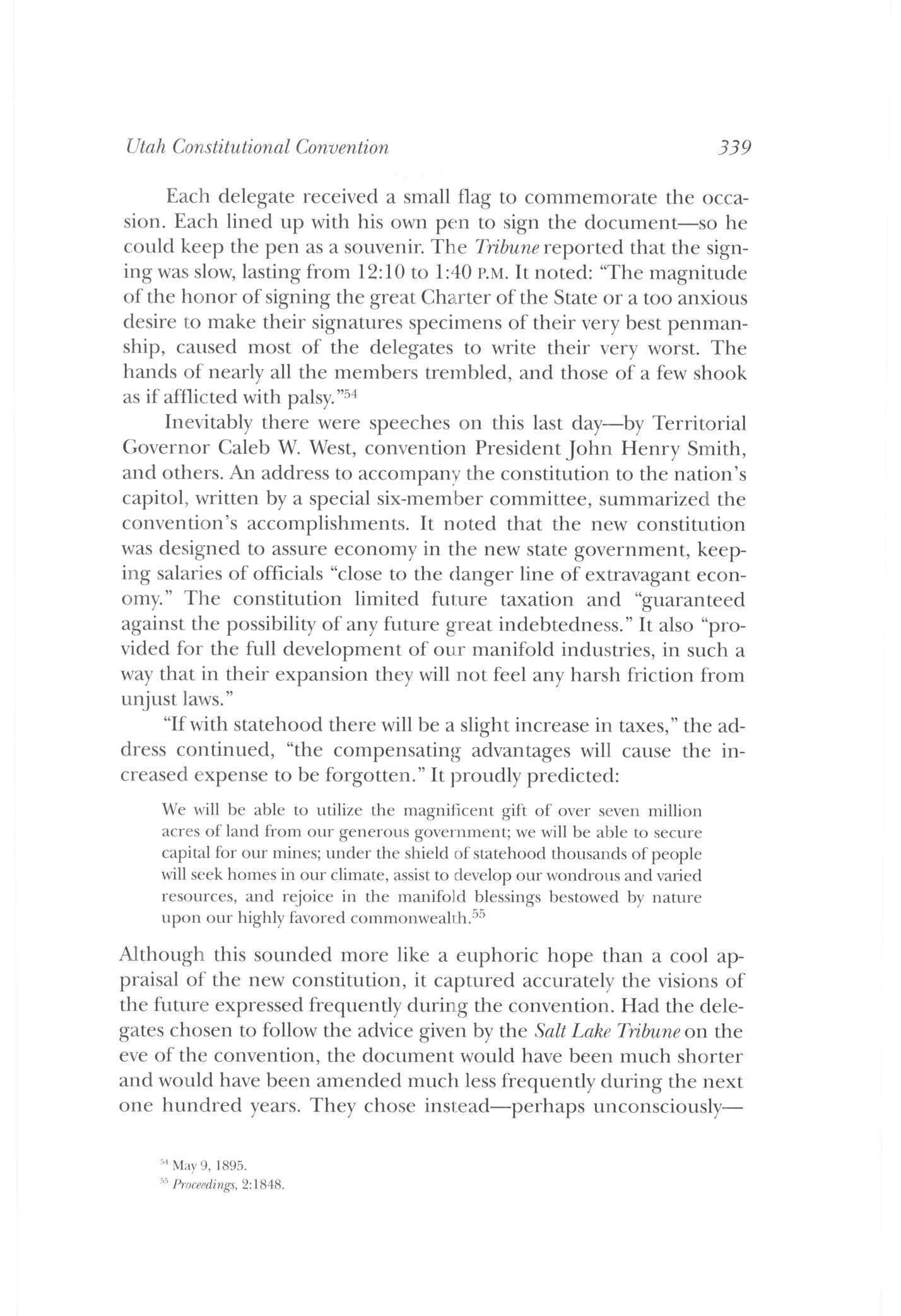
Utah Constitutional Convention 339
Proceedings,
2:1848
to see constitution writing as something more than designing the structure of government. They were living in hard times, and they wanted a blueprint for something much better in the future.
One scholar of state constitutions has suggested that—among other things—a constitution defines a way of life toward which a people is aiming.56 Utah's constitution writers in 1895 were aiming to preserve the essential values of their culture while pursuing a bright dream of future economic prosperity. The dream did not immediately come true. It took decades to build anything even faintly resembling the industrial economy envisioned during the convention Salt Lake City did not become a smokeless Pittsburgh, and Utah struggled for much of its first hundred years—with essential help from the federal government—to build an economy strong enough to support its population.
Yet the dream survived through those one hundred years—and it still lives.
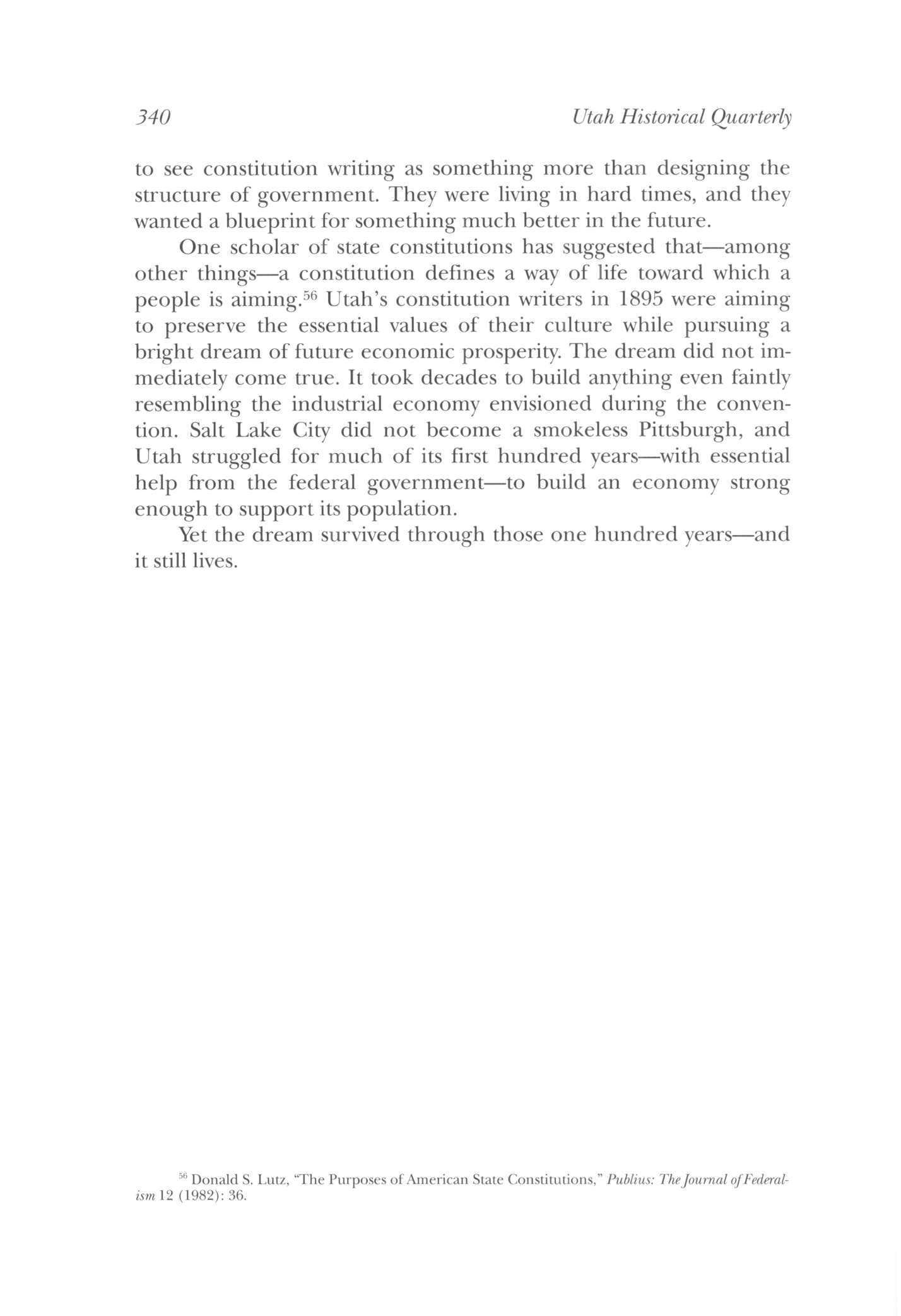
340 Utah Historical Quarterly
* Donald S Lutz, "The Purposes of American State Constitutions," Publius: TheJournal ofFederalism 12 (1982): 36
Statehood, Political Allegiance, and Utah's First U.S. Senate Seats: Prizes for the National Parties and Local Factions
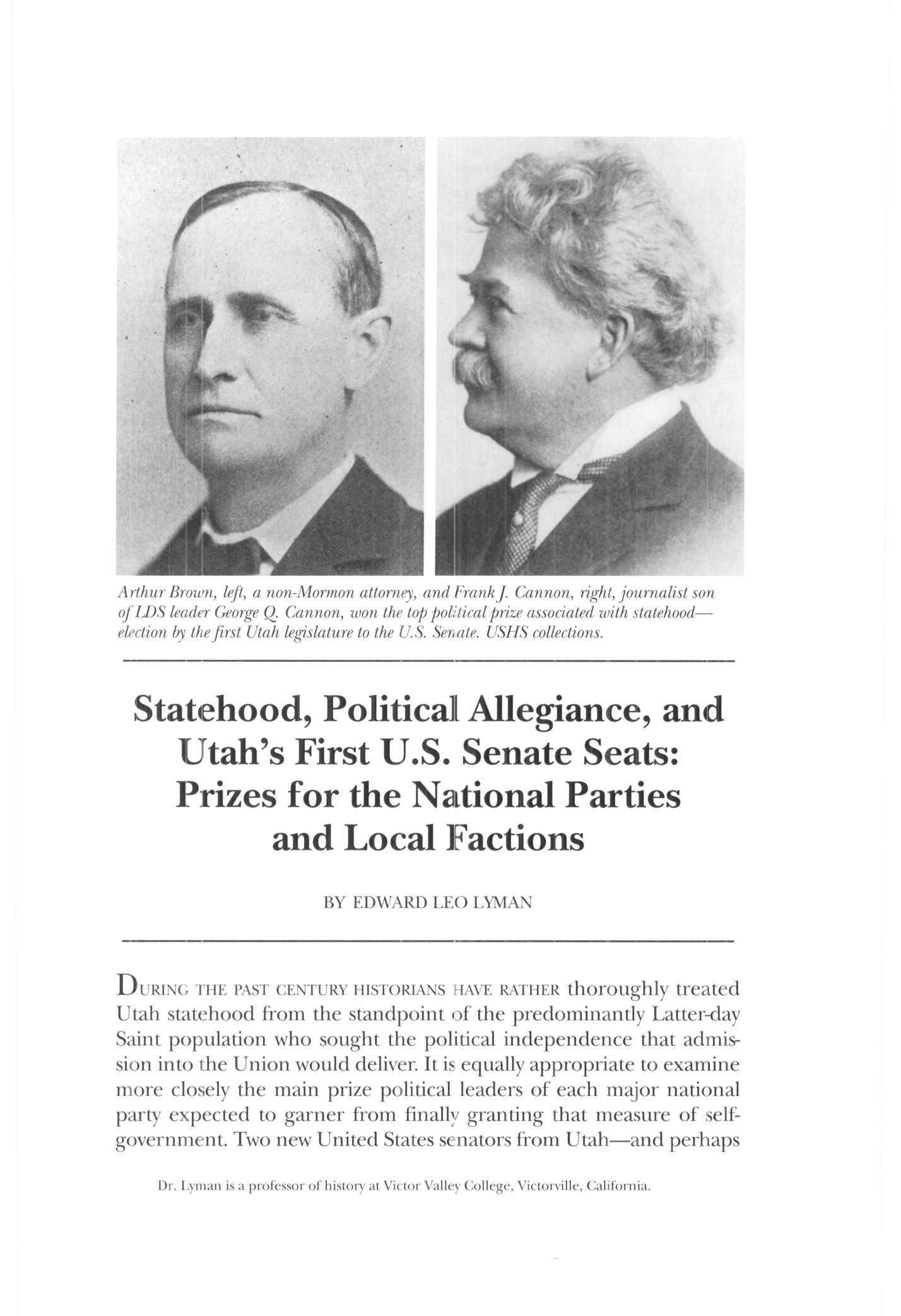 BY EDWARD LEO LYMAN
BY EDWARD LEO LYMAN
DURING THE PAST CENTURY HISTORIANS HAVE RATHER thoroughly treated Utah statehood from the standpoint of the predominantly Latter-day Saint population who sought the political independence that admission into the Union would deliver It is equally appropriate to examine more closely the main prize political leaders of each major national party expected to garner from finally granting that measure of selfgovernment. Two new United States senators from Utah—and perhaps
Arthur Brown, left, a non-Mormon attorney, and Frankf. Cannon, right, journalist son ofIDS leader George Q. Cannon, won the top political prize associated with statehood— election by the first Utah legislature to the U.S. Senate. USHS collections.
Dr Lyman is a professor of history at Victor Valley College, Victorville, California
Mormon influence over similar selections in other states—has everything to do with the close balance of power then existing between Democrats and Republicans and the hope that Mormon voter preferences might alter that situation.
In the first decade after Reconstruction less than two percentage points separated the total national Democrat and Republican vote for congressmen in all but one election. Such margins made most politicians extremely cautious, and neither party possessed the majority necessary to govern effectively. The Democrats controlled the House of Representatives all but two years in the period from 1874 to 1888, while the Republicans usually held a similar majority in the Senate and controlled the presidency except for Grover Cleveland's first term.1 Strategists of both parties sought to break the stalemate. One of the best possible ways was the admission of additional states with new congressional delegations hopefully sitting on the proper side of the aisle Potential new states were almost exclusively located in the West, and because of the Mormon influence in surrounding states, Utah was perhaps the most important one from which a national party might seek to obtain predominance.
Democrat Grover Cleveland's election in 1884 triggered great jubilation in Utah Territory since past Republican administrations had become increasingly offensive to most Mormons. But when the new president allowed GOP appointees to complete their terms in keeping with the new civil service law, church leaders through chief political spokesman and strategist George Q Cannon expressed great disappointment Besides denouncing continued misrule, Cannon sought to inform Democratic advisors close to the president of the potential political implications of alienating Mormon voters He explained that the quarter million church members who "with very few exceptions were Democrats" were so positioned throughout the Intermountain West as to "hold the power to sway elections in Utah, Idaho and Arizona" and a strength "not to be despised in Nevada and Colorado." He also affirmed that Latter-day Saint numbers were increasing, and some party—he still hoped it would be the Democrats—would eventually "appreciate their value" and seek to win their favor by granting them a more fairly administered territorial government ifnot Utah statehood.2
1 R Hal Williams, Years of Decision: American Politics in the 1890s (John Wiley & Sons: New York, 1978), pp 5-9
2 George Q Cannon to Daniel Manning, August 7, 1885, Grover Cleveland Papers, Library of Congress; Edward Leo Lyman, Political Deliverance: The Mormon Questfor Utah Statehood (Urbana: University of Illinois Press, 1986), pp 26-27, 29-30
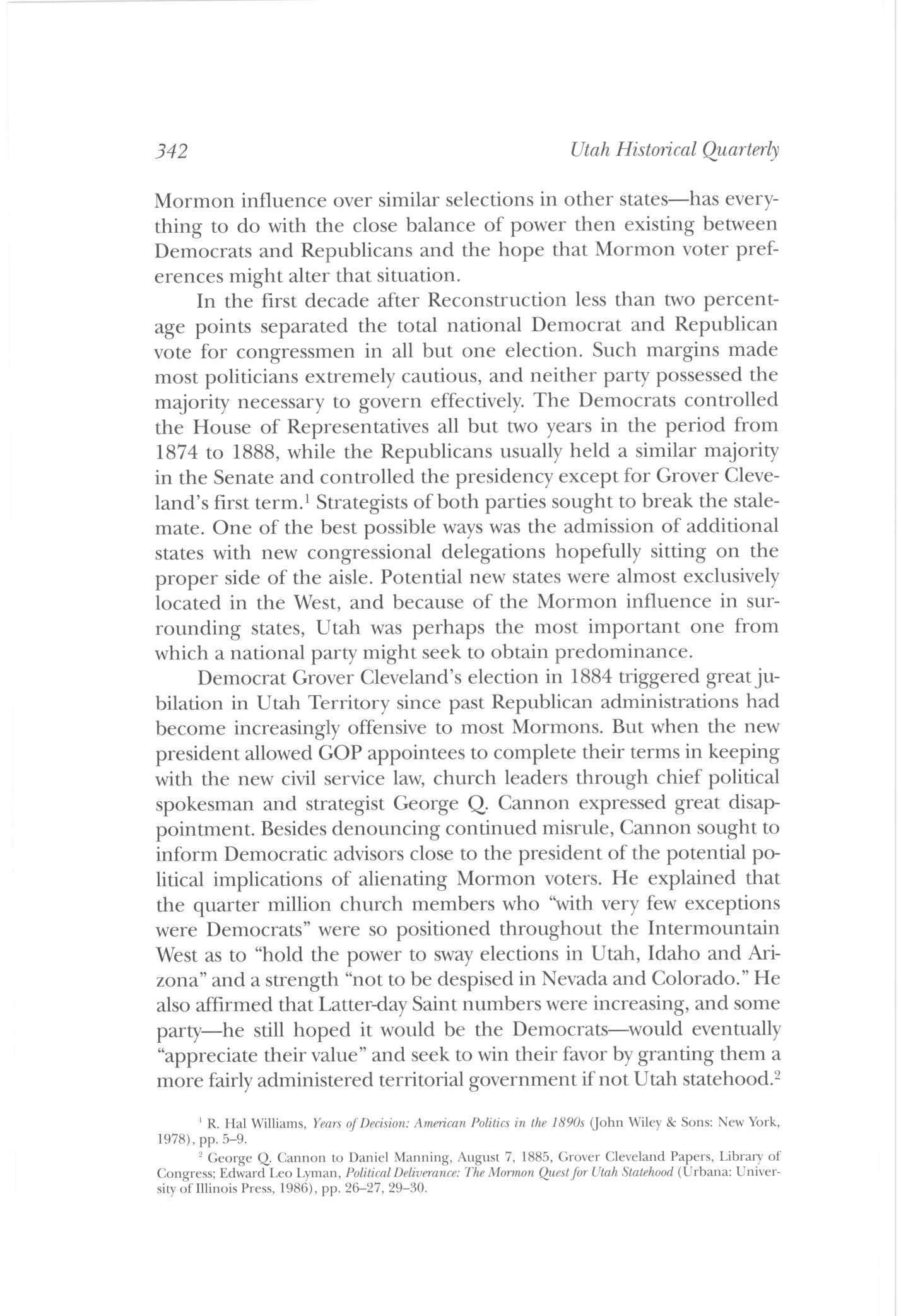
342 Utah Historical Quarterly
Cleveland and several of his advisors cooperated fully in Utah's attempt at statehood in 1887, but no such sympathy was demonstrated by the majority in the Democrat-dominated House of Representatives. There suspicion persisted that despite the recently ratified state constitution prohibiting polygamy, the practice was still condoned in Utah. Party leaders informed the church hierarchy that unless Mormons summoned before the Utah courts on polygamy charges "shall promise to obey the law against these offenses" it would be impossible to "bring the Congress of the United States to believe" that church leaders had been "honest in adopting a constitution prohibiting polygamy." After due consideration, the Quorum of Twelve Apostles concluded that since plural marriage was still considered a covenant with God, "if such a promise was necessary as a condition to [their] securing statehood that [they] at once give the administration at Washington to understand that [they] could not accept it."3
Another major obstacle to Utah statehood in 1887 and 1888 was the general disinclination among Democratic party members to interfere with the existing Electoral College balance prior to Cleveland's bid for reelection in November 1888 They undoubtedly knew, as did Mormon agents, that Dakota Territory had a better claim to admission and would, if admitted, likely vote Republican. In such a contingency Dakota would have at least one more electoral vote than Utah could offer based on population. Party leaders had not forgotten that Samuel J. Tilden's loss of the presidency to Rutherford B. Hayes in 1876 was partly because Colorado, admitted earlier that year, had cast its electoral votes for the Republicans. Similarly, Mormon and Democratic politicians recognized the liability of Utah in the presidential year Church lobbyistJohn W Young anticipated that the Republicans were "anxiously waiting for the opportunity to charge the Democratic party of admitting the Mormon church into the Union" and therefore advised working quietly to prepare the party for action early in the congressional session immediately following the election.4
After Cleveland was defeated by Benjamin Harrison, Mormon agents Charles W. Penrose and Franklin S. Richards returned to the nation's capital for a last-ditch fight for statehood. In an hour-long interview with the lame duck President Cleveland, they reminded
3 Heber J Grant Journal, September 29, 1887, Historical Department of the Church of Jesus Christ of Latter-Day Saints, Salt Lake City, hereinafter HDC; Lyman, Political Deliverance, pp 53-54
1887, January 23,
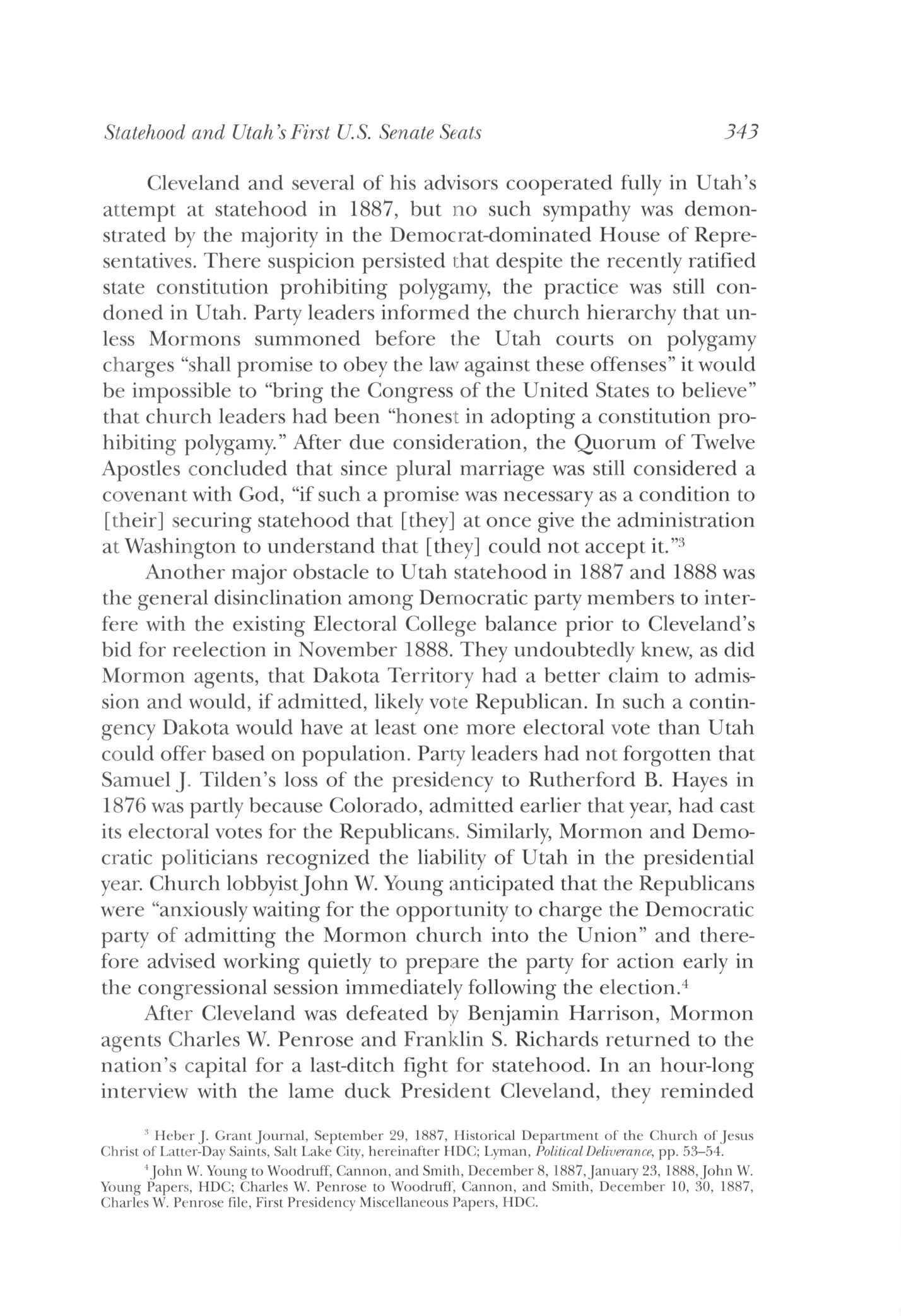
Statehood and Utah's First U.S. Senate Seats 343
4 John W. Young to Woodruff, Cannon, and Smith, December 8,
1888, John W. Young Papers, HDC; Charles W. Penrose to Woodruff, Cannon, and Smith, December 10, 30, 1887, Charles W. Penrose file, First Presidency Miscellaneous Papers, HDC.
him of the implications of the situation of the Democrats, explaining that church agents could not exercise maximum political influence in the West while Utah remained in its helpless territorial condition. Cleveland was informed there was a growing number back home who were "inclined to the belief that perhaps the Republican party, would be more likely to accord them political freedom than the Democratic party," which was allegedly not living up to its principles of home rule by denying Utah citizens statehood The president favored the proposition that Utah should join the other territories then seeking admission; he promised to see SpeakerJohn G Carlisle on the matter and suggested northern Democrats who should also be visited. The Utah lobbyists conferred with the congressmen mentioned and others but found disappointingly little sentiment in favor of adding Utah to the omnibus bill providing statehood for Dakota, Montana, and Washington. The sponsor of the bill, Territorial Committee chairman William Springer, conceded that adding Utah was the only way to admit the territory and affirmed that since the Democrats were making a concession to the GOP in allowing two Dakotas, there was a chance for reciprocation. He promised to present the matter at the pending party caucus where party priorities for the coming session would be agreed upon. 5
The outcome of the Democratic congressional caucus held in December 1888 was a great disappointment to the Mormons. Utah Delegate to CongressJohn T. Caine admitted that there was a generally kind feeling toward Utah interests but claimed it was "very evident from the first that the members of the caucus had not the courage of their convictions. They were afraid to do for Utah what they felt in their hearts was their duty to do, and what they knew the territory was entitled to receive." Caine was given a generous time allotment to present Utah's claims He was followed by Speaker Carlisle who admitted, "the gentleman from Utah [had] made a very strong appeal in behalf of his territory." But, Caine reported, in spite of the justice of the claims for statehood, the Speaker was "not in favor of complicating the Omnibus Bill with any matter that would give the [Republican] Senate a semblance of an excuse for rejecting it." Caine concluded that the Speaker's comments carried great weight in the caucus. Carlisle's fellow Kentucky congressman, W. C.P. Breckinridge, followed with remarks Caine considered very favorable.

344 Utah Historical Quarterly
5 C. W. Penrose and Franklin S. Richards to Woodruff and Smith, December 7, 1888, Charles W. Penrose Papers, HDC
He called attention to the fact that 'in leaving Utah out of the bill they were rejecting the claims of the only territory which was certain to come in as a Democratic state." However, the caucus voted to support the Omnibus bill as it was, without Utah. Soon after the final vote, in the midst of confusion as some began to leave the hall,J H Blount made a motion that the caucus recommend at least a separate bill for the admission of Utah.J. H. Outhwaite spoke strongly in favor of this. But S. S. Cox, main proponent of the Dakotas, stated that sponsoring Utah's admission would be "a fly in a pot of ointment." The recommendation passed for a separate bill proved useless.6
The Republicans held the Democrats in a hopeless position, especially with the threat of a special session immediately after Harrison's inauguration to deliver statehood solely under the auspices of the Republican party if the Democrats failed to cooperate and thus share some credit for admission of Washington, Montana, North Dakota, and South Dakota. The Democrats had no choice but to surrender and assist in granting the essential enabling acts President Cleveland signed the Omnibus bill into law on February 27, 1889, less than two weeks before his term and that of the Democrat-dominated House of Representatives was to end. This occasion also marked the failure of the sixth Utah attempt at statehood.
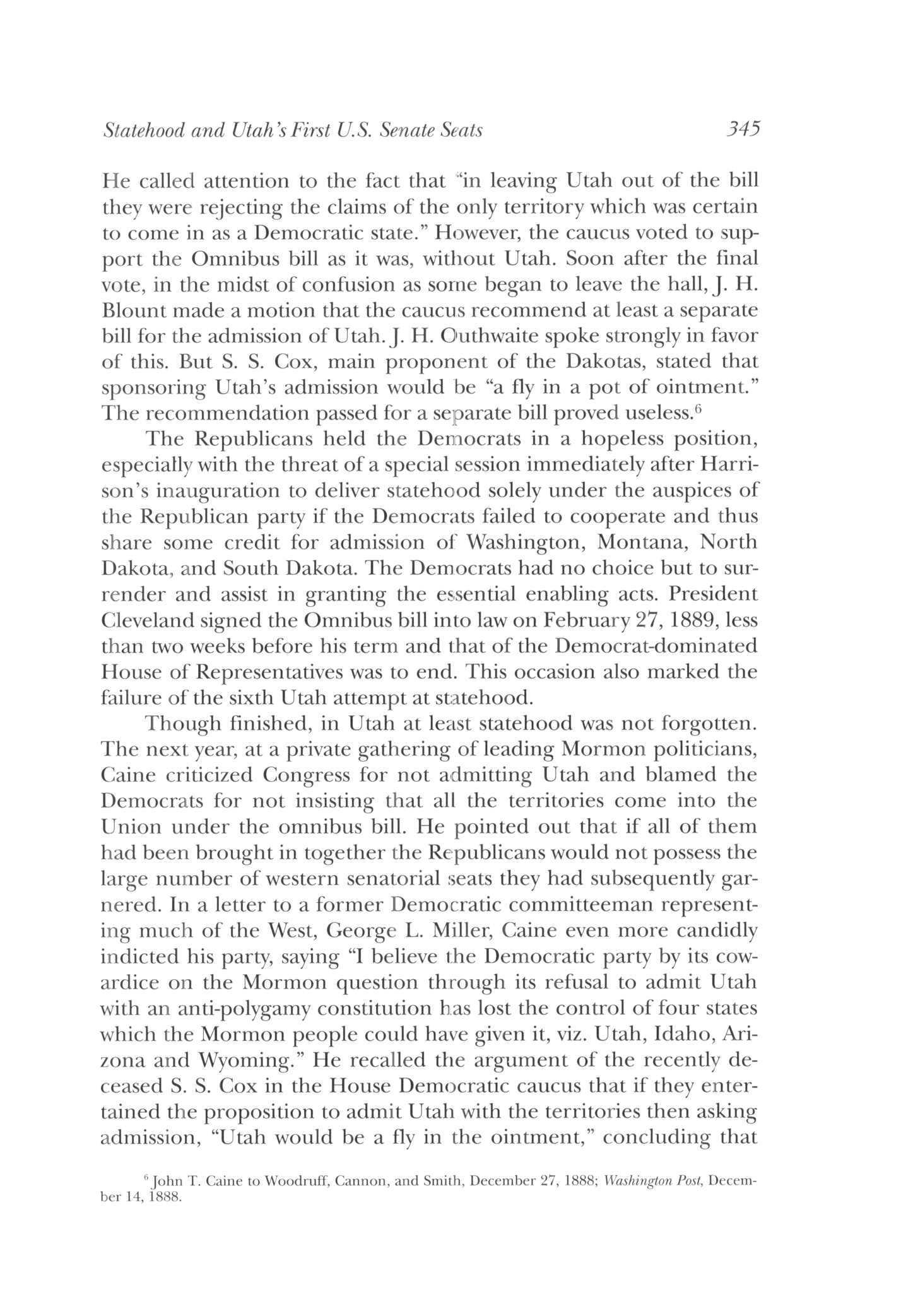
Though finished, in Utah at least statehood was not forgotten
The next year, at a private gathering of leading Mormon politicians, Caine criticized Congress for not admitting Utah and blamed the Democrats for not insisting that all the territories come into the Union under the omnibus bill. He pointed out that if all of them had been brought in together the Republicans would not possess the large number of western senatorial seats they had subsequently garnered. In a letter to a former Democratic committeeman representing much of the West, George L. Miller, Caine even more candidly indicted his party, saying "I believe the Democratic party by its cowardice on the Mormon question through its refusal to admit Utah with an anti-polygamy constitution has lost the control of four states which the Mormon people could have given it, viz. Utah, Idaho, Arizona and Wyoming." He recalled the argument of the recently deceased S. S. Cox in the House Democratic caucus that if they entertained the proposition to admit Utah with the territories then asking admission, "Utah would be a fly in the ointment," concluding that
Statehood and Utah's First U.S. Senate Seats 345
''John T Caine to Woodruff, Cannon, and Smith, December 27, 1888; Washington Post, December 14, 1888
"in straining at the fly the party lost the ointment, pot and all. In rejecting the only certainly Democratic territory they lost all the new states and the control of the government, for many years to come." Indeed the party at that crucial juncture did not possess the leadership on the national level that their opponents would demonstrate in the 1890s primarily throughJames S Clarkson andJames G Blaine And the Democrats' failure to show more commitment to the Mormon effort for Utah statehood would probably cost the party a crucial bloc of western votes not just in the immediate era but for much of the century to come. The period was to be one of transition, imperceptible at the time, but now recognized as significant for the gradual shift in political sentiments of a substantial number of Latterday Saints. It would take several years before the mutual animosities between Mormons and Republicans would be sufficiently dissipated to allow many church members to consider entering the ranks of the GOP, but alienation from the Democrats was a necessary first step that was already under way.
Although Delegate Caine and his associates understood they had no influence with the incoming Harrison regime, they knew that church leaders had other lobbyists well prepared to carry on the struggle through the Republican party. Isaac Trumbo and Alexander Badlam, Jr., Californians with some Mormon roots, had been laboring for more than a year to alter the public image of the Church ofJesus Christ of Latter-day Saints in the principal medium of the era, newspapers Trumbo would eventually play a major role in securing Republican backing for statehood.7

346 Utah Historical Quarterly
Isaac Trumbo believed his efforts in behalfof Utah statehood merited a U.S. Senate seat. USHS collections.
1 Edward Leo Lyman, "Isaac Trumbo and the Politics of Utah Statehood," Utah Historical Quarterly 41 (1973)
As the Harrison administration, bolstered by a rare Republican majority in both houses of Congress, moved their long-awaited partisan agenda toward legislative and executive fruition, they included concrete efforts to bring the recalcitrant Mormons into conformity with the laws. The keystone of this was the Cullom-Struble bill, which would take the vote away from all members of the Church of Jesus Christ of Latter-day Saints, not just polygamists and women disfranchised by the Edmunds-Tucker Act three years earlier Another effort that probably alarmed church leaders even more was the attempt to free the four Utah temples from an earlier compromise with the government that allowed them to remain safely within Mormon hands when most other church property was escheated to federal receivers. Indeed, the heavy hand of the Republican administration was exerting irresistible pressure. Yet ironically, after forcing essential changes in church practice the Republicans benefitted almost permanently from a transition in Mormon political allegiance.
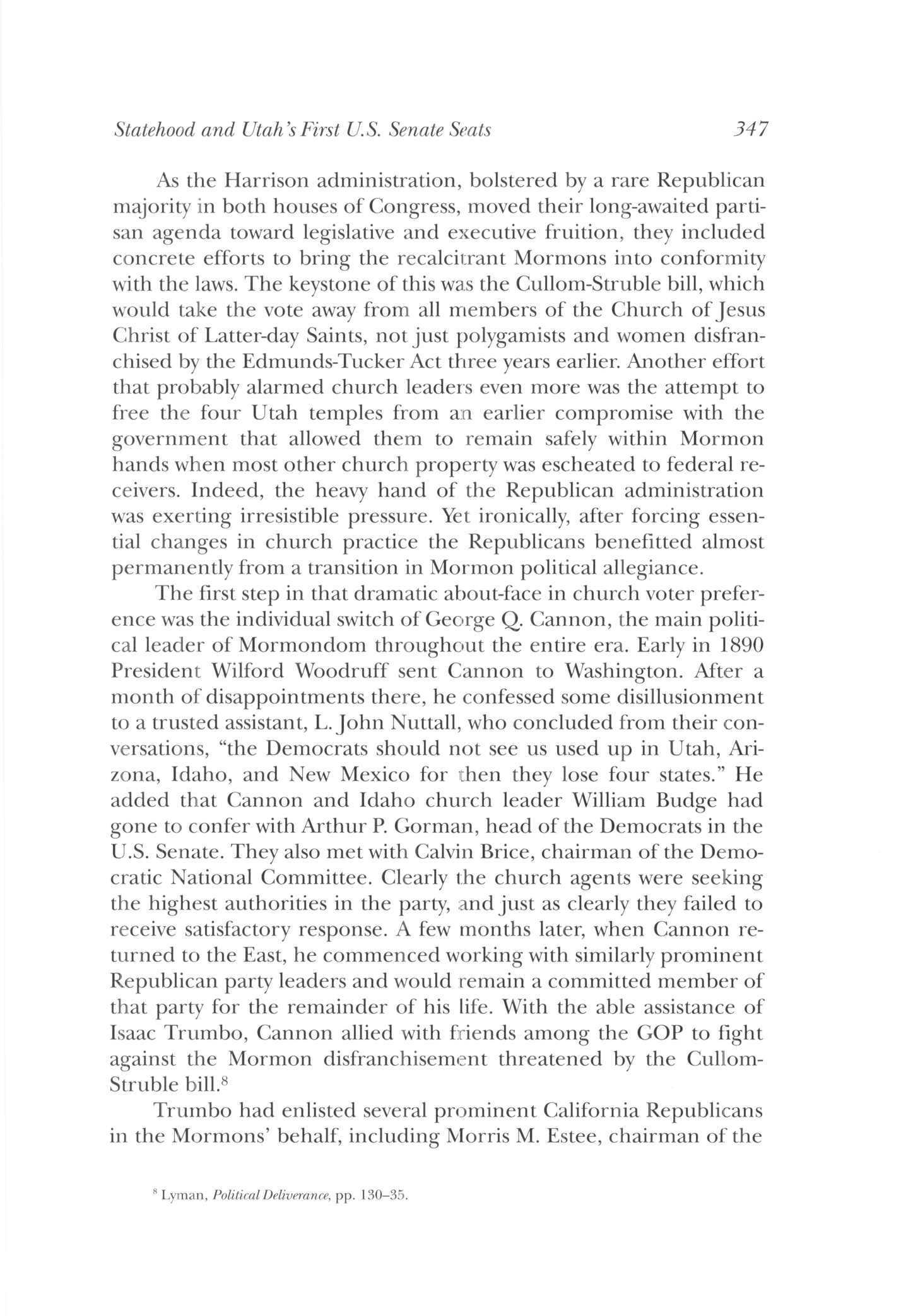
The first step in that dramatic about-face in church voter preference was the individual switch of George Q. Cannon, the main political leader of Mormondom throughout the entire era Early in 1890 President Wilford Woodruff sent Cannon to Washington. After a month of disappointments there, he confessed some disillusionment to a trusted assistant, L.John Nuttall, who concluded from their conversations, "the Democrats should not see us used up in Utah, Arizona, Idaho, and New Mexico for then they lose four states." He added that Cannon and Idaho church leader William Budge had gone to confer with Arthur P. Gorman, head of the Democrats in the LJ.S. Senate. They also met with Calvin Brice, chairman of the Democratic National Committee. Clearly the church agents were seeking the highest authorities in the party, and just as clearly they failed to receive satisfactory response. A few months later, when Cannon returned to the East, he commenced working with similarly prominent Republican party leaders and would remain a committed member of that party for the remainder of his life. With the able assistance of Isaac Trumbo, Cannon allied with friends among the GOP to fight against the Mormon disfranchisement threatened by the CullomStruble bill.8
Trumbo had enlisted several prominent California Republicans in the Mormons' behalf, including Morris M. Estee, chairman of the
Statehood and Utah's First U. S. Senate Seats 34 7
8 Lyman, Political Deliverance, pp 130-35
most recent Republican National Convention He also appealed successfully for assistance from the chairman of the Republican National Committee,James S Clarkson of Iowa Clarkson soon became a leading advocate of the view that if the Latter-day Saints were treated more fairly by the Republican party favorable political results were likely to occur. As Clarkson embarked on his labors he approached Secretary of StateJames G. Blaine, then the most influential of all leaders within the Republican party. As Clarkson later revealed to Wilford Woodruff, he and Blaine "were studying the elements of voters in the United States to try to secure a majority for the political principles in which [they] believed." They were impressed to learn from Trumbo "the magnitude of the Mormon people, the greatness of their development in many states besides Utah, and the large part they were sure to bear, for good or evil, in the destiny of this republic." The key event recounted by Clarkson was Blaine's appearance before a congressional committee considering the Cullom or Struble versions of the disfranchisement bill and "protesting against such an outrage upon any portion of a free people, asserting that no republic of free men could tolerate such a wrong and live." The Republican chairman concluded his overlaudatory account by stating to Wilford Woodruff that Blaine "stood in the small committee room and smote down with the giant strength of his indignant wrath this further attempt in a free government to degrade still further a people already wronged too much." The bill never passed.9
Wuhen George Q. Cannon returned to Salt Lake City he reported to fellow church leaders on the political outlook, saying that prospects were brighter for Utah than they had been for many years. That he had alluded to some tantalizing possibilities with Republicans is indicated from a later conversation on the subject in which he is quoted as saying that "we would doubtless have been disfranchised by the Struble Bill if the Republican leaders in Washington had not been given to understand that there were Republicans in Utah and that a wise course on the part of the Republicans would doubtless make more." Cannon was also quoted by his son Abraham as being optimistic that despite continuing anti-Mormon activity, "the Republican party are [sic] becoming more favorably impressed
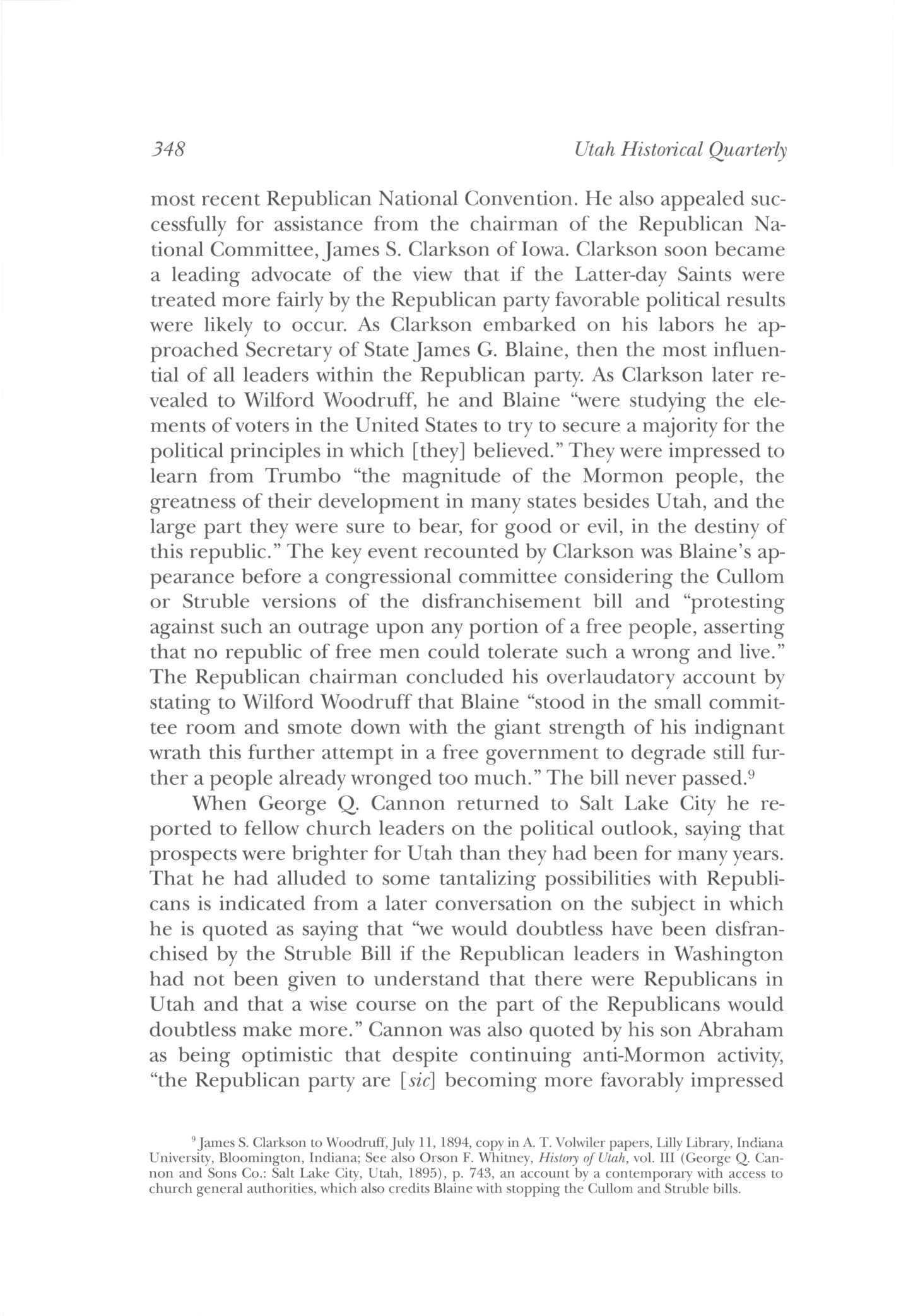
348 Utah Historical Quarterly
9 James S Clarkson to Woodruff, July 11, 1894, copy in A T Volwiler papers, Lilly Library, Indiana University, Bloomington, Indiana; See also Orson F Whitney, History of Utah, vol Ill (George Q Cannon and Sons Co.: Salt Lake City, Utah, 1895), p 743, an account by a contemporary with access to church general authorities, which also credits Blaine with stopping the Cullom and Struble bills
with regard to the importance of securing Mormon votes and influence." Historian and future apostle Orson F.Whitney stated that one of the arguments used to appeal to Blaine and his associates was that "Utah was not'hopelessly Democratic' [and] that many of her people were indoctrinated with Republican principles notably [tariff] protection—and that it was suicidal to antagonize the element that might make Utah a Republican state." In reflecting on the political discussions he had heard that day, Abraham Cannon stated, "the Democrats might have won several states had they but possessed sufficient courage when Cleveland was President to admit Mormons to political power, but they failed to do so and now realize their loss."10
Undoubtedly George Q. Cannon's recent experience in the East had great influence on the crucial decisions made on [uly 31, 1890, when Presidents Woodruff and Cannon met and discussed politics with at least four prominent Mormon Democrats: Heber J. Grant, Franklin S. Richards, Charles W. Penrose, and Richard W. Young.They heard that Democrats in Montana, Idaho, and Wyoming were anxious to "get Mormon votes" and had approached church members for that purpose. After some discussion it was decided not to help Democrats in any of those states but to aid Wyoming Republicans "as a reward to Delegate [Joseph] Carey and his party for getting Wyoming admitted as a state without anti-Mormon legislation."Abraham Cannon's detailed account of the meeting includes the telling observation that "the Democrats when they had the power to do us good were afraid, and betrayed us so that now we feel as though the Republican party should be tried to see if they will be fair to us." The contrast between Idaho, where the Saints had voted
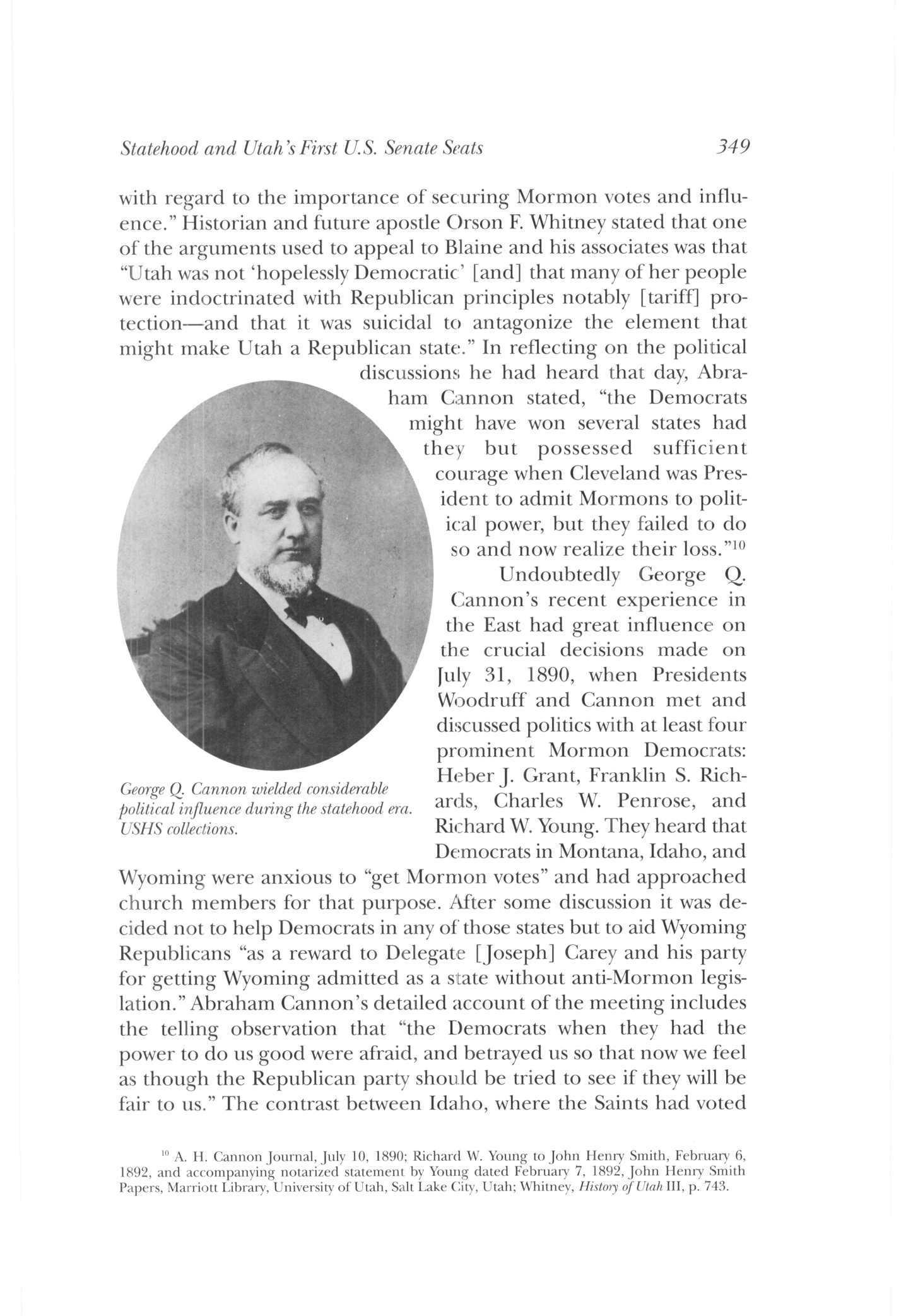
Statehood and Utah's First U.S. Senate Seats 349
George Q. Cannon wielded considerable political influence during the statehood era USHS collections.
1,1 A H Cannon Journal, July 10, 1890; Richard W Young to John Henry Smith, February 6, 1892, and accompanying notarized statement by Young dated February 7, 1892, John Henry Smith Papers, Marriott Library, University of Utah, Salt Lake City, Utah; Whitney, History of Utah III, p 743
Democrat, and Wyoming, where they had voted Republican, was on the minds of those present Abraham Cannon, usually an avowed non-partisan, concluded that "self-protection demands that we look to the Republicans for relief, now that the Democrats have proved themselves cowards on our question."11 These decisions had everything to do with the way George Q. Cannon had been treated by nationally prominent members of both parties over the past half year.
In subsequent months Mormon leaders, partly at the urging of Blaine and others, formulated policies through which they at least temporarily abandoned contracting plural marriages in the United States. The Woodruff Manifesto, fully discussed elsewhere,12 was an essential step in securing Republican backing for Utah statehood. Thereafter, members of the Harrison administration demonstrated marked cooperation in easing some of the harsh federal policies toward Mormon polygamists and in other ways indicated an intent to foster the growing favorable sentiment among church members toward the Republican party
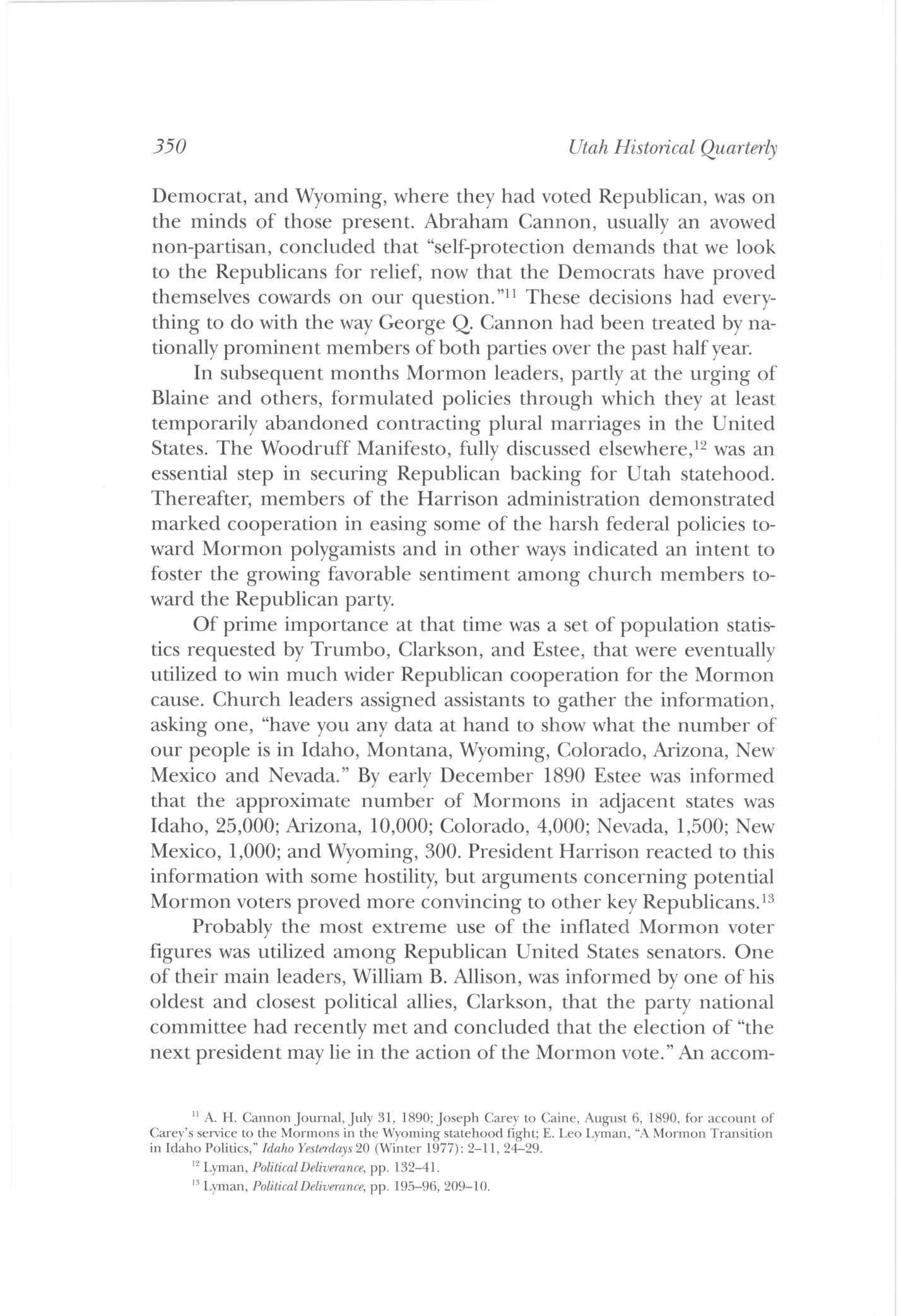
Of prime importance at that time was a set of population statistics requested by Trumbo, Clarkson, and Estee, that were eventually utilized to win much wider Republican cooperation for the Mormon cause. Church leaders assigned assistants to gather the information, asking one, "have you any data at hand to show what the number of our people is in Idaho, Montana, Wyoming, Colorado, Arizona, New Mexico and Nevada." By early December 1890 Estee was informed that the approximate number of Mormons in adjacent states was Idaho, 25,000; Arizona, 10,000; Colorado, 4,000; Nevada, 1,500; New Mexico, 1,000; and Wyoming, 300 President Harrison reacted to this information with some hostility, but arguments concerning potential Mormon voters proved more convincing to other key Republicans.13
Probably the most extreme use of the inflated Mormon voter figures was utilized among Republican United States senators. One of their main leaders, William B.Allison, was informed by one of his oldest and closest political allies, Clarkson, that the party national committee had recently met and concluded that the election of "the next president may lie in the action of the Mormon vote."An accom-
12 Lyman, Political Deliverance, pp 132-41
13 Lyman, Political Deliverance, pp 195-96, 209-10
350 Utah Historical Quarterly
" A H Cannon Journal, July 31, 1890; Joseph Carey to Caine, August 6, 1890, for account of Carey's service to the Mormons in the Wyoming statehood fight; E. Leo Lyman, "A Mormon Transition in Idaho Politics," Idaho Yesterdays 20 (Winter 1977): 2-11, 24-29
panying paper, not now available, was said to show "the number of votes of their people outside Utah and the remarkable manner in which they [were] so diffused as to have the probable balance of power in 8 or 10 states." Clarkson argued that at a time when the Populist party was gaining headway in the West and Midwest, the Mormons were the great balance of conservatism against that drift if properly utilized He continued that the information he had prepared was meant to influence senators who "may not understand the power of the Mormon vote," adding that all his committee agreed that the Utah admission bill should pass the Senate because "it [was] a vital matter to the future of the party."14 As Clarkson explained to Wilford Woodruff, he sometimes made even more extreme statements of church voting strength. He said, ". . . this was not merely a Utah question but that the Mormon people were spread through the valleys of eight or ten western states, and that sooner or later they would hold the balance of power in the election of every senator and of every electoral vote for president in these states." The Republican national committee chairman admitted he made such arguments the foundation of his efforts to "change the Republican party from being a party of opposition [to church political power] ... to one of friendship and support."15

There were certainly other obstacles to overcome before Utah was finally admitted as a state in 1896, but the greatest challenge of the entire process was gaining the approval of Republican members of the U.S Senate And that was clearly accomplished by convincing individual senators that not only was plural marriage dying in Mormondom but that there was a good chance of garnering church voter support for their party if the Utah statehood issue was properly
14 J S C [Clarkson] to Dear Senator [William B Allison] (undated papers of August, 1893), William B .Allison Papers, Iowa State Library, Des Moinss; Edward Leo Lyman, "The Mormon Quest of Utah Statehood," (Ph.D diss., University of California, Riverside, 1981), p 591, states: "Although the membership statistics were never officially published by the Church of Jesus Christ of Latter-day Saints, they were substantially the same as those contained in the Report of Statistics of Churches in the United States at the Eleventh Census: 1890. However, the manner in which that census report was arranged allowed for considerable distortion of actual membership strength particularly beyond the Intermountain region This was because most of the census treatment of the Mormons failed to differentiate properly between the Church of Jesus Christ of Latter-day Saints, and the Reorganized Church of Jesus Christ of Latter Day Saints, whose membership figures were often included in L D S totals With the R L D S so added, the Mormons were designated as the twelfth largest religious denomination in the United States This report was not published until 1894, but someone as well acquainted with the federal bureaucracy as James S Clarkson could easily have gained access to the material for his political efforts in behalf of Utah Mormons, if needed in 1892 and 1893." Any Mormon voter strength in Illinois, Missouri, or California at that time would have been RLDS and certainly not in sympathy with Utah statehood
15 Clarkson to Woodruff, July 11, 1894
Statehood and Utah's First U.S. Senate Seats 351
handled This included quite possibly adding two Republican colleagues to their midst, which would be a crucial accomplishment in gaining congressional predominance One of the great ironies in Utah history is that the party which had been born in 1856 denouncing polygamy along with slavery as "the twin relics of barbarism" and had spent the ensuing three decades in hostile opposition to the church and Utah statehood—eventually forcing concessions through heavy-handed legislative threats—would in the century that followed command such a preponderance of allegiance from members of the Church ofJesus Christ of Latter-day Saints.
With statehood achieved, attention then focused naturally on the first legislature's selection of the Utah senators. It had long been conceded that one of these positions would go to a non-Mormon. Under almost any circumstances the LDS senatorship would be granted enthusiastically to the first counselor in the First Presidency George Q. Cannon was one of the most astute political figures of his generation. His reputation, experience, and some perspectives transcended local bounds. Expelled as delegate to Congress in 1882 because of his involvement in plural marriage, he had harbored ambitions ever since to return in triumph as one of Utah's first senators Most of those who had helped Utah achieve statehood on the national level approved and assumed he would be so honored Yet all chance of his being selected by the Utah legislature were dashed by the rash act of one of his closest associates,Joseph F. Smith.
Although it was then the prerogative of the state legislature to select U.S senators, Utah Democrats nominated the candidates they intended to support for those offices as well as Utah's sole member of the House of Representatives prior to the crucial election campaign in the fall of 1895. Apostle Moses Thatcher was chosen as the Mormon candidate for the Senate and another general authority of the church, Brigham H Roberts, was named as the Democrats' congressional candidate. For some time, though, church leaders had tried to quietly limit political activism among the highest-ranking church authorities unless they had the approval of the First Presidency. In the heated partisan battle prior to actual statehood, some believed the two Democrats had violated church protocol.
During an obscure session of the semi-annual conference of the church in October, Joseph F. Smith made remarks that precipitated perhaps the most heated political controversy in Utah history. He was simply explaining that the church possessed living oracles whose

352 Utah Historical Quarterly
counsel should be heeded in all matters of life This led to mention, perhaps as a spontaneous illustration by a man never known for being diplomatic or restrained in speech, of an apostle and member of the Seven Presidents of Seventy (Roberts), who had "done wrong in accepting obligations without first consulting and obtaining the consent of those who presided over them."
The obvious reference to the Democratic candidates generated little immediate notice, but it eventually led to the party reconvening its state convention and mounting a concerted protest against church interference in political affairs. Besides focusing on Smith's indiscretion, many former episodes considered detrimental to the Democrats were widely recounted. Most specifically, party members questioned the seemingly unlimited partisan activity of avid Republican ApostleJohn Henry Smith while a number of Democrats among the church hierarchy appeared to have been kept under close restraint Party leader Orlando W Powers queried, "why should a Democrat be called upon to counsel withJoseph F Smith, a Republican?" And in this they had a good case, although the excitement generated did not lead to victory at the polls.16
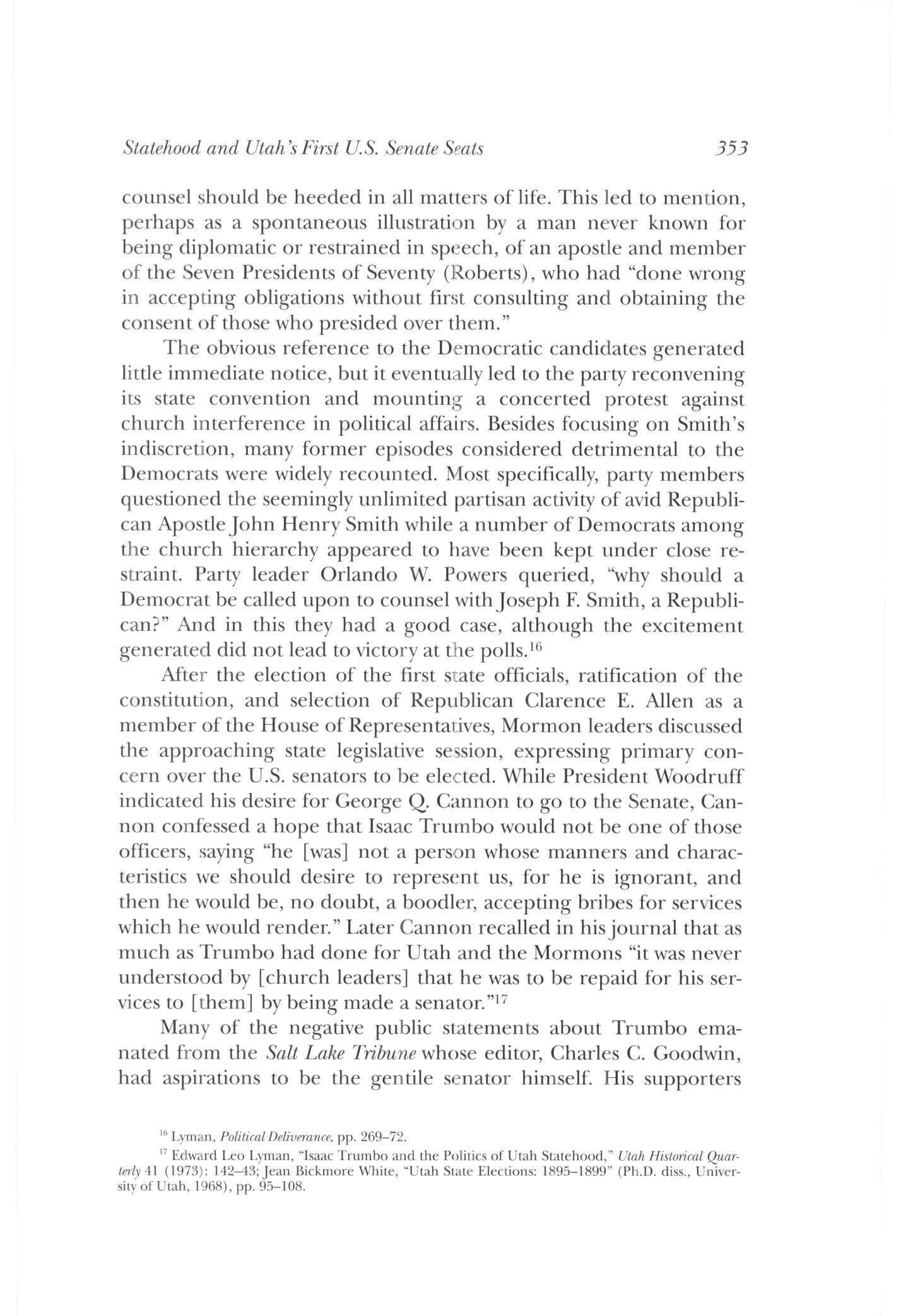
After the election of the first state officials, ratification of the constitution, and selection of Republican Clarence E. Allen as a member of the House of Representatives, Mormon leaders discussed the approaching state legislative session, expressing primary concern over the U.S senators to be elected While President Woodruff indicated his desire for George Q Cannon to go to the Senate, Cannon confessed a hope that Isaac Trumbo would not be one of those officers, saying "he [was] not a person whose manners and characteristics we should desire to represent us, for he is ignorant, and then he would be, no doubt, a boodler, accepting bribes for services which he would render." Later Cannon recalled in hisjournal that as much as Trumbo had done for Utah and the Mormons "it was never understood by [church leaders] that he was to be repaid for his services to [them] by being made a senator."17
Many of the negative public statements about Trumbo emanated from the Salt Lake Tribune whose editor, Charles C Goodwin, had aspirations to be the gentile senator himself. His supporters
16 Lyman, Political Deliverance, pp. 269-72.
17 Edward Leo Lyman, "Isaac Trumbo and the Politics of Utah Statehood," Utah Historical Quarterly 41 (1973): 142-43; Jean Bickmore White, "Utah State Elections: 1895-1899" (Ph.D. diss., University of Utah, 1968), pp 95-108
Statehood and Utah's First U.S. Senate Seats 353
were closely allied with FrankJ. Cannon, whose chances for nomination as the Mormon senator were excellent—if his father was not in the contest. One of Goodwin's supporters, Idaho Senator Fred T. Dubois, sent a letter to Abraham H Cannon, admittedly intended for his father, cautioning against the elder man running and being subject to charges of church interference. Abraham answered, assuring Dubois that his father had declared himself unequivocally out of the Senate race and would not accept the nomination under any circumstances But, he continued, Cannon chose to remain publicly silent on the matter expressly to prevent Trumbo from retaliating against Frank should he learn of the dissolution of the presumed earlier alliance too soon. 18
About the same time, Trumbo's old lobbying associate,James S. Clarkson, wrote to President Woodruff to remind him of the men he and others on the Republican National Committee hoped would be chosen as Utah senators. He strongly urged the selection of George Q Cannon and Isaac Trumbo Woodruff answered that because of recent events, particularly the church interference controversy, he felt it advisable to abstain from active involvement in Utah politics He agreed that Cannon would be the best possible choice and acknowledged his own personal fondness for Trumbo as well as his service to Utah citizens. Nevertheless, he did not believe he and his associates then possessed sufficient political power to accomplish the election of either man. 19
On December 26, 1895, Trumbo engaged a sometime Southern Pacific Railroad lobby operative, R W Ruffin, to assist him in his senatorial campaign and particularly to facilitate his introduction to Henry E. Huntington, Collis P. Huntington's trusted nephew, then in charge of the company's political operations in California. The stated purpose of this meeting was to secure Huntington's "material and moral support" for Trumbo's Utah campaign Although Ruffin painted a bright picture of Trumbo's prospects—twenty-two legislators for him and nine whom financial aid from the SP could help him obtain—the Huntingtons decided against providing such aid. Other wealthy California businessmen similarly declined to back Trumbo.
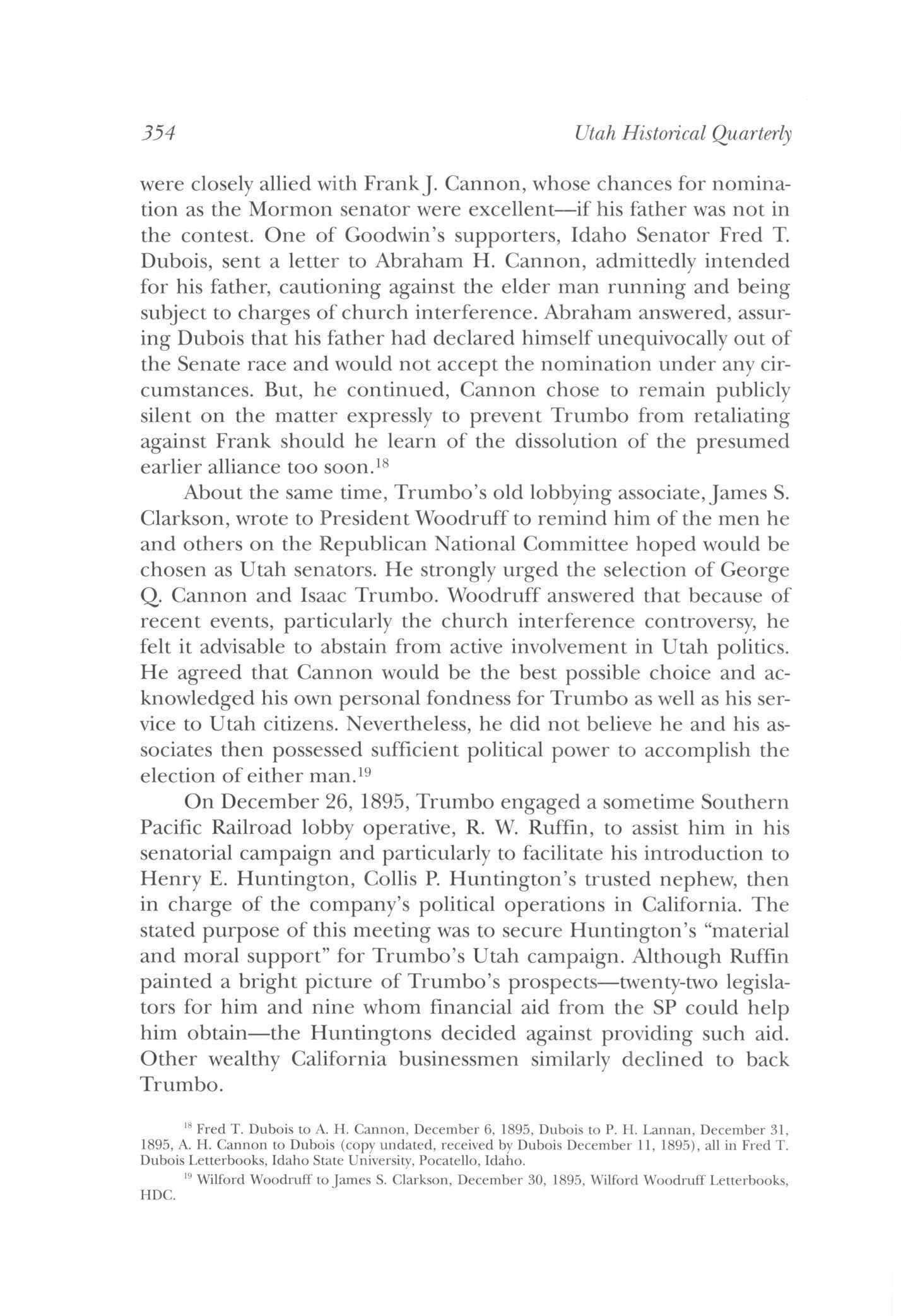
354 Utah Historical Quarterly
18 Fred T Dubois to A H Cannon, December 6, 1895, Dubois to P H Lannan, December 31, 1895, A H Cannon to Dubois (copy undated, received by Dubois December 11, 1895), all in Fred T Dubois Letterbooks, Idaho State University, Pocatello, Idaho
19 Wilford Woodruff to James S. Clarkson, December 30, 1895, Wilford Woodruff Letterbooks, HDC
For eight years Trumbo had been seeking a U.S. senate seat, but George Q. Cannon was correct about his lack of real qualifications, other than good political connections, and that he too often utilized methods not approved by church leaders. At one time he might have secured the votes of Mormon legislators and eventually, in some manner, the remaining support needed for election. But when his presumed ally George Q. abandoned him at least partially to assist his son to secure the "Mormon" Senate seat, Trumbo's dream of the Senate was thwarted. Trumbo's campaign manager, Charles Crane, warned Republican lawmakers that a proposed party caucus was an attempt to stampede them prematurely into commitments on the senatorial matter.20 But with enthusiasm for Frank Cannon mounting as his father finally announced his withdrawal from the race, the meeting was held and Frank nominated by acclamation. There was far less certainty about the "gentile" seat, but strategists for Salt Lake attorney Arthur Brown believed their man had more voter strength at the moment than any of his rivals, and they pushed for a rather unexpected ballot on that seat as well. Another Salt Lake attorney, Charles W. Bennett, had gained supporters; but with Goodwin's people backing Brown on the first vote, Brown garnered the requisite votes for election. Although some subsequently questioned how binding the party caucus decision was, it proved decisive and was soon made official in the legislative session.21
News of the selection of Utah's senators provoked considerable discussion around the nation, including among the members of Congress. Frank J. Cannon, the Utah delegate to Congress when statehood was actually granted, was accepted readily But, as in Utah, Brown's choice met with little enthusiasm. A special news dispatch from Washington to the Democratic Salt Lake Herald reported, "the impression prevailed here that Colonel Trumbo would be selected as one of the senators. Some of his friends declare Trumbo's defeat to be a piece of rank ingratitude" since his efforts on behalf of statehood were so well known and his reward still expected.22
Brown's short tenure as senator from Utah was indeed undistinguished And his subsequent murder by a discarded mistress permanently tarnished his image so far as his adopted state was concerned.23
20 Salt Lake Tribune, January 6, 1896
21 Lyman, "Trumbo and Statehood," pp 144-45; Lyman, Political Deliverance, pp 283-84
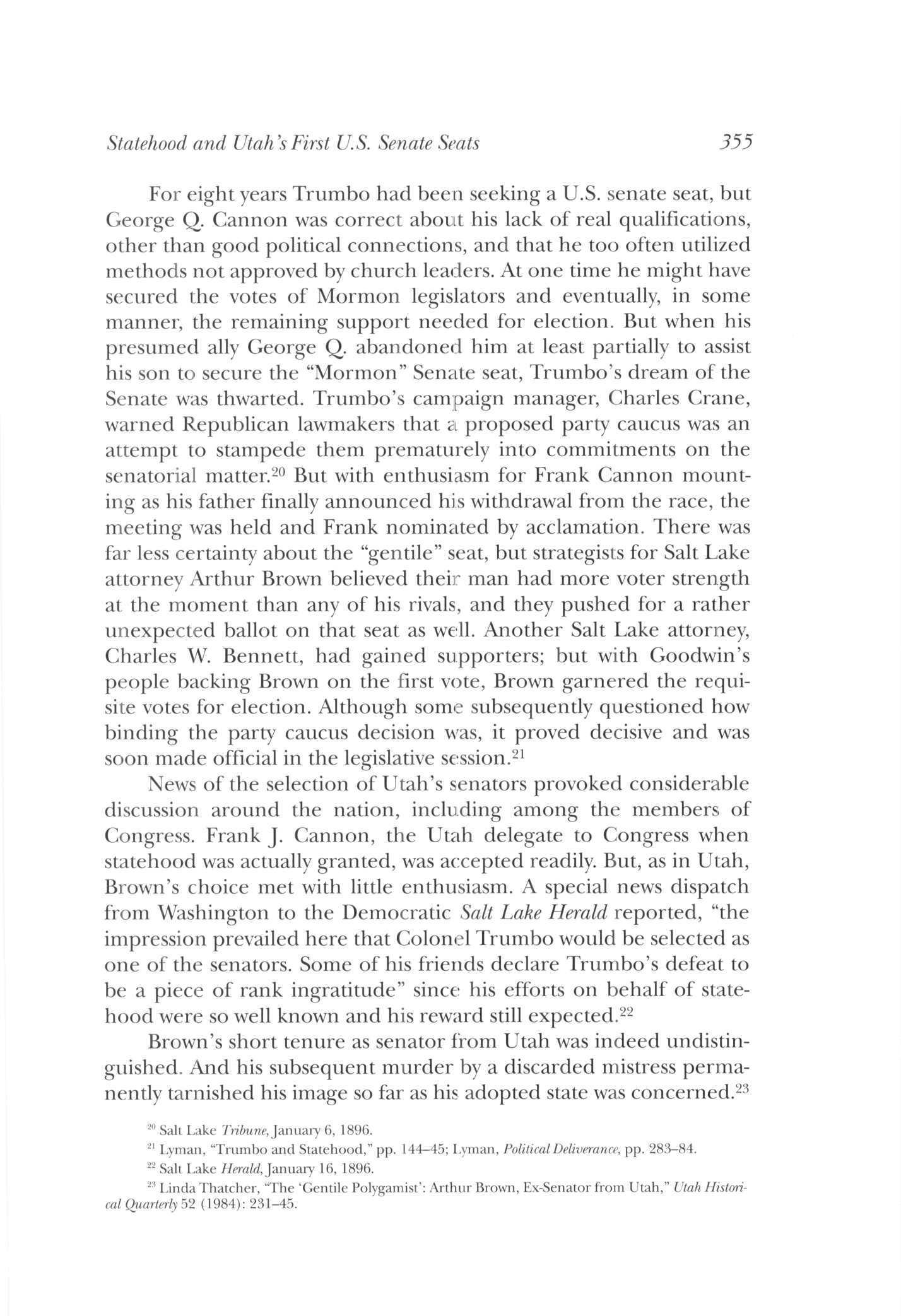
22 Salt Lake Herald, January 16, 1896
23 Linda Thatcher, "The
cal Quarterly 52 (1984): 231-45.
Statehood and Utah's First U.S. Senate Seats 355
'Gentile Polygamist': Arthur Brown, Ex-Senator from Utah," Utah Histori-
But, actually, Frank Cannon may have been an even greater disappointment to most Utahns. The year of his election he bolted the Republican convention over its position on silver coinage and thereafter often sided with the Democrats. After his father's death he apostatized from the church, to which he had never been particularly committed spiritually. He eventually authored a muckrake-type expose of Mormonism, by that time no longer even residing in the state.24 Thus, the men who had worked longest and most directly in the successful struggle for Utah statehood, George Q. Cannon and Isaac Trumbo, failed to receive the senatorial rewards that many desired them to attain. And Utahns would soon admit that the men so favored did little to merit the honors bestowed upon them.
Actually, the Southern Pacific Railroad interests did secure Utah senatorial support, probably more loyal than Isaac Trumbo was ever likely to be. By the end of the summer of 1896 the ever-vigilant Collis
P. Huntington, located in the East partly to oversee company affairs at the nation's capitol, instructed his nephew to quietly send Arthur Brown an unmarked package of one thousand dollars in currency This was undoubtedly some kind of unofficial retainer for a man old Huntington described as knowing what was right—presumably for the railroad company—and having the courage to do what was right. Thus the Southern Pacific secured favorable senatorial support at a far lower cost than it would have taken to assist Isaac Trumbo to purchase eight or nine legislators' votes.25
Achieving statehood was a difficult task, which made its accomplishment all the more appreciated In the process Utah and Mormon political allegiances shifted significantly in favor of the formerly hostile Republican party. In the hundred years since then Utah has shown a good two-party viability, but Democrats elected to state offices and congressional seats have generally been from the more conservative members of that party Presently there are few parts of the nation so firmly aligned with conservative Republicanism as is Utah The antecedents for this are many and complex, but their initial presence can be traced as far back as the period just prior to admission of the new state.
24 Leonard Schlup, "Utah Maverick: Frank J Cannon and the Politics of Conscience in 1898," Utah Historical Quarterly 62 (1994): 335-48
25 Collis P Huntington to Henry E Huntington, August 28, 1896, Henry E Huntington Papers
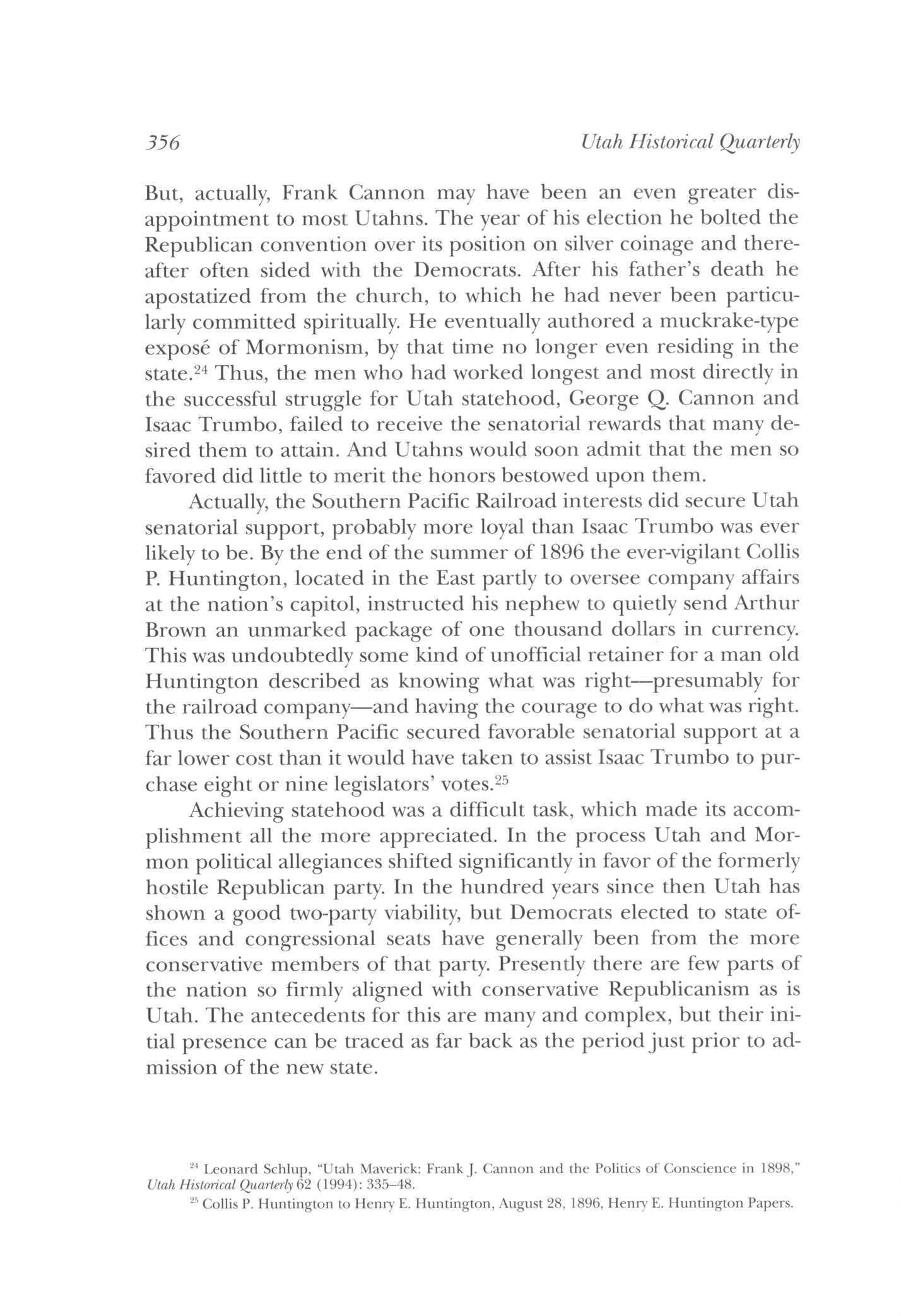
356 Utah Historical Quarterly
All Hail! Statehood!
 BY AUDREY M. GODFREY
BY AUDREY M. GODFREY
1896. IT WAS THE YEAR THE U.S. POST OFFICE established rural free delivery Baseball was the national pastime, and Utah residents tried to rid their fields of Chinese pheasants, fearing the imported birds would kill quail and farmyard fowl and ruin grain crops The first modern Olympics was held in Athens, and Harriet Beecher Stowe died. But 1896 also saw Utah brought into the Union as the 45th state.
The people of the new commonwealth—long alienated from the federal government—forgot the Utah War, the pigeon-holing of their requests for statehood, and negative federal legislation. All was forgiven when on January 4, at 10:03 A.M., President Grover Cleveland finally signed the proclamation granting statehood and set off a mammoth celebration throughout the new state.
At 9:13 A.M (Utah time) Superintendent Brown of Western Union rushed from his office armed with a shotgun and fired two shots into the air, signaling the news A small boy in the vicinity dived for cover thinking a robbery was in progress. At this prearranged signal, merrymaking commenced. Bill Bingley and his shotgun brigade terly.
Artwork from the Ogden Standard, fanuary 4, 1896.
Mrs. Godfrey, Logan, Utah, is a member of the Advisory Board of Editors, Utah Historical Quar-
gathered near Browning Brothers store in Salt Lake, and boys blew whistles and set off "bombs" felt blocks away At 11:30 the NGU (National Guard of Utah) gathered on Capitol Hill at noon to fire a21gun salute.1
The news spread like wildfire throughout the territory, and frantic committees put into motion planned festivities to mark the event. Two days earlier, acting Governor Charles C. Richards had declared the Monday after the signing day as a public holiday "for thanksgiving and rejoicing." He directed that schools and "all unnecessary business[es]" close so that all might celebrate "in a manner becoming a free, intelligent and patriotic people."2
In big towns and little towns the citizens of Utah mustered all their creativity to celebrate this joyous and welcome occasion. A Monroe poet suggested the script for the day in her lines,
Hail welcome day! Blest be thy dawn!
Hail! all hail! the auspicious morn.
Let shouts and songs of gladdening cheer Re-echo long and loud and clear.3
for Utahns awoke that Monday morning to a din surpassing anything they had heard before. Guns, whistles, and bells of every variety challenged anvils, dynamite, yelling, singing, drums, and bands for two hours and then intermittently throughout the day. A. H. Woodruff called the racket "Bedlam," while a reporter labeled it "hilarious pandemonium." When gunpowder ran out the celebrants rattled their weapons. Coalville residents fired up the large steam engine from Grass Creek terminal to add to the commotion. A reporter likened the barrage of noise to a "Fourth ofJuly in the winter time" as people thronged to the streets on a clear, cold, sunny day to join the festivities.4
In Manti citizens ushered in Inauguration day, "Utah's most glorious day," at sunrise as the Ordnance Committee filled the central square. With anvils and dynamiters at the center, cannoneers on the right, musketeers on the left, shotgunners in the front and "promiscuous armeers" at the back, all encircled by "burroears"jingling cow
1 Deseret Evening News, January 4, 1896; Ogden Standard, January 4, 1896
2 Deseret Evening News, January 2, 1896
3 Richfield Advocate, January 15, 1896. Poem composed and read by Lela Cooper Preston at Moroni's celebration
4 Manti Messenger, January 10, 1896; Wilford Woodruff to A H Woodruff, January 6, 1896, Stewart Library, Weber State University, Ogden; Coalville Times, January 10, 1896; Vernal Express, January 9, 1896

358 Utah Historical Quarterly
and sheep bells, the resulting din ensured that none of the townspeople would sleep through the occasion. A reporter said of the merrymaking, "young and old America did themselves proud."5
In the heat of the exuberant celebration injuries and property damage occurred. During the revelers' march through Brigham City, Valentine Anderson was accidentally shot in the back with a charge of powder and wadding. The wads penetrated his clothing causing much pain but no serious injury. When questioned, every man in the shotgun brigade denied being the guilty party. The paper summed up the incident by saying, 'Valentine must have dosed himself then."
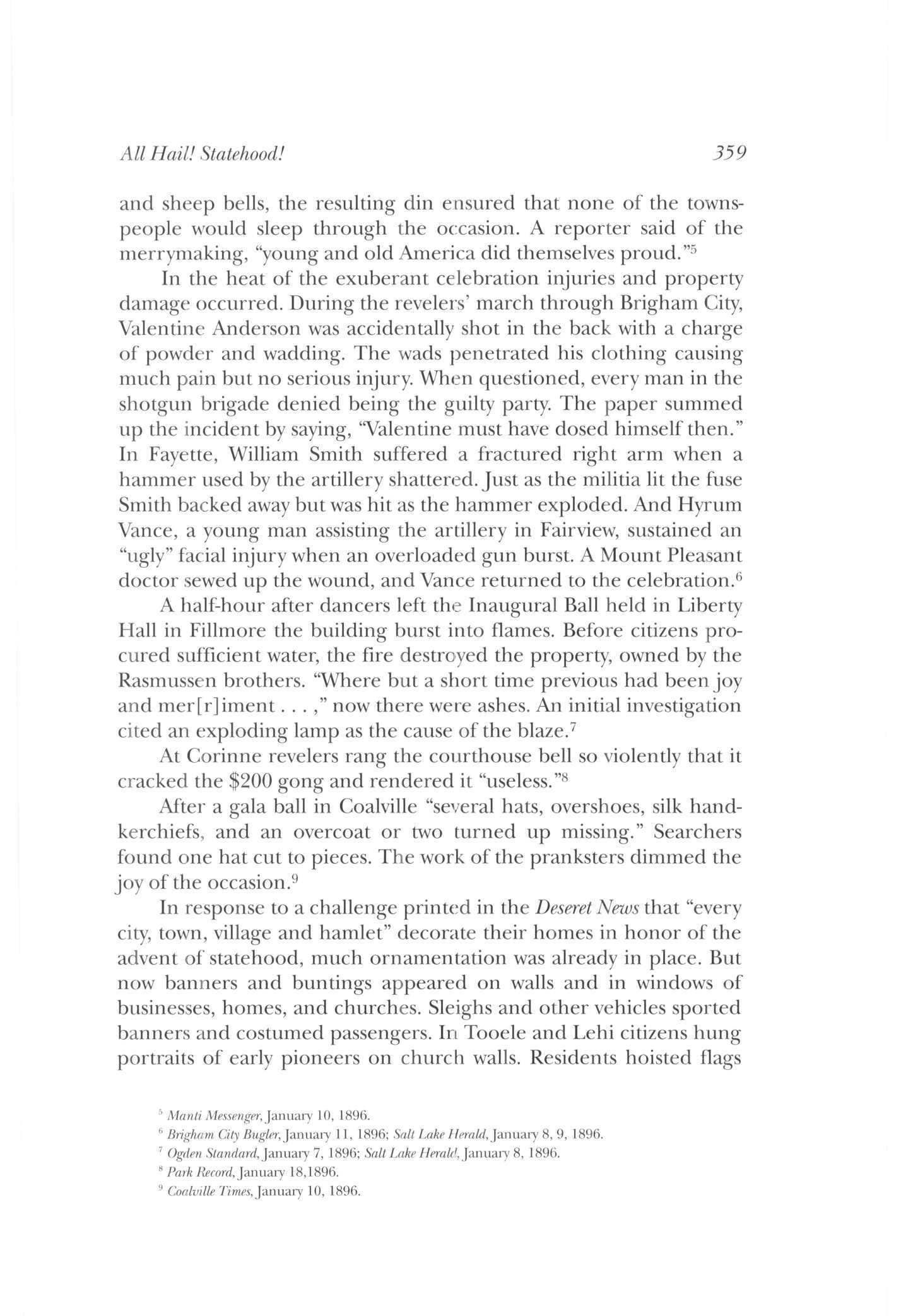
In Fayette, William Smith suffered a fractured right arm when a hammer used by the artillery shattered Just as the militia lit the fuse Smith backed away but was hit as the hammer exploded. And Hyrum Vance, a young man assisting the artillery in Fairview, sustained an "ugly" facial injury when an overloaded gun burst. A Mount Pleasant doctor sewed up the wound, and Vance returned to the celebration.6
A half-hour after dancers left this Inaugural Ball held in Liberty Hall in Fillmore the building burst into flames. Before citizens procured sufficient water, the fire destroyed the property, owned by the Rasmussen brothers. "Where but a short time previous had been joy and mer[r]iment. . . , " now there were ashes. An initial investigation cited an exploding lamp as the cause of the blaze.7
At Corinne revelers rang the courthouse bell so violently that it cracked the $200 gong and rendered it "useless."8
After a gala ball in Coalville "several hats, overshoes, silk handkerchiefs, and an overcoat or two turned up missing." Searchers found one hat cut to pieces. The work of the pranksters dimmed the joy of the occasion.9
In response to a challenge printed in the Deseret News that "every city, town, village and hamlet" decorate their homes in honor of the advent of statehood, much ornamentation was already in place. But now banners and buntings appeared on walls and in windows of businesses, homes, and churches. Sleighs and other vehicles sported banners and costumed passengers. In Tooele and Lehi citizens hung portraits of early pioneers on church walls. Residents hoisted flags
5 Manti Messenger, January 10, 1896
6 Brigham City Bugler, January 11, 1896; Salt Lake Herald, January 8, 9, 1896.
' Ogden Standard, January 7, 1896; Salt Lake Herald, January 8, 1896
8 Park Record, January 18,1896
9 Coalville Times, January 10, 1896
All Hail! Statehood! 359
on poles or strung them across streets Many of the flags were recently made or purchased for the occasion. Two women in Garden City fastened a new flag with forty-five stars sewn by local resident Amanda Pope at one end of the meetinghouse "surmounted by lovely evergreens . . . hauled from the canyon." Over the front of the stage were evergreen wreaths and flowers surrounding a silver star labeled the "Utah Star." At the opposite end of the room back-lighted mottos of "Inaugural DayJan. 6, 1896," "Liberty, Honesty, Free Silver 16 to 1," and "Utah the Gem of the Mountains" shone. Brigham Young's imposing photographic image gazed down at the display. The silver stars featured in many of the decorations had a double meaning Not only did they represent Utah as the forty-fifth star on the flag but also that Utahjoined the Union as a state that stood on the side of free coinage of silver, a question being debated in Washington, D.C, at the time.10
The Honorable A Wooten of Midway decorated his gateway with an arch featuring the Stars and Stripes intermingled with bunting. On his house he hung the biblical words "The Desert Shall Blossom as the Rose."11
A reporter for the Boston Transcript described the bedecked streets of Salt Lake City: ".. I see lavish decorations on its business blocks, flags floating from hundreds of roofs, and one immense flag stretched between the topmost spires of the temple, visible for miles around."12 Many citizens produced another giant flag that formed a false ceiling in the Tabernacle David Glade marked and cut out the pieces that six women sewed on high-powered machines in the ZCMI clothing factory. The youngest seamstress remembered the flag measured 160 feet by 78 feet with the stripes 6 feet in width and the stars 6 feet from tip to tip. They flat-felled all seams to give them strength She said the workers were not told where the flag would hang, but they knew its size prohibited flying it from a pole. Then she saw it draped in the Tabernacle, and, she said, as the air circulated, the flag rippled, bringing tears to her eyes. She thought this largest flag ever made proclaimed, "Proudly I wave over you, home of the brave and land of the free."13
10 Brigham City Bugler, January 4, 1896; Salt Lake Herald, January 10, 1896; Tri-Weekly Journal (Logan), January 14, 1896, Utah
11 Wasatch Wave (Heber City), January 17, 1896
12 Boston Transcript, January 14, 1896; Deseret Evening News, January 4, 1896, also mentions the flag hanging from the temple
13 Reminiscence of Margaret Glade Derrick, April 1956, MS A131, Utah State Historical Society Library, Salt Lake City; Inter-Ocean (Chicago), January 7, 1896 Most newspaper reports exaggerated the
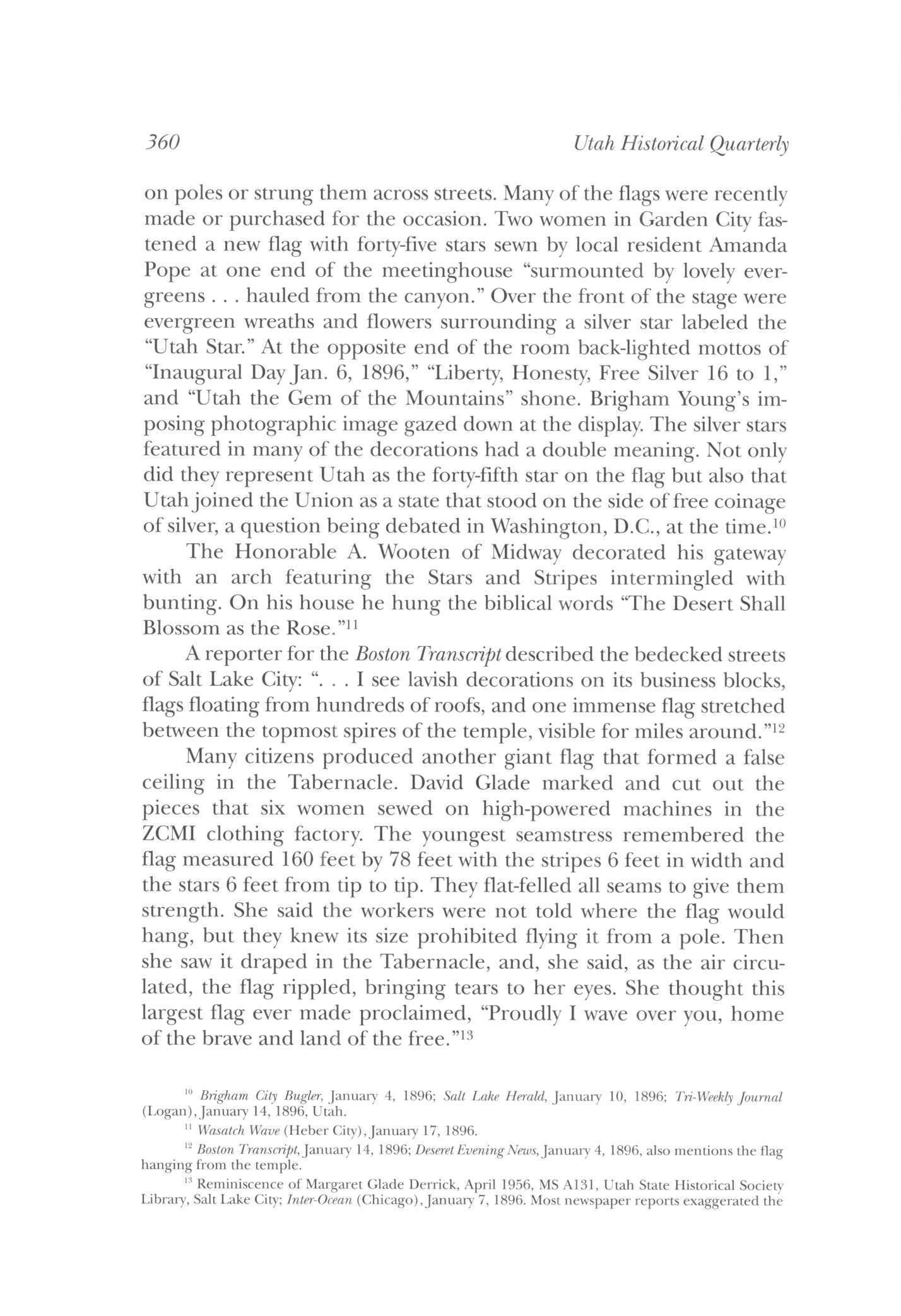
360 Utah Historical Quarterly
P|j|rY^^ SAAA
Creative hands also decorated the LDS stake house in Heber City under the supervision of Mrs O J Call On the west end, behind the rostrum, workers attached an outline of the boundaries of Utah In the center hung a picture of Brigham Young Paper roses spelling out "Utah Queen of the West" filled in the remaining diagram. A very large bell and two smaller ones hung over the auditorium from the ceiling, each covered with artificial roses in red, white, and blue. Bunting, flags, and evergreens completed the decor.14 Salt Lake City businesses competed with each other to get their best decorations in place. Photographer C. R. Savage claimed he first hoisted the Stars and Stripes above his studio. James H. Moyle's office decorators almost obscured their windows with flags. ZCMI placed a "magnificent silver star . . . enshrined with evergreens and backed by the American flag over its door."15
dimensions of the flag somewhat, reporting it to be 175 feet by 75 feet. The flag stayed in the Tabernacle for one and one-half years after which it was placed on the south outside wall of the Temple, completely covering it, in commemoration of the 1897 semicentennial celebration of the pioneers' arrival in Utah

14 Wasatch Wow, January 10, 1896
1' Deseret Evening News, January 4, 1896
All Hail! Statehood! 361 » !l?< , J
II r iiiii El l
Hip' "
Facade of ZCMI decoratedfor statehood celebration, 1896. USHS collections.
All sorts of processions led the new state's populace to Inauguration Day programs In Salt Lake City police and marshals joined the U.S. 16th Infantry in leading groups of bands, government officials, Indian War veterans, fire department personnel, male brotherhoods, German and Scandinavian societies, and a proud unit of the Grand Army of the Republic. In Kamas a line of sleighs pulled by two or four horses was interspersed with cutters carrying a full load of happy passengers, some 400 in number. Nephi, too, had "a grand sleigh ride, a mile long"; twenty-seven ladies representing the then twenty-seven counties of Utah rode in a sleigh at the head of this procession.16 Women also led parades in Coalville and Brigham City as forty-five young women, representing each state with Utah in the forefront, were escorted by local bands.17 Uncle Sam on a burro marshalled Manti's rowdy noisemakers of forty-five gunners under a banner with the inscription, "Utah! One more strong arm for Uncle Sam."18
In Beaver City "the societies vied with each other in their efforts to decorate their vehicles, particularly the W.S.A. [Woman Suffrage Association] and the R.S. [LDS women's Relief Society]." Not to be outdone were the LDS Primary youth organization and the church's Sunday School group. Bands and a bicycle club joined townspeople who marched to the meetinghouse in "a beautiful artistic manner."19
When local authorities failed to organize a civic celebration in Park City, a disgruntled reporter wrote, "Almost every town in Utah has made arrangements to celebrate the admission of Utah to Statehood. Why not Park City?" But 150 youth formed their own parade and marched through the streets of the mining town making "more noise than has been seen or heard here in many a day." Along the way they serenaded the larger business houses and received nuts and confections for their efforts.20
Entrepreneurs and various groups took advantage of the momentous occasion to fatten their coffers The Woman's Exchange in Salt Lake City advertised that those attending the inaugural services at the Tabernacle could procure hot coffee and sandwiches at their
16 Deseret Evening Nexvs, January 4, 1896; Salt Lake Herald, January 10, 1896; Salt Lake Daily Tribune, January 7, 1896
17 Brigham City Bugler, January 4, 1896 The Coalville Tim*., January 10, 1896
18 Manti Messenger, January 10, 1896
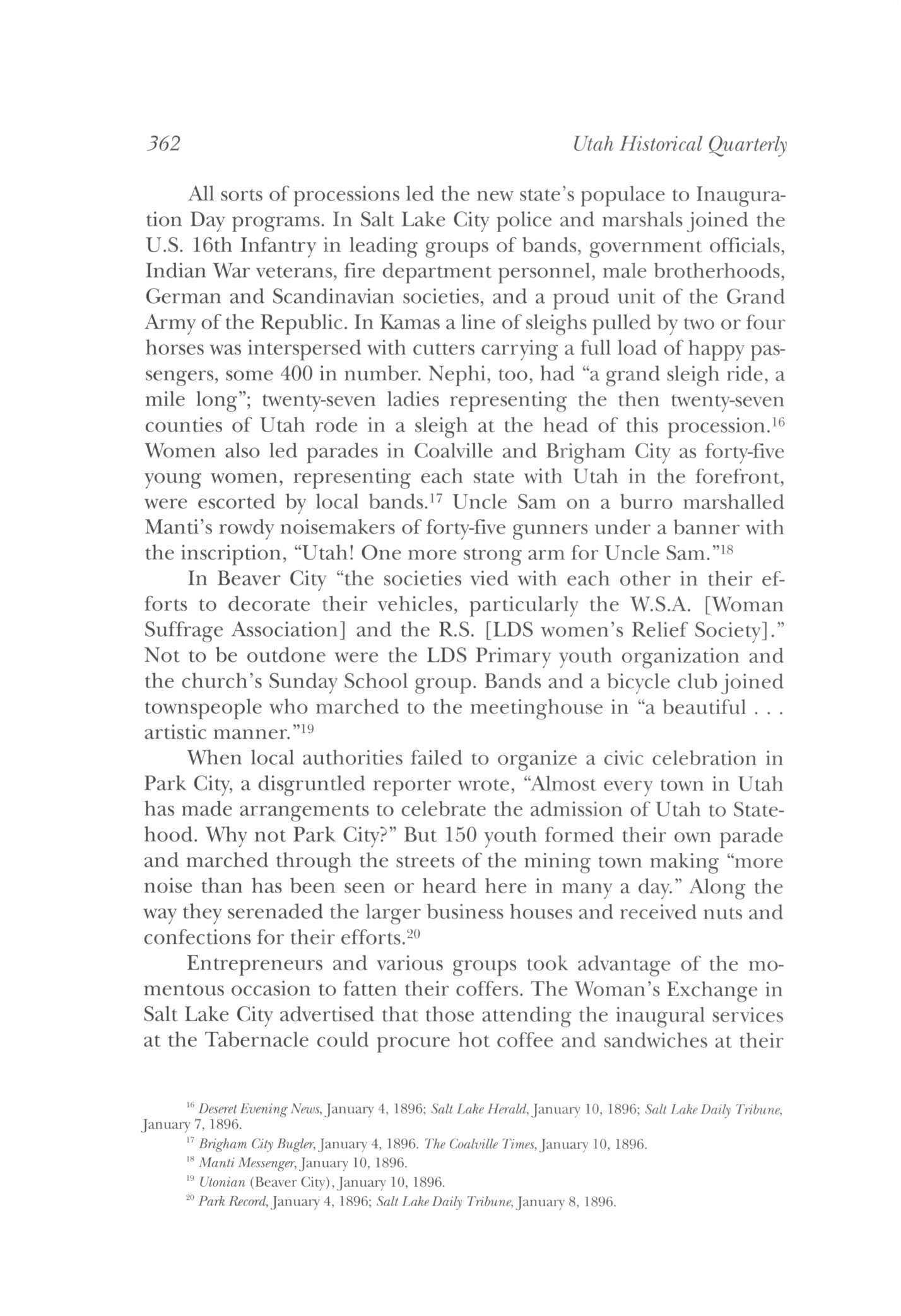
19 Utonian (Beaver City), January 10, 1896
20 Park Record, January 4, 1896; Salt Lake Daily Tribune, January 8, 1896
362 Utah Historical Quarterly
establishment. The Union Pacific offered round-trip tickets from outlying areas to Salt Lake City for one fare on Inauguration Day. Those who attended the great ball in the evening in Manti received a commemorative ribbon with the likeness of Gov. Heber M. Wells and the inscription "State of Utah Inaugural Ball, Manti, January 6th, 1896" on it Another souvenir badge featured an eight-inch blue satin ribbon topped by a "neat little red and white bow" and a photo of a beautiful sailing ship labeled 'Utah" floating "peacefully over the waters in the background." In the foreground, "standing boldly upon the waves was the legend 'Sail on Thou, too, Oh Ship of State.'"21
Those who sponsored a dance held at the Family Theater in Ogden charged gentlemen 25£ each with ladies admitted free. Flags and decorations not created by volunteers also brought income to their makers. An Ogden entrepreneur, S. J. Griffin, advertised in state newspapers his expertise in changing territorial seals to state seals, and an American Fork paper gave personal testimonial of his abilities.22
Always promoting its newspaper with various contests, the Salt Lake Herald announced two competitions. The first offered a prize to the person who guessed closest to this minute and day the time when President Cleveland would sign the statehood proclamation. Nonnie Bond of Ogden came within two minutes of the actual time to win. The paper also offered a sterling silver cup, gold lined with "equitable ratio of 16 parts silver to 1 of gold," to the first boy and girl baby born after 8:03 A.M.,January 4.23
Each town and city featured its own unique approach in commemorating Utah's statehood Programs usually included bands, singers, and speakers in decorated halls and chapels But each program incorporated some specialty that reflected the town's talent pool. A famous Mexican War veteran, Daniel Henrie, spoke in Manti, while Professor R. Maeser addressed the people of Beaver City and gave a "masterful oration." In his speech he used the number seven as his theme. He said officials had applied six times for statehood, but the seventh was the charm. Then he elaborated on the "God-given" number, saying there were seven days in the week,

21 Salt Lake Herald, January 8, 1896; Salt Lake Daily Tribune, January 6, 1896; Manti Messenger, January 10, 1896; Wasatch Wow, January 10,1896
22 Ogden Standard, January 6, 1896; American Fork Item, January 18, 1896
23 Salt Lake Herald, January 7, 1896
All Hail! Statehood! 363
seven colors of the rainbow, seven stars of the pleiades, seven epochs of history, seven wonders of the world, seven ages of man, seven prominent features of the human face, and on and on. He closed by saying what a privilege it was for Utah to join this "grand catalogue of circumstances surrounding this mystic number." On the same program in Beaver, Professor George Woodhouse "fairly out did himself in his rendition of Solos." In an effort towards ecumenism organizers asked leaders of various denominations to offer prayers of invocation and benediction on proceedings.24

The chosen setting of Kamas's program and events showed disregard for the cold weather. The parade of sleighs drew up outdoors in a semicircle to view the proceedings. The male population took advantage of the celebration to pit married men against single men in a game of ball, with the single men victorious. Taking advantage of the sunny winter day, the men of Huntington also played ball on the town square. And children of the Kamas and North Kamas schools were given a free sleigh ride accompanied by the Kamas Brass band.25
Snowville closed its afternoon proceedings with a picnic and coffee. In Ephraim famous Mormon artist C. C. A. Christensen recited an original poem called "The Utah Boys."And Utah composer Evan Stephens's song, "Utah, We Love Thee," written especially for the occasion, highlighted numerous programs Also called "The Inauguration Song," one verse declared,
364 Utah Historical Quarterly
SPECIALLY FOR H ]wiLij_j'_iji)_i J_i3y_to -1 __3 fp_'l if JANUARY , ieee HELD IN THE SALT LAKE TABERNACLE J_lk
Sung by 1,000 Vi Under the Direction of the Author Sheet music in USHS collections.
24 Manti Messenger, January 10, 1896; Utonian (Beaver), January 10, 1896 25 Salt Lake Herald, January 8, 10, 1896; Deseret Evening News, January 13, 1896; Deseret Nexus Weekly, January 25, 1896
Columbia's newest star, Utah, we love thee!
Thy lustre shines afar, Utah, we love thee!
Bright in our banner's blue, Among her sisters true, She proudly comes to view, Utah, we love thee!26
Spirited shouts marked various celebrations. Gunnison residents closed their program with "deafening and prolonged cheers for the new state of Utah." The little hamlet of Portage in northern Utah ended its event with the whole congregation rising to its feet to yell with "full voices" three cheers and "a tiger" while waving handkerchiefs.27
Many programs featured this unusual shout. Most likely the tiger referred to a great growl at the end of the cheers. This exercise energized an unusual program in Clarkston, Utah, marked by the variety of numbers featured. For instance, "everybody and their cousin" met at the meetinghouse where a "spicy" program began with the congregation rising to its collective feet to sing "Utah Is Free." Ten LDS missionaries sang "as they never did before" an unnamed song. The usual speeches were interspersed with a comic song, a guitar duet, and a talk in German translated for the audience by Dr. Almy Jenson. Capt. John Buttars recited "A Utah Boy," followed by a dance presentation where male participants invented forty-five new steps. Committee chairman Joshua Homer treated the audience to his rendition of "West Virginia Hills," sung "with spirit." John Shumway then took the stage with his violin and imitated "Old Bull," accompanied by Hyrum Larson on the organ This surprised the congregation, for no one knew John could play (He had been taking lessons on the sly.) Songs preceded another violin solo by a young lady who was called back for a second number. Two men recited a dialogue entitled, "The Whole Missionary." The program closed with another congregational song, "Utah Is a State," no doubt written for the occasion.28
In contrast, the dullness of Salt Lake City's program caused a critical listener to label the governor's inaugural address as "too 2b Ogden Standard, January 11, 1896; Salt Lake Tribune, January 8, 1896; Tooele Transcript, January 14, 1896 A portion of Stephens's song first appeared in print in

A11 Hail! Statehood! 365
Deseret Evening News, December 21, 1895 27 Salt Lake Herald, January 7, 9, 1896 28 In-Weekly Journal, January 16, 1896.
extremely long. There was enough for four addresses." He reported thatJoseph L. Rawlins, who read President Cleveland's proclamation and presented Governor Wells with the pen used to sign the bill making Utah a state, received more applause than anyone. 29
Every program commemorated the glad news that the new state's constitution granted female citizens suffrage and other equal rights. Governor Wells recognized the attainment by extending "the hand of greeting to the women of Utah, and congratulate [d] them on their entrance into the full enjoyment of civil and political rights." Other celebrations followed his lead In the village of Newton in Cache County, participants shouted three enthusiastic cheers "for the new citizens of the new State, 'The Ladies.'" The Woman's Temperance Association of Parowan called their meeting "an exultation" and presented yellow ribbon badges to a large crowd. At Beaver City, Mrs. M. A. White told the congregation that woman now "must look up, not down, out, not in, for her horizon can but widen when she rises, and enlarge as she moves onward." Composer J. H. Ward's designation of Utah as "The Queen of the West" was echoed in White's speech She said, "Women will be an important factor in sustaining, maintaining, politically, religiously, socially, morally, intellectually and progressively our proud position—Queen of the west."30
Female speakers touched on such subjects as "The Women of Utah," "Woman's Part in the New State," and "Women Who Won't Vote." One such talk closed with, "Hurrah for the new woman!" In Logan the ladies of the local Relief Society thronged to the front of the room to offer their services, "for with the dawn of Statehood upon Utah the political shackles were stricken from the hands ofwoman... ."
31 Celebrants at the inaugural program in Huntsville combined marking statehood and women's suffrage with the opening of a new Relief Society hall. The two-story brick edifice, financed by the females of the community, provided a place of their own to conduct meetings and work on projects The "sisters" of the organization served dinner to those in attendance and recognized the monetary contributions of even young children to the building enterprise. Women spoke and performed on the program following the dinner.
29 Andrew Lund Larson, Journal, January 6, 1896, LDS Church Library-Archives, Salt Lake City
32
30 Boston Transcript, January 14,1896; Logan 1^ri-WeeklyJournal, January 11, 1896; "Sixty Years Ago," Relief Society Magazine 43, (January 1956), p 30; Utonian (Beaver), January 17, 1896

31 Manti Messenger, January 10, 1896; Logan Tri-WeeklyJournal, January 7, 1896
32 Woman's Exponent (Salt Lake City), February 1, 1896
366 Utah Historical Quarterly
Individuals expressed their excitement about becoming part of the Union in a variety of ways.Journalist C. C. Goodwin of the Salt Lake Tribune, upon hearing the announcement, ordered a senatorial toga. Two youngsters in Smithfield, Leona and Jim Cantwell, sat on their porch laughing and "having a good time" as they wrote words to a song for the occasion to the tune of "Ta, Rah, Rah, Boom-de-aye." Jim sang it at the community celebration program. AVernal reporter said, "Everybody looked as pleased as they would if they had found two bits." Heber veterans and boys shook each other's hands upon meeting and with smiles on their faces inquired how they felt about being citizens in the sisterhood of states While in Fairview, "Old men, whose lives had been worn out in subduing . . . the barren wastes . . . and old women animated with pride at the thought that their sons and daughters might now enjoy the liberty and freedom for which they had toiled so long" congratulated each other on being spared to "behold this auspicious day." In Parowan a group of young men gathered in front of the co-op store and seized every old settler who passed by, hoisted him upon "an eminence," and demanded a short speech. As each one concluded, they gave him three cheers, lifted him down, and let him go. FrankJ. Cannon sent a telegram from Washington to LDS President Wilford Woodruff that said, "The land where you planted the flag is now a state of the sublime republic. May its career be magnificent."33
Journalists waxed eloquent in recounting events A Provo paper chronicled the feeling of unity statehood brought: "Yesterday there were no Dems. no Pops., no Welch [sic], no Scotch, no English, but all americans [sic] and all rejoicing in the precious boon of statehood."34
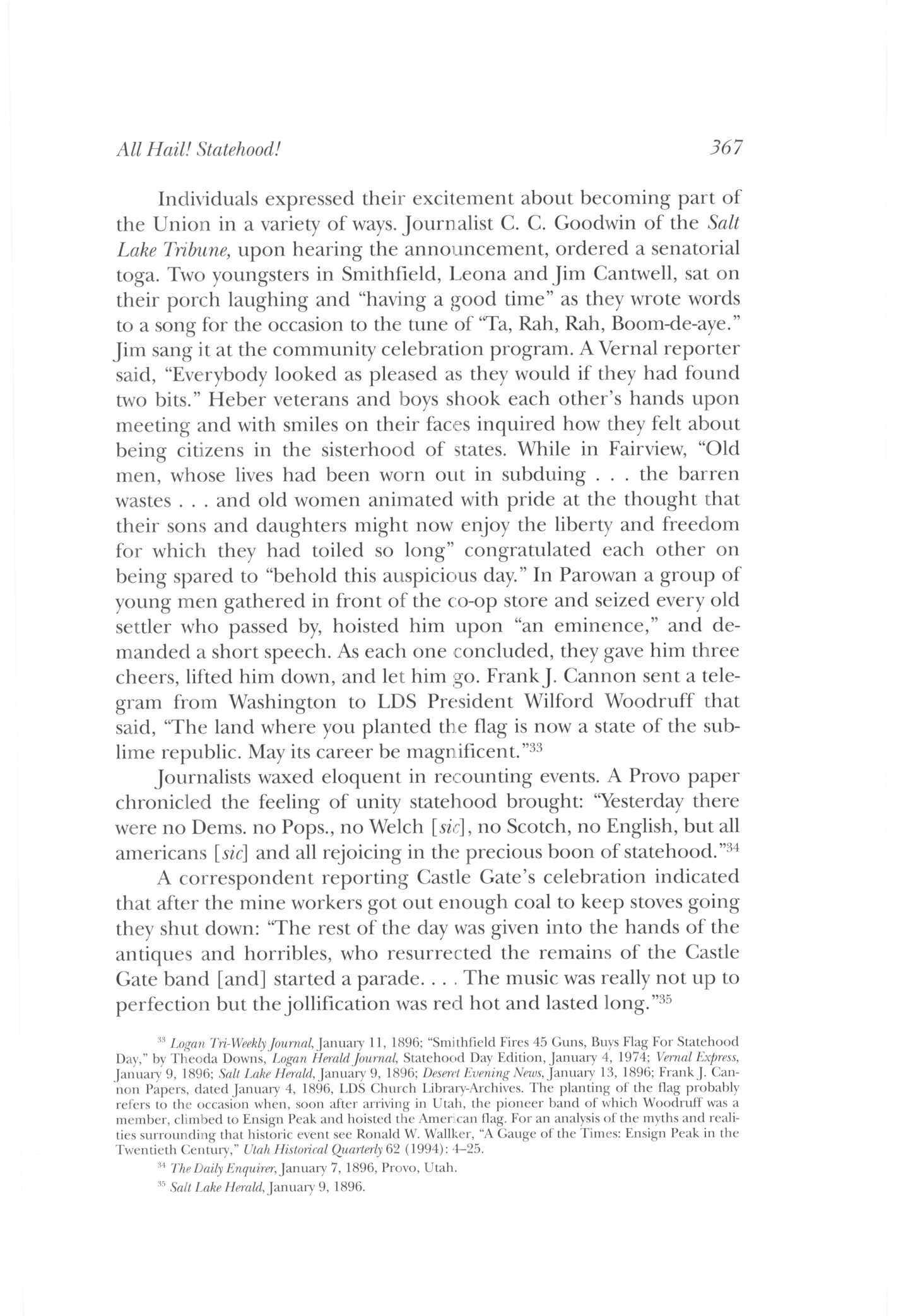
A correspondent reporting Castle Gate's celebration indicated that after the mine workers got out enough coal to keep stoves going they shut down: "The rest of the day was given into the hands of the antiques and horribles, who resurrected the remains of the Castle Gate band [and] started a parade. . . . The music was really not up to perfection but thejollification was red hot and lasted long."35
33 Logan Tri-WeeklyJournal, January 11, 1896; "Smithfield Fires 45 Guns, Buys Flag For Statehood Day," by Theoda Downs, Logan HeraldJournal, Statehood Day Edition, January 4, 1974; Vernal Express, January 9, 1896; Salt Lake Herald, January 9, 1896; Deseret Evening News, January 13, 1896; Frank J Cannon Papers, dated January 4, 1896, LDS Church Library-Archives The planting of the flag probably refers to the occasion when, soon after arriving in Utah, the pioneer band of which Woodruff was a member, climbed to Ensign Peak and hoisted the Amer can flag. For an analysis of the myths and realities surrounding that historic event see Ronald W Wallker, "A Gauge of the Times: Ensign Peak in the Twentieth Century," Utah Historical Quarterly 62 (1994): •1—25
34 The Daily Enquirer, January 7, 1896, Provo, Utah
35 Salt Lake Herald, January 9, 1896
A11 Hail! Statehood! 367
A report from Spring City said events culminated with everybody rejoicing "that the time of wandering in the wilderness is at an end and that we have at last entered the promised land." The Snowville correspondent on the Utah-Idaho border reported, "Everything and everybody, even to the babies, smiled and rejoiced and everything went 'Merry as a bell.'" And an eastern newsman enthused, "Utah is as happy as a boy with a new pair of red-topped boots."36
Diarists also expressed their joy as they chronicled the day's events. Andrew Lund Larson wrote, "The glorious boon we have so long looked for, has at last come. I have been born and reared in these United States and yet never had all the rights of a free born American citizen. God willing I shall now have that privelage in its full sense." George Goddard closed his entry with, ". . . it was a grand affair and the festivities of the day will never be forgotten by those who witnessed them."37
But some individuals were not caught up in the fervor and resisted the urge to mark the occasion because of personal feelings or responsibilities. Jane Hooper Wilkie Blood noted the Salt Lake City festivities and then wrote regarding statehood, "As far as I am concerned I did not want it, but I know God overrules all things."
George Kirkham's work for "the sugar company" prevented him from celebrating And caring for her ill daughter, Effie, interfered with Mary L. Morris's participation. "... I could not feel justified in leaving my patient though she is up and doing a little sewing," she wrote. However, accounts of participation indicate these feelings were in the minority.38
When the gunshots diminished, the music faded away, and the people returned to their homes, reflections upon what the occasion really meant in their lives probably echoed a paragraph written by a Utah correspondent for the Boston Transcript.
Such days as today are of incalculable value to this community
The object lesson taught to the growing boys and girls will never be forgotten—the object lesson of universal rejoicing over the attainment of a right; in other words, the object lesson of true American spirit.39
3b Salt Lake Herald, January 7, 1896; Brigham City Bugler, January 18, 1896; Peoria (Illinois) Journal, January 9, 1896
37 Larson Journal, Saturday, January 4, 1896; George Goddard, Journal, Monday, January 6, 1896
38 Jane Hooper Wilkie Blood Autobiography and Abridged Diary, Ivy Hooper Blood Hill, ed. (Logan, Ut., 1966), p 125; George Kirkham, Journal, LDS Church Library-Archives; Mary L Morris, Journal, January 6, 1896, microfilm, Utah State Historical Society Library, Salt Lake City
39 Transcript, January 14, 1896

368 Utah Historical Quarterly
As the day drew to a close and night fell, in response to Governor Wells's request, candles and lanterns appeared in windows and businesses to make a "blaze of light" showing that "patriotic Americans" lived and worked in these edifices. The lights also symbolized that Utah citizens had emerged from the "darkness of Territorial conditions to the full light of 'Statehood.'"40
A Richfield reporter wrote that "what Utah desires is Americanism, pure and simple; . . . she desires tranquility, union, prosperity for all the people." But with the attainment of that right, reality set in. It meant new responsibilities as American citizens. It meant, as a Salt Lake Herald reporter wrote, that while change was not presently visible, "if they waited till Oct. 31 when the assessor made the rounds they would see and know where the change comes." Still, most Utahns were grateful for the advantages of being numbered as fullfledged citizens of the United States and carried in their minds the enthusiastic cheer of commemoration, "All Hail Statehood!"41
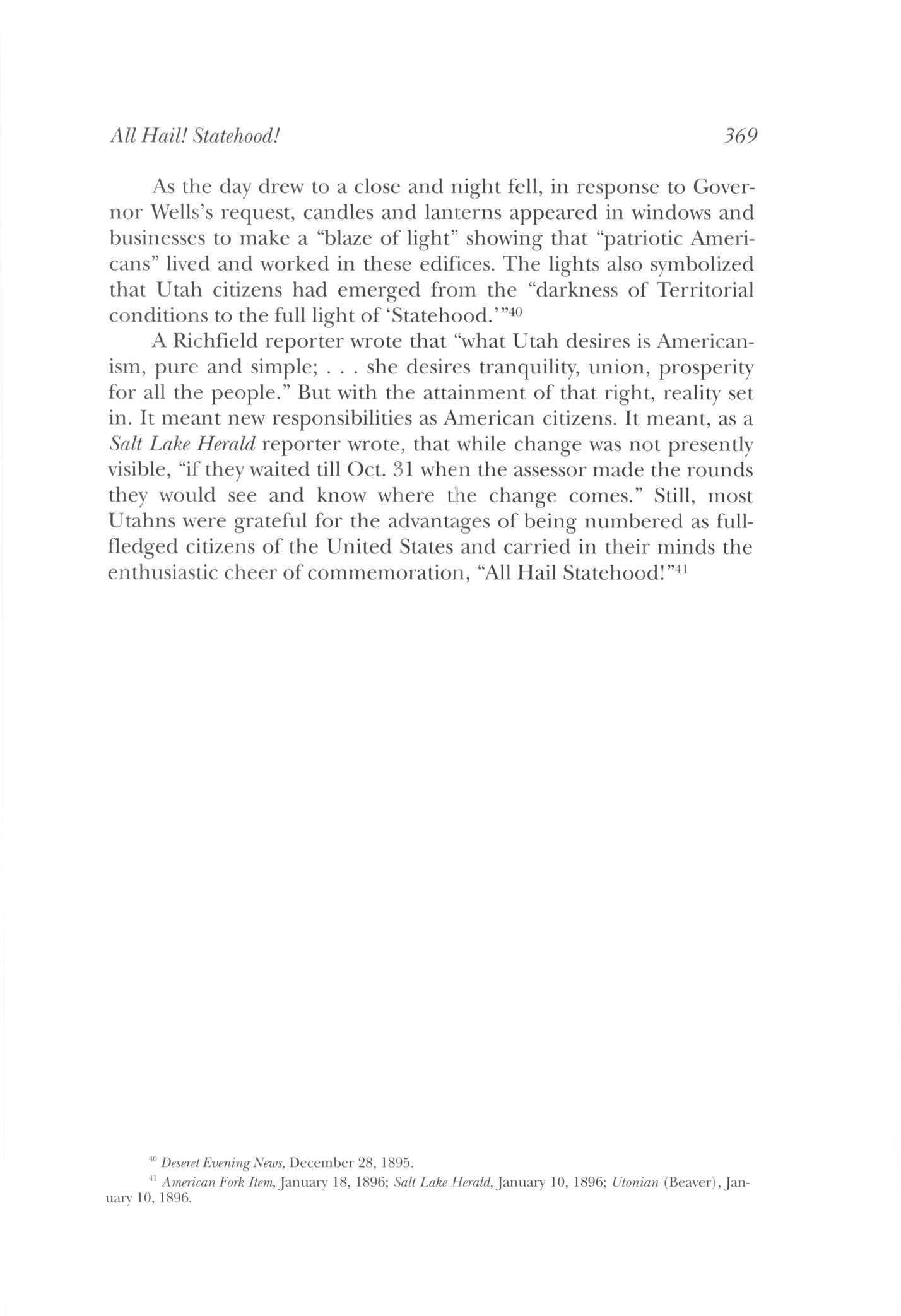
All Hail! Statehood! 369
40 Deseret Evening News, December 28, 1895 41 American Fork Item, January 18, 1896; Salt Lake Herald, January 10, 1896; Utonian (Beaver), January 10, 1896
In Memoriam: C. Gregory Crampton, 1911-95
CHARLES GREGORY CRAMPTON, UTAH STATE HISTORICAL SOCIETY FELLOW7 and distinguished contributor to Utah history, died May 2, 1995, at his home in St. George. Extending over four decades of the most exciting times in Utah and western history, his career earned him wide acclaim as a professor, writer, editor, and researcher. He was born March 22, 1911, in Kankakee, Illinois, and raised and educated in California. He married Helen Mickelsen, who died inJanuary 1977, and had two daughters, Patricia and Juanita, who survive him, and
 C. Gregory Crampton. USHS collections.
C. Gregory Crampton. USHS collections.
married Mary-Helen (Maria) Patrick in 1978 who continues to live in St George
Crampton earned his doctorate in 1941 at the University of California at Berkeley In 1941 and again in 1948 he won Rockefeller Foundation grants for travel and study in Latin America. After wartime stints with the FBI and as a military historian, he joined the University of Utah history faculty in 1945 where he remained until his retirement in 1979. At the U of U he specialized in western American history, Canyonlands, and Latin America. He directed the work of numerous Ph.D. and masters candidates and helped found and edit The American West in 1963 which immediately attracted more than 30,000 subscribers. Between 1956 and 1964 Crampton headed the historical salvage survey that preceded construction of the Glen Canyon Dam, an assignment "that became his life's work." From 1966 to 1972 he directed the U of U's Doris Duke Program in Indian Oral History, focusing on Utah and Four Corners' Native Americans, and coordinated the Doris Duke Program at seven additional universities Pie wrote and co-authored fourteen books, several of which are now considered classics, and published dozens of articles, many of them in Utah Historical Quarterly. He was a visiting professor at numerous institutions in the United States and abroad and was often honored, including election as president of the national honorary society for history, Phi Alpha Theta He received the Cowboy Hall of Fame's Western Heritage Award in 1964 for Standing Up Country and the American Association for State and Local History's sought-after Award of Merit. For scholarly research and pointing new ways to see Utah history he was designated a Historical Society Fellow in 1963, the seventh of twenty-one persons to be so honored
To members of the Historical Society, as to his many students and professional associates, Gregory Crampton was known for his intellectual acuteness and integrity, for his responsiveness to beauty, his appreciation for the West and its environment, and his concern for human welfare He was a gentleman in the full sense of the term, quick in his sympathies and compassionate in hisjudgments. Unfailingly gracious, he practiced instinctively the little amenities that give life its charm and friendship its lasting pleasures. He liked the play of ideas and was master of the well-turned phrase and the flash of wit He joined those who searched for man's place in the world He gave himself not to abstract principles but to defining a place of unequalled beauty and to publicizing the role of peoples too long
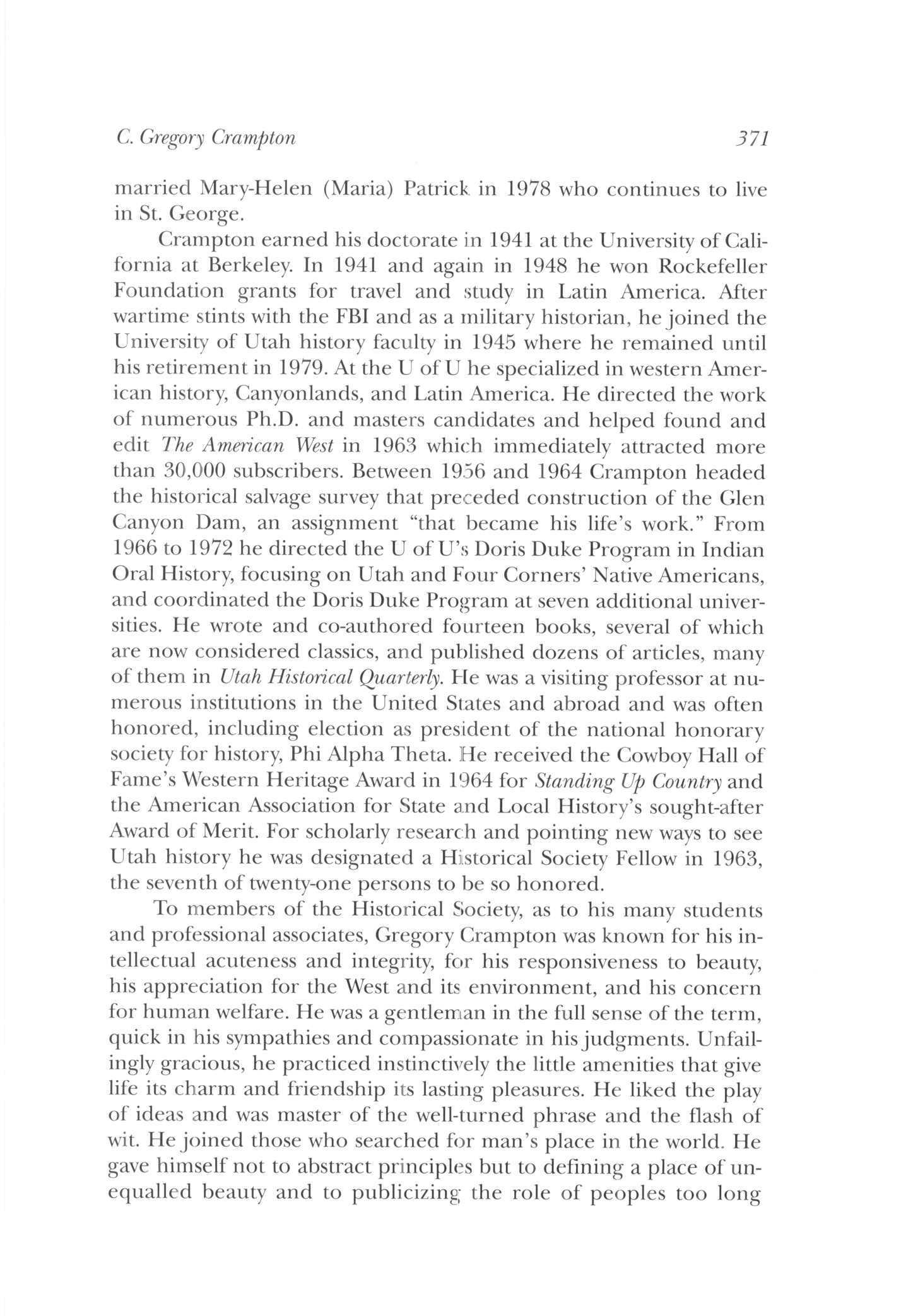
C.
Crampton 371
Gregory
ignored He knew, too, that a good illustration is worth a thousand words and that good taste is the mother of felicitous expression
After retirement Crampton continued to write and publish, appearing often as a lecturer, most recently on March 7, 1995, when with co-author Steven K. Madsen (In Search of the Spanish Trail: Santa Fe to Los Angeles, 1829-1848, 1994) he delivered the annual Juanita Brooks lecture at Dixie College.
Crampton was a product of the University of California's history department when it was at its best. His masters were titans in the expanding field of western history. Included among them was Herbert Eugene Bolton, whose advocacy of the Spanish Borderlands, archival research, field work, and sense for the Canyonlands as the ultimate barrier all came with Crampton as he made Utah his home. The decades after 1945 were a time of achievement and promise for state history in Utah. Holdovers from the Progressive Era, including William J. Snow, Leland Creer, Andrew Love Neff, and Joel Ricks, had introduced new standards of historical objectivity and enjoyed enviable esteem in the Historical Society and throughout the state. Liberals Fawn Brodie and Bernard DeVoto were national figures in their own right and began to make Utah places and names household properties throughout the country Younger scholars delighted the state with their work and teaching Many, like Crampton, carried the UC Berkeley brand—LeRoy Hafen, Dello Dayton, Brigham Madsen, George Ellsworth, Everett Cooley—to name a few. With giant hands fairly trembling as he communicated the excitement of the Utah story was USC product and erstwhile Uinta Basin teacher, David Miller. Breaking on the scene with mustache at attention was UCLA Ph.D. Russell Mortensen who professionalized the Historical Society and itsjournal, and with his successor Everett Cooley established the State Archives and introduced the Fellow award at the Society. Demanding national attention were Thomas O'Dea, Donald Mienig, William Mulder, andJuanita Brooks.
Especially noteworthy in terms of the contribution Crampton was beginning to make were Historical Society Fellows Dale Morgan and Wallace Stegner. Morgan directed the editing of the Powell Expeditionjournals as the complete 1948 and 1949volumes of Utah Historical Quarterly and helped negotiate with Crampton's mentor H. E. Bolton for a new translation of the EscalanteJournal, Pageant in the Wilderness, as the 1950 volume of UHQ Wallace Stegner's prize-winning and
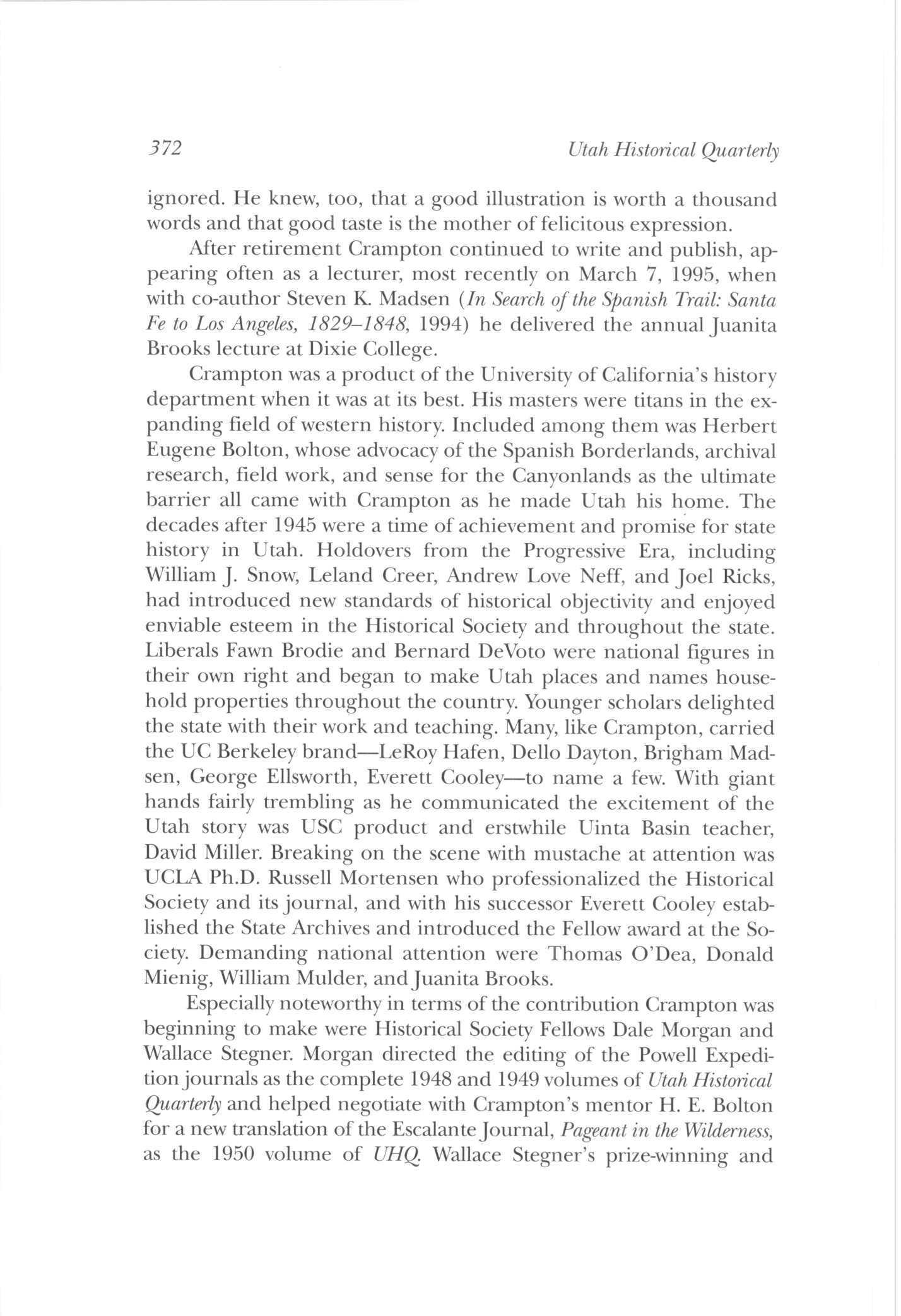
312 Utah Historical Quarterly
mind-catching Beyond the Hundredth Meridian:John Wesley Powell and the Second Opening of the West had the nation in its grip by 1956. Obviously the door to Canyonlands study was open to the Society's Fellows. Invited by a National Park historic survey contract in 1956, Crampton followed the canyons far beyond the greats with whom Morgan and Stegner worked, into the lives and material culture of a thousand aspiring sojourners. For nearly a decade's worth of summers he photographed, measured, and recorded his way through the blistering corridors and antechambers. By 1965, when he was through, he knew the canyons as no one else did. In the years that followed he continued to work in the surrounding hinterlands until all of Standing-Up Country was mastered. In all, six University of Utah archaeological bulletins and other major studies pounded from his typewriter along with eight or ten Standing-Up Country related books. With superb photographs, careful measurement, on-site research, beautiful writing, and objective interpretation he built on the work of Morgan and Stegner, preparing a sound base for popularizers, environmentalists, and color country regionalists who would work the Standing-Up Country later.
The Society had other Fellows who gave new dimension to Utah history. One's hat is off to Leonard Arrington, toJuanita Brooks, to Helen Papanikolas, to George Ellsworth, and, indeed, to the rest of the Society's Fellows. But few came with sounder preparation than Gregory Crampton or pointed to more spectacular new ways to see state history Bon voyage, historian of the Canyonlands Here's to new understanding and the best of history as we work the canyons of the future.
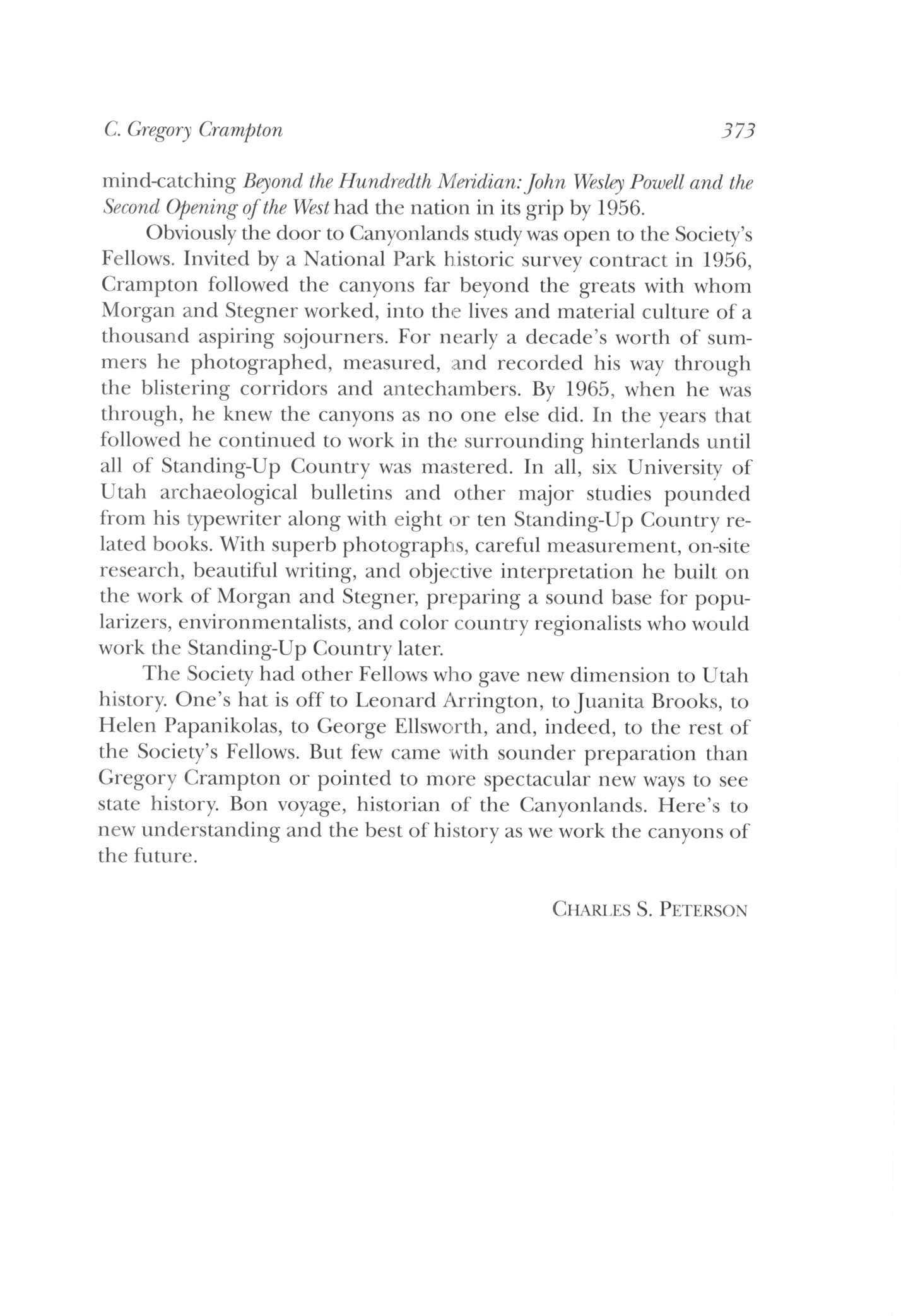
C. Gregory Crampton 373
CHARLES S. PETERSON
The title should have read, "Utah, a Mostly Canyonlands Visual Celebration." It has nothing at all to do with the places or people of Utah's statehood centennial But then, little coming out of Utah's Centennial Commission does. This book's photographs are about one fourth Arches-Canyonlands-Moab vicinity and a full twothirds are from the Canyonlands subsection of the Colorado Plateau.
I was looking forward to seeing this book. It may not be representative of Till's best work There are a few really fine images (like p. 140, "Falls along the Fremont River"), but most, approximately 65 to 70 of the 104, I would rate good to average views that any competent and persistent photographer could have produced. Few have a visual signature look All of the (five or so) aerial views are as fine as any in print, but many views seem to have been pulled from stock files, and perhaps the best versions were out to other publications Disappointing
Are you over forty? The publishers and designers don't care. The text type is small, the font not easily readable, and the leading extreme. The captions, all italics, are even worse

Perhaps they went for a fashionable look. The captions, generally bland, uninformative, and non-specific are still error prone. A few examples: does "Naturalist's Basin" conform to USGS toponyms? Or "Pariah River." The "Old Railroad Station in Thistle" was
not one, and their "penstemmon" appears to be a lupine variety The "oasis surrounded by a fearsome desert" myth repeats. The settlement corridor remains a semi-arid steppe, a piedmont oasis nurtured by anomalous mountain and plateau precipitation
A quick comparison with the Muench/Wixom Utah volume of 1973 is a little uncomfortable. Is the similarity of subjects and scenes accidental or is this a copycat of a fine old coffee table volume? Westcliffe's Singapore printing is superior, but scanner access was not universal in 1972 either. Of the two books, I prefer Muench's but cannot blame Till Perhaps the editors got to him Another superior book is Blessed by Light: Visions of the Colorado Plateau edited by superb photographer Stephen Trimble and published by Peregrine Smith in 1986.
Williams's text is readable. It has a clarity that illumines There is little of it The "chapters" are more like brief letters to a close friend You can relate to his perspective when he deals with universals, and he cares about the country about which he writes Till positions with patience in great places in all weather and awaits revealing light. Actually, both author and photographer have a passion for their places and their interpretations. This is the book's great redemptive value
There is little enough passion expressed for place anymore As poorly put together, as disjunctive as it is—
Utah: A Centennial Celebration. Photographs by TOM TILL and text by BROOKE WILLIAMS. (Englewood, Colo.: Westcliffe Publishers, 1995. 144 pp. $45.00.)
the words and images, the passion, can come through and touch your spirit
"This Is the Right Place" is a brief essay on the Anglo-Mormon coming into the country, Utah. "The Most Perfect Kiva" is an emotive expression of the link between the canyon ruins and the author's feelings on the death of his mother. Brief, beautiful, but a few well chosen illustrations would have enhanced A mentality is mentioned that I had always associated with many hiking guidebooks, but in a way picture books like this can be a way of "collecting magic places." Some books seem hell bent on "collecting," bagging like a trophy buck (or making one) and then moving on This photographer and author seem to be driven by other motives. "A Past and Present Lake" thinly sketches the relationship between weather and climate, mountains and snowfall, Lake Bonneville and Great Salt Lake and man. "As it Has Always Been" is a view through juniper berries and a remote mesa top to sensitivity to place and our use and abuse of it The points are well made and taken, but I am always uneasy with the hard-edged environmentalist view that all mining and ranching land uses are inherently bad Makes me wonder where the metals and materials and food come from for those backpack outfits and the machines they drive to wilderness
in. "The Middle of Gravity" is about "the earths's magnet...feeling the firm and smooth pull of old, old rocks." A little light geology through a Westwater Canyon river run that atypically includes both author and photographer! "The Future of Experience" juxtaposes the Springdale IMAX theater and the reality of Zion Canyon's West Rim Trail Which is counterfeit? It's difficult for some folks to tell these days The afterword, "A Spirit Refreshed," is a note by the photographer on his work, on the joy of discovery
The foreword is a bit glowing, as you might expect from the author's wife It cites Walter Cottam's classic 1947 lecture "Is Utah Sahara Bound?" Are we mining our limited semi-arid land resources or managing them with enough foresight? Change and the information highway can yield good results while we nevertheless lose our souls, she says "I believe our path toward the future is as it has always been—a people in place with a commitment to community. Staying put. Slowing down. Listening. Learning the names of things:...We must learn the names of our neighbors." She set the stage better than the book's title. And indeed, centennials are a good time to reflect.
 GARY PETERSON Mapleton, Utah
GARY PETERSON Mapleton, Utah
Utah's Audacious Stockman: Charlie Redd. By LEONARDJ. ARRINGTON. (Logan and Provo: LTtah State University Press and the Charles Redd Center for Western Studies, 1995. xiv + 282 pp. Paper, $19.95.)
Leonard Arrington, Utah's premier western historian, former LDS church historian, recipient of the first Charles Redd Award in the Humanities and Social Sciences, selected as
the first Lemuel Hardison Redd, Jr., Chair of Western History, and the founding director of the Charles Redd Center for Western Studies at Brigham Young University, was
Book Reviews and Notices 375
tapped by the family of Charles Redd to write a biography of Charlie's life Arrington acquits this request very well, describing briefly the immediate ancestry of Charlie before launching a lively recap of his childhood in Bluff, his BYU years, his church mission to the Northwest, the tenuous and troubled beginnings of his livestock empire, his years in the legislature, his family life after manying Annaley Naegle, his major struggles to pay off his father's debts while coping with a depression and drought-ridden stock business, and the affluence and international recognition that came before his death at almost eighty-six years of age.
Writing a sensitive, perceptive biography of Charlie Redd was no simple task. Achieving balance and evenhanded objectivity often is problematical in a commissioned history, and the difficulty in even attempting to come to grips with someone as complicated and controversial as Charlie Redd would tax the abilities of even such a great scholar as Professor Arrington However, from the outset, his task was made simpler by the fact that the family requested that Charlie be depicted in his true light. The result is this work that depicts a very believable Charlie Redd, flushed with ambition, alive with an awareness of opportunities that few others see, and driven by a love for the stockman's industry and for the chance to live in that stark, wild, awesome beauty of southeastern Utah and southwestern Colorado
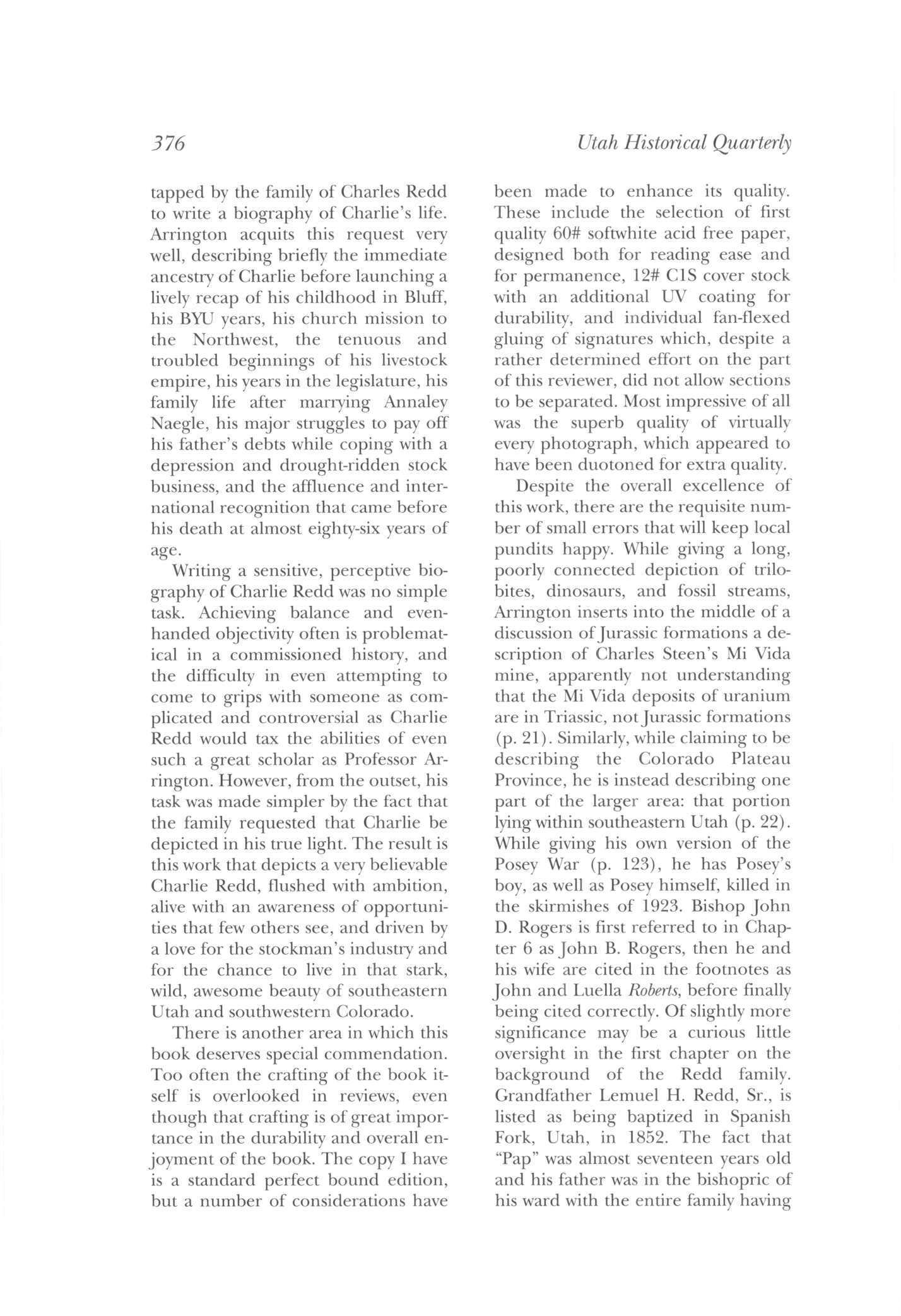
There is another area in which this book deserves special commendation Too often the crafting of the book itself is overlooked in reviews, even though that crafting is of great importance in the durability and overall enjoyment of the book The copy I have is a standard perfect bound edition, but a number of considerations have
been made to enhance its quality. These include the selection of first quality 60# softwhite acid free paper, designed both for reading ease and for permanence, 12# CIS cover stock with an additional UV coating for durability, and individual fan-flexed gluing of signatures which, despite a rather determined effort on the part of this reviewer, did not allow sections to be separated Most impressive of all was the superb quality of virtually every photograph, which appeared to have been duotoned for extra quality. Despite the overall excellence of this work, there are the requisite number of small errors that will keep local pundits happy. While giving a long, poorly connected depiction of trilobites, dinosaurs, and fossil streams, Arrington inserts into the middle of a discussion of Jurassic formations a description of Charles Steen's Mi Vida mine, apparently not understanding that the Mi Vida deposits of uranium are in Triassic, notJurassic formations (p 21) Similarly, while claiming to be describing the Colorado Plateau Province, he is instead describing one part of the larger area: that portion lying within southeastern Utah (p. 22). While giving his own version of the Posey War (p 123), he has Posey's boy, as well as Posey himself, killed in the skirmishes of 1923. Bishop John D. Rogers is first referred to in Chapter 6 as John B Rogers, then he and his wife are cited in the footnotes as John and Luella Roberts, before finally being cited correctly. Of slightly more significance may be a curious little oversight in the first chapter on the background of the Redd family Grandfather Lemuel H Redd, Sr., is listed as being baptized in Spanish Fork, Utah, in 1852. The fact that "Pap" was almost seventeen years old and his father was in the bishopric of his ward with the entire family having
376 Utah Historical Quarterly
been integrated into the church for almost ten years, makes this 1852 baptism look much more like one of the rebaptisms that were so much a part of Reformation Utah life, or that were conducted at times for the purpose of healing in at least some rural areas of Utah. While it is conceivable that Lemuel truly never had been baptized despite his father's prominence and his own manifestations of commitment, the prevalence of rebaptism should have occasioned some explanation on the part of Arrington, who is far too sophisticated in the nuances of early Utah life not to have understood this Could it be that in this pre-
liminary portion of the book he fell prey to that great good fortune of Utah scholars who are provided by their institutions with fine young research assistants to do basic research?
All of these minor gaffs are minuscule compared to the quality of the overall work performed by Arrington in this book Thanks to his skill and individual effort we have a valuable insight into the life of perhaps the bestknown person to have come from southeastern Utah
GARY L SHUMWAY California State University Fullerton
Across the West: Human Population Movement and the Expansion of the Numa. Edited by DAVID B. MADSEN and DAVID RHODE (Salt; Lake City: University of Utah Press, 1994. xii + 255 pp. $50.00.)
Throughout history, population migration has been a major impetus of cultural change. One of the most important population movements in the Great Basin was the spread of Numic-speaking (Numa) populations
The Numa refers to the indigenous populations that occupy the Great Basin and adjacent areas who speak one of a related group of Numic languages Both archaeological and linguistic studies indicate that the Numa only recently spread across the Great Basin. The most influential of these studies was Sydney Lamb's (1958) reconstruction of Numic expansions based on the, then, emerging field of glottochronology. Lamb argued that this expansion began about A.D. 1000 from a point somewhere in the southwestern part of the Great Basin, possibly Death Valley Since that time there has been widespread agreement among scholars that a Numic migration did occur. Although newer mod-
els of population expansion have emerged, many details remain highly contentious, especially the timing of this phenomenon and homeland of the Numa. Particularly important yet unresolved questions concern how these populations spread over such a wide area and what became of the indigenous populations these immigrants encountered.
This volume is a collection of papers by some of the West's experts on Numic history In May 1992 a roundtable panel supported by Desert Research Institute of the University of Nevada, Reno, and the Nevada Bureau of Land Management met to discuss current issues on the Numic debate The purpose of these talks and the resulting volume was to synthesize the existing understanding of Numic history and to identify points of widespread consensus and areas of future study The book contains twentyfour papers covering a diverse array of

Book Reviews and Notices 377
issues conveniently organized into three sections: Background, Theoretical and Methodological Issues, and Regional Perspectives
The first section contains selections that uniformly give an excellent synthesis of the history of thought on Numa migration (Mark Sutton and David Rhode), limitations of glottochronology (Donald Grayson), and myths surrounding the Numic expansion (David Madsen).
Most selections in the second section examine different models developed to explain how and why the Numic expansion occurred A consistent and unifying theme is the need for developing ways in which different models can be tested in the archaeological record. Noteworthy among these efforts is a discussion of cultural mechanisms (e.g., warfare, trade, etc.) as catalysts of migration by Martha Knack and Steven Simms who clarify different kinds of population movements The last few selections examine the relationship between the Numic ethnicity and artifact styles Most notable are Catherine Fowler's discussion of continuity and change in artifact categories from different parts of the Great Basin and David
Rhode's fresh approach to the Numic expansion by directly dating brown ware ceramics James Adovasio and David Pedler rehash the evidence for basketry as an ethnic marker.
The regional perspectives section describes Numic history in different parts of the Great Basin and underscores the complexity and difficulty in interpreting it The strongest selections here are by Robert Elston and Christopher Raven who question the ability to distinguish population migration from in situ developments (a point echoed by other contributors)
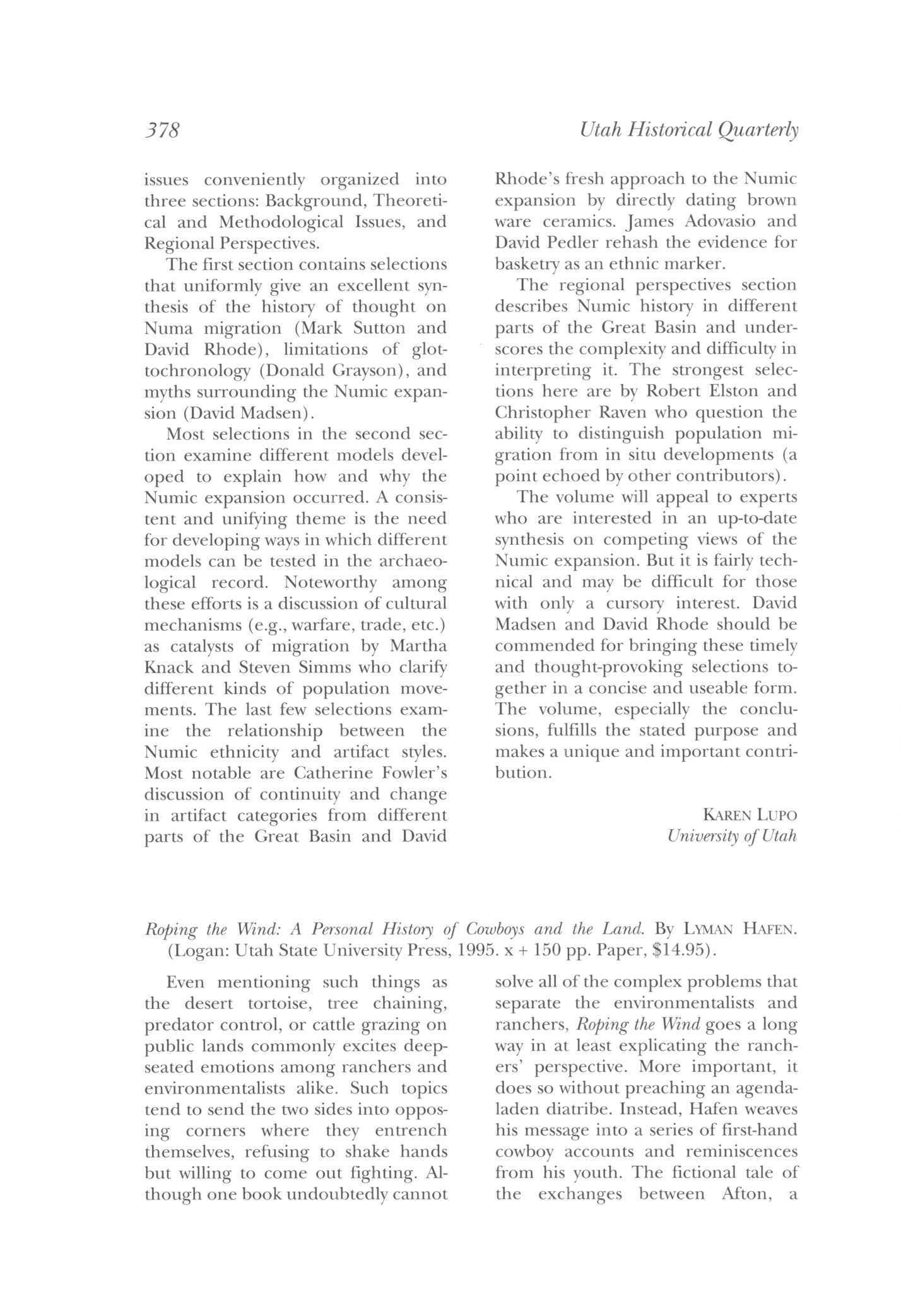
The volume will appeal to experts who are interested in an up-to-date synthesis on competing views of the Numic expansion But it is fairly technical and may be difficult for those with only a cursory interest David Madsen and David Rhode should be commended for bringing these timely and thought-provoking selections together in a concise and useable form. The volume, especially the conclusions, fulfills the stated purpose and makes a unique and important contribution.
KAREN LUPO University of Utah
Roping the Wind: A Personal History of Cowboys and the Land. By LYMAN HAFEN (Logan: Utah State University Press, 1995. x + 150 pp. Paper, $14.95).
Even mentioning such things as the desert tortoise, tree chaining, predator control, or cattle grazing on public lands commonly excites deepseated emotions among ranchers and environmentalists alike. Such topics tend to send the two sides into opposing corners where they entrench themselves, refusing to shake hands but willing to come out fighting. Although one book undoubtedly cannot
solve all of the complex problems that separate the environmentalists and ranchers, Roping the Wind goes a long way in at least explicating the ranchers' perspective. More important, it does so without preaching an agendaladen diatribe. Instead, Hafen weaves his message into a series of first-hand cowboy accounts and reminiscences from his youth. The fictional tale of the exchanges between Afton, a
378 Utah Historical Quarterly
rugged, j^eppery cowboy, and William, a city-slicker journalist, that unfolds between chapters adds humor to the already pleasant sketches
With the ease of a seasoned storyteller, Hafen details the truths of twentieth-century ranch existence in southwestern Utah and the Arizona Strip. There are no romanticized cowboys here, just real-life people struggling to make a living from the land. Hafen demonstrates that the attempt to survive in the "cowboyin' business, ain't no easier than ropin' the wind" (p. ix). The relatively few who still run cattle in the state's hot and desolate southern country do not persist because there is money to be made; they stick with it because it is in their blood They were born with a yearning for the range, "for the hands-onlife, for cows and horses and days outside" (p 28) They share a unique affinity—a "spiritual connection" of sorts—with the land, its plants, its animals, and its capacity to sustain their cattle.
Most ranchers depend upon public lands to graze their herds, and that is where the conflict arises. Through a series of increasingly stringent regulations, the BLM has tightened the reins with which it controls the ranch-
ers Answering to cries that cattle damage the public land and cattlemen are welfare parasites, the government has limited range rights and largely eliminated the possibility for range improvements. Such heavyhanded control has pushed many fourth- and fifth-generation ranchers out of business. As Hafen's dad, Kelton, a veteran cowboy, once told him, "There's no future on the ranch If cattle prices or drought don't bury you, the government will" (p 16) Hafen does admit that some ranchers have abused the land, but they are the rare exception. The cowboys that he writes about represent the majority of cattlemen who share a love for the land and an intimate knowledge of its capricious nature
Hafen's personal approach masterfully captures the difficult realities of cattle ranching in the twentieth-cenmry West To the lay person with a general interest in cowboys, a reading of Roping the Wind will provide a rewarding experience Serious students of environmental issues will also benefit from reading the rarely told cattleman's side of the land-use debate
W PAUL REEVE Salt Lake City
Three Frontiers: Family, Land, and Society in the American West, 1850-1900. By DEAN L MAY. (Cambridge, England, and New York: Cambridge University Press, 1994. xiii + 313 pp $44.95.)
In this provocative book Dean May views the frontier experience as transactional, reinforcing the point made by others that settlement in America was more complex and contextual than portrayed in the Turnerian model While all three rural frontiers chosen for study were agricultural in nature, their respective settlers held different values and aspirations and,

as a consequence, produced three distinctive societies Yet over time, the author contends, agents of change dissociated with modernization combined to produce greater uniformity.
May assembles a firm historical and geographical context for his study in the first four chapters. The first chapter establishes the context of migration to Sublimity, Oregon, Middleton,
Book Reviews and Notices 379
Idaho, and Alpine, Utah. In one sense, he asserts the obvious: that the nature of immigrants plays a major role in determining the development of frontier society, a position associated with the fragment thesis of Louis Hartz At this point the reader might wonder if the author rejects all of the arguments made by Turner and his followers, but upon further perusal it becomes clear that May neither spurns nor accepts completely one position over the other. He reconstructs the major migration streams to the study areas and with the use of diaries and journals illustrates the motives and experiences of the different migrant groups
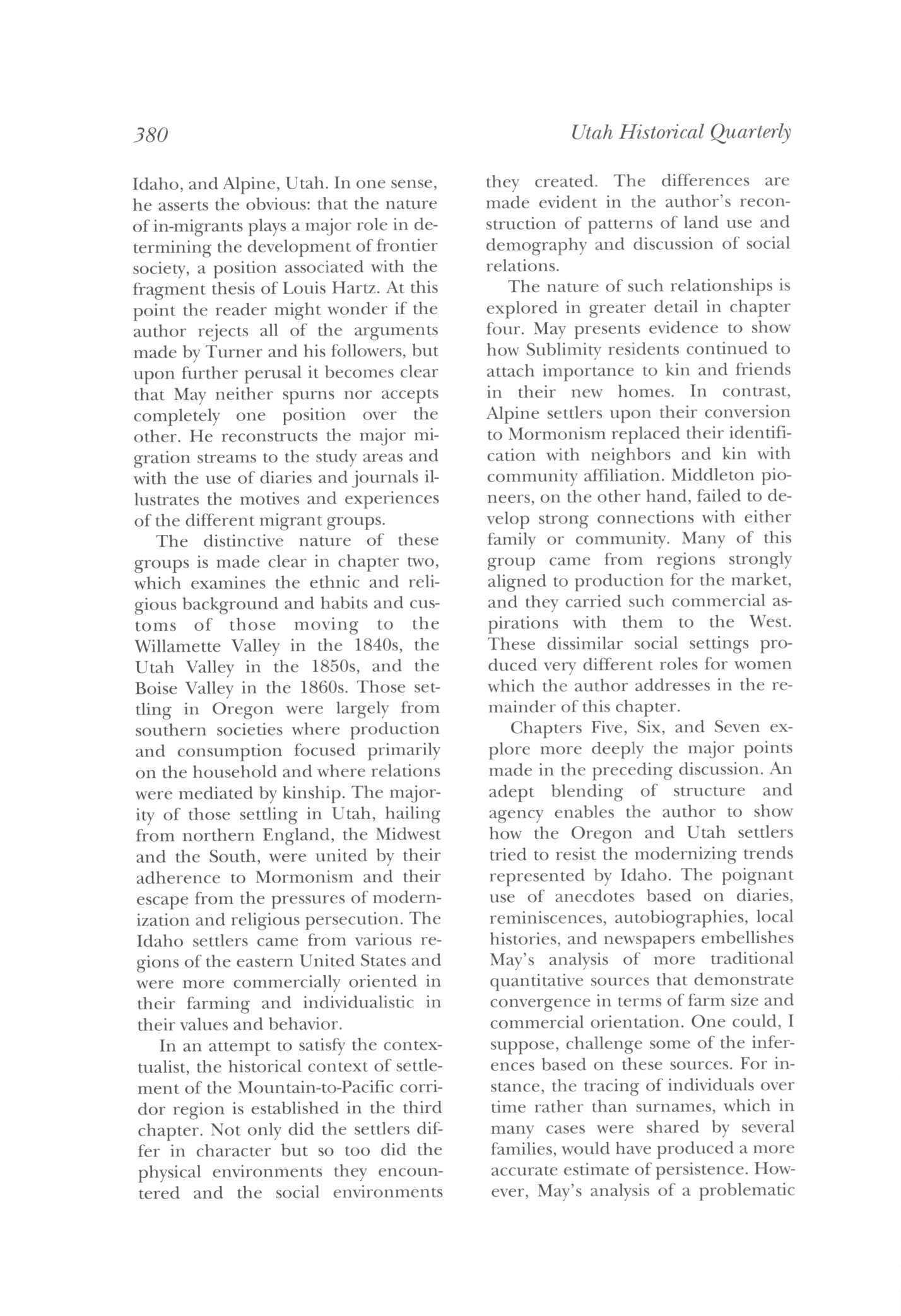
The distinctive nature of these groups is made clear in chapter two, which examines the ethnic and religious background and habits and customs of those moving to the Willamette Valley in the 1840s, the Utah Valley in the 1850s, and the Boise Valley in the 1860s Those settling in Oregon were largely from southern societies where production and consumption focused primarily on the household and where relations were mediated by kinship The majority of those settling in Utah, hailing from northern England, the Midwest and the South, were united by their adherence to Mormonism and their escape from the pressures of modernization and religious persecution The Idaho settlers came from various regions of the eastern United States and were more commercially oriented in their farming and individualistic in their values and behavior
In an attempt to satisfy the contextualist, the historical context of settlement of the Mountain-to-Pacific corridor region is established in the third chapter Not only did the settlers differ in character but so too did the physical environments they encountered and the social environments
they created The differences are made evident in the author's reconstruction of patterns of land use and demography and discussion of social relations
The nature of such relationships is explored in greater detail in chapter four May presents evidence to show how Sublimity residents continued to attach importance to kin and friends in their new homes. In contrast, Alpine settlers upon their conversion to Mormonism replaced their identification with neighbors and kin with community affiliation Middleton pioneers, on the other hand, failed to develop strong connections with either family or community. Many of this group came from regions strongly aligned to production for the market, and they carried such commercial aspirations with them to the West. These dissimilar social settings produced very different roles for women which the author addresses in the remainder of this chapter
Chapters Five, Six, and Seven explore more deeply the major points made in the preceding discussion. An adept blending of structure and agency enables the author to show how the Oregon and Utah settlers tried to resist the modernizing trends represented by Idaho. The poignant use of anecdotes based on diaries, reminiscences, autobiographies, local histories, and newspapers embellishes May's analysis of more traditional quantitative sources that demonstrate convergence in terms of farm size and commercial orientation One could, I suppose, challenge some of the inferences based on these sources For instance, the tracing of individuals over time rather than surnames, which in many cases were shared by several families, would have produced a more accurate estimate of persistence However, May's analysis of a problematic
380 Utah Historical Quarterly
collection of records is for the most part very insightful
To this reviewer the most important contribution of this research is that it offers a perspective that is neither an outright rejection nor acceptance of the Turnerian or Hartzian views. The truth lies somewhere be-
tween both deterministic models, and Dean May has managed to capture the essence of this truth in a very fine book
Differing Visions:Dissenters in Mormon History. Edited by ROGER D LAUNIUS and LINDA THATCHER (Urbana and Chicago: University of Illinois Press, 1994 xiv + 402 pp $32.50.)
This collection of biographical essays is an important attempt to legitimize the study of dissent in Mormon history. The Differing Visions portrayed here reveal a fascinating collage of iconoclastic Saints who demonstrate that the American tradition of religious dissent has been well maintained among the Mormons Despite the persistence of dissent in Mormonism, Leonard J. Arrington notes in the foreword, the subject has been neglected in church history—the topic considered "somehow suspect." The confrontation with church authority, challenge to ideology, and threat to tradition have thrust dissenters into a shadowy, but safe, historical netherland
The editors of this volume, Roger D. Launius and Linda Thatcher, explore such themes in their rich and thoughtful introduction Placing Mormonism itself in the context of American religious dissent, the editors claim that the church moved away from an early tolerance of pluralism toward a strong hierarchical structure as the leadership worked to consolidate authority For various reasons dissent became viewed as incompatible with love of the gospel, and dissidents were condemned as apostates and treated as traitors. The "overwhelmingly negative connotation of dissent in Mormonism," Launius and Thatcher sug-
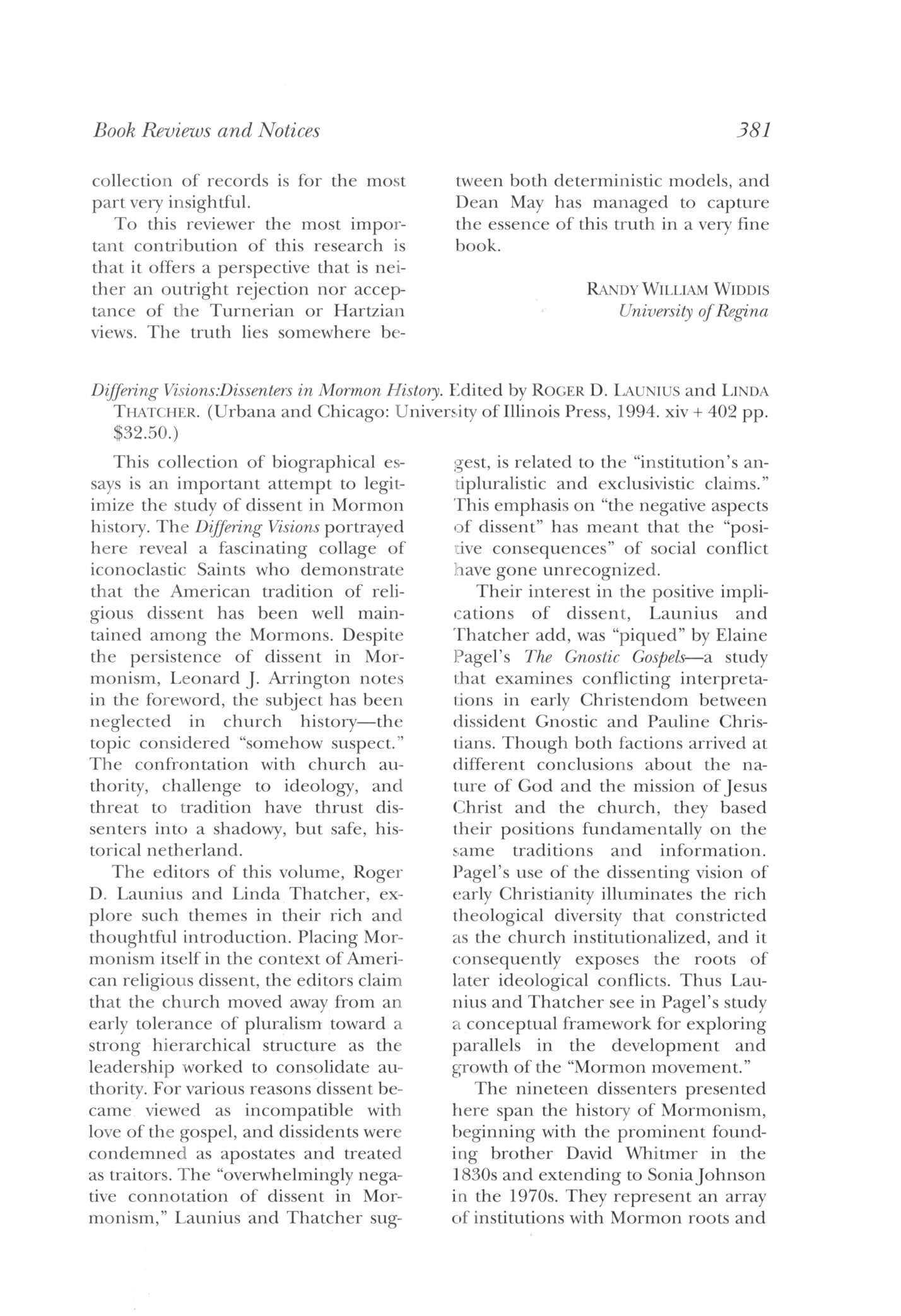
gest, is related to the "institution's antipluralistic and exclusivistic claims." This emphasis on "the negative aspects of dissent" has meant that the "positive consequences" of social conflict have gone unrecognized.
Their interest in the positive implications of dissent, Launius and Thatcher add, was "piqued" by Elaine Pagel's The Gnostic Gospels—a study that examines conflicting interpretations in early Christendom between dissident Gnostic and Pauline Christians Though both factions arrived at different conclusions about the nature of God and the mission of Jesus Christ and the church, they based their positions fundamentally on the same traditions and information. Pagel's use of the dissenting vision of early Christianity illuminates the rich theological diversity that constricted as the church institutionalized, and it consequently exposes the roots of later ideological conflicts. Thus Launius and Thatcher see in Pagel's study a conceptual framework for exploring parallels in the development and growth of the "Mormon movement."
The nineteen dissenters presented here span the history of Mormonism, beginning with the prominent founding brother David Whitmer in the 1830s and extending to Sonia Johnson in the 1970s. They represent an array of institutions with Mormon roots and
Book Reviews and Notices 381
RANDY WILLIAM WIDDIS University ofRegina
include such well-known dissenters as Fawn McKay Brodie and lesser-known figures like Cutlerite church founder Alpheus Cutler. Essays by Ronald Romig, Kenneth Winn, Richard Howard, Richard Saunders, and Dan Vogel look at early converts who left the church during the lifetime of Joseph Smith; Paul Edwards, Danny Jorgenson, and Guy Bishop consider three cases of dissent in the aftermath of Smith's death Dissent during the Brigham Young era is explored by Richard Holzapfel, John McCormick, and John Sillito, and twentieth-century dissidents are examined by Kenneth Godfrey, Martha Sonntag Bradley, Newell Bringhurst, Jessie Embry, William Russell, Lawrence Foster, and Alice Allred Pottmyer.

How successful are these essays, given the intent of the book? Many succeed on all fronts: the subject compelling, the analysis insightful, and the wider implications significant Some are less satisfying: the subject seems in-
herently less promising or the author fails to move beyond the narrative Nevertheless, viewed as a whole Differing Visions is an important and thought-provoking book. It provides a larger historical context and greater diversity than generally is the case with Mormon history—as the use of the inclusive term "Mormon movement" suggests. The common denominator among these dissenters is that at one time each professed a belief in the mission of Joseph Smith; these essays show how varied the interpretations of that mission have been. Differing Visions also makes clear that although the strongly held convictions of dissenters were personally costly and created conflict, their stories enhance the texture and broaden our understanding of the Mormon experience.
LOLA VAN WAGENEN Charlotte, Vermont
The Mormon Hierarchy: Origins of Power.
Michael Quinn's book is the only serious attempt by historians to look carefully at this aspect of Mormon history. It reviews that history during the lifetime of Joseph Smith, Jr., and through the succession of various claims and crises A companion volume, projected for a fall 1995 publication, will continue the study to the present.
The text consists of seven chapters: "The Evolution of Authority," "The First Five Presiding Priesthood Quorums," "Theocratic Beginnings," "The Kingdom of God in Nauvoo, Illinois," "The 1849 Succession Crisis and the Twelve," "Other Succession Options,"
and "The Nature of Apostolic Succession." The text is followed by an insert of several pages of photographs and documents Footnotes and bibliographic data are arranged as endnotes in an unusual style designed to address problems incident to Quinn's extensive documentation
Appendices one through seven cover specific topics briefly, yet with explicit details. Included are "General Officers of the Church of Jesus Christ of Latter-day Saints, 1830-47"; "Mormon Security Forces, 1833-47"; "Danites in 1838: A Partial List"; "Meetings and Initiations of the Anointed Quorum ('Holy Order')"; "Members of
Book Reviews and Notices 382
By D. MICHAEL QUINN. (Salt Lake City: Signature Books in association with Smith Research Associates, 1994. xvi + 685 pp. $29.95.)
the Council of Fifty"; "Biographical Sketches of General Officers of the Church of Jesus Christ of Latter-day Saints"; and "Selected Chronology of the Church of Jesus Christ of Latterday Saints, 1830-47." Readers will discover a new clarity about Mormon history derived both from the documented facts and from how they are arranged The book's wealth of information begs a studious reading
Quinn writes: "My purpose in this study is to examine the evidence of Mormonism's social realities. Both believers and nonbelievers must remember that history can demonstrate human experience incompletely at best History can (and should) examine what others say about metaphysical experiences, but history cannot demonstrate, prove, or disprove otherworldly interaction with human experience." Since readers bring their own paradigms to their reading of religious history especially, it is important that the author's intent be understood For, as Albert Einstein wrote: "The theory defines what can be seen."
The author first traces the concept of the "church" itself from a "family church" to where it would become the Church of Jesus Christ of Latter-day Saints, and from one of charismatic witnessing to one of priesthood authority with specific offices and jurisdictions. That progression was erratic, fraught with controversies and even apostasy.

Quinn's careful review of sources shows many factual errors in current Mormon history. The higher priesthood's restoration happened in June after the church's formal organization, April 6, 1830. Therefore, the office of Elder belonged first to the Aaronic priesthood. He cites numerous instances of revelation "changes" that clarified, elaborated, or reversed earlier ones. Joseph's prophetic mantle
sometimes seemed quite experimental What emerged was a church structure that was tentative and beliefs that were continually under review and revision The same was true of jurisdictional authority for all general offices of the church
One of the author's most persuasive insights relates to the "theocratic" belief Smith introduced in 1833-34 This concept placed God in human history directly, with his prophet as spokesman and his Saints as the elect to preach and to enforce God's will, which meant that God's "law" could and should supplant the laws of the land, when needed, to promote righteousness and to usher in the kingdom of God on earth Theocratic prerogatives led to extremes, both in teachings and in practices. It was okay to lie or even kill if God willed it so Zion's Camp and the Danites created to defend the Saints and to redeem Zion both "took the law into their own hands." Later, in Nauvoo between 1840 and 1844, Joseph Smith introduced to a select few several secret practices Relatively few of the general membership knew of the doctrine of polygamy, or the "Anointed Quorum ('Holy Order')," or the Council of Fifty, or of the anointing of Joseph Smith as "King of the whole World."
While the stake presidents presided over the Saints within the stakes of Zion, and the Quorum of Twelve Apostles had authority in the missions, lines of authority and jurisdictions became further confused because of the secret orders and because the prophet himself had given mixed messages about jurisdictions By the summer of 1844, as secrets were revealed and enemies within combined with foes from without to bring his downfall, Smith's theocratic system began to crumble, and his death became inevitable. The author guides
Book Reviews and Notices 383
readers through the belief and practices that led to this tragic finale.
Quinn then discusses the problems of succession, again created because of ambivalence in Smith's statements. He discusses all claims in interesting detail. It would finally be the Quorum of the Twelve Apostles from whom most Mormons would accept leadership, although nearly half of the 16,000 members did not follow them to Utah He elaborates on apostolic succession as the resolution of the awesome uncertainty that had been theirs with the death of the founding prophet.
This is an important book. The author has done an outstanding job of clarifying who the Mormon hierarchy were and what they wrought. Additional studies are needed on lesser leaders and offices to complete the picture of the Mormon hierarchy It
remains a challenging task, as is the one Quinn has accepted for himself. He recalls Joseph Smith's statement with understanding: "No man knows my history. ... " He adds a lengthy summary statement, quoted only in part here: "Few Mormons today can grasp the polarizing charisma of their founding prophet. Some may feel uncomfortable with the full scope of Joseph Smith's activities " Quinn's work is a major contribution to our understanding of Mormon history during this period.
Readers who can own their peculiar biases about religious history will be greatly informed by reading this book
MELVIN T SMITH Mt. Pleasant, Utah
f Book \ Notices
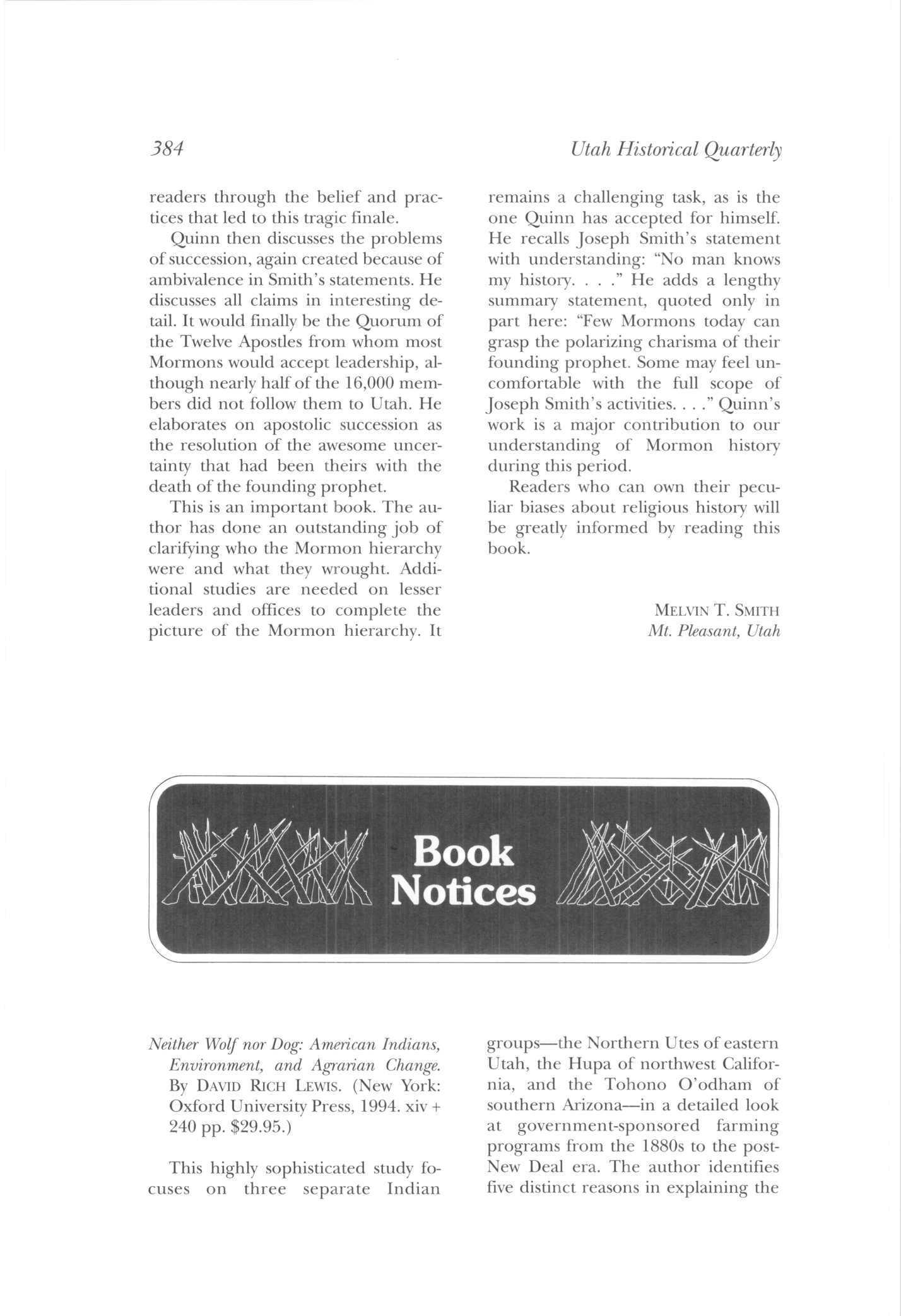
Neither Wolf nor Dog: American Indians, Environment, and Agrarian Change.
By DAVID RICH LEWIS (New York: Oxford University Press, 1994. xiv+ 240 pp $29.95.)
This highly sophisticated study focuses on three separate Indian
groups—the Northern Utes of eastern Utah, the Hupa of northwest California, and the Tohono O'odham of southern Arizona—in a detailed look at government-sponsored farming programs from the 1880s to the postNew Deal era The author identifies five distinct reasons in explaining the
384 Utah Historical Quarterly
causes and processes offailure: lack of consistency within the government program, environmental limitations, market vagaries, cultural resistance, and divergent expectations.
Yet failure is a relative term, and the careful reader of this analysis may conclude that the agrarian experience was not quite as myopic or as devastating to native culture as commonly supposed Chief Washakie's terse remonstrance, "God Damn a potato," was only one response along a continuum of nonexclusive strategies open to andexercised by thevarious native communities Some groups were more receptive and came surprisingly close to the success envisioned by Euro-American ethnocentrism. In those instances, the grand experiment foundered on flinty soil and harsh market economies.
Through it all, the Native Americans managed to reproduce older patterns to meld with the new,thereby maintaining their cultural identity
Navajo Country: A Geology and Natural History of the Four Corners Region. By DONALD L BAARS (Albuquerque: University of New Mexico Press, 1995. xiv+ 255pp. Paper, $19.95.)

This layman's geology book discusses the creation of rock formations, the evolution of place names, and the economic development of mineral resources in and around the Navajo Reservation Of particular interest to Utah readers are sections
concerning Monument Valley, the San Juan River, oil and uranium development, and various scenic sites
The text contains excellent geologic information but has some questionable historic data.
Forlorn River. By ZANE GREY (1926, Lincoln: University of Nebraska Press, 1995.xii + 338 pp. Paper, $12.00.)
Nevada. By ZANE GREY (1926; Lincoln: University of Nebraska Press, 1995. x +365 pp. Paper, $12.00.)
Forlorn River and its sequel, Nevada, which appeared less than a year later, feature the gunslinger "Nevada"Jim Lacy, a morally ambiguous figure patterned after Owen Wister's Virginian and Grey's own Lassiter, who finds it necessary to operate on the fringes of the law in order to promote civilization. Although both novels are minor parts of the Grey corpus, these installments in the handsome "Authorized Edition" of Grey's works being issued under Nebraska's Bison Books imprint (five titles are currently available) areof interest because of the introductions by the author's son, Loren Grey, which give the circumstances of their composition, reception by the public, and cinematic adaptations. Asone might expect, filial loyalty dulls Loren's critical acuity, but the introductions provide firsthand data unavailable elsewhere.
Book Reviews and Notices 385
INDEX
Italic numbers refer to illustrations
Abbey, Ed, author and NPS employee, 138, 148
Adams, George A., San Juan County commissioner, 10
Adams, Thomas C , yacht club commodore, 212, 221
African Americans, prejudice against, 39
Aglaia, Ogden women's club, 307
Agriculture: and dry farming, 60-63; effects of WWI on, 9-11; and irrigation, 58-60; and lucerne, 54; scientific study of, 50-69; and sugar industry, 54-56
Agricultural College of Utah (ACU): antiMormonism at, 53; Utah Experiment Station at, 50, 50-69, 55, 59. See also Utah State Agricultural College and Utah State Unversity
Aleson, Harry, river runner, 117, 134
Allen, Clarence E., first Utah congressman, 353
Allen, Corinne M., Utah clubwoman, 308, 313,318
Allen, E W., asst director, Utah Experiment Station, 54
Allison, William B., U.S senator, 350
Alter, J. Cecil, and sego lily, 81
Alvey, Edson, and Gregory Bridge, 118-19
Alvord, Cleo Yvonne Williams, and WWII rationing, 252-53
American Home Foods, WWII display of, 263
American Placer Corp., 124, 125
Anderson, Bernice, and CityofCorinne, 212-13
Anderson Implement Store, Heber City, 257
Anderson, Leola Stapley, cousin of Leland Stapley, 28
Anderson, May, LDS Primary leader, 306
Anderson, Valentine, shot during statehood celebration, 359
Andrews, Frank M., Air Force commander, 223
Antelope Island, livestock and buffalo on,
201,203,209
Anti-Polygamy Standard, 300
Arches National Park, 137; and supt Bates Wilson, 136-46, 150
Arnold, Hap, Air Force commander, 225, 226
Ashby, Richard, and sego lily, 71
Auerbach's, and WWII bond drives, 264 Authors Club, SLC women's org., 307
B
Backman, Gus P., WWII rationing administrator, 247-49
Badlam, Alexander, Jr., and statehood, 346

Bailey, L H., dean of agriculture at Cornell, 63
Baker, Gaylel Alice, and WWII bond queen contest, 266
Baker, Mildred, and Gregory Bridge, 111-12
Ballard, Henry, Logan settler, 164
Ballard, Margaret, Cache Valley settler, 166
Balser, Claud, WWI soldier, 32, 38
Balser, Harriet, 38
Balser, Leo, WWI soldier, 32, 37, 38
Bamberger, Clarence, bond drive chair, 262, 267
Bamberger, Simon: and anti-Semitism in 1916 election, 25; and WWI, 10, 12
Bane, Frank, OPA director, 247 Baptist church: and education, 305; Ladies Aid Society of, 301; and temperance, 301
Barnes, Frank, San Juan County sheriff, 17, 19
Barrett, W W., and WWI, 7
Barrot, Henry, as boatbuilder, 198-99, 202
Barthe, Euretha K., 1896 speech of to clubwomen, 309-10
Bean, George W., and sego lily, 72 Bear Hunter, Shoshone leader, 159, 169 Bear River, boats on, 206, 207, 209
Bear River Massacre, 159-61, 169
Beaver City, and 1896 statehood celebration, 362,363-64, 366
Bennett, Charles W., SLC attorney, 355
Bennett, Isabella E: and Columbian Exposition, 313; and Mormon-gentile detente, 309; and silk, 315
Benson, Ezra T.: Cache Militia reorganized by, 166; and sego lily, 73
Benson, Stanley, WWI soldier, 35
Berry, E Y, congressman, and Southern Paiute termination, 269
Berry, Rosa Webster, and Red Cross, 43
Bettilyon, Verden Lee, and Gregory Bridge, 118
Bigelow, John, columnist, 259
Bingley, Bill, and 1896 statehood celebration, 357-58
Black, Alice, and WWI, 9
Black, David, Jr., and smallpox, 20
Black Hawk, Ute leader, 166
Black Rock, Great Salt Lake, 217
Blaine, James G., and statehood, 346, 348, 349~
Blake, George Rowland, Provo dairy farmer, 246-47
Blake, Maybelle, War Finance Committee official, 265
Blake, Ruth Wright Christensen, and WWII bonds, 265
Blanding, Utah, and WWI, 3, 4-23
Blood, Jane Hooper Wilkie, and statehood, 368
Blount, J H., congressman, and statehood, 345
Blue Tea Club, gentile women's org., 307
Boats and boatbuilders on Great Salt Lake, 194-221
Bond, Nonnte, statehood contest winner, 363
Book, F., Overland Mail agent, 165
Breckinridge, W C P., congressman, and statehood, 344-45
Brice, Calvin, Democratic National Committee chair, 347
Brigham City, and 1896 statehood celebration, 359,362
Brigham Young Academy, teacher training at, 30(3
Brower, David, Sierra Club director, and Lake Powell, 120
Brown, , Western Union supt., 357
Brown, Arthur, U.S senator, 341, 355-56
Brown, Charlotte Emerson, pres., General Federation of Women's Clubs, 307
Browning Gun Works, and WWII, 234
Buckley, Newman, and sego lily, 70-71
Budge, William, LDS leader in Idaho, 347
Bullock, Electa, and Columbian Exposition, 312
Buttars, John, and 1896 statehood celebration, 365
Cache Militia, reorganization of, 166
Cache Valley, Mormon-Shoshone relationships in,158-71
Caine, John T., and statehood, 344
Caine, Margaret A., and Columbian Exposition, 313, 315
Call, O. J., and 1896 statehood celebration, 361
Callis, Charles A., LDS apostle, 261
Cambria I, Cambria II, catamarans of D. L. Davis, 218, 218-21, 220, 221
'Canning industry, 68
Cannon, Abraham H.: and statehood, 348-50; and U.S Senate seat, 354
Cannon, Frank J.: delegate to Congress, and statehood, 323, 367; and U.S Senate seat, 341, 354-56
Cannon, George M., 1895 Constitutional Convention delegate, 327, 329-30, 332
Cannon, George Q.: arrd Mormon vote, 342; political influence of, 347, 352; and sego lily, 73; and statehood, 348-50; and U.S Senate seat, 352-56
Cantwell, Jim, and 1896 statehood celebration, 367
Cantwell, Leona, and 1896 statehood celebration, 367
Canyonlands National Park, establishment of, 146-50, 147
Carey, Joseph, Wyoming delegate to Congress, 349
Carlile, James W., and WWII rationing, 251-52
Carlisle, John G., Speaker of the House, 344
Carrington, Albert, exploration of GSL by, 199-200
Carroll, Fred, 4

Index 387
Carter, Kate B., and sego lily, 81-82
Castillo, Adam, and Indian termination, 271
Castle Gate, and 1896 statehood celebration, 367
Catholic church: hospital, orphanage, and charities of, 302; and Indians, 281
Catt, Carrie Chapman, suffragist, 303
Cazier, Mary A., and silk, 315
Cedar City, airport at, 235
Cityof Corinne, steamboat on GSL, 206, 209-13, 210, 211
Chambers, Robert C , Utah World's Fair commissioner, 314
Chapin, Alice, and model kindergarten, 305
Charities and Philanthropies: Woman'sWork in Utah, 313
Charleston Town Council, and WWII bonds, 262
Chenoweth, William, topographical engineer, 105-7, 116
Christensen, C C A., and 1896 statehood celebration, 364
Christensen, C. L., and St. George Temple baptismal font, 155
Christensen, Maynard, 40
Christensen, Rosell Pollock, 40
Church ofJesus Christ of Latter-day Saints: and 1890 Manifesto, 322; and kindergartens, 305; and politics, 327, 352-56; Primary Assn of, 306; and prohibition, 336-37; Relief Society of, 301, 313; St George Temple of, 151-57; and Sen Watkins's termination bill, 277, 279-82; and Utah economy, 325; ward schools of, 303-4; and WWI, 8, 9-10, 13-16, 21, 27-44; and WWII bond drives, 263, 265. See also Mormons and names of church leaders
Clarkson, James S., and statehood, 346, 348,350-51,354
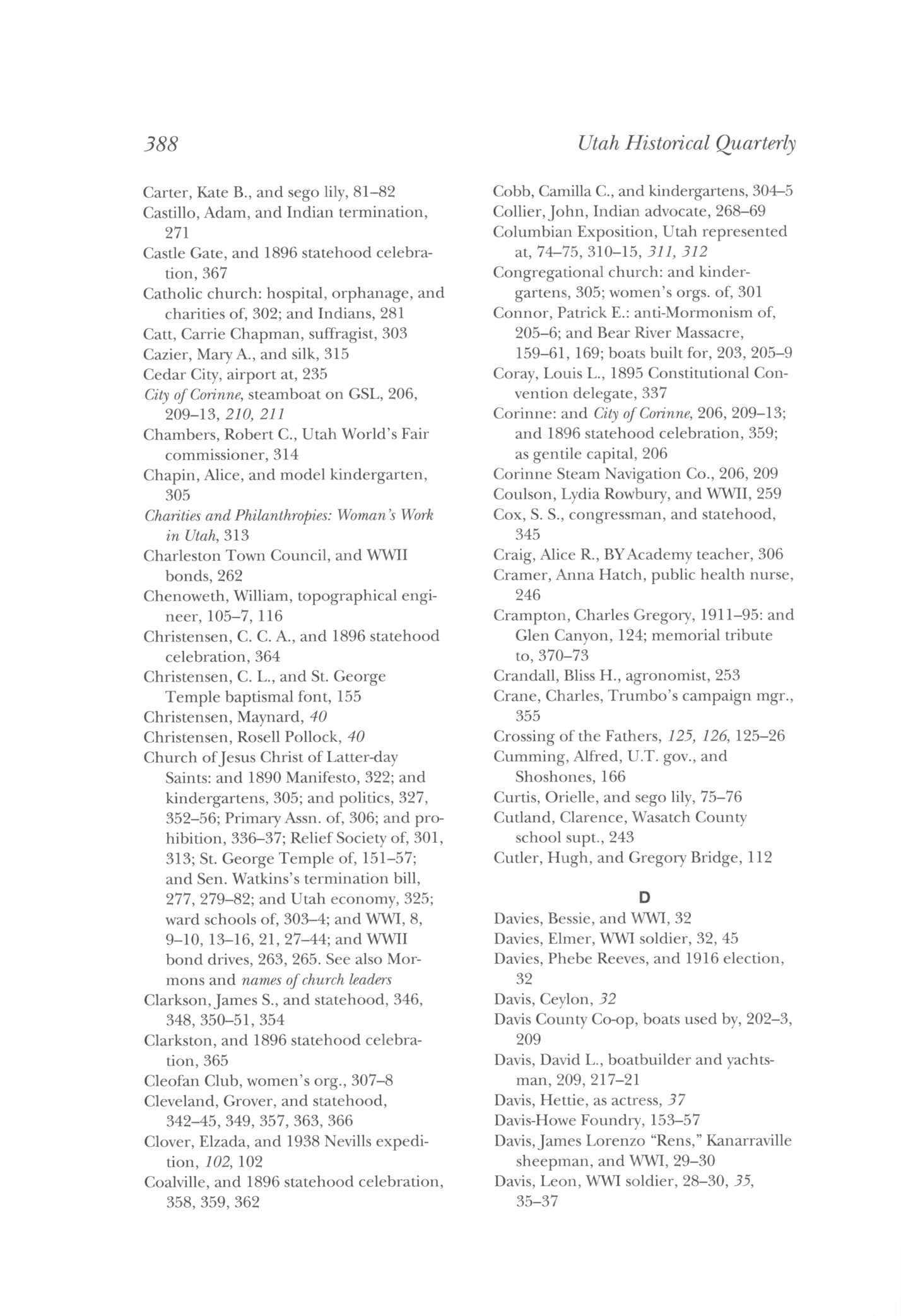
Clarkston, and 1896 statehood celebration, 365
Cleofan Club, women's org., 307-8
Cleveland, Grover, and statehood, 342-45, 349, 357, 363, 366
Clover, Elzada, and 1938 Nevills expedition, 102, 102
Coalville, and 1896 statehood celebration, 358, 359, 362
Cobb, Camilla C , and kindergartens, 304-5
Collier, John, Indian advocate, 268-69
Columbian Exposition, Utah represented at, 74-75, 310-15, 311, 312
Congregational church: and kindergartens, 305; women's orgs, of, 301
Connor, Patrick E.: anti-Mormonism of, 205-6; and Bear River Massacre, 159-61, 169; boats built for, 203, 205-9
Coray, Louis L., 1895 Constitutional Convention delegate, 337
Corinne: and Cityof Corinne, 206, 209-13; and 1896 statehood celebration, 359; as gentile capital, 206
Corinne Steam Navigation Co., 206, 209
Coulson, Lydia Rowbury, and WWII, 259
Cox, S S., congressman, and statehood, 345
Craig, Alice R., BY Academy teacher, 306
Cramer, Anna Hatch, public health nurse, 246
Crampton, Charles Gregory, 1911-95: and Glen Canyon, 124; memorial tribute to,370-73
Crandall, Bliss H., agronomist, 253
Crane, Charles, Trumbo's campaign mgr., 355
Crossing of the Fathers, 125, 126, 125-26
Cumming, Alfred, U.T gov., and Shoshones, 166
Curtis, Orielle, and sego lily, 75-76
Cutland, Clarence, Wasatch County school supt., 243
Cutler, Hugh, and Gregory Bridge, 112
Davies, Bessie, and WWI, 32
Davies, Elmer, WWI soldier, 32, 45
Davies, Phebe Reeves, and 1916 election, 32
Davis, Ceylon, 32
Davis County Co-op, boats used by, 202-3, 209
Davis, David L., boatbuilder and yachtsman, 209, 217-21
Davis, Hettie, as actress, 37
Davis-Howe Foundry, 153-57
Davis, James Lorenzo "Rens," Kanarraville sheepman, and WWI, 29-30
Davis, Leon, WWI soldier, 28-30, 35, 35-37
388 Utah Historical Quarterly
Davis, Lorenzo Wendell "Wennie," WWI soldier, 31, 32
Davis, Nathan, mechanic, and LDS temple baptismal fonts, 152-57, 154
Davis, Sarah, 40
Davis, Virgil, 32
Davis, Wallace, WWI soldier, 28-30
Davis, Wayne, 32
Day, Wilford, and WWI, 43
Decker, Louisa Morris, and sego lily, 71
Dehlin, Frank, grave of, 133
Deloria, Vine, Jr., and Indian termination, 273, 282
Democratic party: and LDS women, 302-03; and statehood, 341-56
Dern, George H., 125
Deseret Farmer, founding of, 66
Dseseret News: and Davis-Howe Foundry, 154; and divorce, 300; and 1895 Constitutional Convention, 321, 331; and St. George baptismal font, 155-56; and Shoshones, 166; and statehood celebration, 359
Dickey, Elizabeth, and kindergartens, 305
Divorce, permissiveness of, in 19th-century Utah, 300
Dodge, Natl, naturalist, 141
Dominguez-Escalante expedition, 125, 126, 126
Dominy, Floyd, commissioner, Bureau of Reclamation, and Lake Powell, 119-20
Doty, James Duane, Indian supt., 159
Dougall, Maria Y, and National Council of Women, 317

Douglas, W B., and Natural Bridges, 143
Douris, Thomas, founder of Garfield Beach,212
Dubois, Fred T., Idaho senator, 354
Eads, James B., bridge designer, 153 Edmunds-Tucker Act, repeal of woman suffrage by, 300
Education: and kindergarten movement, 304—6; Mormon-gentile discord over, 303-4
Edvalson, Beth Smith, and WWII rationing, 250
Eichnor, Dennis C, 1895 Constitutional Convention delegate, 326 Elkhorn Ranch, 163
Embry, Albert Leo, and WWII rationing, 246-47
Embry, Alvin, 247 Embry, Anna Coulson, and WWII rationing, 257 Embry, Elsie, 247
Embry, Iola Harriet Bird, and WWII rationing, 246-47, 259
Embry, Leora, 247
Embry, Ralph, LDS missionary, 247 Ephraim, and 1896 statehood celebration, 364
Episcopal church, hospital established by, 302
Escalante National Monument, proposal of, failed, 107-8
Estee, Morris, GOP National Convention chair, 347-48, 350
Eureka, sailboat on GSL, 217
Evans, David, 1895 Constitutional Convention delegate, 335
Facer, Jane, WWI bond contest queen, 266 Fairview, and 1896 statehood celebration, 359
Fayette, and 1896 statehood caelebration, 359
Felt, Louie B., LDS Primary leader, 306 Fifield, Donna, teletype operator, 255, 259
Fillmore, and 1896 statehood celebration, 359
First Congregational Church, model kindergarten at, 305
Fordham, Karl E., composer, 80, 83 Fort Hall, and Shoshones, 163, 170, 170, 171
Fowles, Mrs J W., victory garden of, 254 Foy, James, WWI casualty, 22
Frary, George, resident of Antelope Island, 203
Free Kindergarten Assn., 305
Fremont Island, 202
Friendship Cruise, on Green and Colorado rivers, 139
Froeble, Friedrich, German educator, 304
Froiseth, Jennie, women's club organizer and polygamy foe, 307, 313
Index 389
Galloway, Nathaniel, Glen Canyon cave named for, 122, 124
Garden City, and 1896 statehood celebration, 360
Garfield Beach, 212, 212, 214, 218
Garland, sugar plant in, 56 General Garfield, excursion boat on GSL, 212, 212
Geneva Steel, role of, in WWII 233-34, 242
Gessel, Cyde D., WWII reminiscence of, 172-75, 172
Gilmore, Harry, BIA supt., and Southern Paiute termination, 276, 278
Glade, David, and giant statehood flag, 360 Glade, Earl, SLC mayor, and WWII bonds, 266
Glen Canyon: flooding of, by Lake Powell, 117-34, 122, petroglyphs in, 727, 127
Goddard, George, and statehood, 368
Goldwater, Barry, and Gregory Bridge, 110, 113
Goodwin, Charles C , 1895 Constitutional Convention delegate and U.S Senate hopeful, 334, 353-55, 367
Gormon, Arthur P., U.S senator, 347 Grand County, effects of WWI in, 4-23
Grand Valley Times, and WWI, 5
Grannis, Elizabeth, and polygamy controversy, 317
Grant, Heber J., and statehood politics, 349
Grant, Jedediah, and sego lily, 73, 83
Grayson [Blanding] Cooperative Company, sawmill operation of, 4, 6-7
Great Salt Lake, history of early boats on, 194-221, 194-95, 204, 210, 211, 212, 214, 215, 216, 217, 218, 220, 221
Gregory, Herbert, geologist, 105-6, 112-13, 116
Gregory Natural Bridge, 100, 109, 114, 131; covered by Lake Powell, 101, 134; naming of, 112-13; role of Nevills in "discovery" and promotion of, 100-121
Griffin, S.J., Ogden entrepreneur, 363
Gunnison, and 1896 statehood celebration, 365
Gunnison Island, 204
Gunnison, John W., exploration of GSL by, 200
Gunther, Orville Carl, and WWII 246, 256,267
Guymon, Morley, 4 H
Hale, Aroet, and sego lily, 72
Hamblin, Jacob, and Crossing of the Fathers, 127
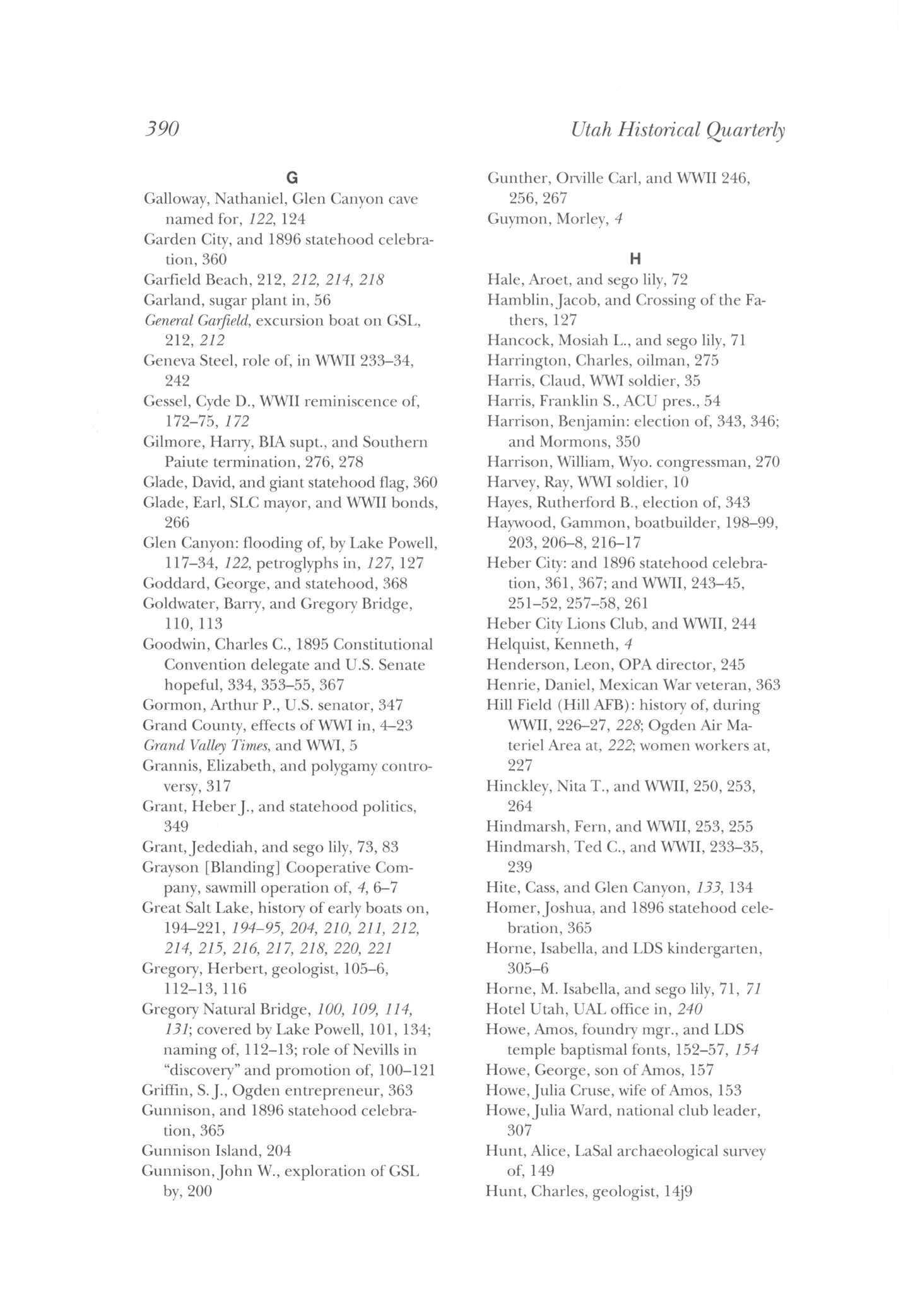
Hancock, Mosiah L., and sego lily, 71
Harrington, Charles, oilman, 275
Harris, Claud, WWI soldier, 35
Harris, Franklin S., ACU pres., 54
Harrison, Benjamin: election of, 343, 346; and Mormons, 350
Harrison, William, Wyo congressman, 270
Harvey, Ray, WWI soldier, 10
Hayes, Rutherford B., election of, 343
Haywood, Gammon, boatbuilder, 198-99, 203,206-8,216-17
Heber City: and 1896 statehood celebration, 361, 367; and WWII, 243-45, 251-52, 257-58, 261
Heber City Lions Club, and WWII, 244
Helquist, Kenneth, 4
Henderson, Leon, OPA director, 245
Henrie, Daniel, Mexican War veteran, 363 Hill Field (Hill AFB): history of, during WWII, 226-27, 228; Ogden Air Materiel Area at, 222; women workers at, 227
Hinckley, Nita T., and WWII, 250, 253, 264
Hindmarsh, Fern, and WWII, 253, 255
Hindmarsh, Ted C, and WWII, 233-35, 239
Hite, Cass, and Glen Canyon, 133, 134
Homer, Joshua, and 1896 statehood celebration, 365
Home, Isabella, and LDS kindergarten, 305-6
Home, M. Isabella, and sego lily, 71, 71
Hotel Utah, UAL office in, 240
Howe, Amos, foundry mgr., and LDS temple baptismal fonts, 152-57, 154
Howe, George, son of Amos, 157
Howe, Julia Cruse, wife of Amos, 153
Howe, Julia Ward, national club leader, 307
Hunt, Alice, LaSal archaeological survey of, f49
Hunt, Charles, geologist, 14j9
390 Utah Historical Quarterly
Huntington, and 1896 statehood clebration, 364
Huntington, Collis P., railroad official, and politics, 354, 356
Huntington, Henry E., railroad official, and politics, 354, 356
Huntsville, and 1896 statehood celebration, 366
Hurst, Dora, 7
Hurst, Gwen, 7
Hurst, Nedra, 7
Hurst, William Riley, and WWI, 7, 7, 19
Hyde, Orson, and baptismal font, 155
The Independent (Moab), and WWI, 5, 9, 17
Indian George, Cache Valley Shoshone, 168
Indian Peaks Indians, and termination, 273-79
Industrial Christian Home for Women, 298, 309
Ingram, Naomi Wood, 40
International Council of Women, and polygamy controversy, 317-19
International Harvester, and WWII bond drives, 262
Iron County Record: anti-Semitism in, 25; and WWI, 26-31, 33, 38-39, 41-44
Ivins, Anthony W., 1895 Cosntitutional Convention delegate, 337
Jamison, Lyle, NPS employee, 145
Jennings, Jesse D., and Canyonlands archaeology, 149
Jenson, Almy, and 1896 statehood celebration, 365
Jenson, Joseph, ACU professor of engineering, 54
Jesperson, Elmer, WWI casualty, 32-33
Jett, Stephen, and Gregory Bridge, 118
Jewish Council, Utah chapter of, 318
Jews, benevolent society of, 302
Johnson, Lawrence A., Utah OPA official, 249
Johnson, Neal, 123-24
Jones, Anna Elizabeth Richardson, and kindergartens, 305
Jones, Dan, as boatbuilder, 198-200
Jones, Henry M., WWI casualty, 32-33
[ones, U T., and Liberty Loan drive, 29 Jordan River: as boat graveyard, 204, 209; boats launched in, 206, 213; exploration of, 199-200
jotter, Lois, and 1938 Nevills expedition, 102, 102
Kaiser, HenryJ., and Geneva Steel, 233 Kamas, and 1896 statehood celebration, 362, 364
Kanarraville: drama group in, 37; effects of WWI on, 24-49
'Kanarraville Poultry Club, 40 'Kanarraville Relief Society, reorganization of, 39-43
^Kanosh Indians, and termination, 273-79
Kate Connor, steamboat on GSL, 196, 203, 206-9, 207, 215
Kearns Army Air Base, WWII induction and basic training site, 228-29, 229
Kearns, Thomas, 1895 Constitutional Convention delegate, 326, 332
Keller, Fred, WWI cavalryman, 10 Kelly Charles, and Gregory Bridge, 108, 116
Kerr, William Jasper, ACU president, 68 IKiesel, FrederickJ., 1895 Constituional Convention delegate, 327 IKirkham, George, and statehood, 368 Kimball, Andrew, 1895 Constitutional Convention delegate, 337 liimball, Sarah M.: and Columbian Exposition, 313; and LDS kindergartens, 305-6
Knell, Allie, and WWI, 41 Koosharem Indians, and termination, 273-79
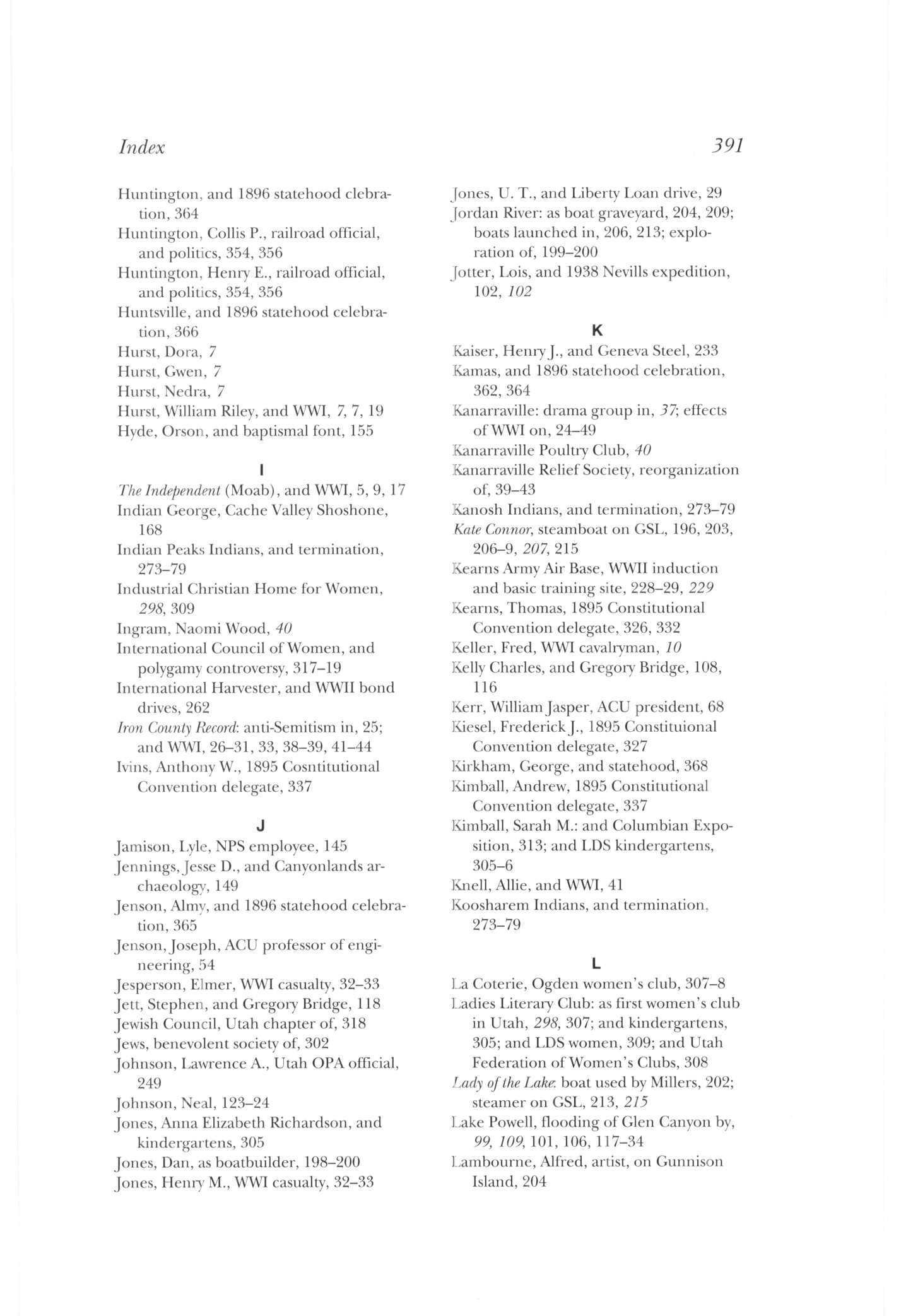
La Coterie, Ogden women's club, 307-8
Ladies Literary Club: as first women's club in Utah, 298, 307; and kindergartens, 305; and LDS women, 309; and Utah Federation of Women's Clubs, 308 Lady ofthe Lake, boat used by Millers, 202; steamer on GSL, 213, 215 Lake Powell, flooding of Glen Canyon by, 99, 109, 101, 106, 117-34
Lambourne, Alfred, artist, on Gunnison Island, 204
Index
391
I
K
Langer, William, congressman, and Southern Paiute termination, 269
larabee, Charles, and Gregory Bridge, 113
Larsen, Jesse, WWI soldier, 21
Larson, Andrew Lund, and statehood, 368
Larson, Hyrum, and 1896 statehood celebration, 365
layton, Christopher, and KateConnor, 209
Leany, William, 74
Lee, John D., trial of, 155
Lee's Ferry, importance of, in river measurement, 123
Le Fevre, Reba Roundy, 42, 47
Lehi: and 1896 statehood celebration, 359; sugar plant in, 55
Lewis, Orme, asst secretary, Dept of Interior, 270
Liberal party, disbanding of, 302
Liljenquist, Emma, Cache Valley settler, and Shoshones, 164, 167
Lint, Leigh, and Gregory Bridge, 106
Logan: airport at, 235; and 1896 statehood celebration, 366; sugar plant in, 56
Logan Temple, baptismal font in, 156
Lovell, Thelma Berry, 39
Low Flight Strip, near Knolls, 230
Loyal Temperance Union, Baptist women's org., 301
Lucin, launch on GSL, 214
Lucin Cutoff, construction of, 214, 216
Lyman, Albert R., editor, SanJuan Blade, 16, 17
Lyman, Mrs. C. W., and Columbian Exposition, 312
Lyman, William H., LDS stake official, 48
Maccabees, Utah chapter of, 318
McCoy, Clare, publishers rep., 44-45
Macey, Woolas Ainley, and WWII bond drives, 264
McVicker, Emma: and Columbian Exposition, 313, 315; and kindergartens, 305
Madsen, Brigham D., historian, 161
Madsen, Charles, Utah Writers' Project director, 110
Maeser, Karl G., educator, 304
Maeser, Nettie, BY Academy teacher, 306
Maeser, R., speech of, in Beaver, 363-64
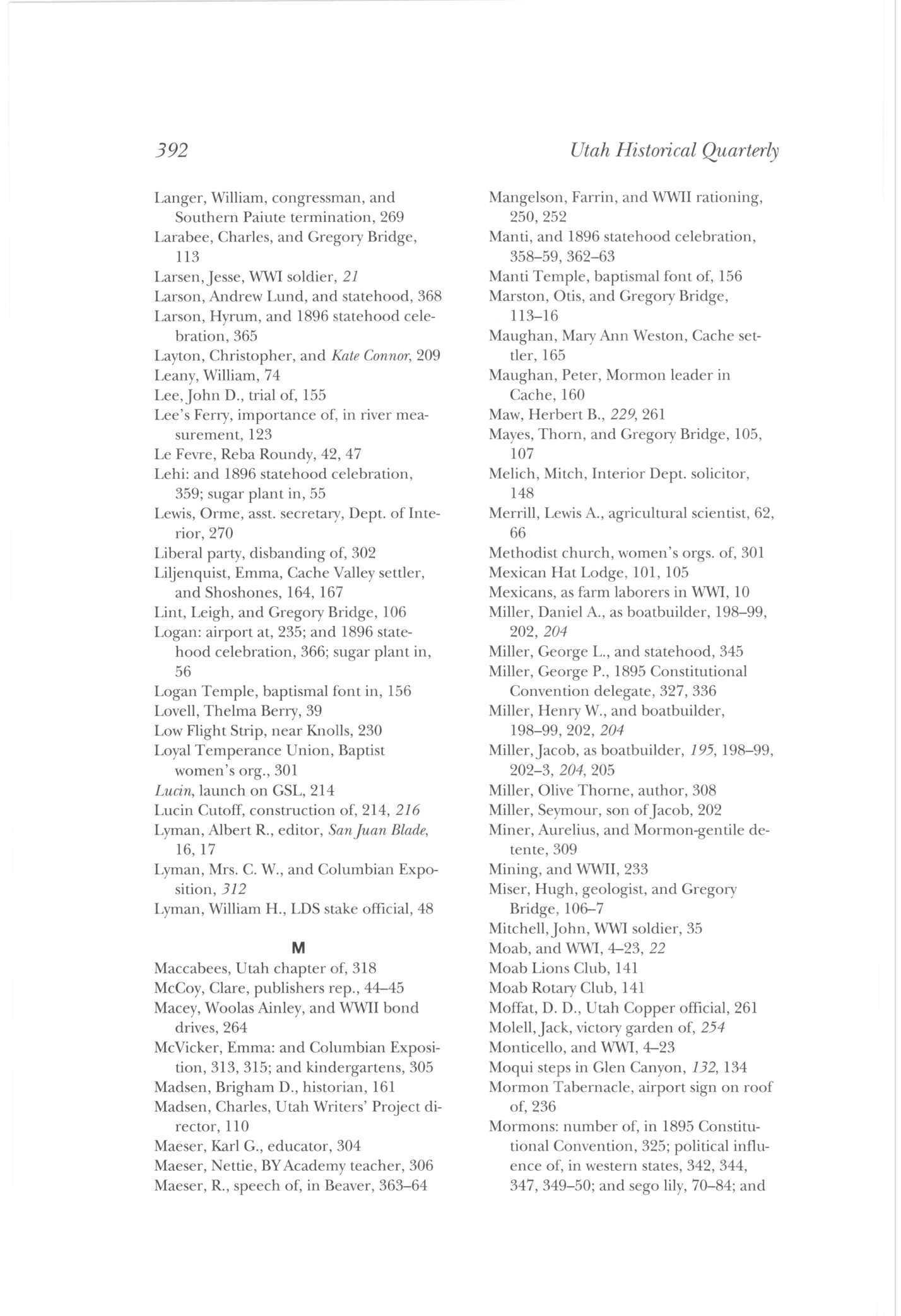
Mangelson, Farrin, and WWII rationing, 250, 252
Manti, and 1896 statehood celebration, 358-59, 362-63
Manti Temple, baptismal font of, 156
Marston, Otis, and Gregory Bridge, 113-16
Maughan, Mary Ann Weston, Cache settler, 165
Maughan, Peter, Mormon leader in Cache, 160
Maw, Herbert B., 229, 261
Mayes, Thorn, and Gregory Bridge, 105, 107
Melich, Mitch, Interior Dept solicitor, 148
Merrill, Lewis A., agricultural scientist, 62, 66
Methodist church, women's orgs, of, 301
Mexican Hat Lodge, 101, 105
Mexicans, as farm laborers in WWI, 10
Miller, Daniel A., as boatbuilder, 198-99, 202, 204
Miller, George L., and statehood, 345
Miller, George P., 1895 Constitutional Convention delegate, 327, 336
Miller, Henry W., and boatbuilder, 198-99, 202, 204
Miller, Jacob, as boatbuilder, 195, 198-99, 202-3, 204, 205
Miller, Olive Thorne, author, 308
Miller, Seymour, son ofJacob, 202
Miner, Aurelius, and Mormon-gentile detente, 309
Mining, and WWII, 233
Miser, Hugh, geologist, and Gregory Bridge, 106-7
Mitchell, John, WWI soldier, 35
Moab, and WWI, 4-23, 22
Moab Lions Club, 141
Moab Rotary Club, 141
Moffat, D D., Utah Copper official, 261
Molell, Jack, victory garden of, 254
Monticello, and WWI, 4-23
Moqui steps in Glen Canyon, 132, 134
Mormon Tabernacle, airport sign on roof of, 236
Mormons: number of, in 1895 Constitutional Convention, 325; political influence of, in western states, 342, 344, 347, 349-50; and sego lily, 70-84; and
392 Utah Historical Quarterly
M
Shoshones in Cache, 158-71; and statehood, 322; and women's relationships in 19th-century, 298-319. See also polygamy, Church ofJesus Christ of latter-day Saints, and namesofindividual Mormons
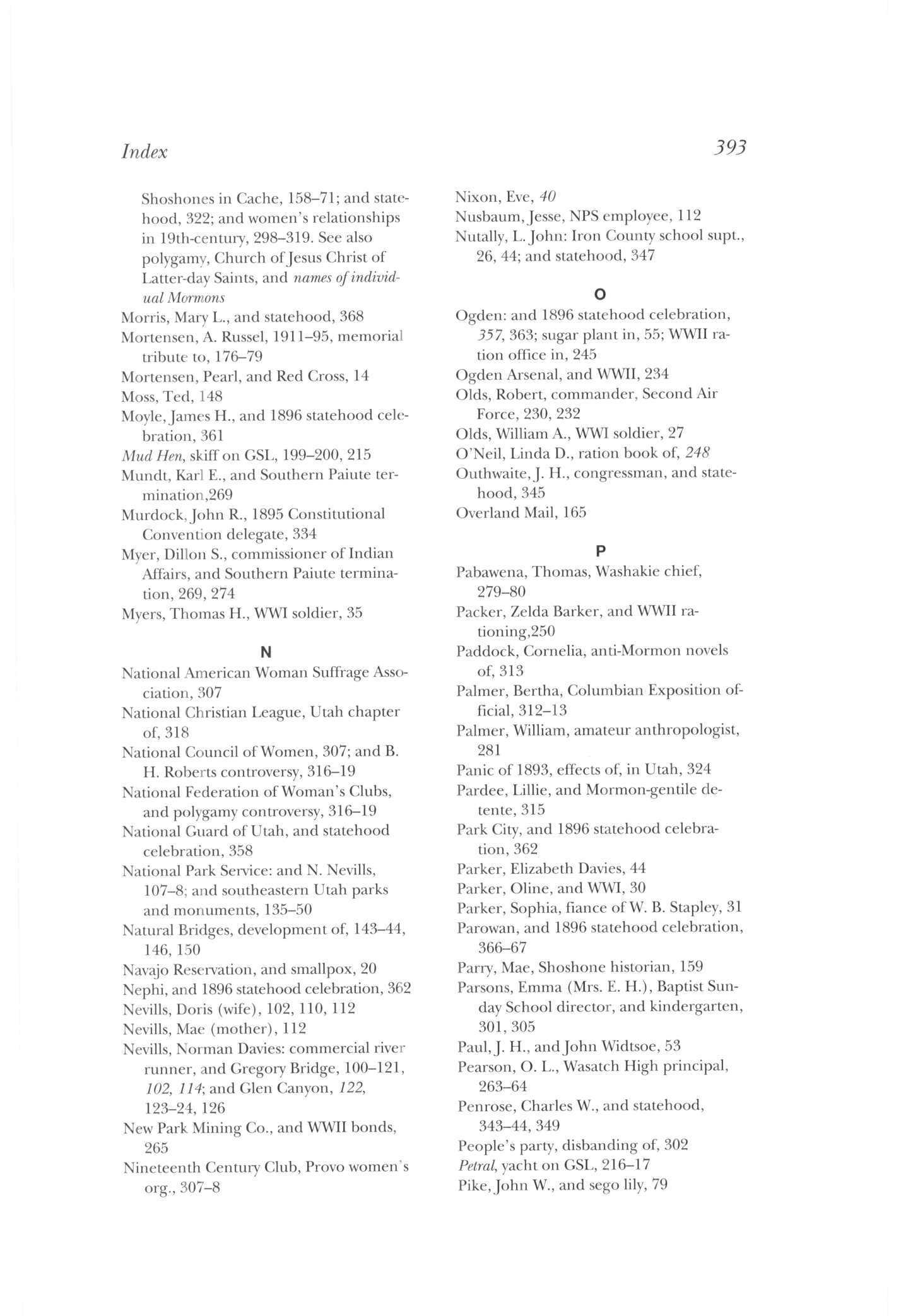
Morris, Mary L., and statehood, 368
Mortensen, A Russel, 1911-95, memorial tribute to, 176-79
Mortensen, Pearl, and Red Cross, 14
Moss, Ted, 148
Moyle, James H., and 1896 statehood celebration, 361
Mud Hen, skiff on GSL, 199-200, 215
Mundt, Karl E., and Southern Paiute termination,269
Murdock, John R., 1895 Constitutional Convention delegate, 334
Myer, Dillon S., commissioner of Indian Affairs, and Southern Paiute termination, 269,274
Myers, Thomas H., WWI soldier, 35
National American Woman Suffrage Association, 307
National Christian League, Utah chapter of, 318
National Council of Women, 307; and B H Roberts controversy, 316-19
National Federation of Woman's Clubs, and polygamy controversy, 316-19
National Guard of Utah, and statehood celebration, 358
National Park Service: and N Nevills, 107-8; and southeastern Utah parks and monuments, 135-50
Natural Bridges, development of, 143-44, 146, 150
Navajo Reservation, and smallpox, 20
Nephi, and 1896 statehood celebration, 362
Nevills, Doris (wife), 102, 110, 112
Nevills, Mae (mother), 112
Nevills, Norman Davies: commercial river runner, and Gregory Bridge, 100-121, 102, 114; and Glen Canyon, 122, 123-24, 126
New Park Mining Co., and WWII bonds, 265
Nineteenth Century Club, Provo women's org., 307-8
Nixon, Eve, 40
Nusbaum, Jesse, NPS employee, 112 Nutally, L.John: Iron County school supt., 26, 44; and statehood, 347
Ogden: and 1896 statehood celebration, 357, 363; sugar plant in, 55; WWII ration office in, 245 Ogden Arsenal, and WWII, 234 Olds, Robert, commander, Second Air Force, 230, 232
Olds, William A., WWI soldier, 27
O'Neil, Linda D., ration book of, 248
Outhwaite, J H., congressman, and statehood, 345 Overland Mail, 165
Pabawena, Thomas, Washakie chief, 279-80
Packer, Zelda Barker, and WWII rationing,250
Paddock, Cornelia, anti-Mormon novels of, 313
Palmer, Bertha, Columbian Exposition official, 312-13
Palmer, William, amateur anthropologist, 281
Panic of 1893, effects of, in Utah, 324 Pardee, Lillie, and Mormon-gentile detente, 315
Park City, and 1896 statehood celebration, 362
Parker, Elizabeth Davies, 44 Parker, Oline, and WWI, 30
Parker, Sophia, fiance of W B Stapley, 31 Parowan, and 1896 statehood celebration, 366-67
Parry, Mae, Shoshone historian, 159
Parsons, Emma (Mrs E H.), Baptist Sunday School director, and kindergarten, 301,305
Paul, J H., and John Widtsoe, 53
Pearson, O L., Wasatch High principal, 263-64
Penrose, Charles W., and statehood, 343-44, 349
People's party, disbanding of, 302 Petral, yacht on GSL, 216-17
Pike, John W., and sego lily, 79
Index 393
N
Pingle, Gustave H., WWI soldier, 31
Pinkley, "Boss," Legendary NPS employee, 140
Pioneer, GSL schooner, 203-4
Piatt, Rulon Berry, and WWI, 45-46
Piatt, William Grant, LDS missionary, 38
Pluribustah, GSL schooner, 203-4
Pocatello, Shoshone leader, 161, 170
Pollock, Ellener Davis, 40
Pollock, Emery, WWI volunteer, 27
Polygamy: banned by Enabling Act, 328; Mormon-gentile conflict over, 298-303, 315-19; and statehood, 343, 345, 350, 352
Pope, Amanda, state flag made by, 360
Populist party, 351
Porter, Arvel, 4
Portage, and 1896 statehood celebration, 365
Porter, Eliot, Glen Canyon photos of, 123
Porter, Amni, sawmill foreman, 6
Powers, Orlando W., Democratic leader, 353
Pratt, Romania B., as clubwoman, 310
Presbyterian church: and kindergartens, 305; women's orgs, of, 301
Preston, William B., 1895 Constitutional Convention delegate, 327
Pride, sailboat on GSL, 217
Probst, Nephi, and WWI, 257, 263
Promontory, sternwheeler used in constuction of Lucin Cutoff, 214, 276
Provo, and 1896 statehood celebration, 367
Pyle, Ernie, and N Nevills, 103, 114
Quist, Carol Bennion, and WWII bond drives, 264, 267
Rainbow Bridge, 106, 111
Rawlins, Joseph L., and 1896 statehood celebration, 366
Reapers Club, women's org., 307, 309-10, 315
Red Cross, and WWI, 8, 12-14, 39, 41-44
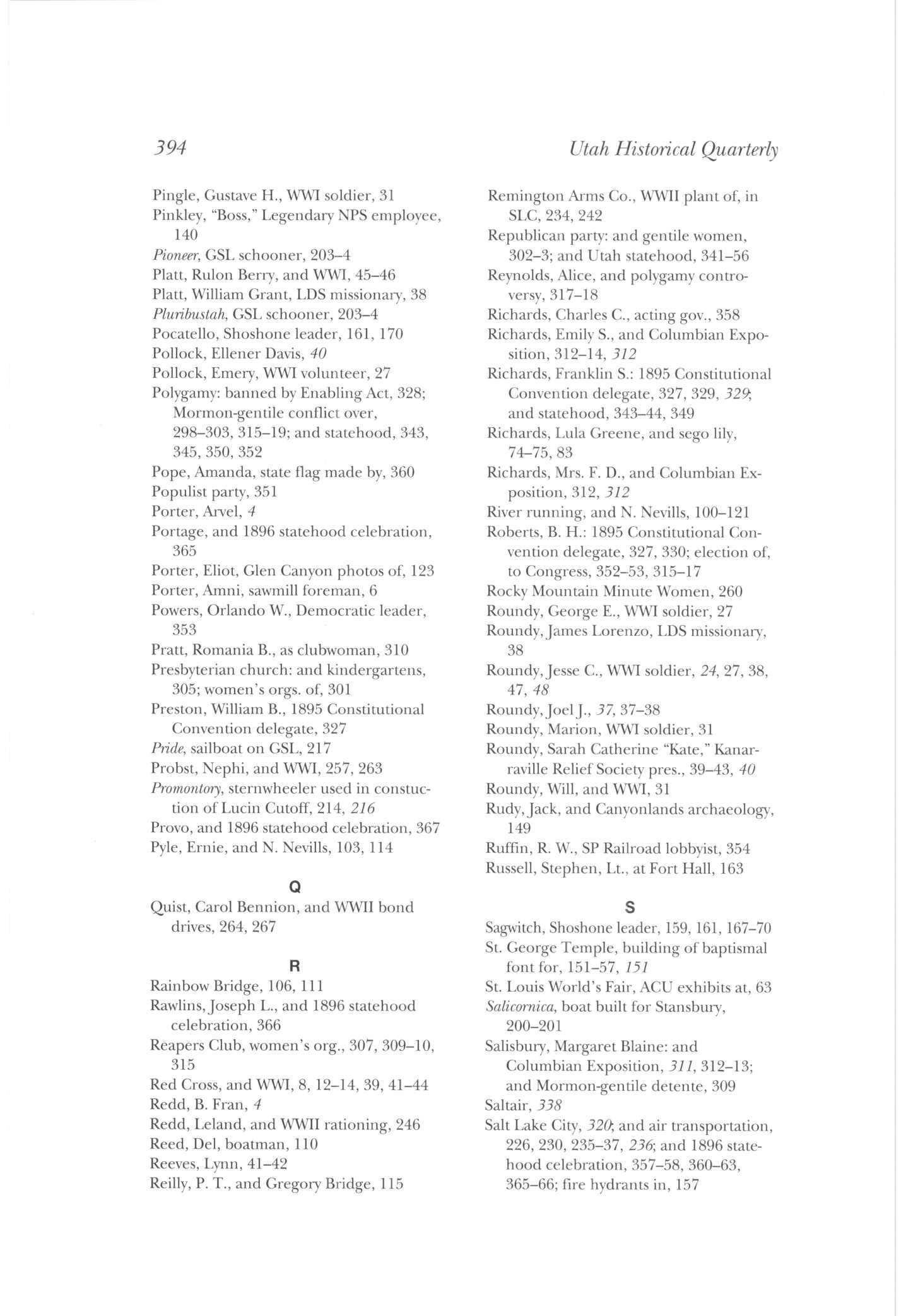
Redd, B Fran, 4
Redd, Leland, and WWII rationing, 246
Reed, Del, boatman, 110
Reeves, Lynn, 41-42
Reilly, P T., and Gregory Bridge, 115
Remington Arms Co., WWII plant of, in SLC, 234, 242
Republican party: and gentile women, 302-3; and Utah statehood, 341-56
Reynolds, Alice, and polygamy controversy, 317-18
Richards, Charles C, acting gov., 358
Richards, Emily S., and Columbian Exposition, 312-14, 372
Richards, Franklin S.: 1895 Constitutional Convention delegate, 327, 329, 329, and statehood, 343-44, 349
Richards, Lula Greene, and sego lily, 74-75, 83
Richards, Mrs F D., and Columbian Exposition, 312, 312
River running, and N. Nevills, 100-121
Roberts, B. H.: 1895 Constitutional Convention delegate, 327, 330; election of, to Congress, 352-53, 315-17
Rocky Mountain Minute Women, 260
Roundy, George E., WWI soldier, 27
Roundy, James Lorenzo, LDS missionary, 38
Roundy, Jesse C, WWI soldier, 24, 27, 38, 47, 48
Roundy, Joel J., 37, 37-38
Roundy, Marion, WWI soldier, 31
Roundy, Sarah Catherine "Kate," Kanarraville Relief Society pres., 39-43, 40
Roundy, Will, and WWI, 31
Rudy, Jack, and Canyonlands archaeology, 149
Ruffin, R W., SP Railroad lobbyist, 354
Russell, Stephen, Lt., at Fort Hall, 163
Sagwitch, Shoshone leader, 159, 161, 167-70
St George Temple, building of baptismal font for, 151-57, 757
St Louis World's Fair, ACU exhibits at, 63
Salicornica, boat built for Stansbury, 200-201
Salisbury, Margaret Blaine: and Columbian Exposition, 377, 312-13; and Mormon-gentile detente, 309
Saltair, 338
Salt Lake City, 320, and air transportation, 226, 230, 235-37, 236; and 1896 statehood celebration, 357-58, 360-63, 365-66; fire hydrants in, 157
394 Utah Historical Quarterly
Salt Lake City and County Building, site of 1895 Constitutional Convention, 321
Salt Lake Herald: and 1895 Constituional Convention, 322-23; and 1896 statehood celebration, 363, 369; and Trumbo, 355
Salt lake Kindergarten Assn., 305
Salt lake Rowing Club, 212
Salt Lake Tribune: and 1895 Constitutional Convention, 322, 329; and natural gas service, 323-24; and Southern Paiute termination, 276; and WWII, 245, 249, 253, 256, 258-59, 262, 266-67
Salt Lake Yacht Club, 212, 216-19
SanJuan Blade, and WWI, 5, 13, 15, 16
San Juan County: effects of WWI in, 4-23; and WWII rationing, 246
Sanpitch, Shoshone leader, 159
Savage, C. R., and 1896 statehood celebration, 361
Sego Implement and Vehicle Co., 77
Seho lily, history and symbolism of, 70-84, 70, 80, 84
Sewall, May Wright, National Council of Women pres., 319
Shakespearean Club, Heber City women's org., 243
Sheepherding, by Basques in Arches area, 142
Sheets, Elijah, blacksmith, 155
Shipp, Ellis, and LDS kindergarten, 305-6
Shivwits Indians, 278, 283 and termination, 273-79
Shoshone Indians: adaptation of, to Mormon settlement of Cache Valley, 158-71, 158; and Bear River Massacre, 159-61, 169; presettlement lifestyle of, 162; and termination bill, 273-74, 279-81
Shumway, John, and 1896 statehood celebration, 365
Siegmund, Walter F., CO at Kearns Army Air Base, 229
Sierrra Club, and Glen Canyon, 123
Sinclair, Marguerite, USHS secretary and singer, 80
Sleight, Ken, wilderness guide, 117-18
Smith, Bathsheba W., and LDS kindergarten, 305-6
Smith, Betsy Jane Parker, Kanarraville Relief Society officer, 40
Smith, Dean, airmail pilot, 223
Smithfield, and 1896 statehood celebration, 367
Smith, John Henry: 1895 Constitutional Convention pres., 237, 339; partisan activity of, 353
Smith, Joseph F.: and politics, 352-53; and polygamy, 318-19

Smith, Norma, Farm Security administrator, 243
Smith, William, injured during statehood celebration, 359
Smoot, Reed, controversy over election of, 317
Smallpox, 1918 epidemic of, in southeastern Utah, 19-20
Snow, Eliza R., and sego lily, 71
Snowville, and 1896 statehood celebration, 364, 368
Songsand Flowers ofthe Wasatch, 313
Southern Pacific Railroad: and Lucin Cutoff, 214; political influence of, 354, 356
Southern Paiute Indians: small bands of, listed, 273; termination of, pushed by Sen. Watkins, 268-83
Southworth, John, and Gregory Bridge, 111, 113
Spencer, Ernest, and WWI draft, 17 Spring City, and 1896 statehood celebration, 368
Springer, William, congressman, 344
Standard Oil of California, and WWII, 247, 253
Standard Parachute Co., 235
Stansbury, Howard, exploration of GSL by, 200-201
Stapley, Harriet "Hattie" Berry: Kanarraville Relief Society officer, 40; and WWI, 33
Stapley, John Alma, 40
Stapley, Joseph, 40
Stapley, Leland Campbell, WWI soldier, 27,28,30,31,33-35,34,38
Stapley, Lou, 40
Stapley, Madge, 40
Stapley, Will, 37
Stapley, William Berry, WWI soldier, 30-31,37,47
Stapley, Young Elizabeth Steele, Kanarraville midwife, and WWI, 25, 25, 40, 47-49
Index 395
Star of the West, sailboat on GSL, 217
Statehood: community celebrations of, 357-69; and party politics, 341-52
Stephens, Evan, composer of "Utah, We Love Thee," 364-65, 364
Stewart, Justin C , Utah OPA official, 252
Stone, William H., foundry of, in St Louis, 153
Strevell, Charles N., 1895 Constitutional Convention delegate, 327
Sylvester, Nell, 40
Sylvester, Sarah, 40
Sylvester, Victor L., WWI deferment of, 27
Talmage, James E., and WWI, 19
Tanner, J M., BY Academy principal, 52, 57
Tasker, Harry, and Gregory Bridge, 116-17
Taylor, Elmina, and LDS kindergarten, 305-6
Taylor, J. Edward, and Deseret Farmer, 66
Temple Block, gateposts for, 157
Thatcher, Mrs George W., and Columbian Exposition, 372
Thatcher, Moses: as 1895 Constitutional Convention delegate, 327, 337; and sego lily, 72, 83; as Senate candidate, 352
Thompson , Marjorie Watts, and WWII rationing, 255
Thoresen, I C , 1895 Constitutional Convention delegate, 331
Thorne , D W., agronomist, 253
Thornton , Oscar, WWI soldier, 35
Thurman , Samuel R., 1895 Constitutional Convention delegate, 327
Tibbetts, Rose, and WWII, 253
Tilden, Samuel J., defeat of, by Hayes, 343
The Timely Gull, boat built by D.Jones, 197, 201
Tooele: and 1895 statehood caelebration, 359; and WWII bon d drive, 266
Travis, Robert F., Air Force officer, 231
Treaty of Box Elder, 161, 169
Truman , Harry S., 229
Trumbo , Isaac: and statehood, 346-50, 346; and U.S Senate seat, 353-56
Tuckfield, Brother, as boat builder, 217
and Canyonlands, 146-48
United Air Lines, 236, 240
U.S Army Air Corps (Air Force), developmen t of, during WWII, 223-32
University of Utah, teacher training at, 305-6
University Ward, WWII canning project of, 257
Utah, economy of, and 1895 Constitutional Convention, 320-40
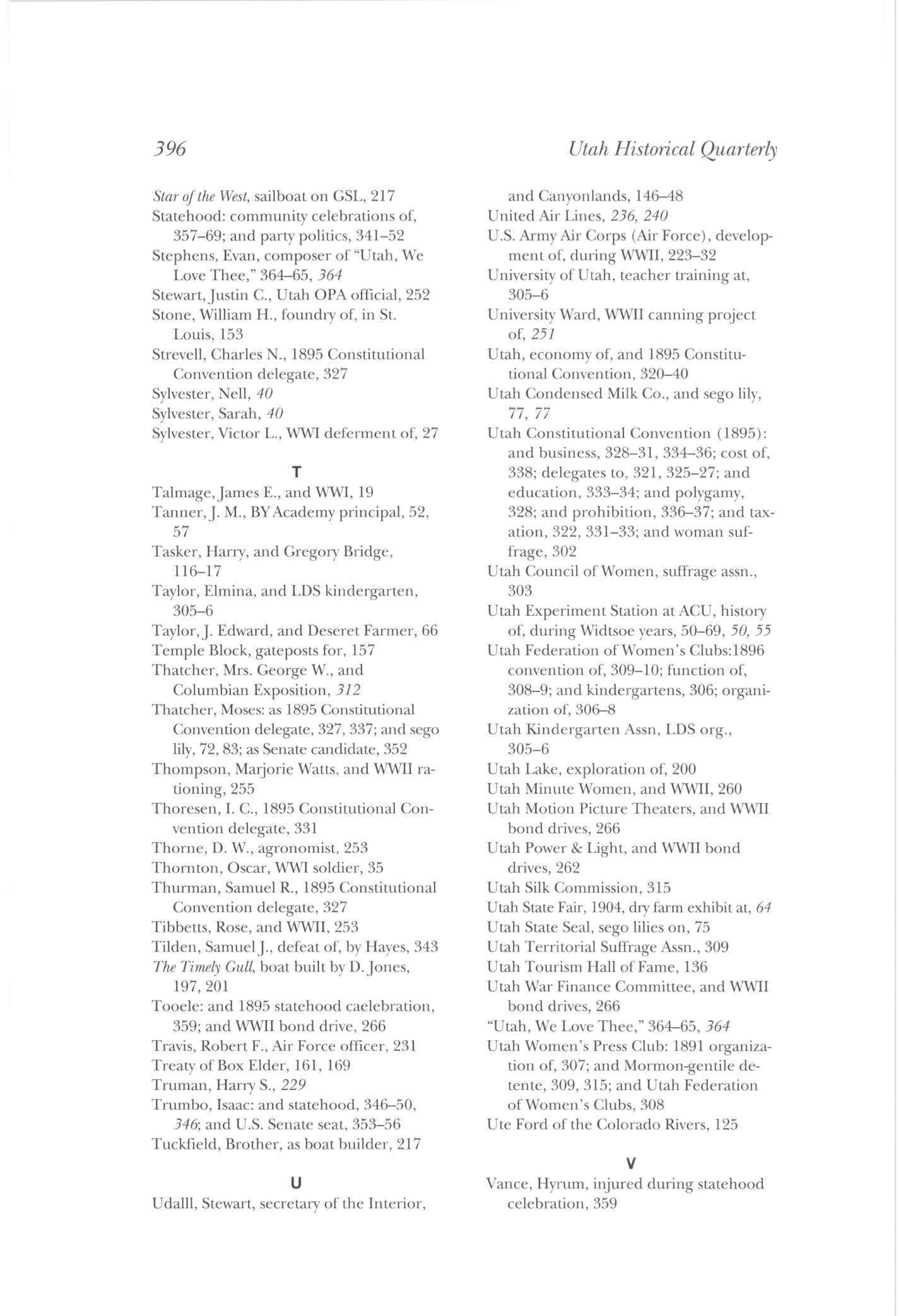
Utah Condensed Milk Co., and sego lily, 77, 77
Utah Constitutional Convention (1895): and business, 328-31, 334-36; cost of, 338; delegates to, 321, 325-27; and education, 333-34; and polygamy, 328; and prohibition, 336-37; and taxation, 322, 331-33; and woman suffrage, 302
Utah Council of Women, suffrage assn., 303
Utah Experiment Station at ACU, history of, during Widtsoe years, 50-69, 50, 55
Utah Federation of Women's Clubs: 1896 convention of, 309-10; function of, 308-9; and kindergartens, 306; organization of, 306-8
Utah Kindergarten Assn, LDS org., 305-6
Utah Lake, exploration of, 200
Utah Minute Women, and WWII, 260
Utah Motion Picture Theaters, and WWII bon d drives, 266
Utah Power & Light, and WWII bon d drives, 262
Utah Silk Commission, 315
Utah State Fair, 1904, dry farm exhibit at, 64
Utah State Seal, sego lilies on, 75
Utah Territorial Suffrage Assn., 309
Utah Tourism Hall of Fame, 136
Utah War Finance Committee, and WWII bon d drives, 266
"Utah, We Love Thee," 364-65, 364
Utah Women's Press Club: 1891 organization of, 307; and Mormon-gentile detente, 309, 315; and Utah Federation of Women' s Clubs, 308
Ute Ford of the Colorado Rivers, 125
396 Utah Historical Quarterly
U
Udalll, Stewart, secretary of the Interior,
Vance, Hyrum, injured during statehood celebration, 359
Van Leeuwen, George H., Hill Field employee, 227
Van Wagenen, Dean Eugene, Utah Count)' farmer, 246
Van Wagenen, Phyllis Barker, and WWII rationing, 253, 257, 265-66
Varian, Charles S., 1895 Constitutional Convention delegate, 326, 326, 330
Veater, Clark, and Gregory Bridge, 119
Vernal, and 1896 statehood celebration, 367
Walker brothers, yacht of, 216-17
Wasatch County, and WWII, 243-45, 257-64
Wasatch Wave, and WWII, 245, 258, 260-62
Washakie, Shoshone chief, 158, 163, 164
Washakie Town, LDS farm at, 170-71
Waterloo Ward, WWII victory garden of, 254
Waterwitch, sailboat on GSL, 277, 217-18
Watkins, Arthur Vivian: biographical data on, 268, 271-72; and termination of Southern Paiutes, 268-83

Watson, Emil C , and WWI, 29, 44, 45
Weber Jack, Shoshone, 168
Wells, Emmeline B.: and Columbian Exposition, 313-15; and National Council of Women, 317—19; and polygamy controversy, 315-19
Wells, Emmeline Y, BY Academy teacher, 306
Wells, Heber M.: as 1895 Constututional Convention delegate, 327; inauguration of, as gov., 365-66, 369
Wendover Field, bombe r crews trained at, 230-32
Wenner, Kate, and Fremont Island, 202
Wenner, U J., and Fremont Island, 202
West, Caleb W., territorial gov., and 1895 constututional Convention, 339
Whalen, Alice J., and Columbian Exposition, 377, 312
Whirlwind, steamer on GSL, 213, 214
White, Mrs M A., and 1896 statehood celebration, 366
Whitney, Orson F., and sego lily, 76
Widtsoe, John A.: as director, Utah Experiment Station, ACU, 50-68, 51, 67; as
founder of BYU School of Agriculture, 68-69
Widtsoe, Leah Dunford, 57, 57
Witsoe, Osborne, 51
Wilkinson, Ernest, lawyer for Washakie Indians, 280
Williams, Clarissa S., and sego lily, 78
Williams, Ervin, WWI soldier, 30
Williams, Frances Rebecca Pollock, 37, 39
Williams, Jesse, 37
Williams, J J., pilot, 15
Williams, Jode , 37
Williams, J W., Moab doctor, 146
Williams, Rumen B., WWI soldier, 30
Williams, Lenna Stapley, and WWI, 28, 31, 42
Williams, Molly, 40
Williams, Reese (Rees) James, 37, 43
Williams, Riley G., storekeeper, 29
Williams, Sade Reeves, 37
Williams, Terry Tempest, and GSL, 195-96
Williams, Wells, WWI soldier, 31, 34, 38
Williams, William B., WWI soldier, 30
Williams, William Newjent, state senator, and sego lily, 77-78
Willis, Lem, 37
Wilson, Allan, 136
Wilson, Anne, 136
Wilson, Bates E., NPS career of, 135-50, 733
Wilson, Caroline, 136
Wilson, Edie, 136
Wilson, Julie, 136
Wilson, Lynn, 136
Wilson, Maryanne Campbell, WWI correspondence of, 25-26, 47-49
Wilson, M L , and 4-H, 243
Wilson, Robin, 136
Wilson, Tug, 138, 144
Winbourn, Merle, NPS maintenance employee, 146
Winn, Irene Carrigan, 228
Woman's Christian Temperanc e Union, Utah chapter of, 307
Woman's Club of Springville, 307-8
Woman's Exponent, and club movement, 308
Woman's Relief Corps, Utah chapter of, 318
Woman's Suffrage Council, Utah chapter of, 318
Index 397
W
Women: and club movement, 306-10; and Columbian Exposition, 310-15; and education, 303-6; and polygamy controversy, 315-19; relationship of Mormon and gentile, 298-319; and silk industry, 313-15; and suffrage, 300, 302, 303; and WWI, 11-14; and WWII, 10, 227, 234, 238
Women's Literary Club of Moab, 109
Women's Temperance Association of Parowan, 366
Wood, Adlai, 37
Wood, Jewett, and WWI, 30
Wood, Liza, 40
Woodbury, Ann C, and silk, 315
Woodbury, Arvilla, Kanarraville resident, 27,39-40
Woodbury, Gene, and WWI, 27
Woodhouse, George, 364
Woodruff, A. H., and statehood celebration, 358,367
Woodruff, Wilford: and Manifesto, 298-301; and politics, 353-54; and statehood, 347, 348, 350-51
Woolley, Edwin D., 152
Wooten, A., and 1896 statehood celebration 360
World's FairEcclesiastical History of Utah, 313
World War I: effects of, in Kanarraville, 24-49; effects of, in southeastern Utah, 4-23; parade of veterans of, 3

World War II, 241, 248, 251, 254, 263; and black market, 250, 256-57; and bond drives, 260-67; economic benefits of,
227, 232-34, 242; and home canning, 249-50; home front activities during, 24f-67; and military aviation, 222-40; rationing during, 242, 244-57; reminiscence of, f 72-75; scrap and fat drives during, 257-60; and VE Day, 793
Wright, J C, Brigham City settler, 169
Wright, Ruth, WWII worker, 234
Young, Bill, 4
Young, Brigham: boat built for, 201; and Indians, 161, 165-66, 169; and iron, 197; and P. E. Connor, 205-6; and St. George Temple baptismal font, 152-54; schoolhouse of, 304; and sego lily, 73
Young, John W.: boats owned by, 212-13; and kindergarten, 304; and statehood, 343
Young, Levi Edgar, 81; and sego lily, 80-82
Young, Mildruff, 4
Young, Zina D H.,: and Columbian Exposition, 313; and LDS kindergarten, 305-6
Zimmerman, William, asst commissioner of Indian Affairs, and Southern Paiute termination, 270, 274
ZCMI: facade of, 157; manufacturing interests of, 334, 335; and statehood, 349,360-61,367
398 Utah Historical Quarterly
UTAH STATE HISTORICAL SOCIETY
Department of Community and Economic Development Division of State History
BOARD O F STATE HISTORY
MARILYN CONOVER BARKER, Salt Lake City,1997 Chair
PETER L. GOSS, Salt Lake City, 1995 Vice-Chair
MAXJ EVANS, Salt Lake City Secretary
DALE L BERGE, Provo, 1995
BOYD A BLACKNER, Salt Lake City, 1997
DAVID D HANSEN, Sandy, 1997
CAROL CORNWALL MADSEN, Salt Lake City, 1997
DEAN L. MAY, Salt Lake City, 1995
CHRISTIE SMITH NEEDHAM, Logan, 1997
PENNY SAMPINOS, Price, 1995
THOMAS E. SAWYER, Orem, 1997
JERRY WYLIE, Ogden, 1997
ADMINISTRATION
MAX J. EVANS, Director
WILSON G MARTIN, Associate Director
PATRICIA SMITH-MANSFIELD, Assistant Director
STANFORD J LAYTON, Managing Editor
DAVID B MADSEN, State Archaeologist
The Utah State Historical Society was organized in 1897 by public-spirited Utahns to collect, preserve, and publish Utah and related history Today, under state sponsorship, die Society fulfills its obligations bypublishing the Utah Historical Quarterly and other historical materials; collecting historic Utah artifacLs; locating, documenting, and preserving historic and prehistoric buildings and sites; and maintaining a specialized research library Donations and gifts to the Society's programs, museum, or its library are encouraged, for only through such means can it live up to its responsibility of preserving the record of Utah's past
This publication has been funded with the assistance of a matching grant-in-aid from the Department of the Interior, National Park Service, under provisions of the National Historic Preservation Act of 1966 as amended This program receives financial assistance for identification and preservation of historic properties under Title VI of the Civil Rights Act of 1964 and Section 504 of the Rehabilitation Act of 1973 The U.S Department of the Interior prohibits discrimination on the basis of race, color, national origin, or handicap in its federally assisted programs If you believe you have been discriminated against in any program, activity, or facility as described above, or if you desire further information, please write to: Office of Equal Opportunity, U.S Department of the Interior, Washington, D.C 20240.

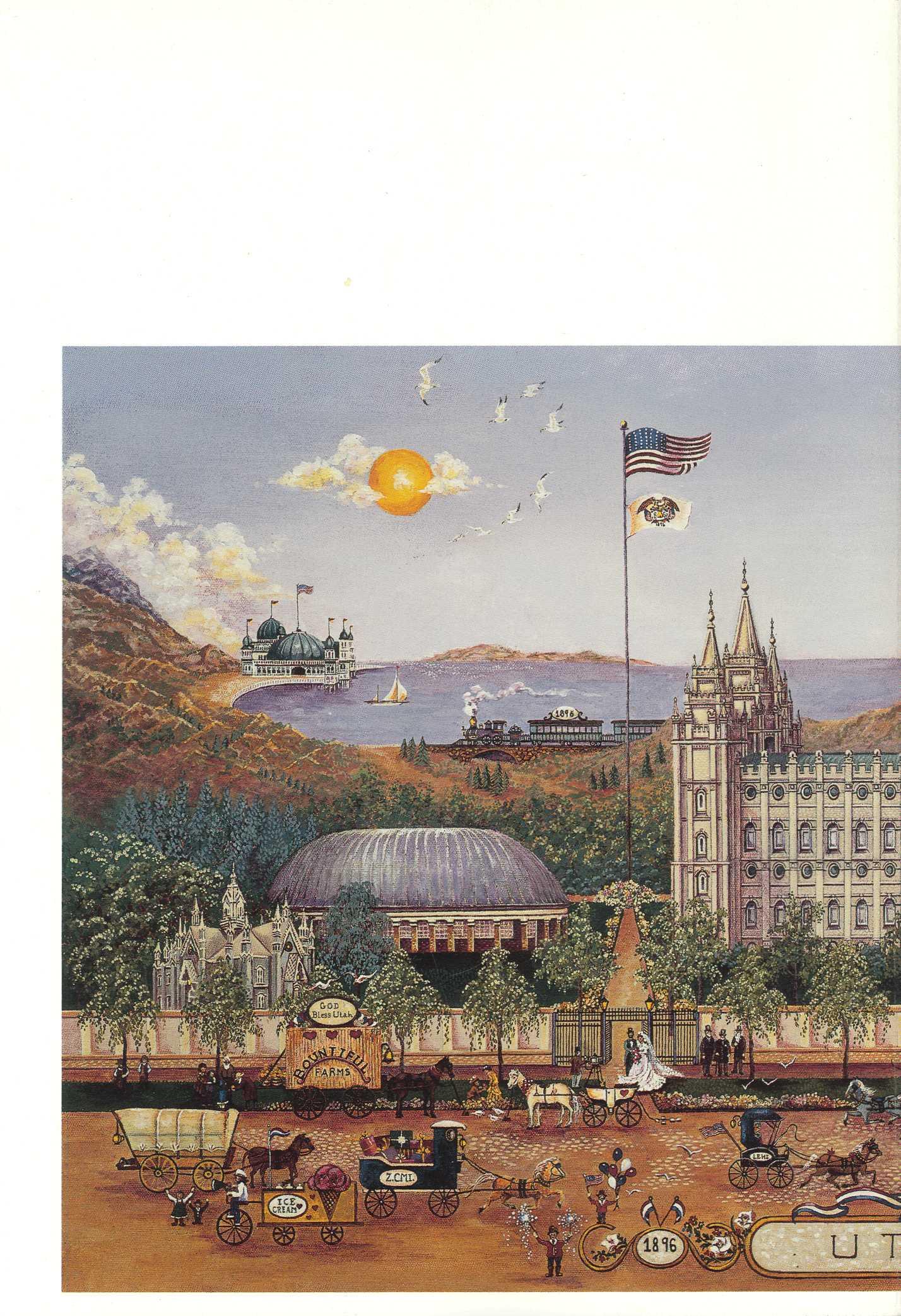




 Looking north on Main Street, Salt Lake City, at about the time of statehood. USHS collections.
Looking north on Main Street, Salt Lake City, at about the time of statehood. USHS collections.

 BY CAROL CORNWALL MADSEN
BY CAROL CORNWALL MADSEN





















 BY JEAN BICKMORE WHITE
BY JEAN BICKMORE WHITE





 Charles S. Varian. USHS collections.
Charles S. Varian. USHS collections.














 BY EDWARD LEO LYMAN
BY EDWARD LEO LYMAN















 BY AUDREY M. GODFREY
BY AUDREY M. GODFREY












 C. Gregory Crampton. USHS collections.
C. Gregory Crampton. USHS collections.




 GARY PETERSON Mapleton, Utah
GARY PETERSON Mapleton, Utah
































